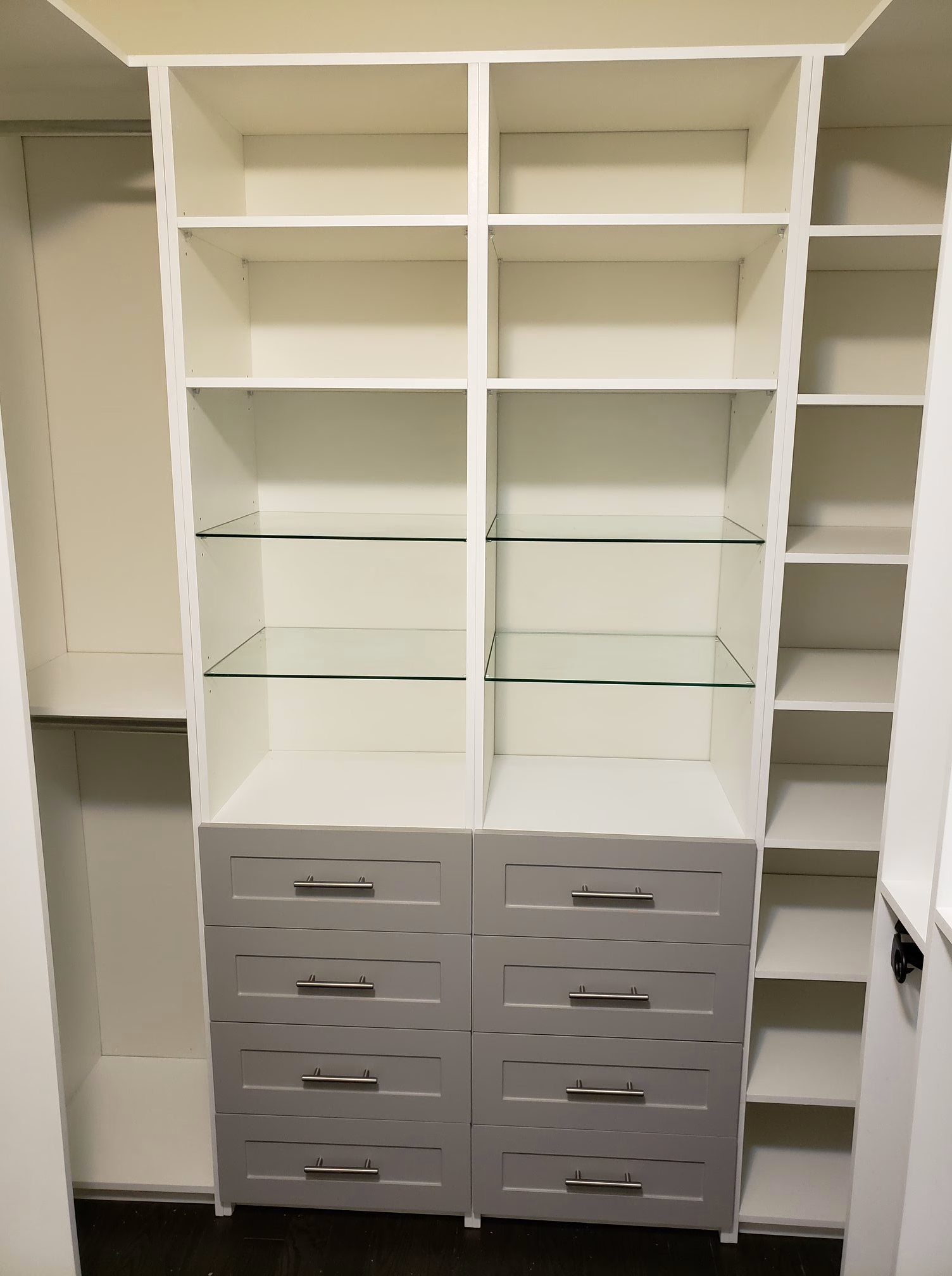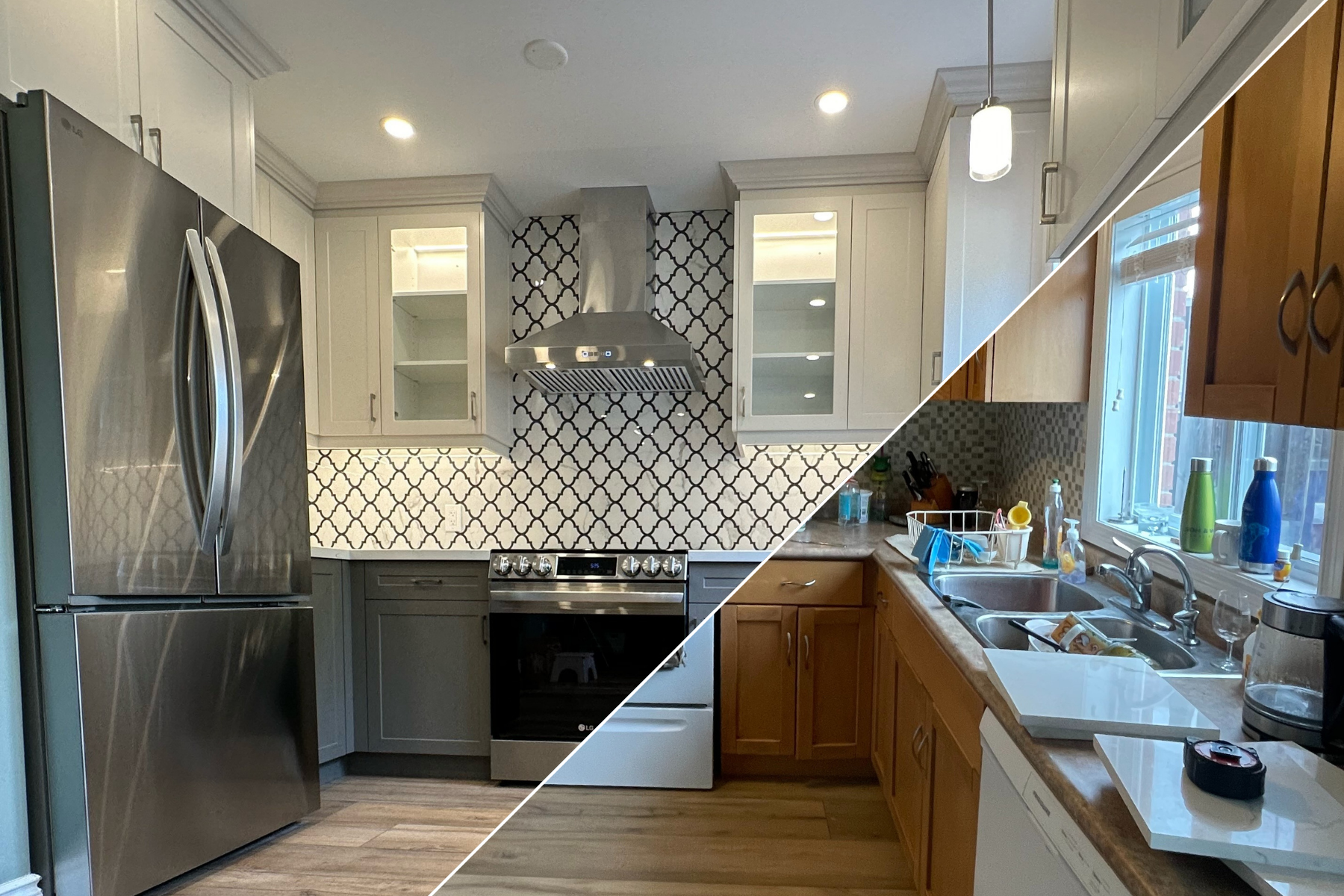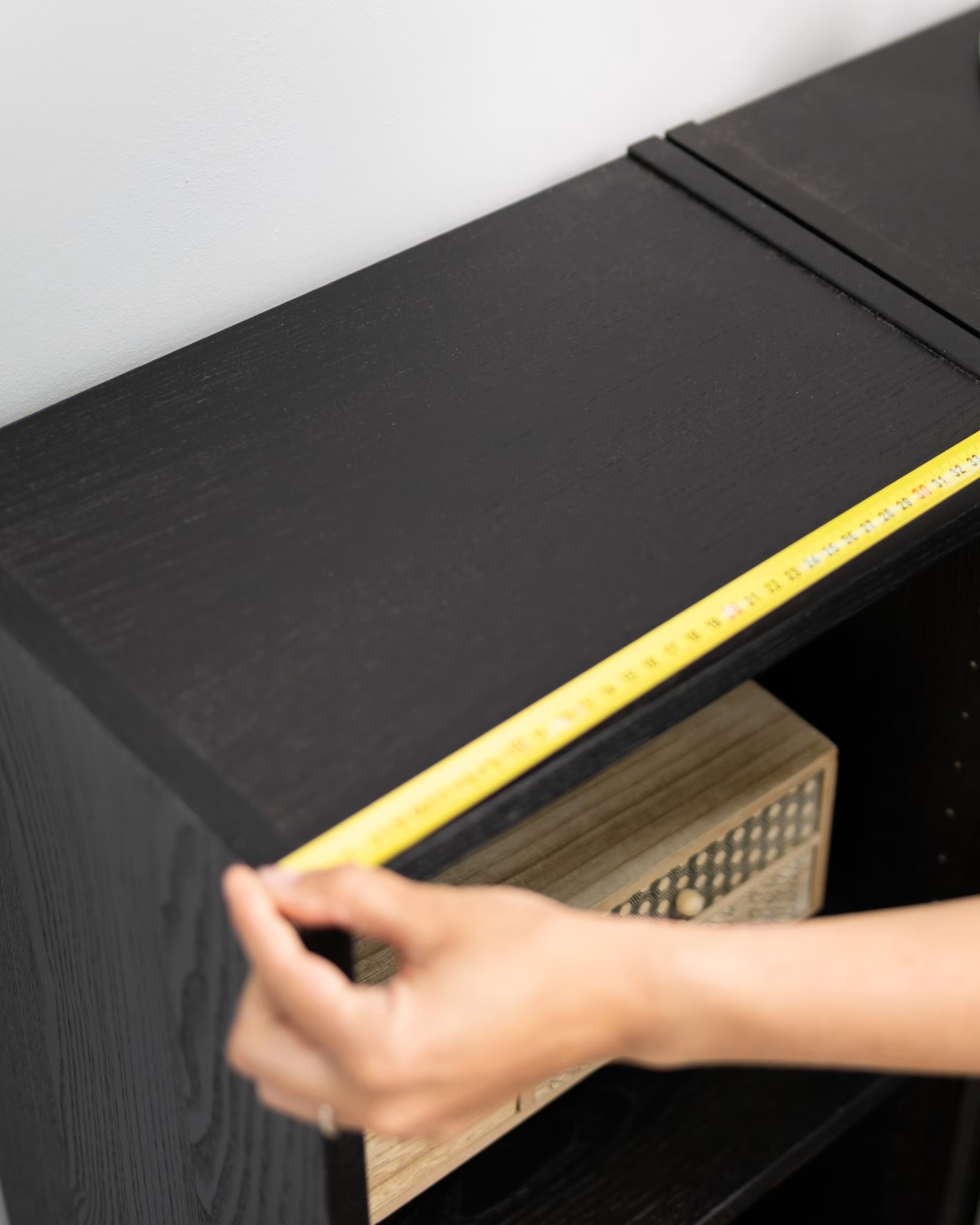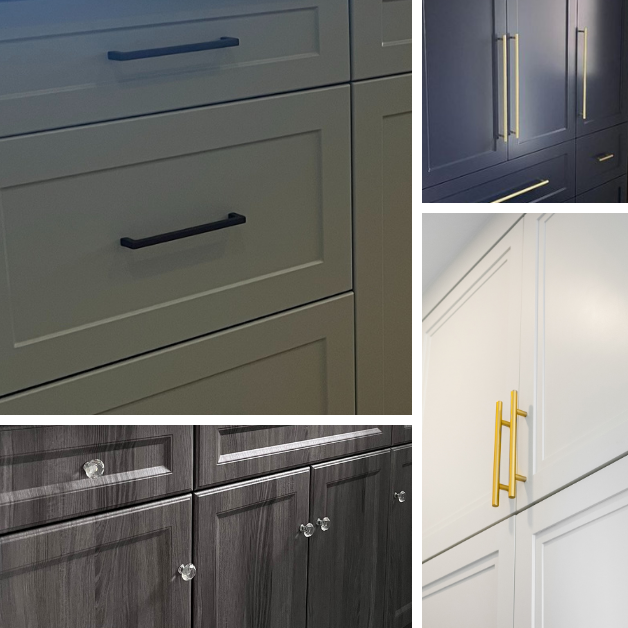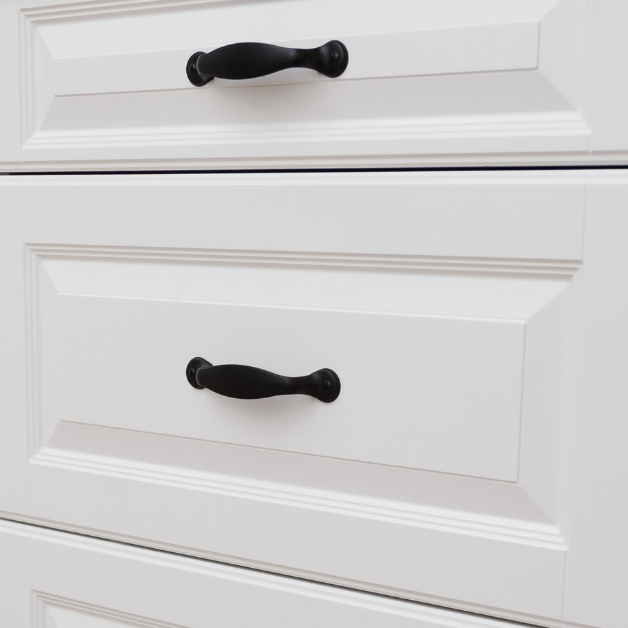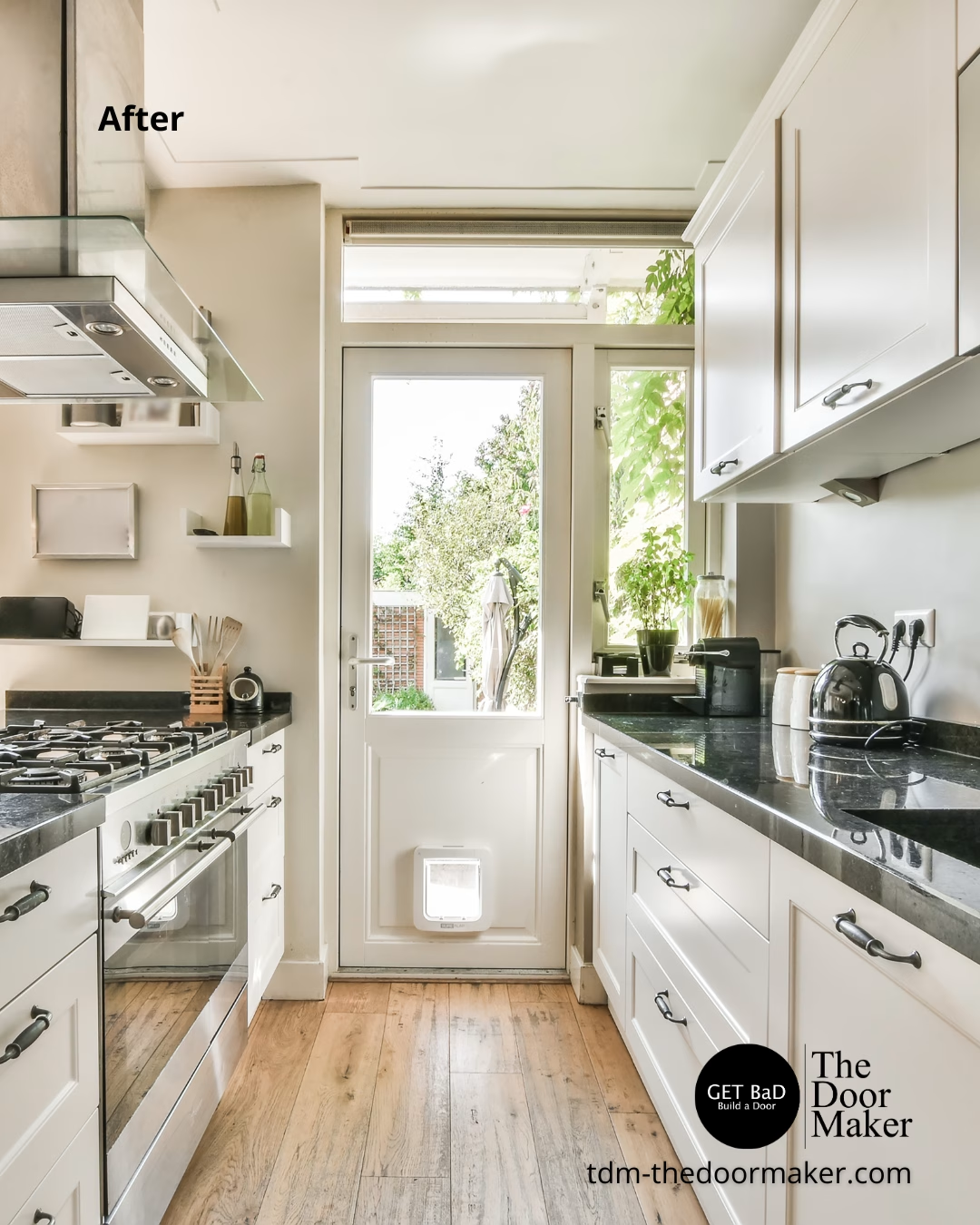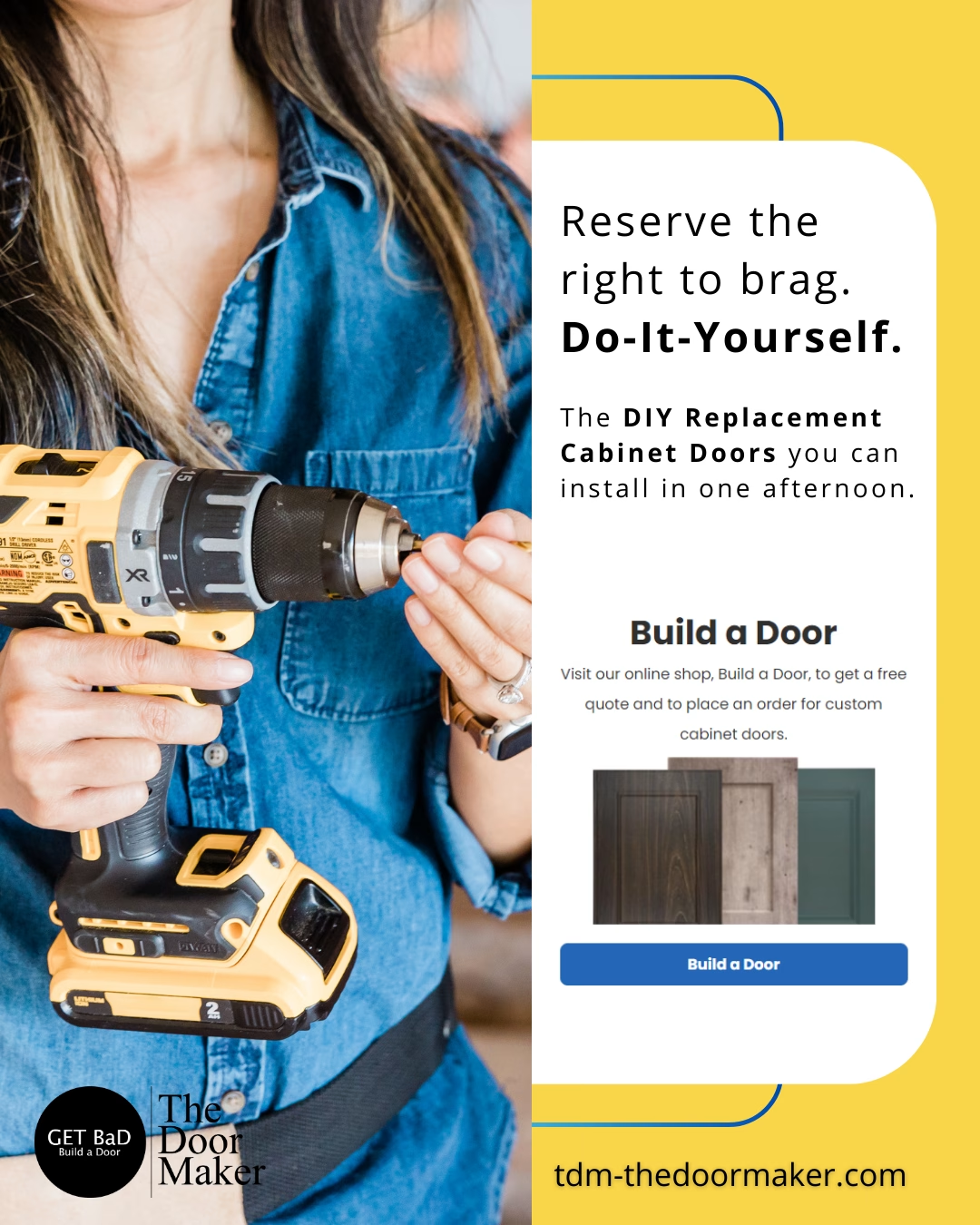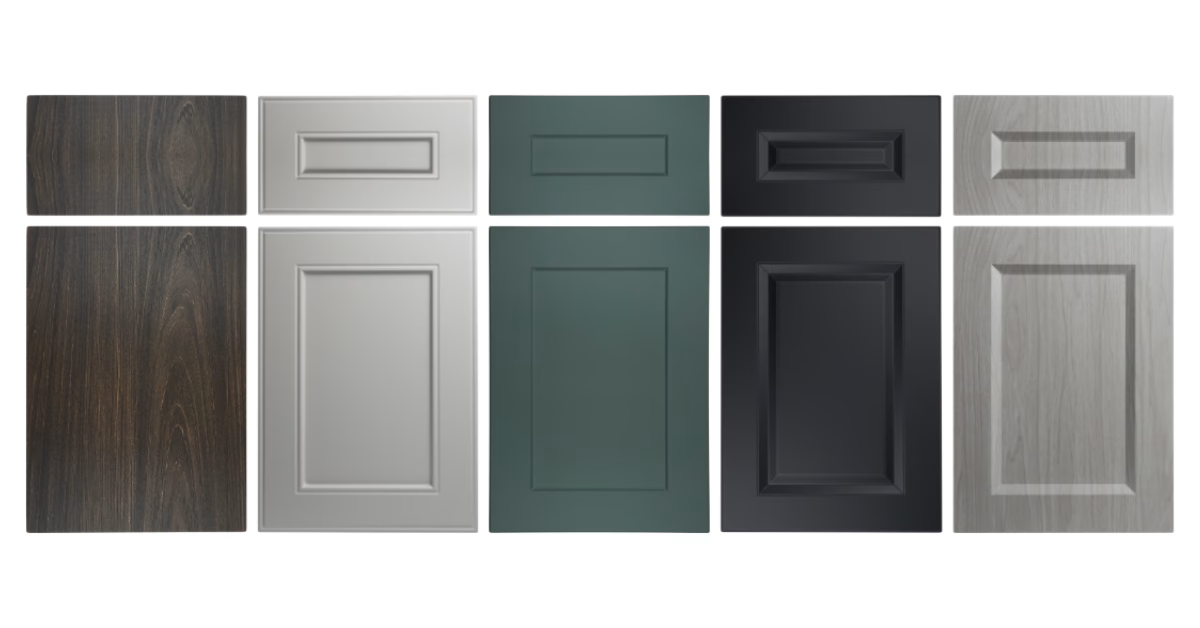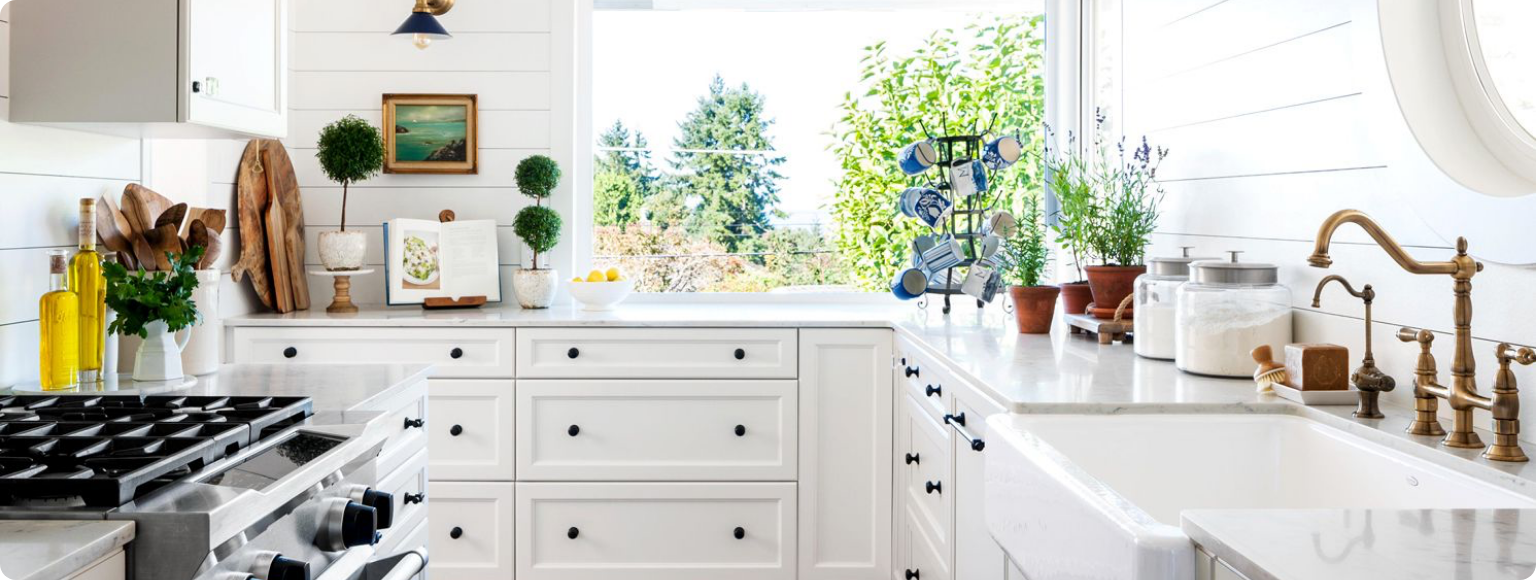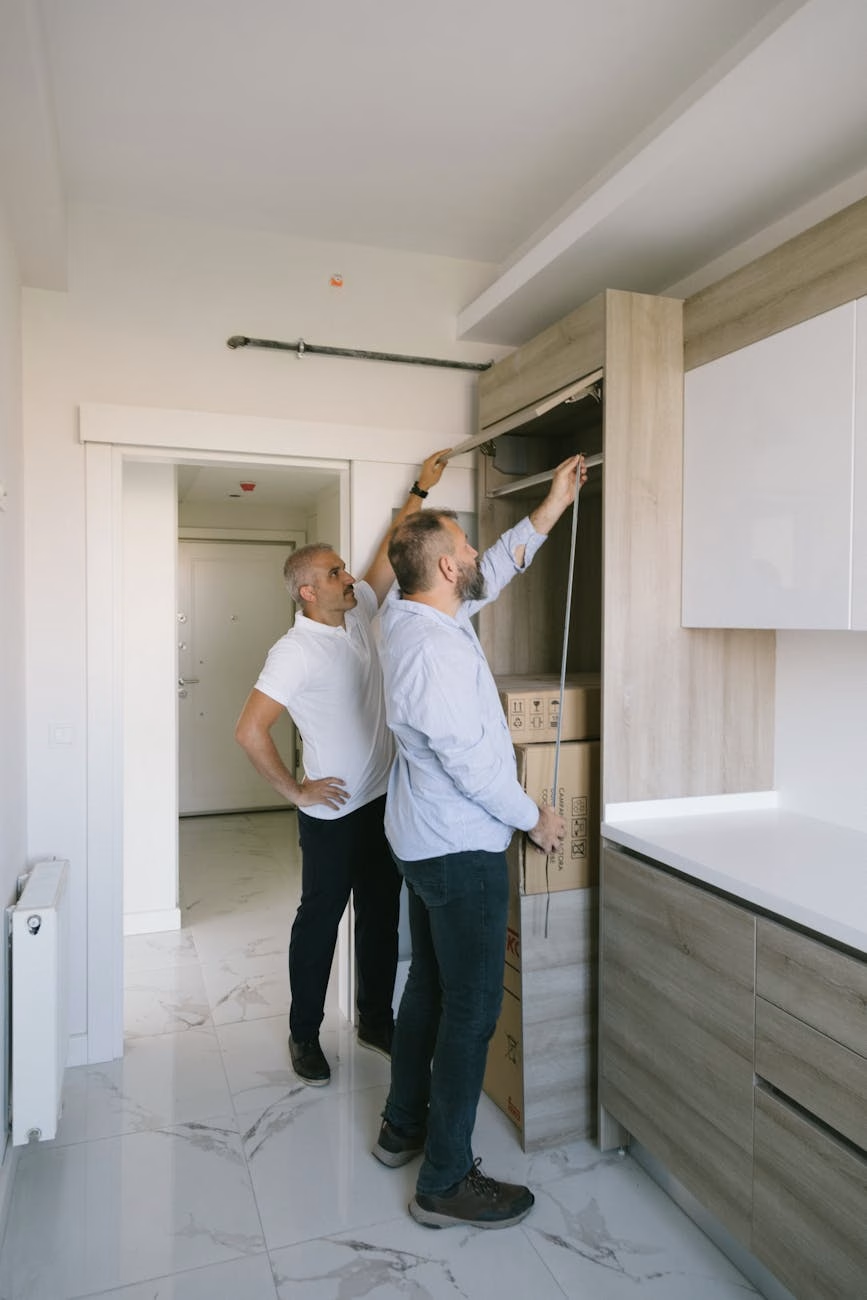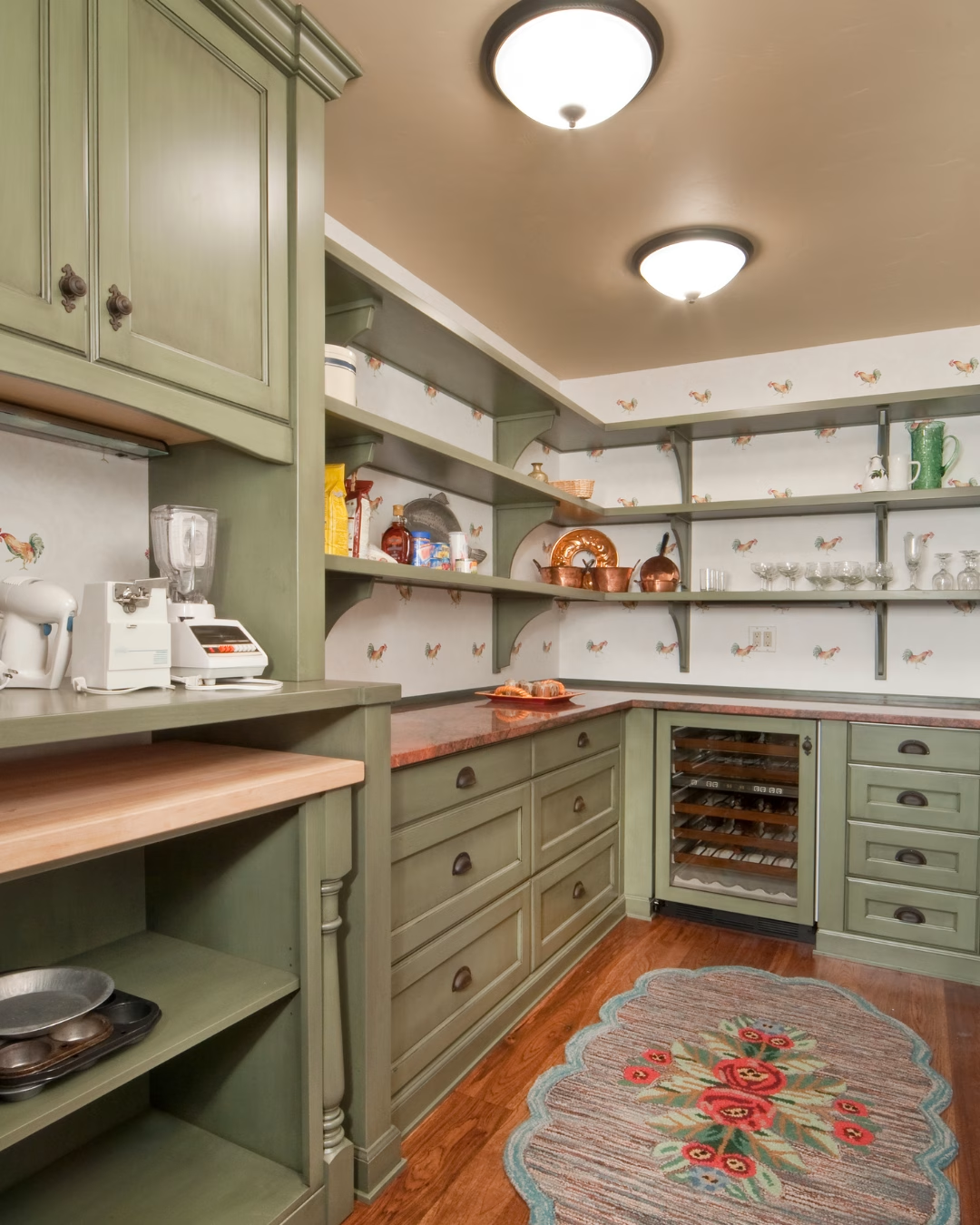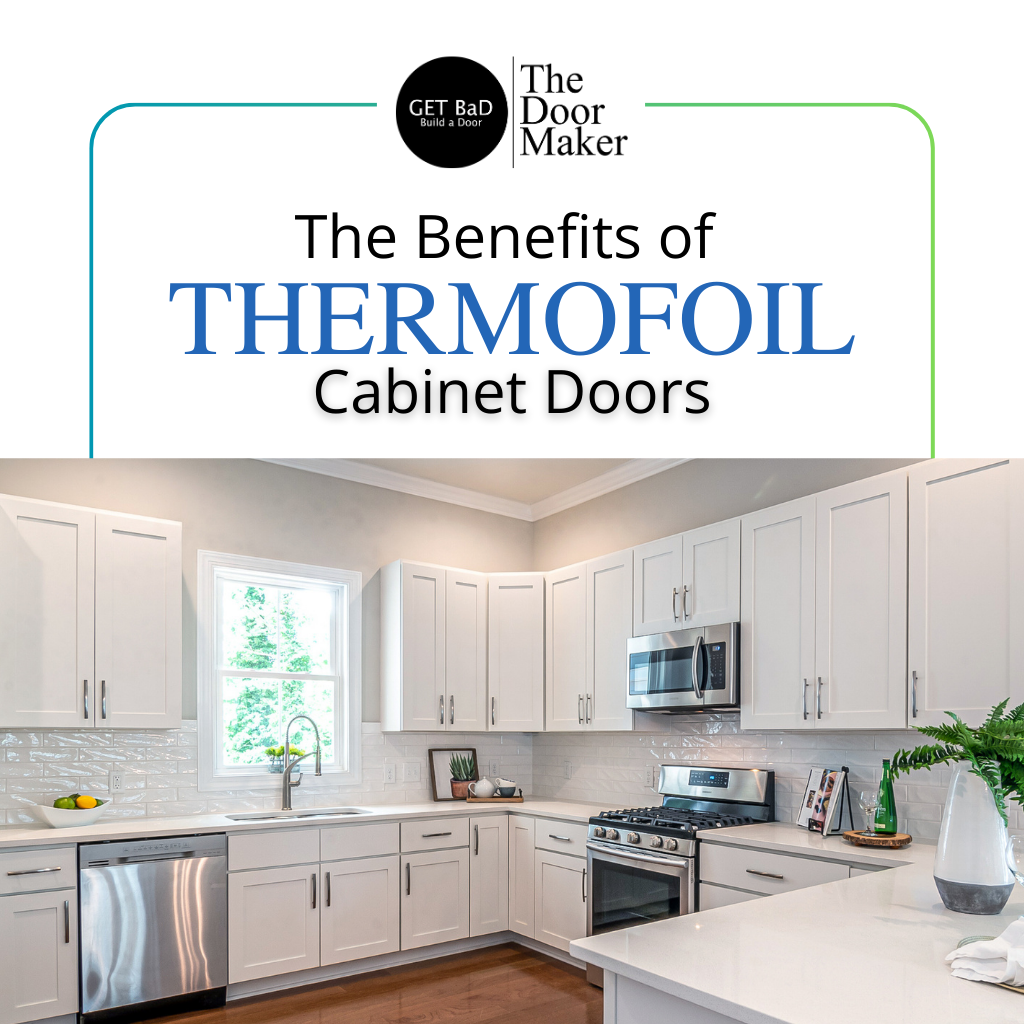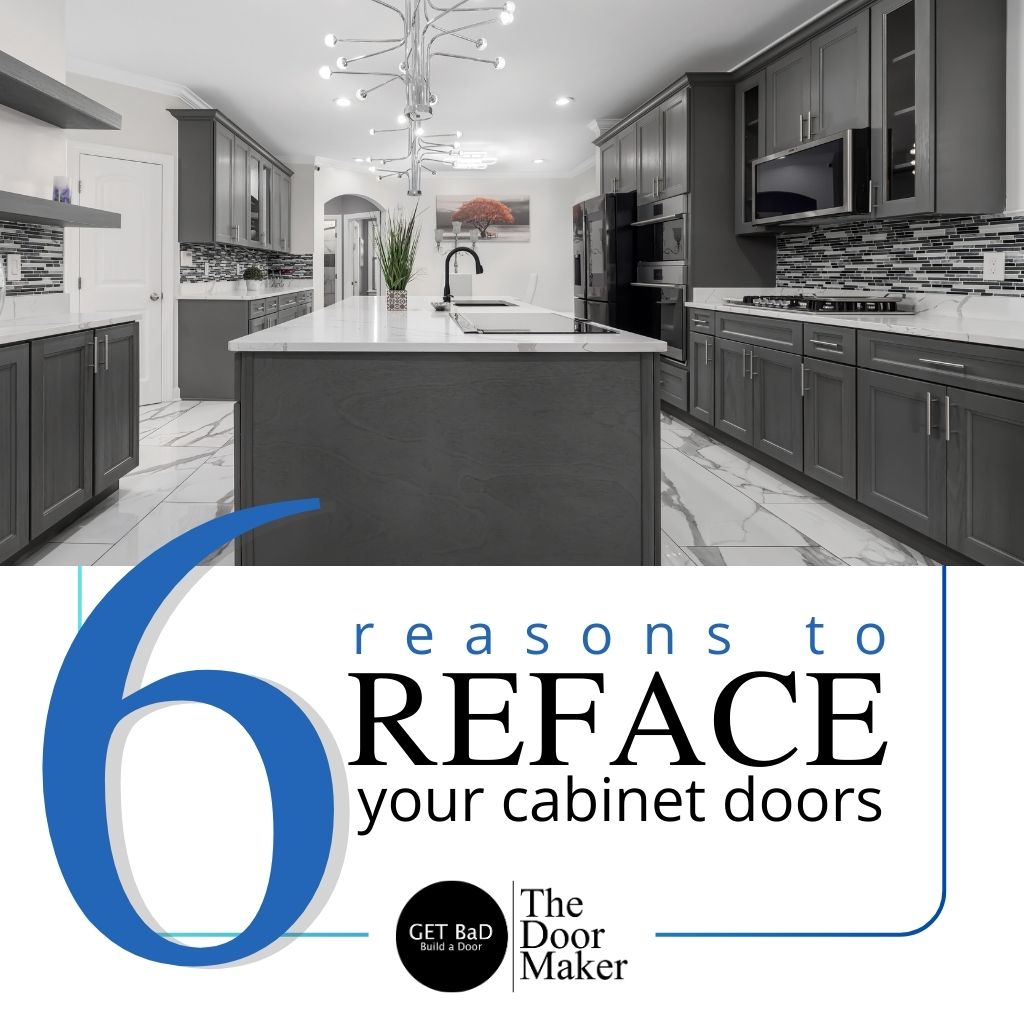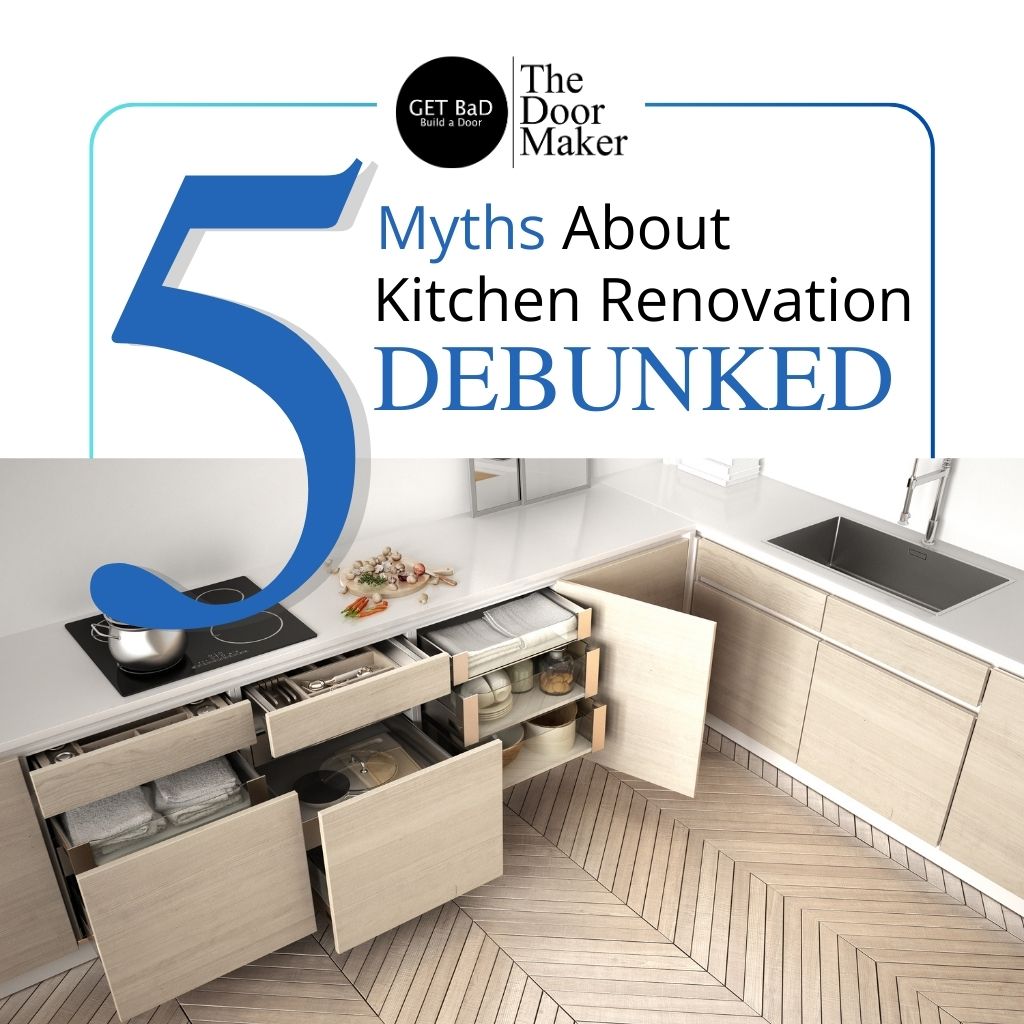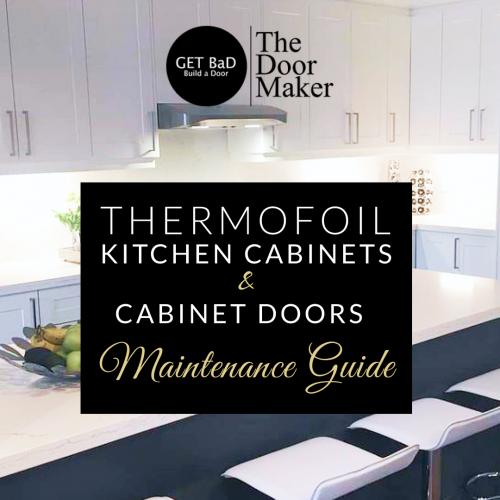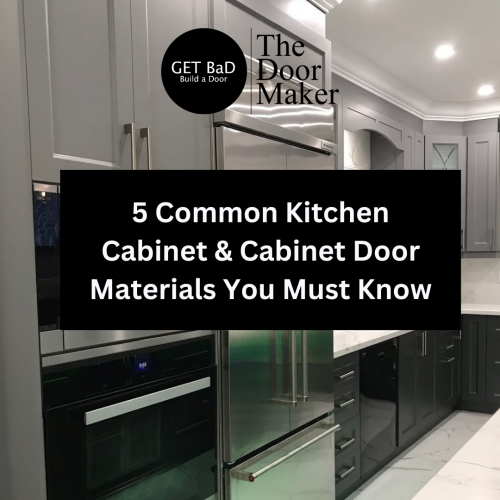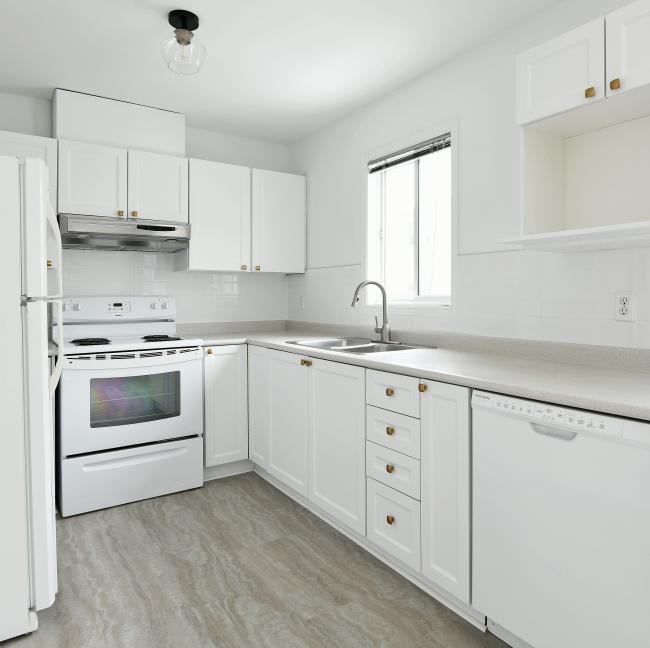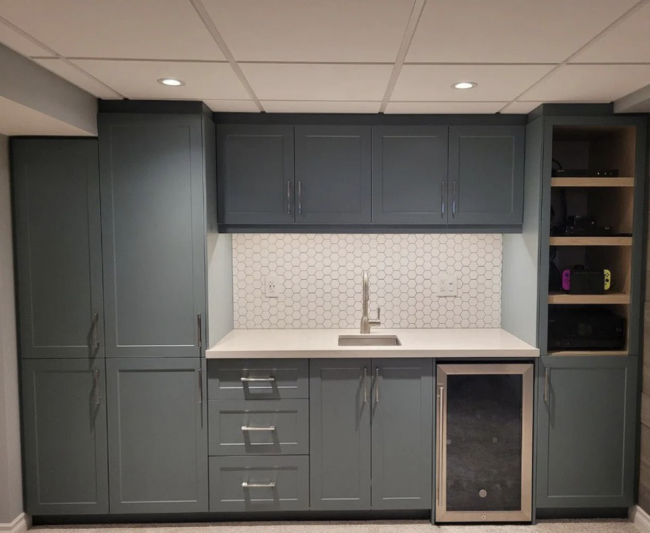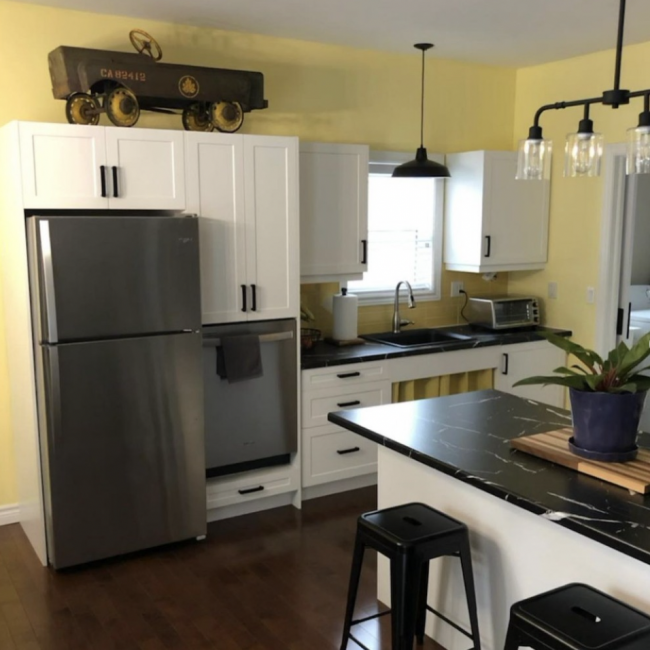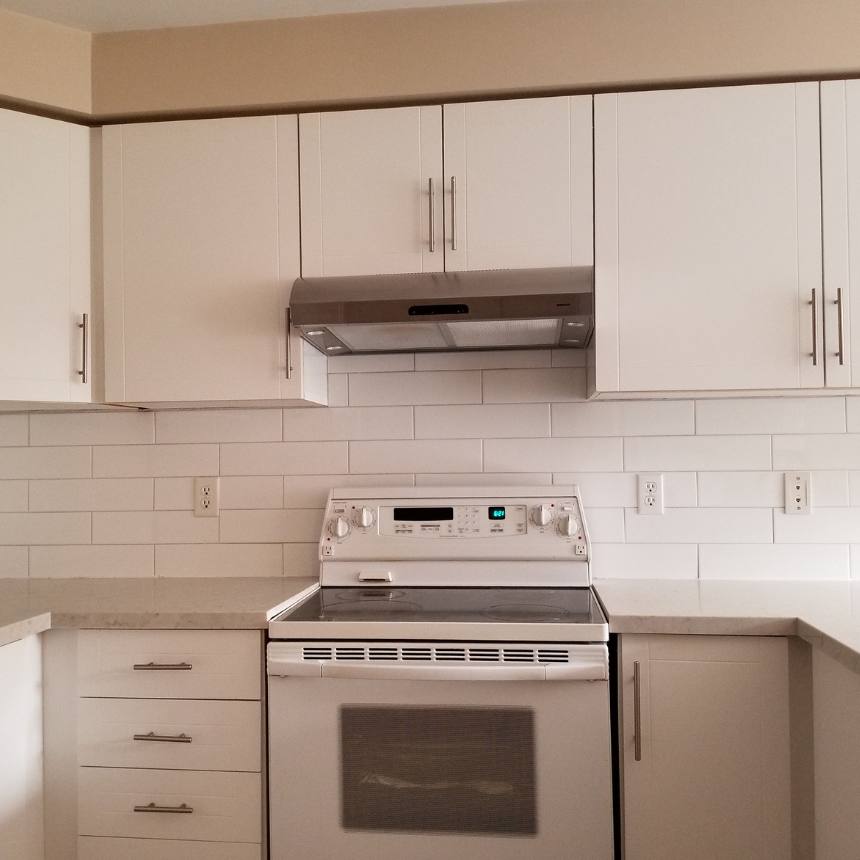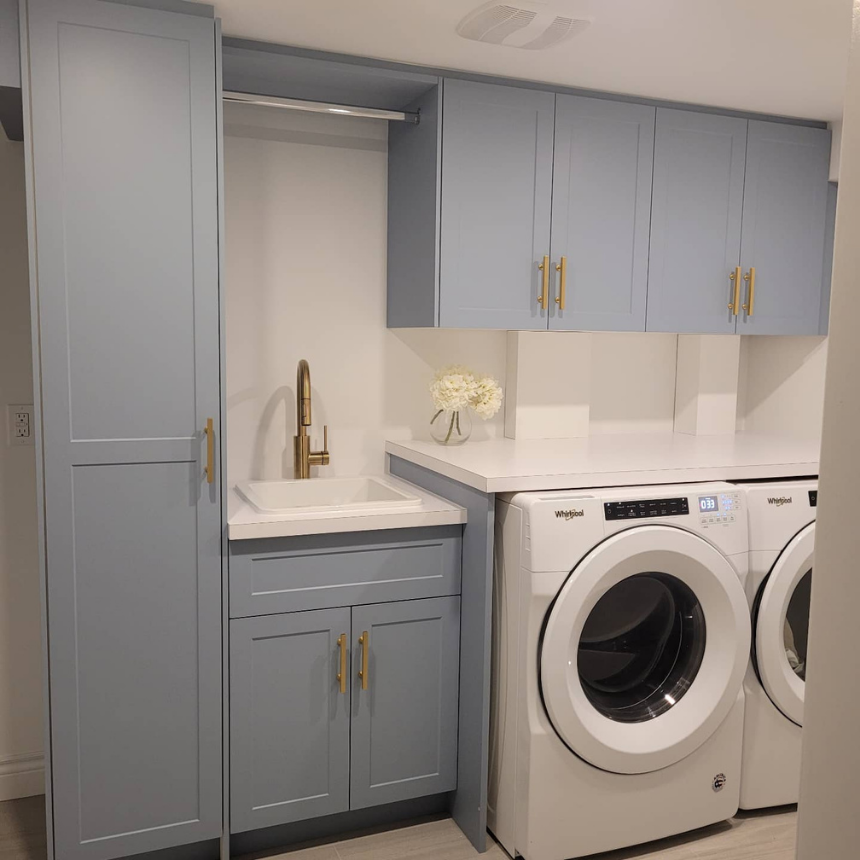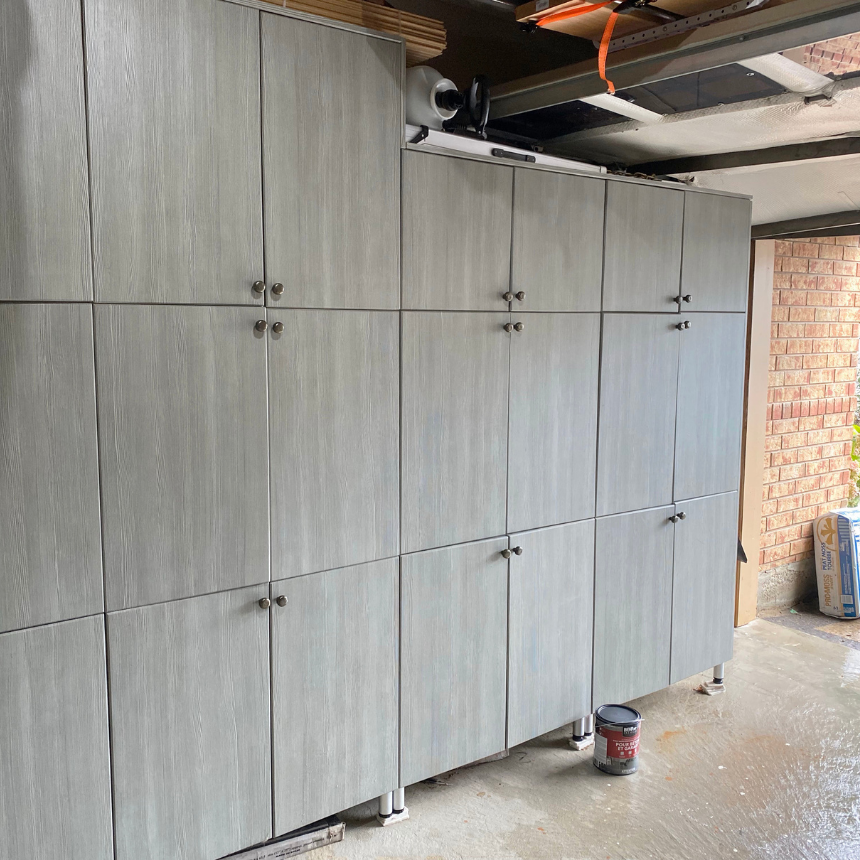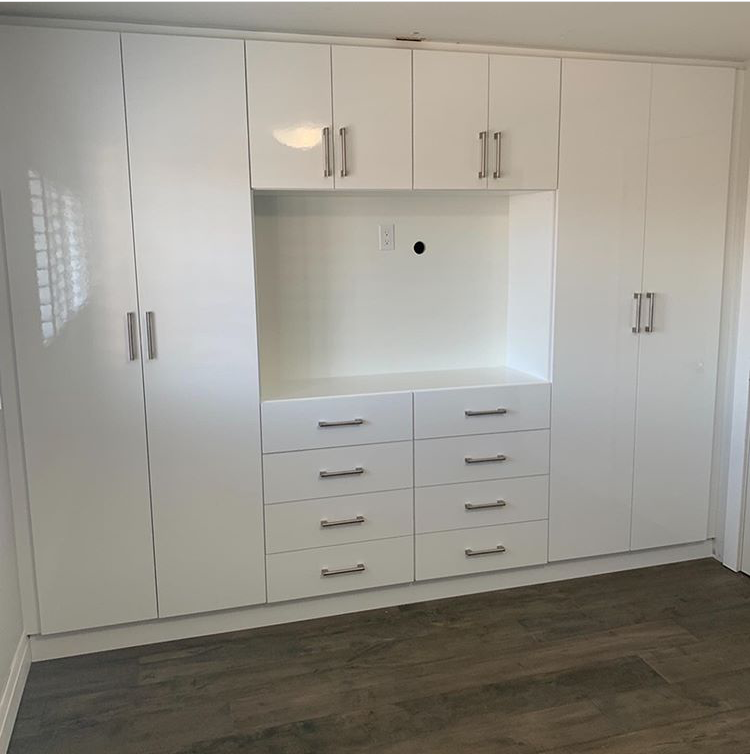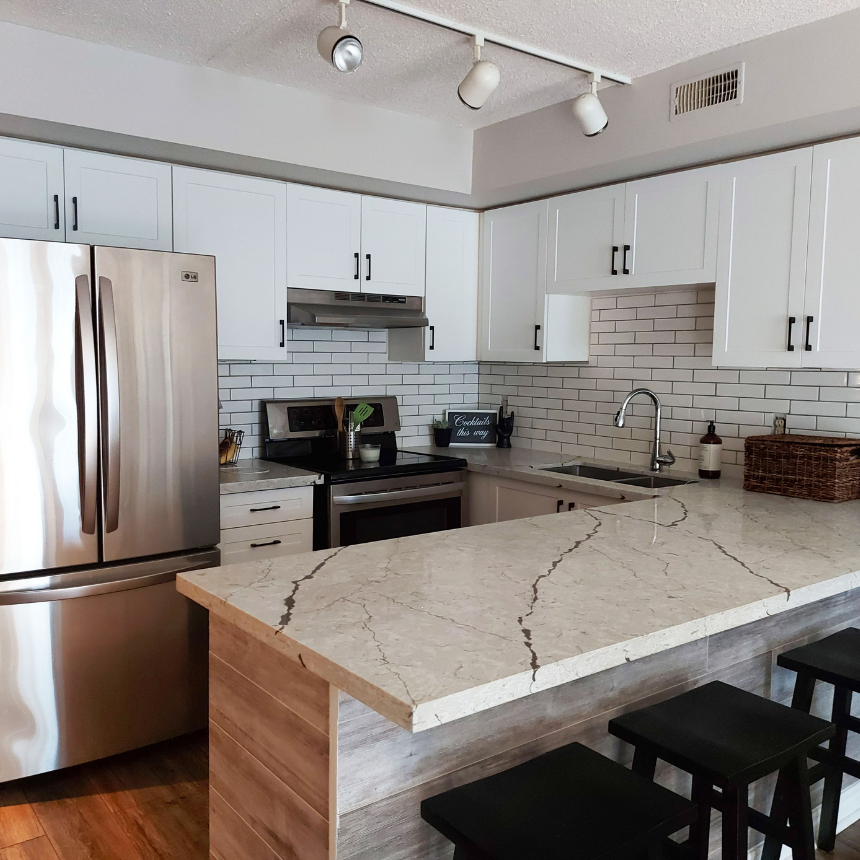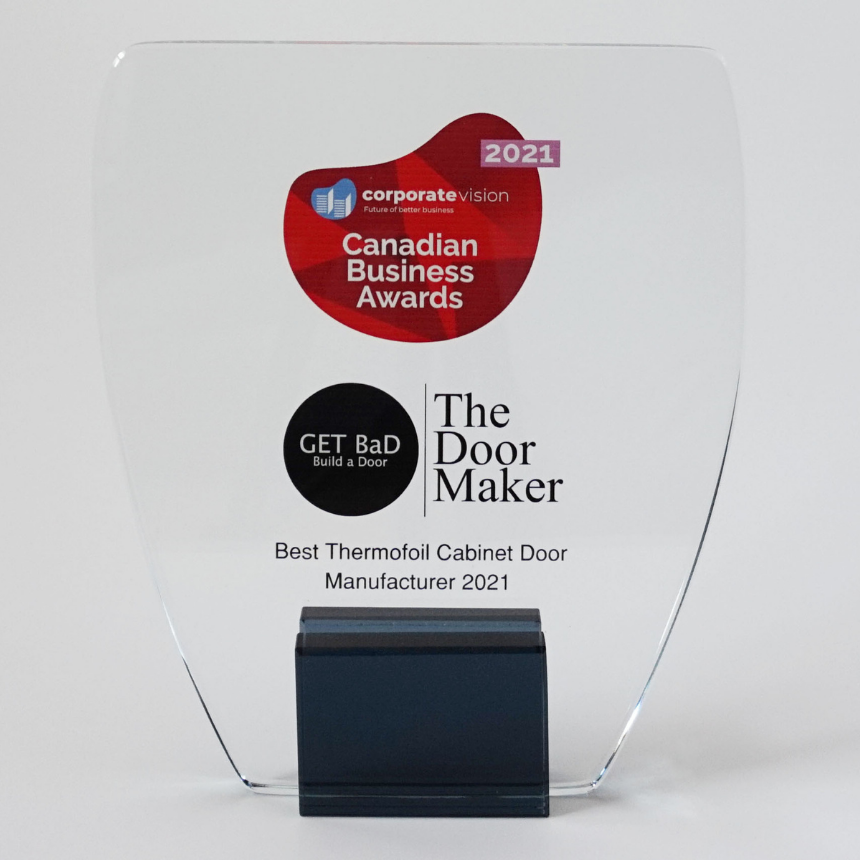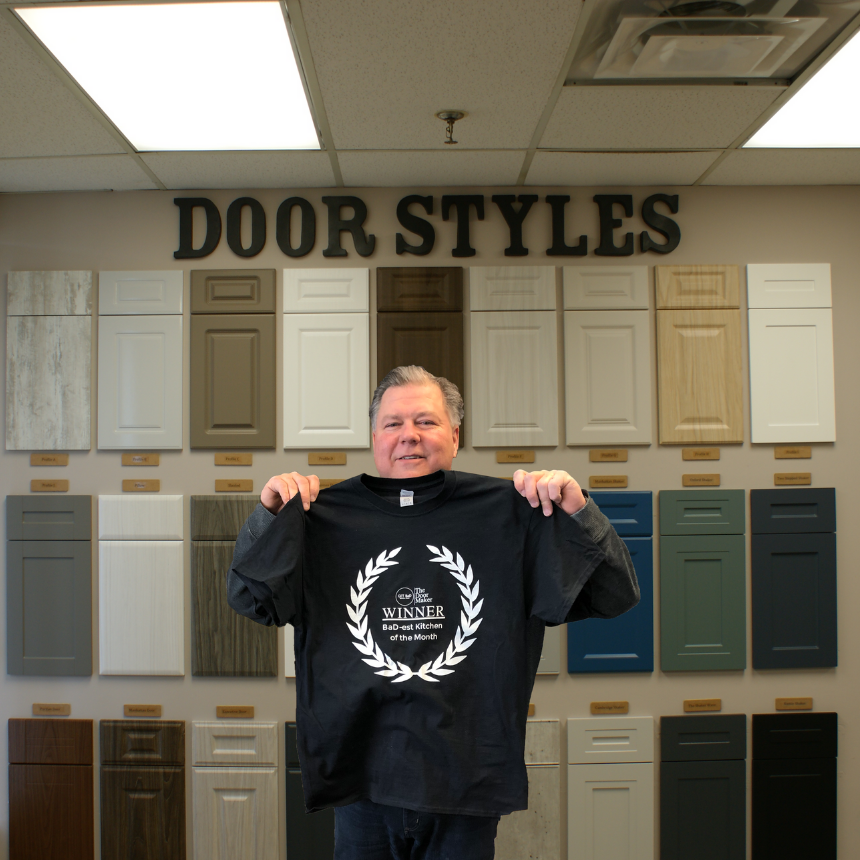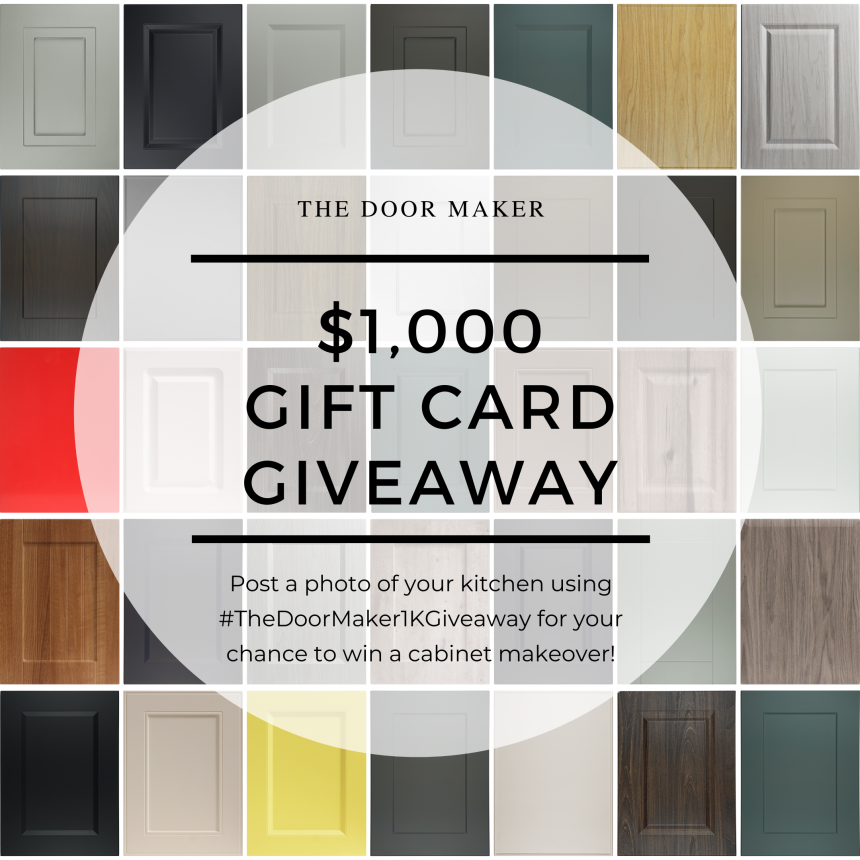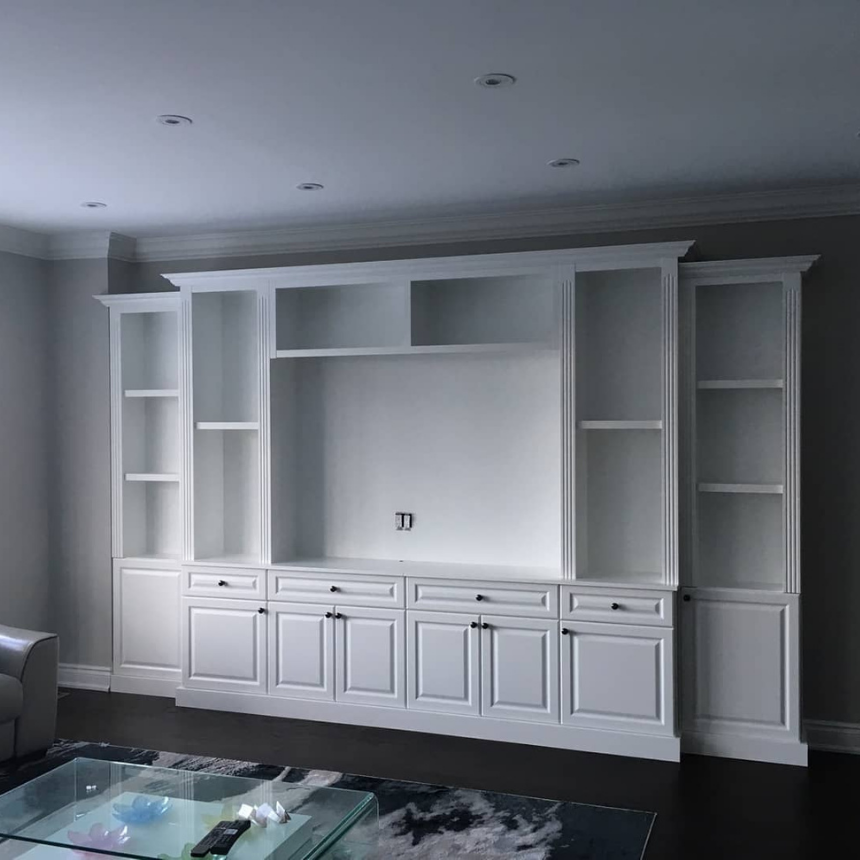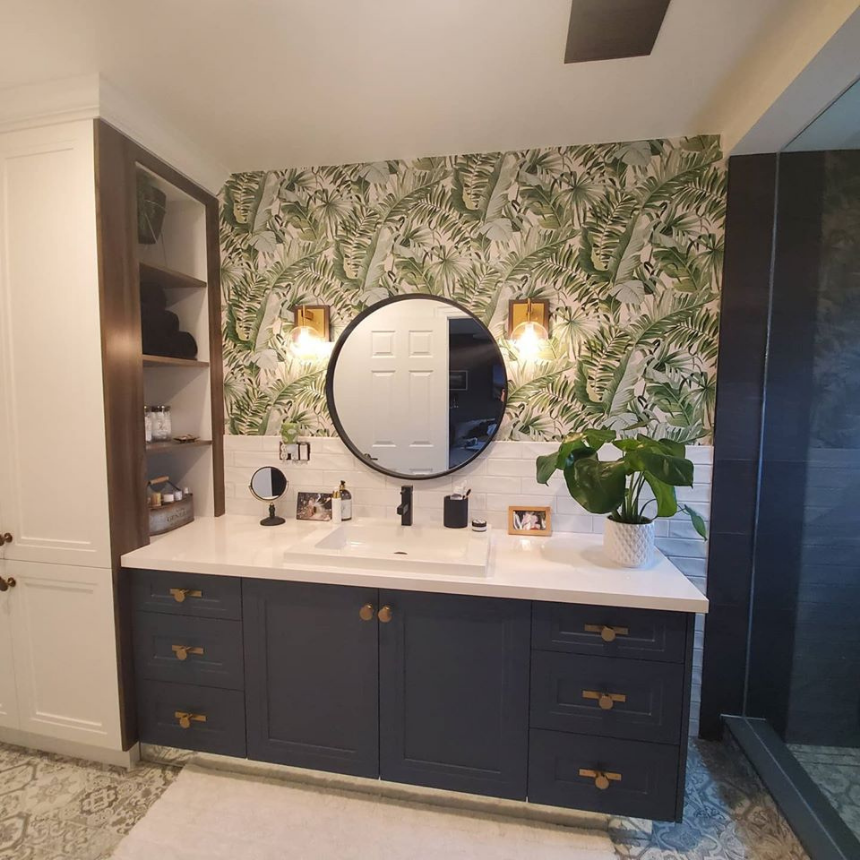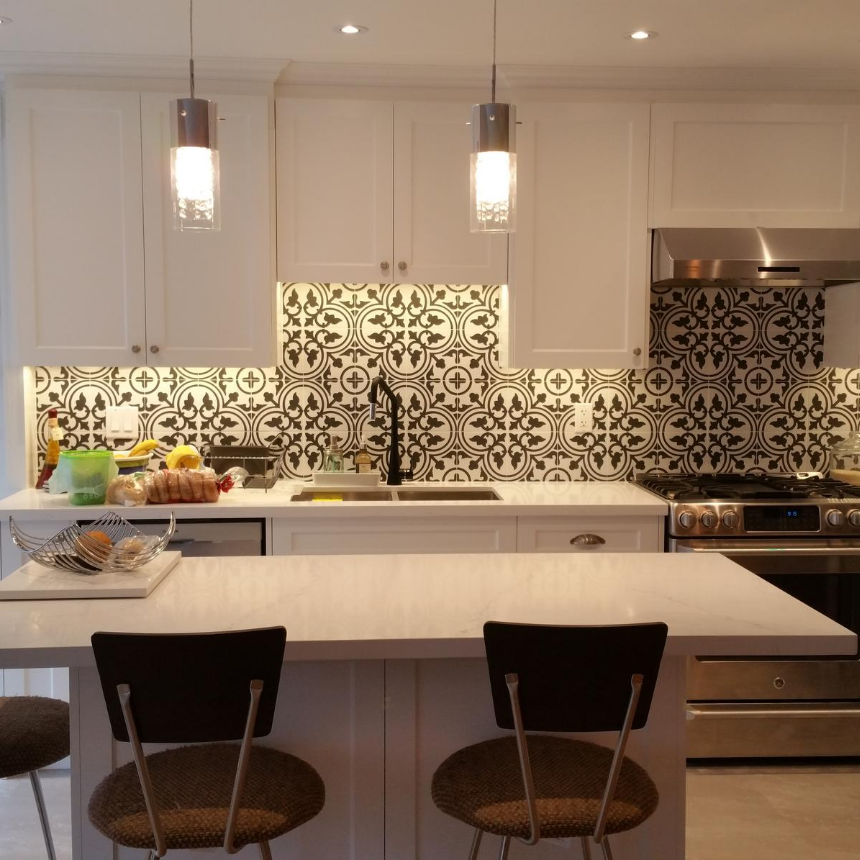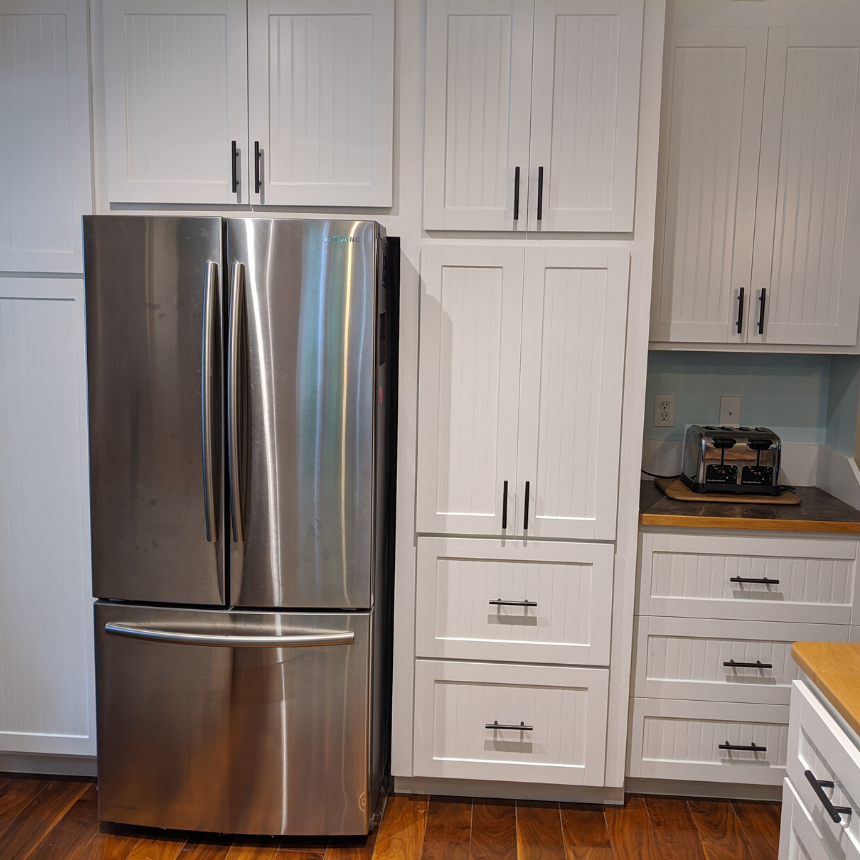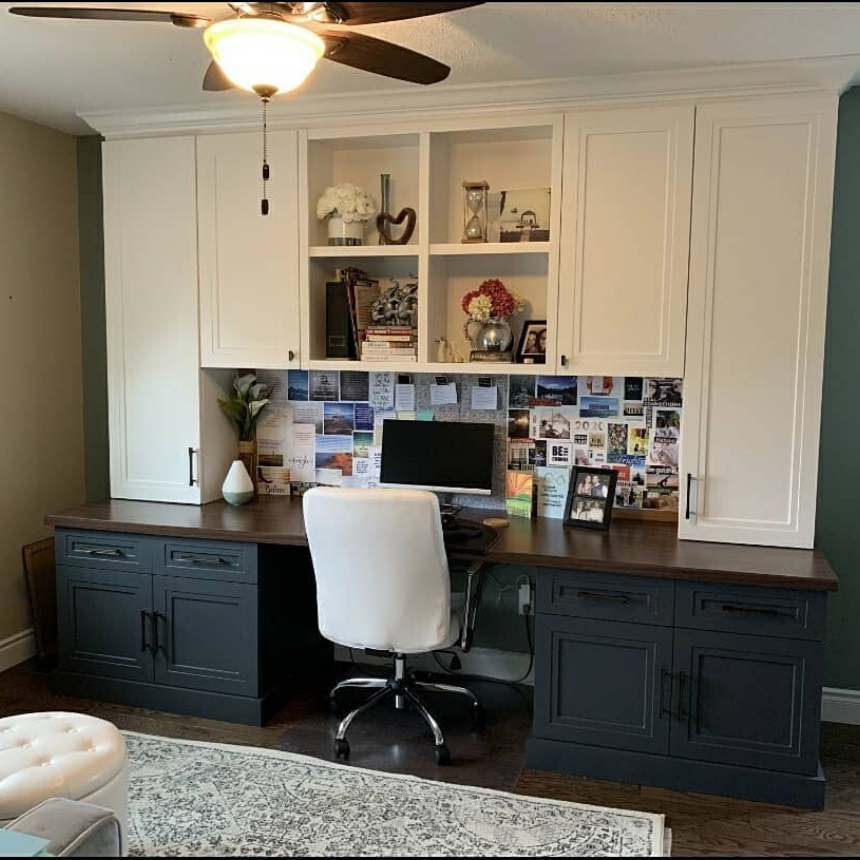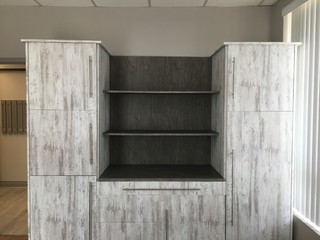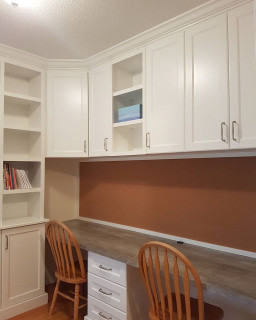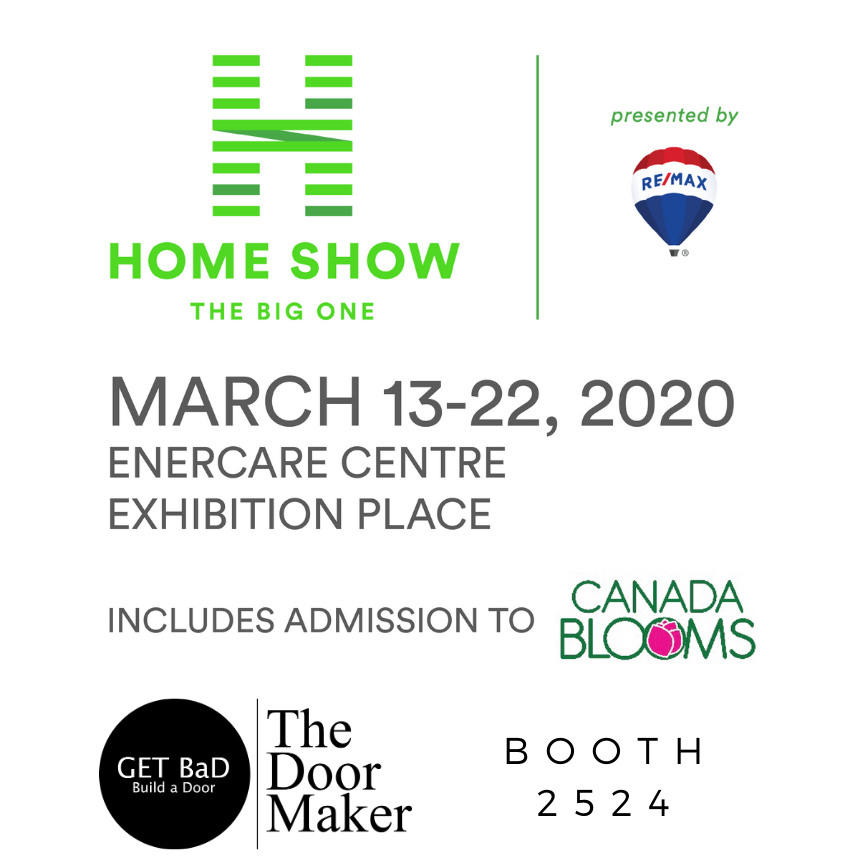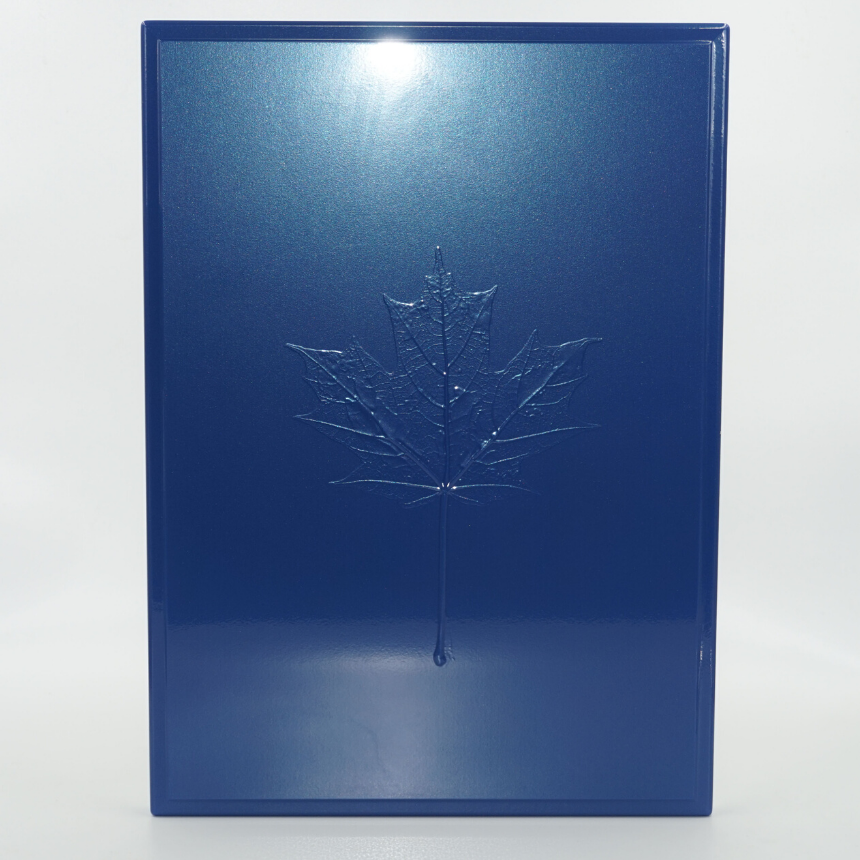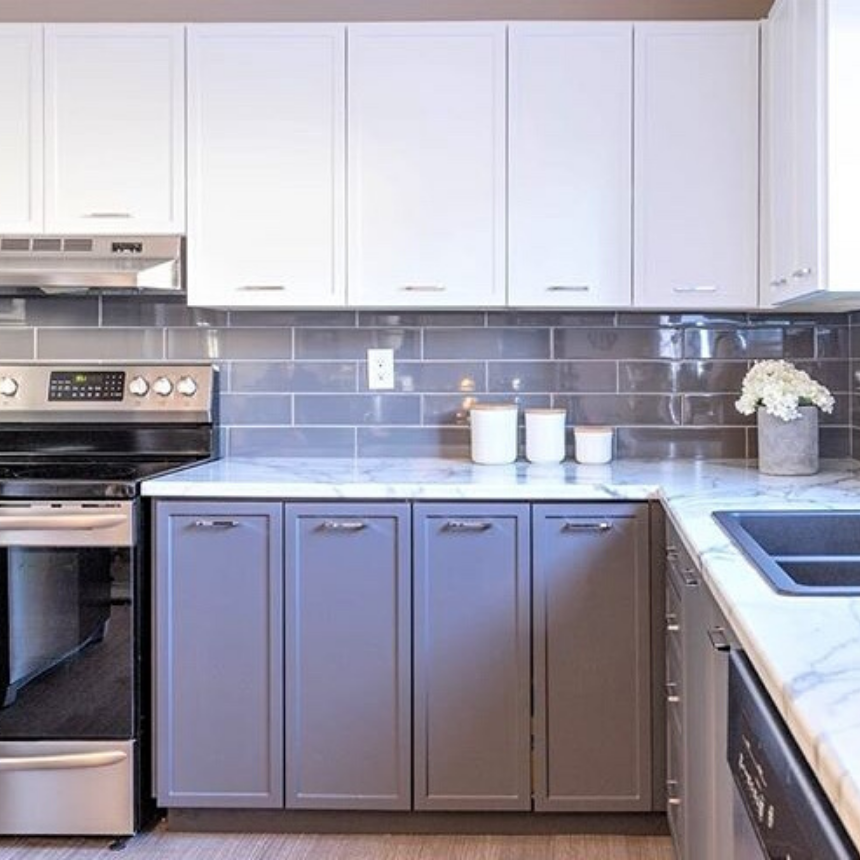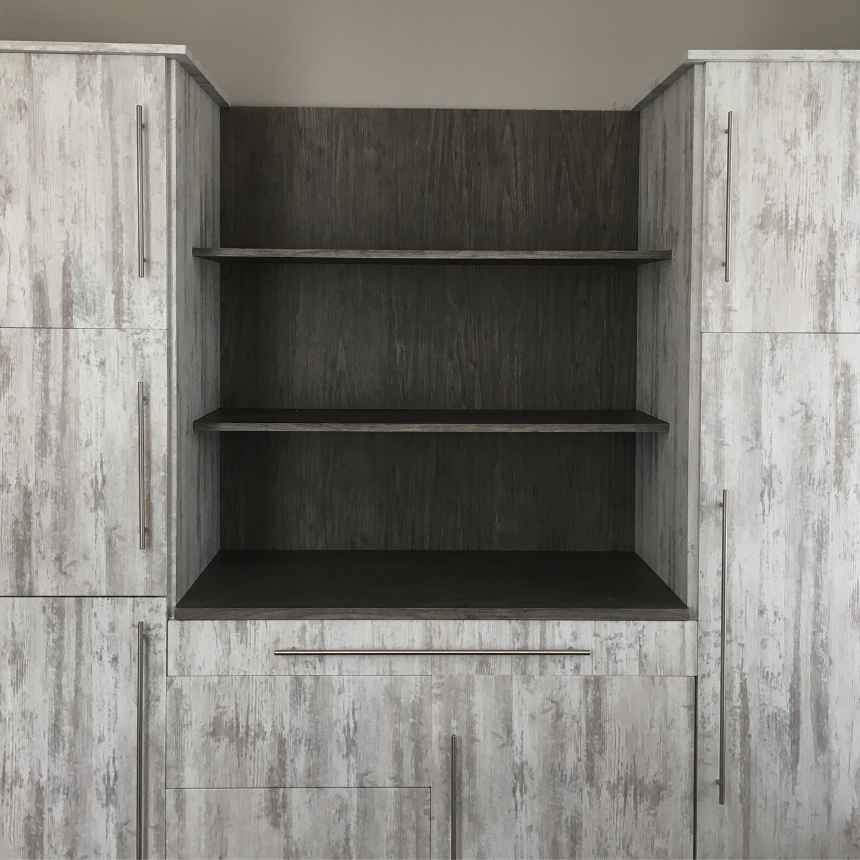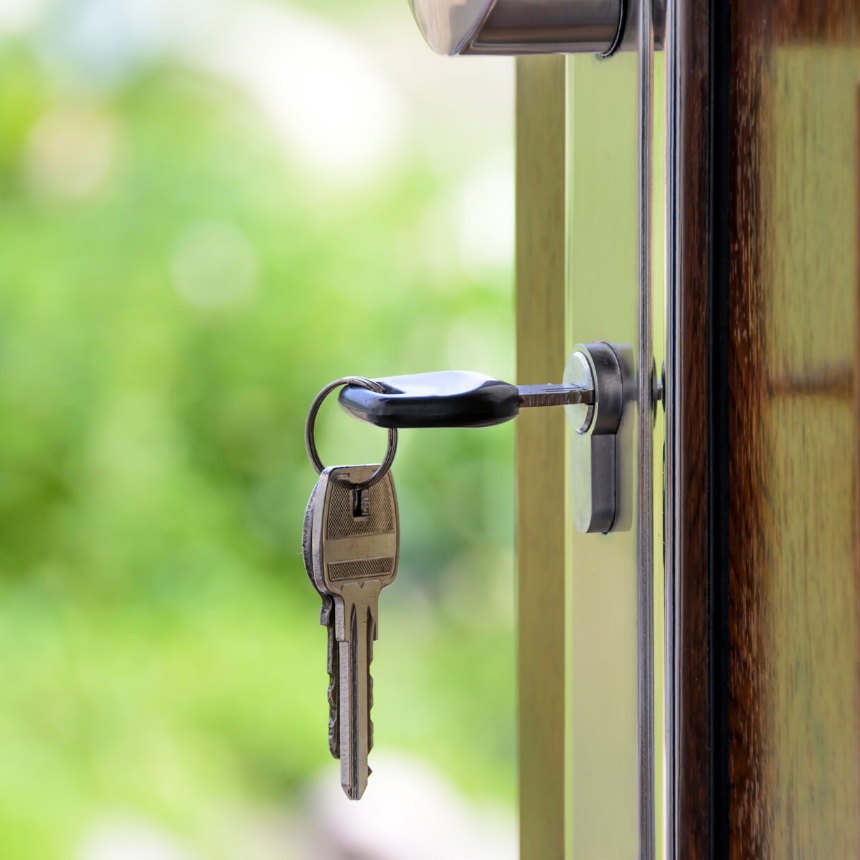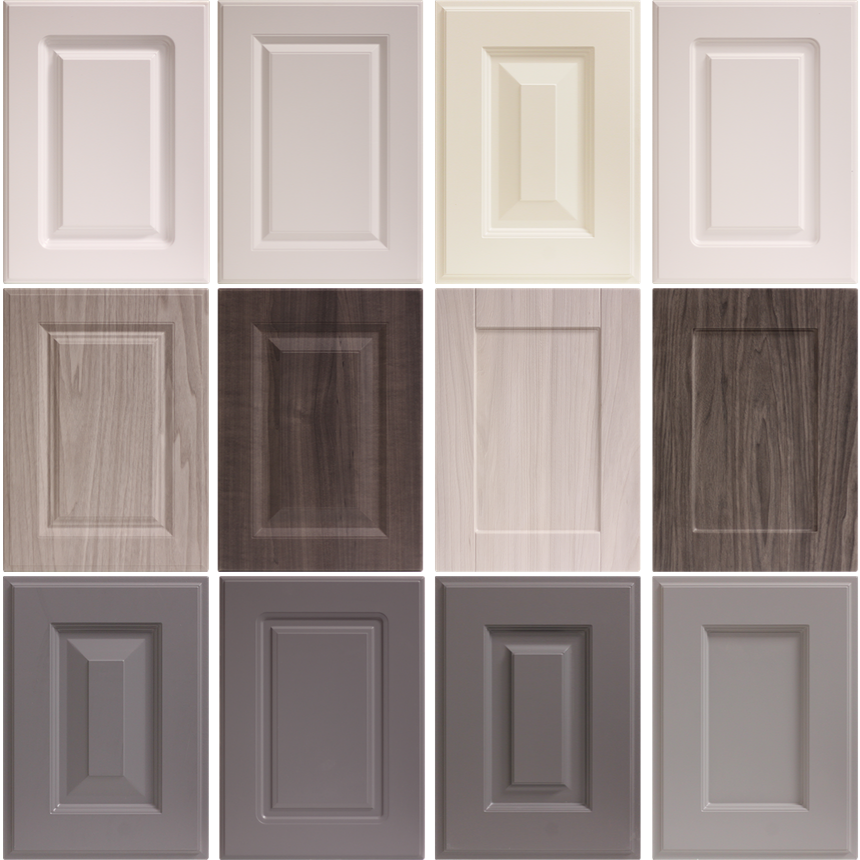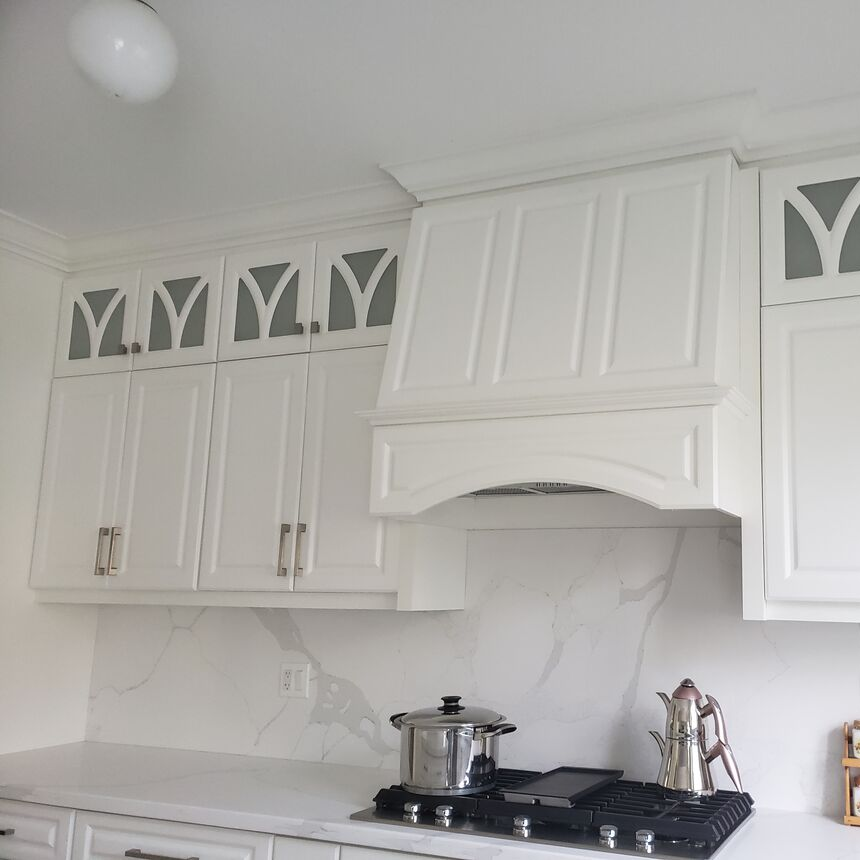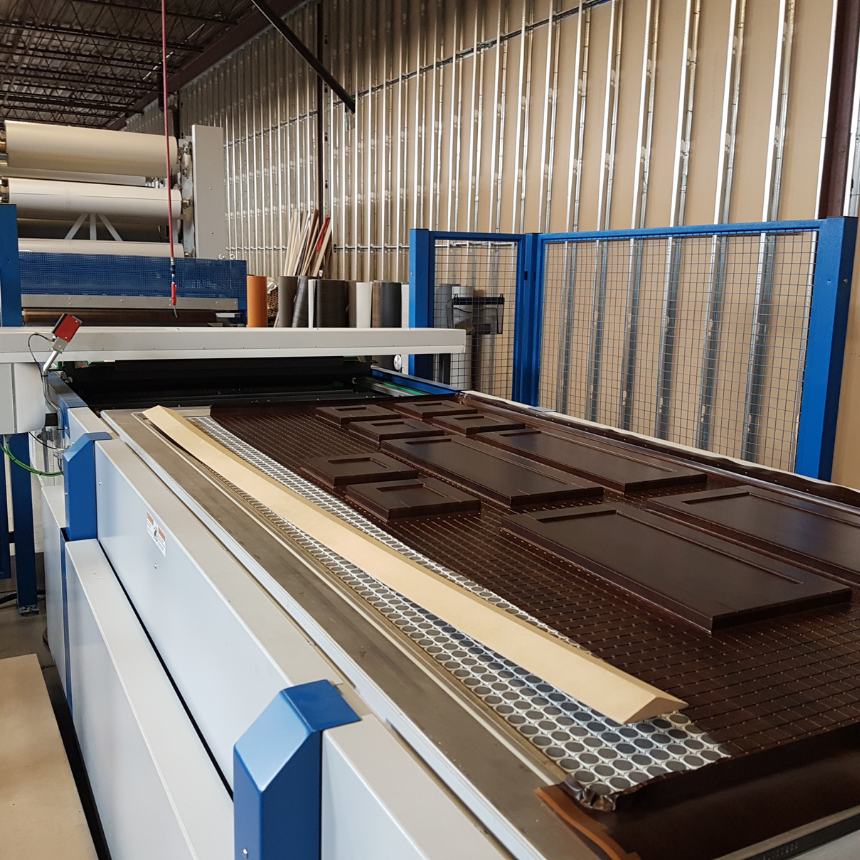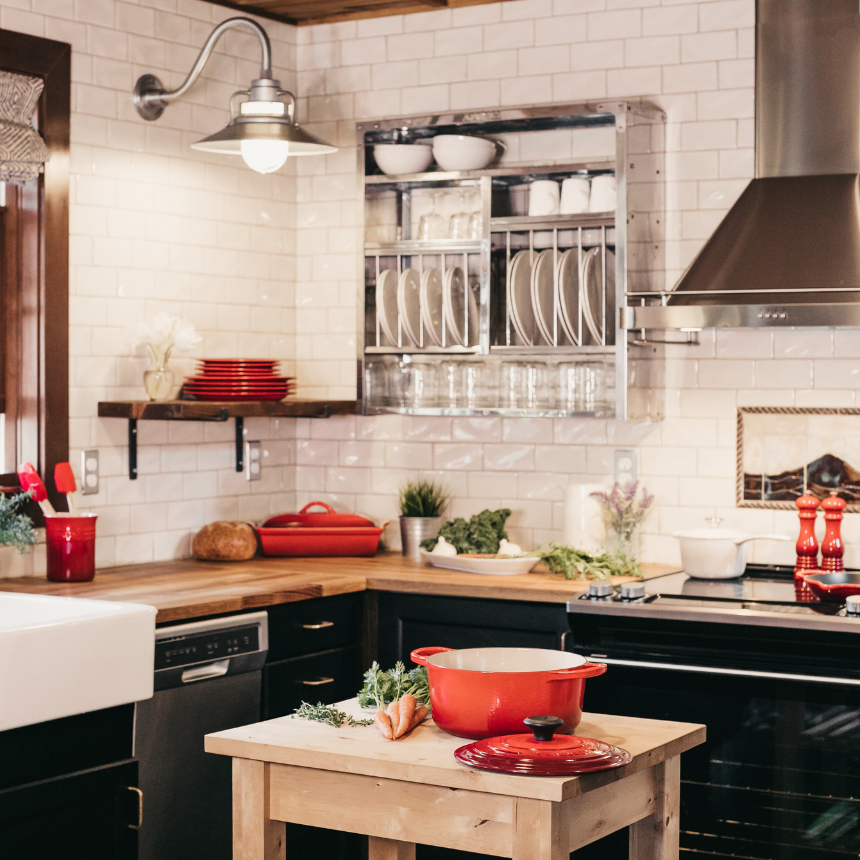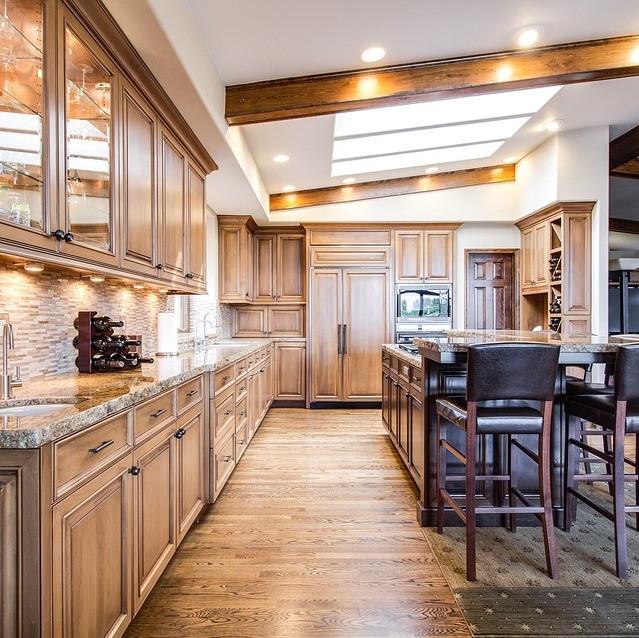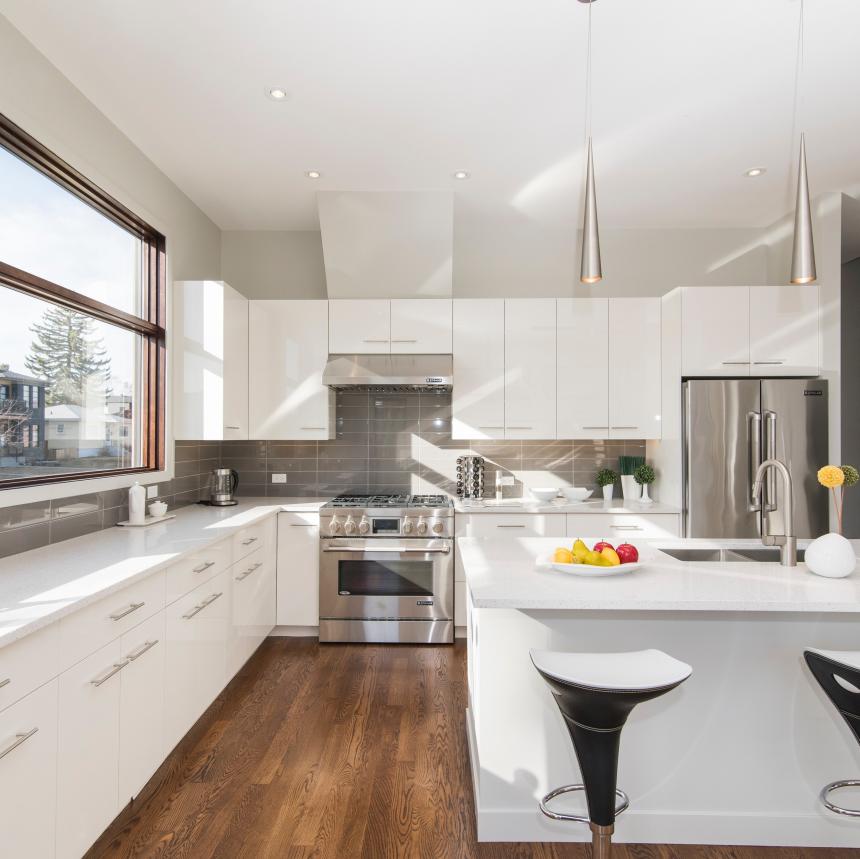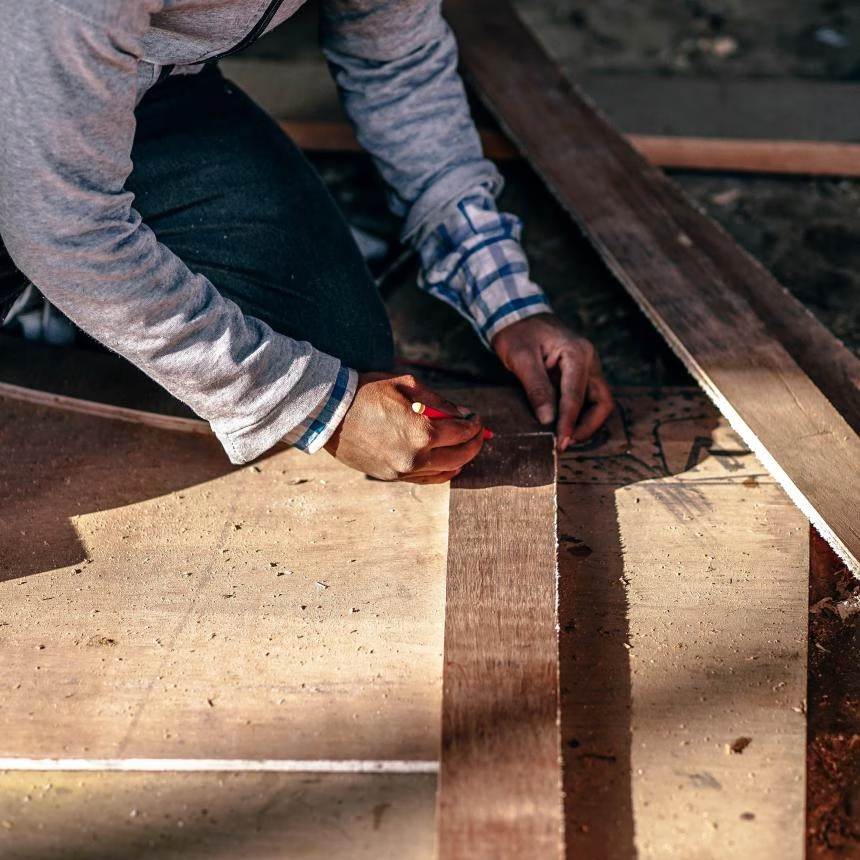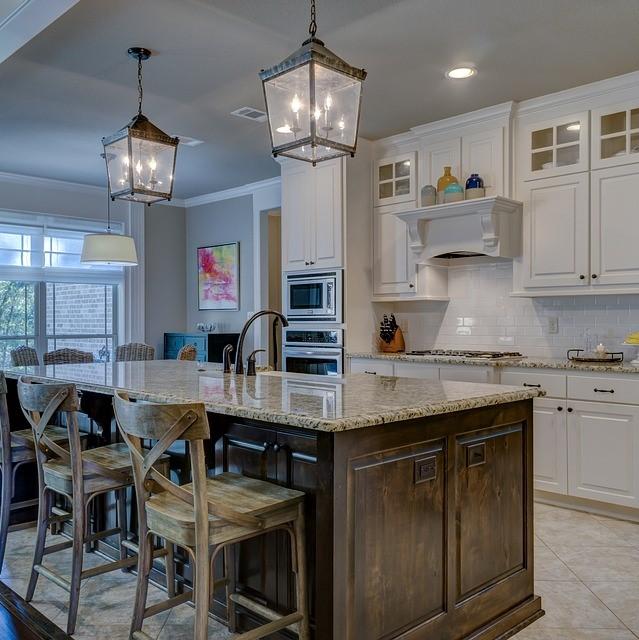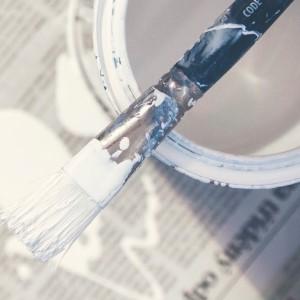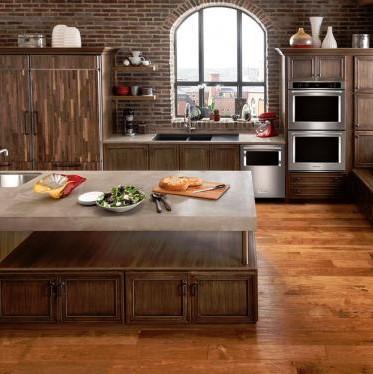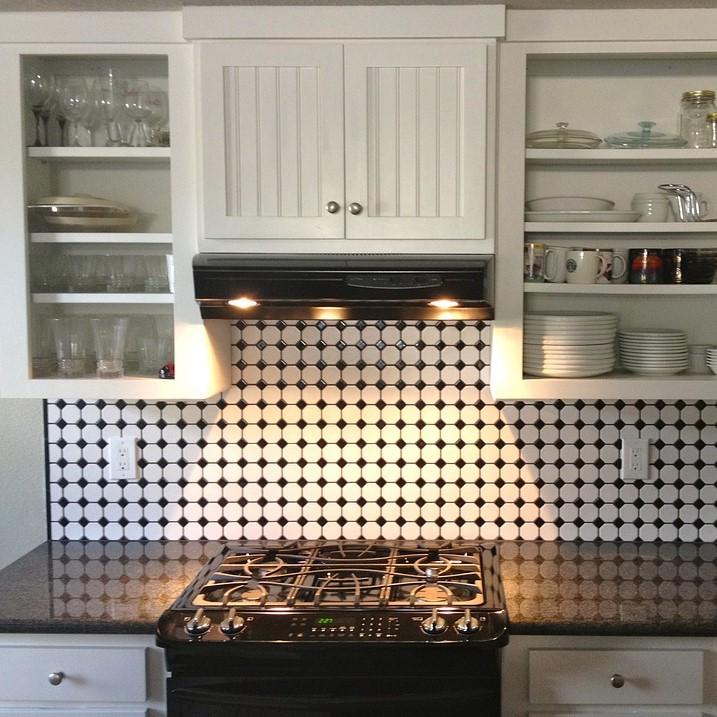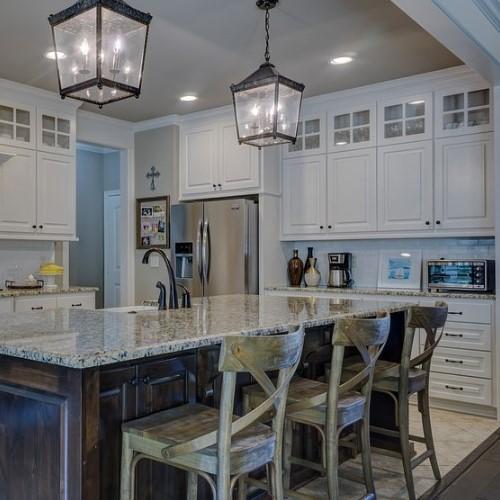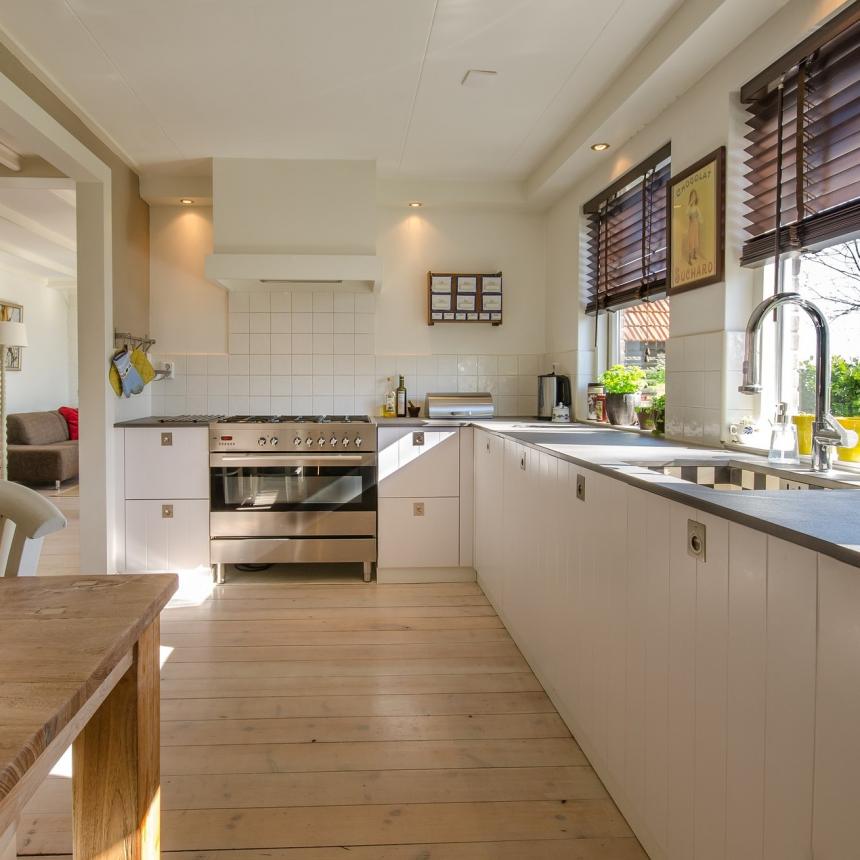Blog
Back to Blog listNov 12 2025 BY David Adrian, Blog
Gathering the Right Tools for the Job
A few minutes of organization now will save you from a ton of frustrating do-overs later. You only need a few simple things, but they need to be the right things. A flimsy, old tape measure just won't cut it. They can sag or even stretch, which is a recipe for disaster when you're ordering custom doors. Your most important tool is a high-quality steel tape measure. It gives you the rigidity you need for a perfectly straight, precise reading, especially when you're measuring a wide opening. Next, grab a simple notepad and a pencil. It's tempting to just jot numbers down on a scrap of wood or punch them into your phone, but don't. A dedicated notepad keeps your width and height measurements organized and easy to read, which seriously cuts down on the chance of mixing them up. For example, a note like "Upper Cabinet #1: 18" W x 32" H" is much clearer than a random "18x32" in your phone's notes.Pro Tip: Always double-check if your cabinet frames are square. This is a big one, especially in older homes where things have had time to settle. Just hold a small level against the frame—it'll tell you instantly if it's plumb. This quick check can save you a headache and explain why you might be getting different measurements at the top and bottom of an opening.Here's a quick rundown of what you'll want on hand:
- Steel Tape Measure: This is non-negotiable for accurate, consistent readings.
- Notepad & Pencil: To keep every measurement clear and organized.
- Straight Edge or Level: Perfect for checking if frames are square and helping you draw straight lines if needed.
How to Measure Existing Doors for a Perfect Match
If you're already happy with how your current doors fit and you're just looking for a style upgrade, measuring your existing doors is a fantastic shortcut. But there's definitely a right way to do it. The biggest mistake I see people make is trying to measure a door while it's still hanging on the hinges—it’s a surefire way to get inaccurate numbers. To get a perfect measurement, you have to take the door off first. Lay it down on a flat, stable surface like a workbench or even a clean spot on the floor. This gets rid of any sag from the hinges and guarantees your tape measure lies perfectly straight. Once it's flat, carefully measure the exact height and width down to the nearest 1/16th of an inch.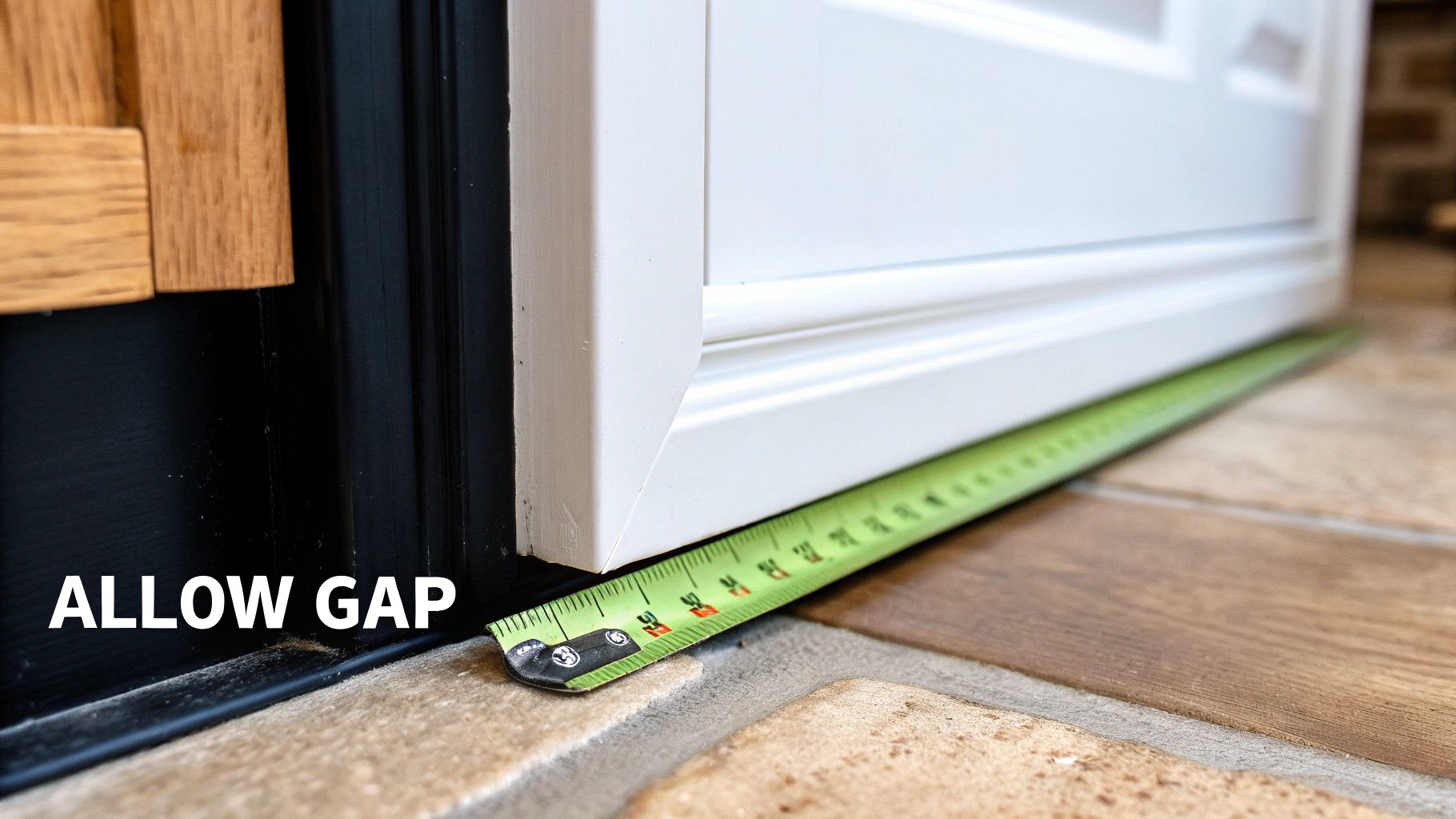
Don't Forget Hinge Placement
Getting the height and width is only half the battle. The most critical step—and the one people often forget—is to measure for your hinge placements. If you skip this, your new doors won't line up with the existing hinge holes on your cabinet frames, and that's a massive headache you don't want. You'll need to record the distance from both the top and bottom edge of the door to the center of each hinge cup hole. That's the large, round recess where the hinge itself sits.For example, if your top hinge cup is 3 inches from the top edge of the door, and the bottom hinge is 3 inches from the bottom edge, you need to write those exact numbers down. This precision is what turns the project into a seamless swap instead of a frustrating struggle.This step is an essential part of the process when you want to transform your kitchen by replacing cabinet doors without the pain of redrilling your cabinet frames. A few extra moments of careful measuring here will pay off big time. To make sure you don't miss anything, just follow this simple checklist for each door:
- Door Width: Measured flat, to the nearest 1/16".
- Door Height: Measured flat, to the nearest 1/16".
- Top Hinge: Distance from the top edge to the center of the hinge cup.
- Bottom Hinge: Distance from the bottom edge to the center of the hinge cup.
Common Measuring Mistakes and How to Avoid Them
Even with the best intentions, a few simple mistakes can derail your entire cabinet door project. We’ve seen it happen. Let’s walk through the common traps people fall into and, more importantly, how you can sidestep them for a flawless result. These small details are often the difference between a professional finish and a frustrating redo. One of the most frequent slip-ups is just mixing up the width and height measurements on your notepad. It sounds basic, but in the middle of a project, it happens more than you’d think. Always, always label your numbers clearly—something like "15” W x 30” H"—to avoid any confusion when it's time to place your order.Overlooking the Details
Another classic mistake is forgetting to correctly account for your overlay or necessary clearance gaps. We once had a homeowner who measured perfectly for a set of inset doors but forgot to subtract the crucial 1/8-inch clearance gap on all sides. The result? Beautiful new doors that were just slightly too big and wouldn't close. A real headache.The old carpenter’s mantra, "Measure twice, cut once," is the golden rule here. Before you finalize anything, do yourself a favor and double-check every single number on your list against the actual cabinet frames. This one final check is your best insurance policy against costly errors.Getting these measurements right is absolutely vital. The global cabinet door market was valued at around USD 17 billion in 2025, a figure that shows just how massive this industry is. Improper sizing doesn't just affect your project; it contributes to waste and installation issues that have a ripple effect. Avoiding these common pitfalls is a huge step toward a successful project. For those looking to dive deeper, our guide on refacing kitchen cabinet doors offers even more tips that can help ensure a smooth process from start to finish.
Answering Your Cabinet Measurement Questions
Even with the most detailed guide, there are always a few questions that pop up right when you think you’re done measuring. We’ve been there. To help you get over that final hurdle, we’ve pulled together the most common questions we hear from customers and installers alike.To make life easy when using Ikea cabinets.
Order the doors according to Ikea's catalogue guide.Ready to turn those perfect measurements into the perfect doors? At The Door Maker, our “Build a Door” tool makes it simple to design the exact custom cabinet doors you've been imagining. Start your project today at https://www.tdm-thedoormaker.com. Article created using Outrank
Nov 12 2025 BY Ksenija Lebec, Blog
Testing Your Measurements and Installation Skills the Practical Way
When renovating a kitchen, updating a bathroom, or simply refreshing your storage spaces, ordering cabinet doors is a key step. Many suppliers offer sample doors to help you judge finish and style. But is a sample door really the best option for do-it-yourselfers or those looking for a hands-on trial? In most cases, choosing a real, small cabinet door is far more valuable than a sample piece that may never see actual use.
The Limitations of Sample Doors
Sample doors are designed to showcase material, colour, and style. Typically, they’re smaller than a standard cabinet door—often just a segment or a panel. While they may help with colour matching and aesthetic decisions, they fall short in providing a true sense of the final product’s fit and function. After all, you’re not installing a panel—you’re installing a full door.
Why Actual Cabinet Doors Are Superior
- Real-World Measurement Testing
- Ordering a real small cabinet door lets you verify your measuring skills in a tangible way. You can check the fit against your cabinet frame, confirm hinge placement, and ensure the door opens and closes smoothly. This is a critical step, especially for first-time installers or those working with tricky, older cabinetry. Unlike a sample, a real door gives you the opportunity to identify and correct measurement errors before committing to a full order.
- Installation Practice
- Installing a cabinet door isn’t just about screwing it into place. You need to align hinges, check for level, and ensure the door sits flush with neighbouring cabinets. With a real door, you can practice these installation steps and develop confidence in your abilities. A sample can’t give you this experience.
- Immediate, Practical Use
- Unlike samples that often get tossed in a drawer or left on a shelf, a small cabinet door can be put to real use. Whether you fit it to a small cabinet, use it as a test piece, or even repurpose it later, you get more value for your money.
- Validating Supplier Quality
- By ordering a true cabinet door, you can assess the manufacturer’s craftsmanship, finish quality, and hardware compatibility. You’ll know exactly what you’re getting before you invest in a full set of doors for your project.
How to Order and Test a Small Cabinet Door
When placing an order, select the smallest cabinet door size that matches your project specs. Use your standard measuring tools—metric tape measures are best for accuracy—and follow supplier instructions for hinge boring and hardware placement. After receiving the door, install it on a cabinet that closely matches your target cabinets. Take note of any fit issues, installation challenges, or adjustments needed. This trial run can save you stress and money in the long run.
Conclusion
While sample doors have their place, they’re no substitute for the hands-on learning and confidence you gain from ordering and installing a real cabinet door—even a small one. By putting your measuring and installation skills to the test, you ensure a smoother renovation or upgrade, and you’re less likely to end up with costly mistakes. In the world of home improvement, practical experience is always better than a pretty sample.
Nov 11 2025 BY David Adrian, Blog
Advantages of Choosing MDF Cabinet Doors
When it comes to home renovations, especially in kitchens and bathrooms, cabinet doors play a crucial role in both the aesthetics and functionality of the space. Medium Density Fiberboard (MDF) cabinet doors have gained popularity due to their affordability, versatility, and durability. Whether you’re a homeowner planning a DIY project or working with a professional, understanding the advantages of choosing MDF cabinet doors can help you make an informed decision. Medium Density Fiberboard, or MDF, is an engineered wood product made by breaking down hardwood or softwood residuals into wood fibers. These fibers are then combined with wax and a resin binder under high pressure and heat to form panels. MDF is denser than plywood and offers a smooth, uniform surface that is perfect for cabinet doors.Key Advantages of MDF Cabinet Doors
Cost-Effectiveness
One of the most significant advantages of MDF cabinet doors is their cost-effectiveness. MDF is generally less expensive than solid wood, making it an ideal choice for budget-conscious homeowners. Despite its affordability, MDF does not compromise on quality, offering a comparable aesthetic to more expensive materials.Versatility in Design
MDF cabinet doors provide great design versatility. They can be easily cut, routed, and customized to fit your specific design needs, whether you’re looking for traditional or modern styles. This flexibility makes MDF a popular choice for custom MDF cabinets, allowing homeowners to achieve a bespoke look without the high costs associated with custom solid wood doors.Smooth Surface Finish
The smooth and uniform surface of MDF makes it an excellent substrate Build a Doors 130 plus thermofoil finishes. Unlike solid wood, MDF does not have grain, which means it can be painted or veneered to achieve a flawless finish. This feature is particularly appealing for those looking to create modern MDF doors with sleek, clean lines.Durability and Stability
MDF is known for its durability and stability. Unlike solid wood, MDF does not warp or crack with changes in humidity and temperature, making it a reliable choice for kitchen and bathroom environments. Its density also provides a solid, substantial feel, similar to that of real wood, which is why solid MDF cabinet doors are a preferred option for many.Eco-Friendly Option
For environmentally-conscious homeowners, MDF offers an eco-friendly alternative. MDF is made from wood fibers and resin, often utilizing wood byproducts that would otherwise go to waste. By choosing MDF cabinet doors, you’re supporting the use of sustainable materials.Comparing MDF to Other Materials
MDF vs. Solid Wood
While solid wood is a traditional choice for cabinet doors, it comes with a higher price tag and potential for warping and cracking. MDF offers a more affordable and stable alternative, with a smooth surface that can mimic the appearance of painted wood.MDF vs. Plywood
Plywood is another common material used for cabinet doors. While it is stronger than MDF, it doesn’t provide the same smooth finish. MDF’s uniform surface is better suited for painted finishes and intricate designs, making it a popular choice for modern styles.DIY and Customization Opportunities
For DIY enthusiasts, MDF cabinet doors offer an excellent opportunity for customization. Raw MDF cabinet doors can be easily sanded and painted to match any interior design scheme. Whether you’re looking to add a splash of color or prefer a classic white finish, MDF provides a blank canvas for creativity.Where to Find MDF Cabinet Doors
MDF cabinet doors are widely available and can be purchased from home improvement stores, specialized cabinet manufacturers, and online retailers. For those located in Canada, MDF cabinet doors Canada suppliers offer a range of options to suit different design preferences and budgets.
Conclusion
MDF cabinet doors offer numerous advantages that make them a popular choice for homeowners and professionals alike. Their affordability, design versatility, smooth finish, and durability make them an excellent option for any home renovation project. Whether you’re looking to create custom MDF cabinets or simply update your kitchen with modern MDF doors, the benefits of MDF are clear. By choosing MDF, you’re investing in a material that delivers both style and substance. Consider exploring the variety of MDF board for cabinet doors available to find the perfect fit for your next project. Embrace the possibilities that MDF cabinet doors offer and transform your space with confidence.Nov 5 2025 BY David Adrian, Blog
Alright, before you even think about measuring, let's get your gear in order. A little prep work here goes a long way and honestly makes the whole process smoother and more accurate.
Gathering the Right Tools for the Job
A few minutes of organization now will save you from a ton of frustrating do-overs later. You only need a few simple things, but they need to be the right things.
A flimsy, old tape measure just won't cut it. They can sag or even stretch, which is a recipe for disaster when you're ordering custom doors. Your most important tool is a high-quality steel tape measure. It gives you the rigidity you need for a perfectly straight, precise reading, especially when you're measuring a wide opening.
Next, grab a simple notepad and a pencil. It's tempting to just jot numbers down on a scrap of wood or punch them into your phone, but don't. A dedicated notepad keeps your width and height measurements organized and easy to read, which seriously cuts down on the chance of mixing them up. For example, a note like "Upper Cabinet #1: 18" W x 32" H" is much clearer than a random "18x32" in your phone's notes.
Pro Tip: Always double-check if your cabinet frames are square. This is a big one, especially in older homes where things have had time to settle. Just hold a small level against the frame—it'll tell you instantly if it's plumb. This quick check can save you a headache and explain why you might be getting different measurements at the top and bottom of an opening.
Here's a quick rundown of what you'll want on hand:
Steel Tape Measure: This is non-negotiable for accurate, consistent readings.
Notepad & Pencil: To keep every measurement clear and organized.
Straight Edge or Level: Perfect for checking if frames are square and helping you draw straight lines if needed.
I once had a client who used a fabric sewing tape for their measurements. It sounds silly, but it happens. Their numbers were off by nearly a quarter-inch, and that tiny error made their beautiful custom doors completely unusable. Using the right tools is truly the first—and most important—step to getting this project done right.
Cracking the Code on Cabinet Overlays

Before you even think about touching a tape measure, you need to understand how your doors sit on the cabinet frame. This is called overlay, and it’s the single biggest factor in getting your door sizes right. A measurement for one style will be completely wrong for another, so this is a critical first step.
Simply put, overlay describes how much of the cabinet face frame the door covers when closed. Getting this right dictates the entire formula for your final door dimensions.
Full Overlay Doors
Just like the name says, full overlay doors cover almost the entire cabinet face frame. This gives you that modern, seamless look with very tight gaps between doors. When you look at the cabinets, you see door, door, door—and very little of the frame behind them.
To measure for a single full overlay door, you’ll take the opening's width and height, then add the overlay amount to each dimension. A very common overlay is 1/2 inch, which means you’d add a total of 1 inch to the final width and height measurements (1/2 inch for the left side, 1/2 inch for the right, and so on).
Here's a real-world example: If your cabinet opening is 16 inches wide by 30 inches high, and you want a standard 1/2 inch overlay:
Door Width: 16" + 1" = 17"
Door Height: 30" + 1" = 31"
Partial Overlay Doors
Partial overlay is the classic style you’ve probably seen in countless kitchens. Also known as traditional or standard overlay, the door only partially covers the face frame. This design leaves a good portion of the frame—usually 1 to 1.5 inches—exposed around each door.
The measuring process is the same as for full overlay, but you're just adding a smaller amount. For instance, with a 3/8 inch overlay, you'd add a total of 3/4 inch to the opening's width and height.
Practical Example: For that same 16-inch wide by 30-inch high opening, but with a 3/8-inch partial overlay:
Door Width: 16" + 3/4" = 16 3/4"
Door Height: 30" + 3/4" = 30 3/4"
A small mistake here can throw everything off. You could end up with doors that collide with each other or have sloppy, uneven gaps, completely ruining the professional look you're after. Nail the overlay, and the rest of the job becomes much easier.
Inset Doors
Inset doors are in a class of their own. They don't sit on top of the frame at all—they sit perfectly flush inside the cabinet opening. The face of the door is level with the cabinet frame, giving it a high-end, custom furniture appearance.
Measuring for inset doors is the opposite of the other styles; you subtract instead of add. You'll measure the opening precisely and then subtract a small amount, typically 1/8 inch total from both the width and height. This creates a tiny, consistent clearance gap so the door doesn't scrape against the frame.
Let's use our example opening: For a 16-inch wide by 30-inch high opening:
Door Width: 16" - 1/8" = 15 7/8"
Door Height: 30" - 1/8" = 29 7/8"
This kind of precision is more important than ever. The global cabinet market is projected to grow from USD 17.4 billion in 2025 to nearly USD 23.9 billion by 2033, and much of that growth is driven by a demand for accuracy that reduces waste and ensures a perfect fit.
Of course, the way a door fits is also tied directly to its hardware. To learn more about that piece of the puzzle, check out this a comprehensive guide to cabinet door hinge types.
Cabinet Door Overlay Measurement Guide
To make things easier, here’s a quick-reference table that breaks down the math for each style.
Door Style | Measurement Approach | Example Calculation |
|---|---|---|
Full Overlay | Opening + (Overlay x 2) | 16" Opening + (1/2" x 2) = 17" |
Partial Overlay | Opening + (Overlay x 2) | 16" Opening + (3/8" x 2) = 16 3/4" |
Inset | Opening - Clearance Gap | 16" Opening - 1/8" = 15 7/8" |
Keep this guide handy when you’re taking your measurements. It’s a simple way to double-check your work and ensure you order doors that will fit perfectly.
Measuring Cabinet Openings Like a Pro
Alright, let's get to the most important part: measuring your cabinet openings. This is where a little bit of precision goes a long way. I’m going to walk you through the same process the pros use to make sure every door hangs perfectly, and it all comes down to what we call the "rule of threes."
One thing you learn quickly is that cabinet frames, especially in older homes, are almost never perfectly square. Houses settle, wood shifts over the years, and things can get a bit skewed. Just measuring in one spot is a classic rookie mistake that leads to doors that scrape, bind, or have weird, uneven gaps.
The Rule of Threes in Practice
To work around any of these imperfections, you need to measure the width at the top, middle, and bottom of the opening. Then, you'll do the same for the height by measuring the left, middle, and right sides. This approach gives you the full story of the opening's actual shape, not just a single snapshot.
Once you have your three width and three height measurements, the rule is simple: always use the smallest measurement of the set. This is your safety net. It guarantees your new door will fit into the tightest point of the opening without any trouble.
Let’s say you measure the width and get these numbers:
Top: 15 inches
Middle: 15 1/16 inches
Bottom: 14 15/16 inches
In this case, you’d lock in 14 15/16 inches as your final width. That's the number you'll use when you calculate the final door size based on your chosen overlay.
This image really drives home the idea of capturing both the vertical and horizontal dimensions to get that perfect fit.
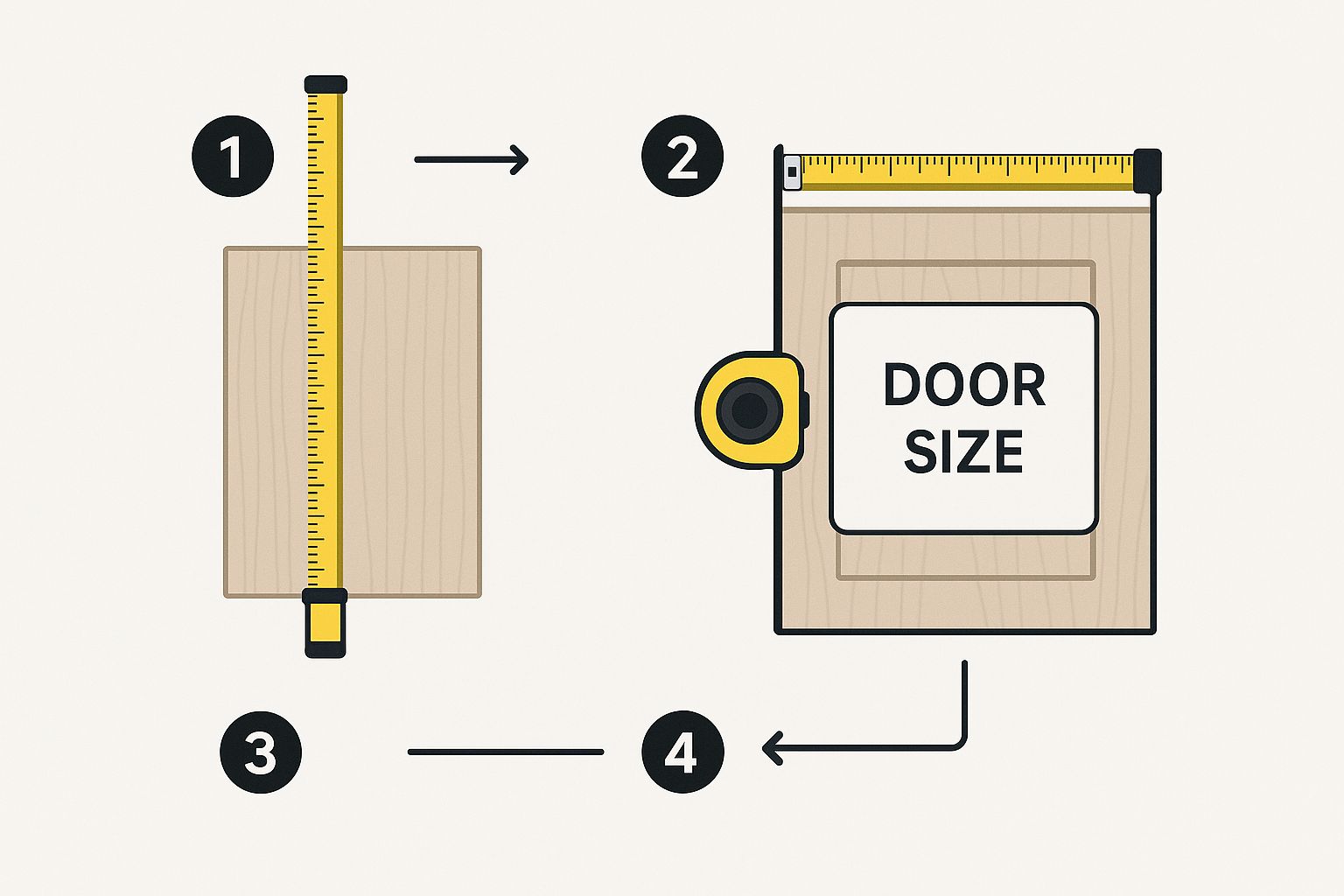
It’s a great visual reminder that both height and width need that same level of careful attention. These two dimensions are the foundation of your whole project.
Measuring for Double Doors
What about those wide openings that need a pair of doors? The process starts the same but has one extra step to make sure they meet perfectly in the center without clashing.
First, measure the opening's width using the rule of threes and take the smallest dimension, just like before. Now, you need to account for a small gap between the two doors so they don't smack into each other. A standard gap is 1/8 inch.
To figure out the width for each individual door, you'll add 1 inch for the overlay (assuming a standard 1/2-inch overlay on both sides), subtract the 1/8-inch gap, and then divide the whole thing by two.
Here's a practical example: Your opening is 30 inches wide.
Add Overlay: 30" + 1" = 31"
Subtract Gap: 31" - 1/8" = 30 7/8"
Divide by Two: 30 7/8" ÷ 2 = 15 7/16"
Each of your two doors should be 15 7/16 inches wide.
For a little more guidance, checking out an expert guide on how to measure kitchen cabinets can give you some extra tips and comprehensive techniques. Nailing these foundational skills is what makes for a flawless installation.
How to Measure Existing Doors for a Perfect Match
If you're already happy with how your current doors fit and you're just looking for a style upgrade, measuring your existing doors is a fantastic shortcut. But there's definitely a right way to do it. The biggest mistake I see people make is trying to measure a door while it's still hanging on the hinges—it’s a surefire way to get inaccurate numbers.
To get a perfect measurement, you have to take the door off first. Lay it down on a flat, stable surface like a workbench or even a clean spot on the floor. This gets rid of any sag from the hinges and guarantees your tape measure lies perfectly straight. Once it's flat, carefully measure the exact height and width down to the nearest 1/16th of an inch.

Don't Forget Hinge Placement
Getting the height and width is only half the battle. The most critical step—and the one people often forget—is to measure for your hinge placements. If you skip this, your new doors won't line up with the existing hinge holes on your cabinet frames, and that's a massive headache you don't want.
You'll need to record the distance from both the top and bottom edge of the door to the center of each hinge cup hole. That's the large, round recess where the hinge itself sits.
For example, if your top hinge cup is 3 inches from the top edge of the door, and the bottom hinge is 3 inches from the bottom edge, you need to write those exact numbers down. This precision is what turns the project into a seamless swap instead of a frustrating struggle.
This step is an essential part of the process when you want to transform your kitchen by replacing cabinet doors without the pain of redrilling your cabinet frames. A few extra moments of careful measuring here will pay off big time.
To make sure you don't miss anything, just follow this simple checklist for each door:
Door Width: Measured flat, to the nearest 1/16".
Door Height: Measured flat, to the nearest 1/16".
Top Hinge: Distance from the top edge to the center of the hinge cup.
Bottom Hinge: Distance from the bottom edge to the center of the hinge cup.
Capturing these four key dimensions ensures your new custom doors will be a perfect match, ready to hang on your existing cabinets with zero issues.
Common Measuring Mistakes and How to Avoid Them
Even with the best intentions, a few simple mistakes can derail your entire cabinet door project. We’ve seen it happen. Let’s walk through the common traps people fall into and, more importantly, how you can sidestep them for a flawless result. These small details are often the difference between a professional finish and a frustrating redo.
One of the most frequent slip-ups is just mixing up the width and height measurements on your notepad. It sounds basic, but in the middle of a project, it happens more than you’d think. Always, always label your numbers clearly—something like "15” W x 30” H"—to avoid any confusion when it's time to place your order.
Overlooking the Details
Another classic mistake is forgetting to correctly account for your overlay or necessary clearance gaps. We once had a homeowner who measured perfectly for a set of inset doors but forgot to subtract the crucial 1/8-inch clearance gap on all sides. The result? Beautiful new doors that were just slightly too big and wouldn't close. A real headache.
The old carpenter’s mantra, "Measure twice, cut once," is the golden rule here. Before you finalize anything, do yourself a favor and double-check every single number on your list against the actual cabinet frames. This one final check is your best insurance policy against costly errors.
Getting these measurements right is absolutely vital. The global cabinet door market was valued at around USD 17 billion in 2025, a figure that shows just how massive this industry is. Improper sizing doesn't just affect your project; it contributes to waste and installation issues that have a ripple effect.
Avoiding these common pitfalls is a huge step toward a successful project. For those looking to dive deeper, our guide on refacing kitchen cabinet doors offers even more tips that can help ensure a smooth process from start to finish.
Answering Your Cabinet Measurement Questions
Even with the most detailed guide, there are always a few questions that pop up right when you think you’re done measuring. We’ve been there. To help you get over that final hurdle, we’ve pulled together the most common questions we hear from customers and installers alike.
Key Questions Answered
So, what’s the standard overlay for modern cabinets? While it can definitely vary, 1/2 inch is what you’ll see most often. This just means the door overlaps the cabinet frame by that amount on all four sides. But remember, the real boss here is your hinges—always check their specs before you lock in your final door size.
Another tricky spot we get asked about all the time is corner cabinets, especially those with bi-fold or lazy Susan doors. These can feel a little intimidating. The best way to tackle them is to measure each of the two door panels individually for both its width and height. For a practical example, a Lazy Susan door might consist of two panels, each measuring 10" x 30", hinged together to cover a larger corner opening.
The golden rule through all of this? Consistency. In the U.S., most suppliers, including us, work in inches down to the 1/16th. On the other hand, European-style cabinets are often measured in millimeters. It’s always smart to check with your door supplier to see what unit they prefer so you can avoid any frustrating conversion errors.
Nailing these final details will help you figure out if this is a project you want to tackle yourself or if it’s time to call in a pro. Our guide on choosing between DIY and hiring contractors can help you make that call. For a wider perspective on getting dimensions right, you might find these expert tips on how to measure furniture for a perfect fit helpful, too.
Ready to turn those perfect measurements into the perfect doors? At The Door Maker, our “Build a Door” tool makes it simple to design the exact custom cabinet doors you've been imagining. Start your project today at https://www.tdm-thedoormaker.com.
Article created using Outrank
Nov 5 2025 BY David Adrian, Blog
Choosing the Perfect Cabinet Doors for Your Home
When it comes to designing your dream home, the details matter. One essential detail that can transform your space is the choice of cabinet doors. Whether you're renovating your kitchen, updating your bathroom, or designing a custom closet, the right cabinet doors can make all the difference.
In this guide, we'll explore different types of cabinet doors, materials, styles, and hardware options to help you make an informed decision.

Understanding Cabinet Doors: The Basics
Cabinet doors are a key component of your storage solutions. They add style and functionality to any room. From kitchen cabinets to mudroom storage, the right doors can enhance the overall look and feel of your space.
Types of Cabinet Doors
- Shaker Cabinet Doors: Known for their simple, clean lines, shaker doors are versatile and complement various design styles from modern to traditional.
- Glass Door Cabinet Doors: Perfect for displaying your beautiful dishware or collectibles, glass door cabinets add an elegant touch to any room.
- Arched Cabinet with Glass Doors: These doors add a classic and sophisticated look, often found in traditional and vintage-inspired designs.
- Sliding Cabinet Doors: Ideal for tight spaces, sliding doors save space and offer a sleek, modern appearance.
- Thermofoil Cabinets: Coated with a plastic finish, these doors are durable and easy to clean, making them a great choice for busy kitchens.
Materials for Cabinet Doors
Choosing the right material is crucial for the durability and aesthetic of your cabinet doors.
- Wood: Offers warmth and natural beauty. Options include oak, maple, cherry, and more.
- MDF (Medium-Density Fiberboard): An affordable alternative to solid wood, MDF is smooth and easy to paint.
- Glass: Adds elegance and allows you to display items while keeping them protected.
- Thermofoil: A budget-friendly, easy-to-clean option that mimics the look of wood.
Style and Design Considerations
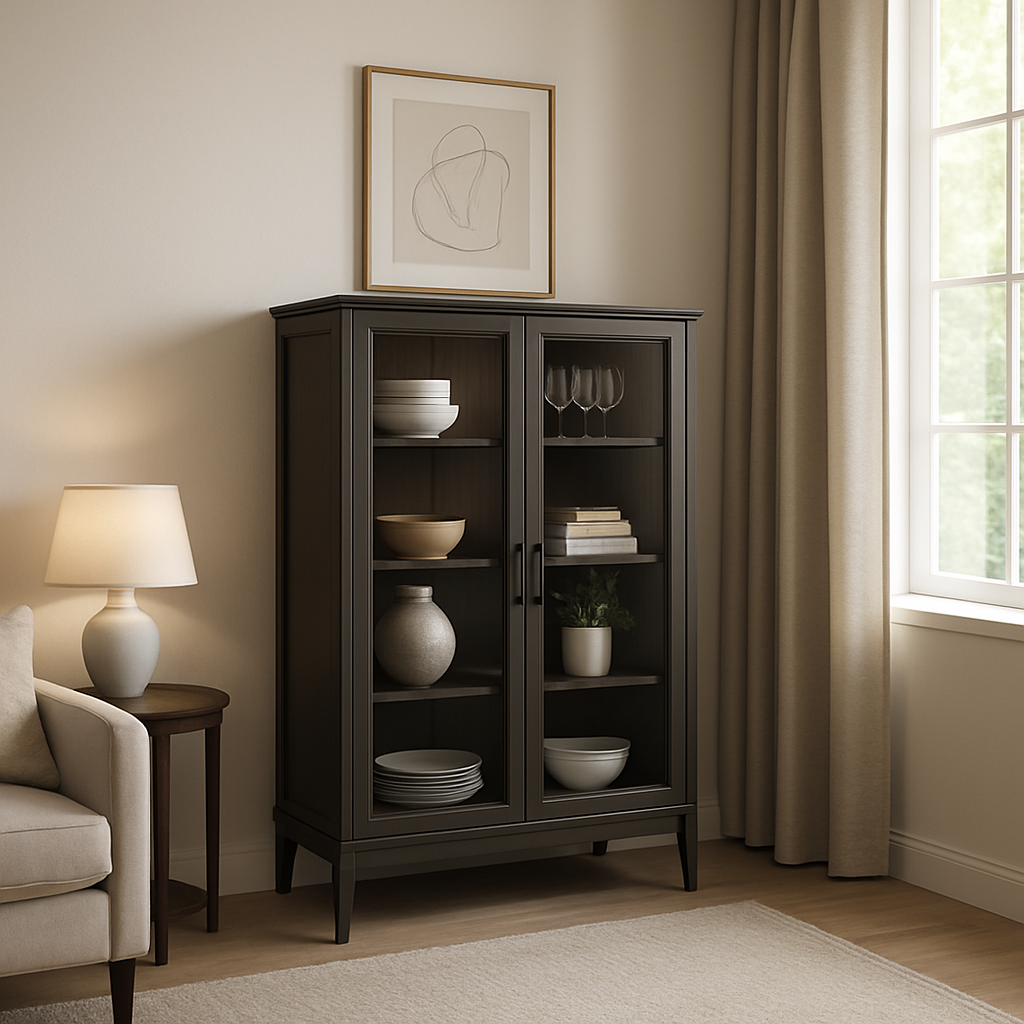
Your cabinet doors should reflect your personal style and the overall design of your home.
Color and Finish
- Natural Wood Finish: Brings warmth and a timeless look to your cabinetry.
- Painted: Offers endless color options, allowing you to match or contrast with your decor.
- Stained: Enhances the natural grain of the wood while adding a layer of color.
- Dove Grey: A popular choice for a neutral, sophisticated look that complements various decor styles.
Design Elements
- Mullions: These are the horizontal or vertical bars that divide the glass in a cabinet door, adding a decorative touch.
- Curio Cabinet with Glass Doors: Perfect for showcasing collectibles, providing a blend of open and closed storage.
- Accent Cabinet with Doors: These cabinets serve as a focal point in a room, often featuring unique designs and finishes.
Practical Considerations: Functionality and Hardware
Cabinet doors are not just about aesthetics; functionality is equally important.
Hardware Options
- Cabinet Door Hinges: Choose between standard or soft-close hinges for a seamless, quiet closing action.
- Cabinet Door Knobs and Handles: Available in various styles and finishes to complement your design.
- Cabinet Door Bumpers: These small but essential pieces prevent damage and reduce noise when closing doors.
- Cabinet Door Latches: Ensure your doors stay securely closed.
Customization
Consider custom cabinet doors if you have unique size requirements or want a specific design. Custom solutions allow you to tailor every aspect to your needs, from the material to the finish and hardware.
DIY Cabinet Doors: A Creative Project
If you're a DIY enthusiast, making your own cabinet doors can be a rewarding project.
How to Make Cabinet Doors
- Plan and Measure: Start by measuring your cabinet openings and deciding on the style and material of your doors.
- Gather Materials: You'll need tools like a saw, drill, and sandpaper, along with your chosen material for the doors.
- Cut and Assemble: Cut the panels and frames according to your measurements, then assemble them using wood glue and screws.
- Finish: Sand the surfaces smooth, then apply paint, stain, or a sealant to protect and enhance the wood.
- Install Hardware: Attach hinges and knobs or handles before hanging your doors.
Where to Buy Cabinet Doors

by Gabriela Fechet (https://unsplash.com/@pt_graphy)
When it comes to purchasing cabinet doors, you have several options:
- Home Improvement Stores: Retailers like Home Depot offer a wide selection of cabinet doors, from budget-friendly options to high-end designs.
- Door Suppliers Near Me: Local door suppliers can provide personalized service and custom options.
- Online Retailers: Websites like Fast Cabinet Doors offer a convenient way to browse and purchase doors from the comfort of your home.
Conclusion
Choosing the perfect cabinet doors for your home involves balancing style, functionality, and budget. Whether you're looking for shaker style cabinet doors, a curio cabinet with glass doors, or a custom closet design, the right doors can elevate your space. Consider your needs, explore your options, and invest in quality to ensure your cabinet doors serve you well for years to come.
By keeping these factors in mind, you'll find the ideal cabinet doors that blend seamlessly with your home's decor and meet your storage needs. Happy decorating!
Oct 20 2025 BY David Adrian, Blog
White continues to be the top choice for kitchen color. Consider using Nordic White, a beautiful matte finish in a pure white hue, to elevate your space. By incorporating this color into your DIY kitchen project, you'll be on your way to creating a stunning environment that will surely impress your guests by the holidays. Start your transformation today!
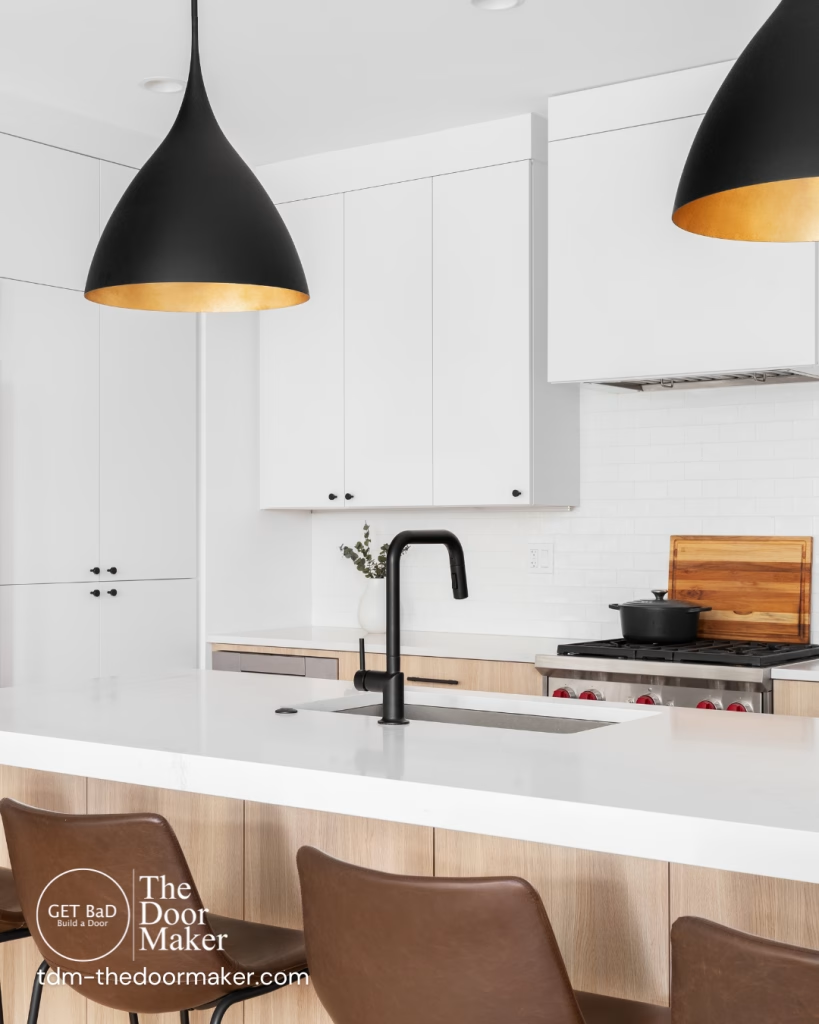
Oct 12 2025 BY David Adrian, Blog
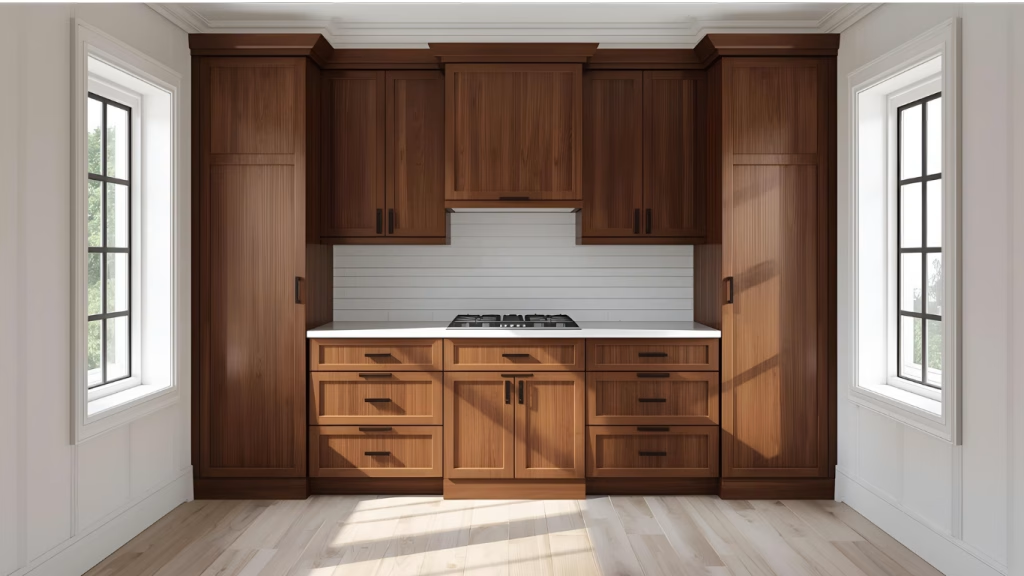
Living in a small space doesn’t mean you have to compromise on style or storage. IKEA® is already a favorite for compact homes, but pairing your IKEA® cabinets with custom doors can completely transform the look and feel of your space. The right door choice can make even the smallest condo or apartment feel open, airy, and designed with intention.
Here are some of our favorite small-space hacks using custom doors for IKEA® cabinets.
Open-Frame Doors to Create the Illusion of Space
Closed storage is important in small spaces, but too many solid doors can make a room feel boxed in. They make tight rooms appear larger—perfect for bedrooms, entryways, or studios. Open-frame layouts are a designer’s best friend when it comes to small interiors. Instantly, your storage can blend into the room rather than dominating it, creating a lighter, more breathable aesthetic.
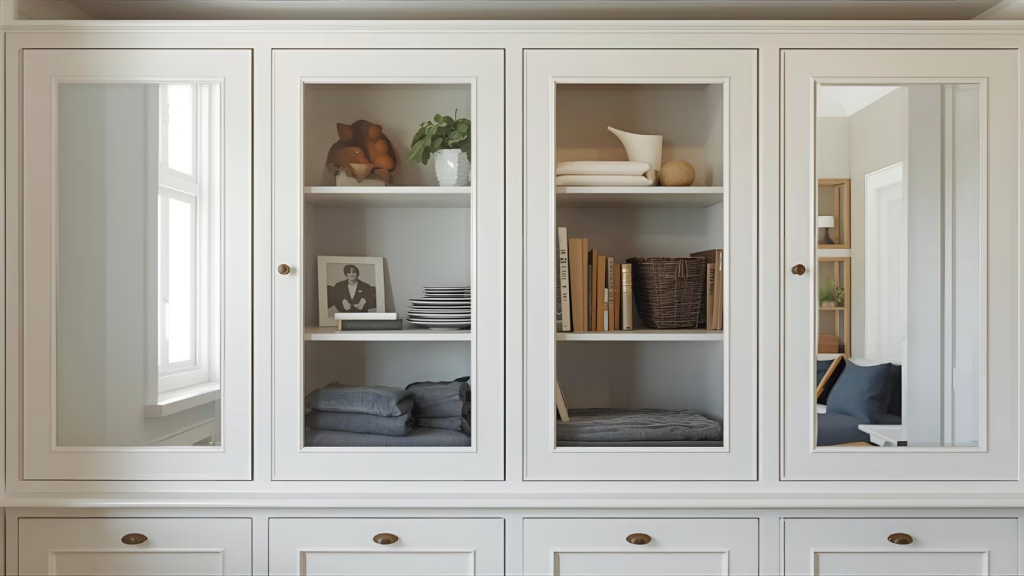
Light-Colored Fronts to Brighten Dark Corners
Swapping stock IKEA® doors for custom fronts in bright whites, creams, or soft matte pastels lifts a room and makes it feel larger.
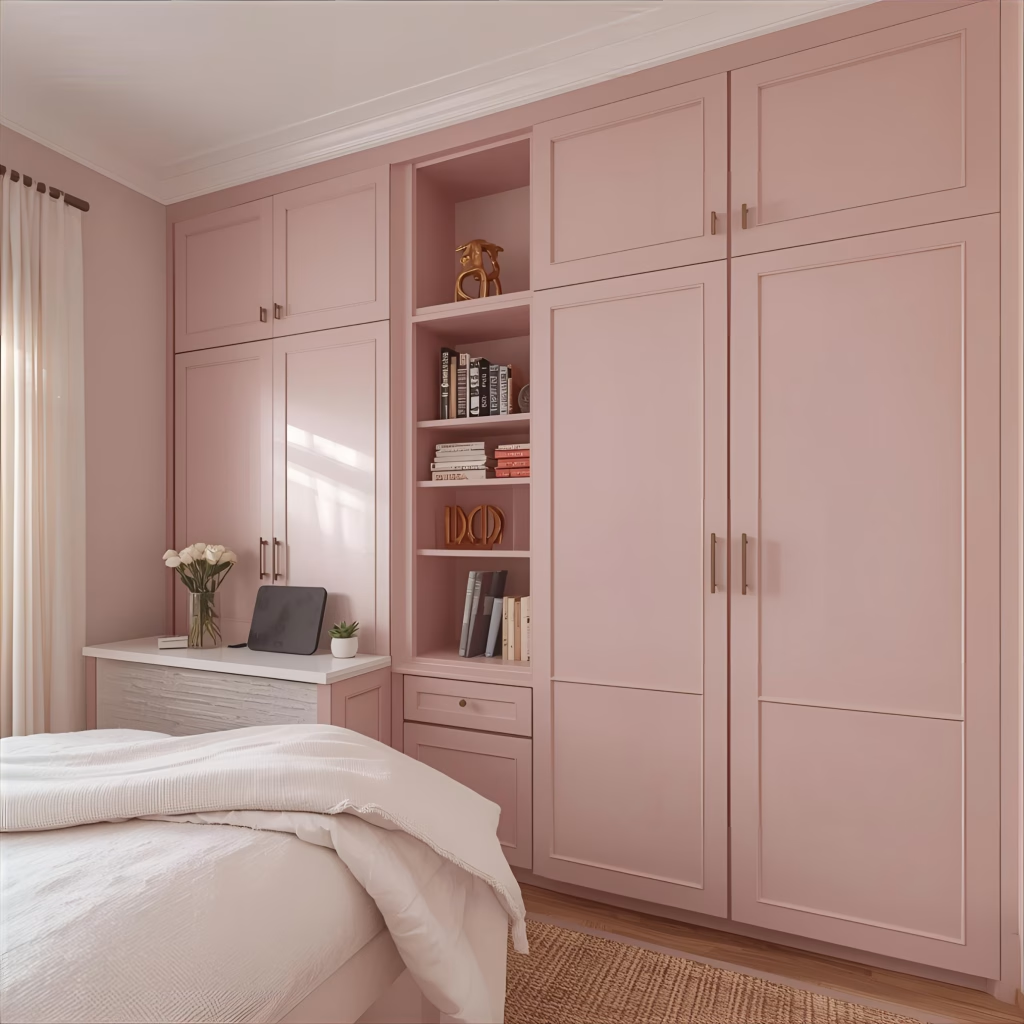

Built-In Storage with Panels & Toe Kicks
Maximize storage without losing cohesion by adding matching panels, toe kicks, and crown moulding. Custom trim pieces around IKEA® cabinets give the illusion of built-ins while also creating extra usable space.
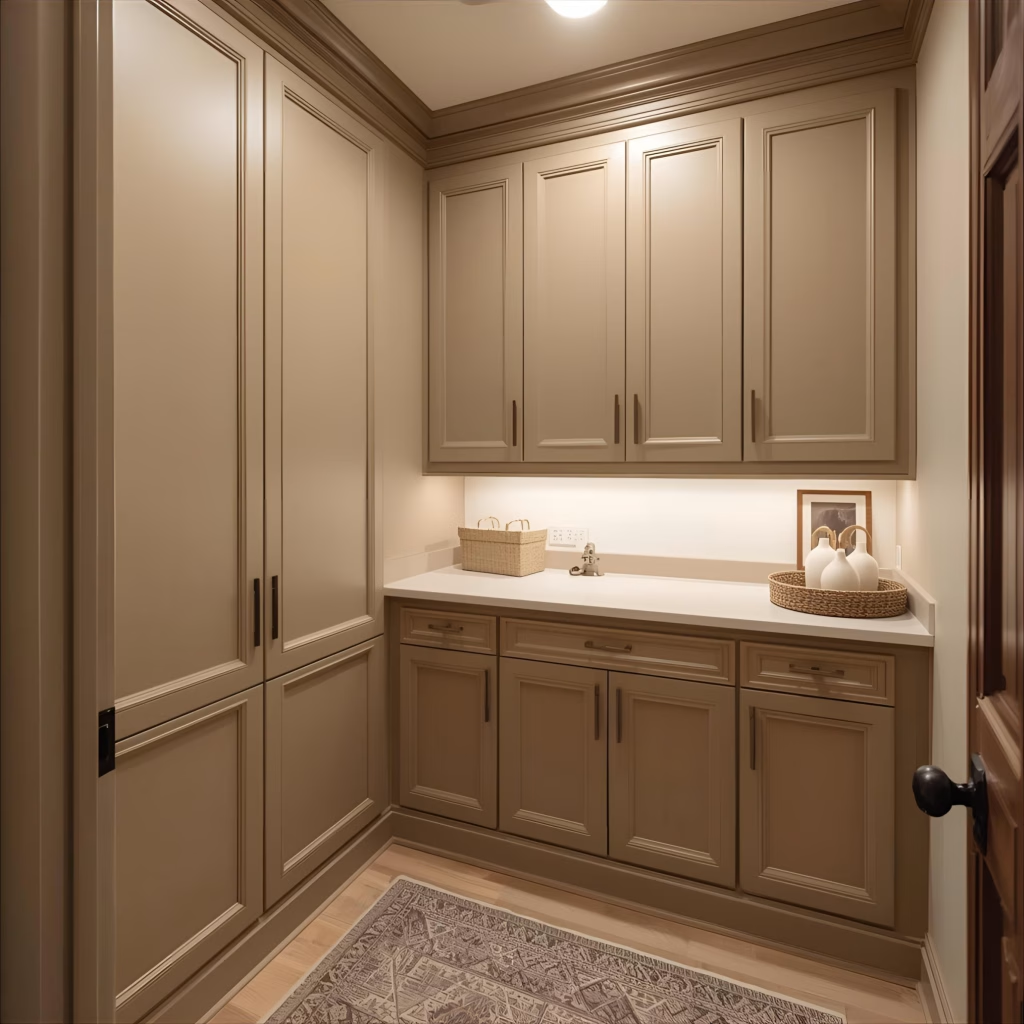
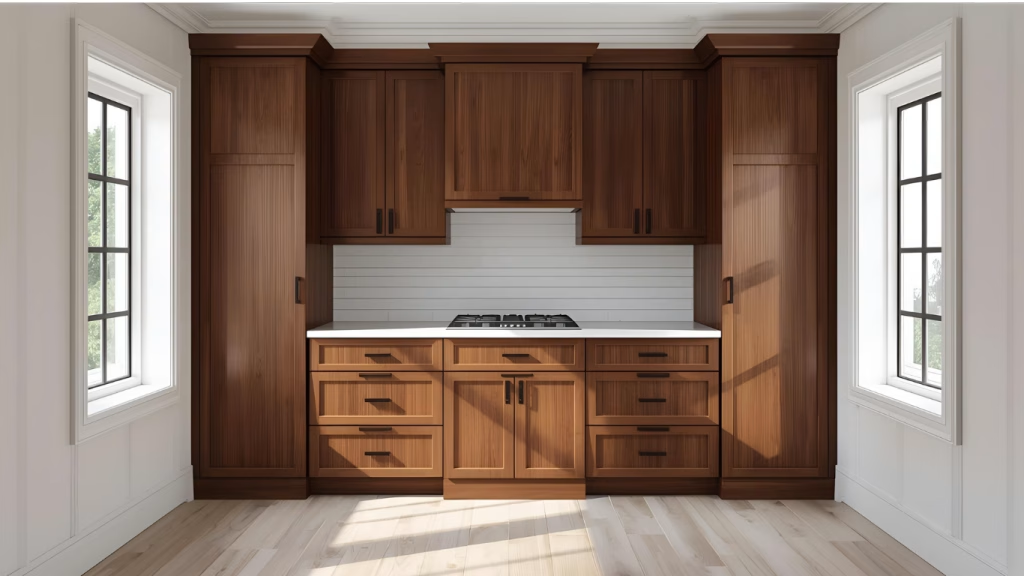
Small spaces can be stylish, functional, and uniquely yours with the right cabinet doors. Whether you’re outfitting a kitchen, bathroom, or living area, custom fronts are a simple yet impactful way to take IKEA® cabinets to the next level.
When you’re ready to maximize your space, Visit our Build a Door website to design the perfect custom doors for your IKEA® cabinets today! Learn more about us on our socials: Instagram Youtube Facebook
Aug 5 2025 BY David Adrian, Blog
If you are unsure of your ability to meassure and install the doors use an app.
www.jiffyondemand.com or www.angi.com can provide vetted contractors to do the job, allowing you to order the doors from Build a Door and have them installed professionally at a fraction of the time and cost of hiring a kitchen remodeling company.
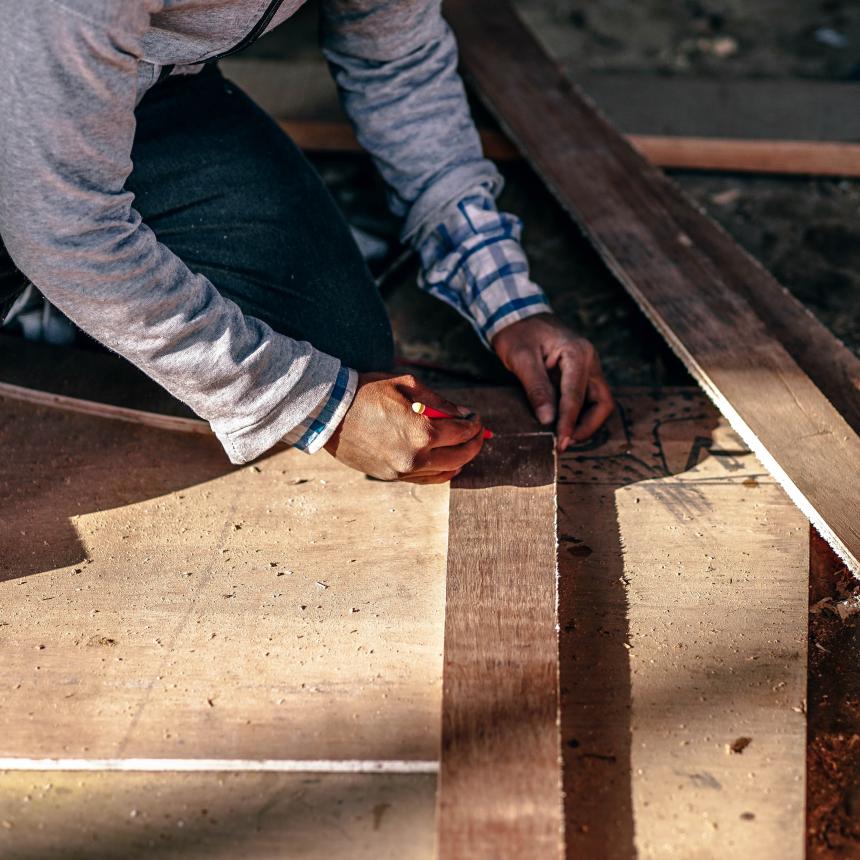
Jun 20 2025 BY David Adrian, Blog
Cabinet doors do far more than simply conceal shelves—they set the tone for your kitchen’s personality, shaping first impressions with every glance. Choosing the right contemporary style is a powerful way to create a space that feels fresh, functional, and uniquely yours. Hallmarks of contemporary design—think crisp lines, understated profiles, and a focus on everyday practicality—bring a sense of order and calm to even the busiest kitchens, while inviting creativity through bold finishes and thoughtful material choices.
Whether you’re a hands-on homeowner, a budget-savvy renovator, or a contractor guiding clients through their options, the search for the ideal cabinet door can feel overwhelming. With so many styles, finishes, and performance factors to weigh, it’s easy to get lost in the details. This guide is designed to cut through the confusion, spotlighting ten distinctive cabinet door styles that define modern kitchen aesthetics. For each, you’ll find clear explanations, material and finish ideas, practical pros and cons, and inspiration to help you visualise the results in real homes.
Ready to find a style that fits your vision and your practical needs? Let’s explore the standout options that are transforming kitchens across Canada and beyond—so you can make confident, lasting choices for your next DIY project or renovation.
1. Shaker Cabinet Doors
Shaker cabinet doors stand out as the go-to choice for both transitional and contemporary kitchens. Their hallmark five-piece construction—four slender frame pieces surrounding a flat recessed centre panel—strikes the perfect balance between simplicity and character. You’ll often spot crisp white Shaker doors in minimalist layouts, where they act as a neutral backdrop to statement lighting or sculptural countertops. Equally, dark-stained Shaker doors lend an industrial-modern vibe when paired with metal hardware and concrete surfaces.
Pros:
- Timeless design that never feels dated
- Highly adaptable to paint, stain or thermofoil finishes
Cons:
- If every cabinet in the room is Shaker, the effect can seem overly uniform
What defines Shaker style?
At its core, Shaker style is all about proportion and function. The rails (top and bottom) and stiles (sides) of the frame are deliberately kept slim, typically around 2½" to 3", to maximise the flat panel’s presence without clutter. There’s no ornamentation—no scallops, no beading—just clean edges and perfectly square corners. This focus on utility reflects the Shaker ethos, where form follows function and the result is an understated elegance.
Materials and finishes available for Shaker doors
Shaker doors can be crafted from a variety of substrates:
- Solid wood: oak, maple or cherry for authentic grain and natural warmth
- MDF: a smooth, cost-effective base that resists warping
- Thermofoil on MDF: offers a uniform, easy-clean surface in hundreds of colours
Popular finishes range from classic matt whites and greys to deep stains like walnut or espresso. Stained thermofoil replicates wood grains without the maintenance, while painted MDF provides a flawless canvas for any colour scheme.
Why Shaker doors suit modern kitchens
Clean lines are at the heart of contemporary kitchens, and Shaker doors deliver exactly that. Their simple profile allows bold countertops—think marble veining or terrazzo—to really pop. Shaker doors also pair effortlessly with modern hardware: long bar pulls emphasise the door’s geometry, while concealed handles maintain a seamless façade. In darker kitchens, a painted-white Shaker door can reflect natural light, making the space feel larger and airier.
2. Flat Panel (Slab) Cabinet Doors
Flat panel—or slab doors—are the epitome of minimalist design. These cabinet fronts are crafted as one continuous piece, free from visible rails, stiles or grooves, making them perfectly suited to handleless kitchens or integrated-pull profiles. Picture a row of matte charcoal slabs that open with a gentle push or a run of high-gloss white panels reflecting daylight back into the room. Their monolithic look creates a sense of calm and simplicity, allowing hardware, lighting and adjacent materials to take centre stage.
Beyond their visual appeal, slab doors pair beautifully with modern conveniences like touch-to-open mechanisms and recessed pull-out channels. A subtle bevel or eased edge can add just enough softness to the geometry, keeping the overall look clean yet approachable.
Key characteristics of Flat Panel doors
Without the typical frame-and-panel construction, slab doors offer an uninterrupted plane of material. This absence of ornamentation emphasises:
- A strong horizontal or vertical sweep across cabinet runs
- Sleek transitions from one surface to the next
- A perfect canvas for bold colours or dramatic textures
Edge profiles play a crucial role in defining the feel. A square edge delivers a crisp, industrial vibe, while a lightly eased edge softens shadows and reduces the chance of chipping.
Material options and finishes
Slab doors can be realised in a wide array of substrates and finishes to suit both budget and performance requirements:
- Painted MDF: A smooth base for any colour, from soft neutrals to vivid hues
- Laminate: Durable, budget-friendly and available in woodgrains, solids and patterns
- Thermofoil: Vinyl-wrapped MDF offering consistent colour and easy cleaning
- High-gloss acrylic: Ultra-reflective surfaces that catch light and enlarge small kitchens
Whether you favour muted greys or statement reds, slab doors embrace the full spectrum of finishes. High-gloss acrylic can serve as a mirror-like accent, whereas matt laminates lend a restrained, tactile appeal.
Styling tips for Flat Panel doors
To keep a slab kitchen from feeling stark, consider layering textures and lighting:
- Install under-cabinet LEDs to introduce warm pools of light and highlight countertop edges
- Mix in open shelving or glass-front cabinets to break up solid runs and display curated items
- Pair slab doors with natural stone or patterned tile backsplashes for added depth
By balancing solid surfaces with strategic accents, slab doors become the backdrop rather than the focal point—perfect for a kitchen where every element, from the sink to the statement pendant, has its moment.
3. Skinny Shaker (Slim Shaker) Cabinet Doors
Skinny Shaker doors distil the classic Shaker profile into a sleeker, more contemporary form. By trimming down the width of the stiles and rails, these doors introduce an airy, refined look that feels right at home in a modern kitchen. Imagine slender frames just wide enough to hint at structure, surrounding a flat centre panel that seems to float—this subtle shift in proportion brings a graceful lightness to the cabinetry, making walls of storage feel less imposing and more integrated with the overall design.
Homeowners often choose Skinny Shaker for two-tone schemes—perhaps a crisp white perimeter contrasted by a warm woodgrain island—where the narrow frames draw the eye without commanding it. In compact kitchens, the reduced visual weight helps smaller layouts feel more spacious. And when paired with minimalist handles or hidden pulls, Skinny Shaker doors strike the perfect balance between tradition and forward-thinking style.
Evolution from Classic to Skinny Shaker
Traditional Shaker doors feature stiles and rails commonly around 2½" to 3" wide. Slim Shaker, by contrast, typically utilises rails closer to 1½" in width. That cut in measurement may seem modest on paper, but in practice it produces a dramatically different effect. The narrower frame emphasises the flat panel’s uninterrupted surface, offering a subtler shadow line and a more delicate overall aesthetic. It’s a modern refinement of a century-old design principle, maintaining Shaker’s hallmark simplicity while refreshing its proportions.
Benefits in modern kitchen design
- Enhanced minimalism: The slim rails keep visual distractions to a minimum, reinforcing the clean lines central to contemporary interiors.
- Perceived spaciousness: Narrow frames recede into the background, letting other elements—countertops, backsplashes, décor—take centre stage.
- Versatile compatibility: Works equally well with statement finishes or subdued palettes, and complements both matte and gloss surfaces without competing for attention.
Whether you’re highlighting a striking quartz waterfall island or pairing cabinets with black metal fixtures, Skinny Shaker doors provide a subtle framework that accentuates rather than overpowers.
Integration with custom features
Skinny Shaker profiles lend themselves to creative customisations. Consider swapping solid panels for frosted or clear glass inserts to break up cabinetry runs and introduce a hint of transparency. Or incorporate in-frame metal accents—such as slim brass inlays—to tie cabinet doors to decorative lighting or plumbing fixtures. For those who favour open shelving, a row of slender-framed glass doors can transition smoothly into display units, crafting a cohesive look across closed and open storage. These tailored touches elevate the pared-back form of Skinny Shaker doors into bespoke centrepieces of your kitchen design.
4. Glass Insert Cabinet Doors
Glass insert cabinet doors add a layer of visual lightness to modern kitchens, breaking up solid runs of cabinetry and showcasing curated dishware or décor. Rather than closing off storage, they offer a peek inside without exposing clutter—an ideal solution for those who want a balance between display and concealment. Glass inserts are most often found in upper cabinets, where they catch and reflect natural light, giving the room a more open and airy feel.
Installing glass-front doors can instantly elevate a kitchen’s aesthetic, providing contrast to opaque base cabinets or drawer banks. They pair beautifully with minimalist frames—such as Skinny Shaker profiles—or monolithic slab doors, creating a dialogue between transparency and structure. In contemporary layouts, glass inserts foster a sense of continuity, as reflections bounce between pendant lights, glossy backsplashes, and polished hardware.
Beyond style, glass-insert doors also encourage thoughtful organisation. Since contents are partially visible, homeowners tend to arrange items deliberately—this translates to curated colour palettes, matching dish sets, or decorative accents that double as functional pieces.
Types of Glass Inserts
- Clear glass: Offers the most transparent view, ideal for displaying fine china or glassware in pristine condition.
- Frosted glass: Provides a muted effect that obscures details while still diffusing light. Perfect for hiding everyday items without darkening the cabinet interior.
- Seeded glass: Characterised by tiny air bubbles, it lends a vintage touch and gently scatters light for a subtle glow.
- Textured/ribbed glass: Features linear patterns that distort shapes, adding depth and tactile interest to the door.
- Tinted glass: Comes in soft greys, ambers or greens to complement metallic finishes and dark cabinetry.
Whichever option you choose, ensure the glass is tempered. Tempered glass meets building code requirements for safety—if ever broken, it shatters into small granular pieces rather than sharp shards.
Functional and aesthetic benefits
Incorporating glass insert doors creates a sense of openness, counteracting the solid mass of cabinetry. This transparency can make smaller kitchens feel larger and more inviting. Displaying attractive items turns storage into décor, encouraging homeowners to swap out seasonal pieces or rotate collections. Glass doors also reflect light from windows and fixtures, amplifying brightness and adding a dynamic interplay of highlights across surfaces.
From a functional standpoint, glass-front doors allow you to locate items quickly—no more opening every door to find that coffee mug. They’re particularly helpful above a beverage station or near the pantry, where visibility enhances convenience.
Considerations for glass selection
While glass inserts look stunning, they require a bit more upkeep. Fingerprints, smudges and dust are more noticeable on clear or high-gloss glass, so plan for regular cleaning with a mild, streak-free cleaner. Frosted and textured options hide imperfections better, reducing cleaning frequency. To prevent a cluttered appearance, limit glass doors to a few key cabinets and keep interiors well-organised—consider using matching storage containers or decorative baskets to maintain a cohesive look.
5. Beadboard Cabinet Doors
Beadboard cabinet doors bring a breath of cottage charm to contemporary kitchens, offering a subtle nod to traditional craftsmanship without overwhelming clean-lined layouts. Defined by a series of narrow, vertical grooves running down the centre panel, beadboard injects texture and visual interest into cabinetry runs. Whether you’re aiming for a softly modern take on farmhouse style or simply want to introduce a tactile element to flat-front doors, beadboard is a versatile choice that pairs beautifully with fresh paint colours, natural wood accents, and minimalist hardware.
Often used on islands or lower cabinets, beadboard can break up expanses of smooth surfaces and create focal points in open-plan kitchens. A pastel-painted island clad in beadboard becomes an instant statement, while crisp white beadboard doors around the perimeter lend dimensionality without sacrificing a bright, airy feel. For DIY homeowners, these doors are easy to install and customise—just measure, pick your panel style and go. Below, we explore how to get the look right, from groove profiles to colour pairings and upkeep.
Design features of Beadboard doors
Beadboard doors are distinguished by:
- Consistent groove spacing: Typically 1/4" to 1/2" wide beads create a rhythmic texture across the panel.
- Groove depth: Between 1/16" and 1/8" depths strike a balance between subtle shadow lines and ease of painting.
- Framed centre panel: A simple four-piece frame surrounds the beadboard, keeping the overall profile clean and structured—perfect for modern layouts.
Depending on your preference, beadboard panels can be moulded MDF, solid wood strips or thermofoil-wrapped boards. Each material offers slightly different texture and paint adhesion, so choose the substrate that fits your budget and performance needs.
Matching styles and colour palettes
Beadboard doors shine when paired with complementary hues and finishes:
- Soft neutrals: Creamy whites, pale greys or greiges allow the grooves to gently show through, adding warmth without high-contrast drama.
- Navy and jewel tones: Deep blues or emerald greens transform beadboard into a sophisticated accent—ideal for kitchen islands or tall pantry units.
- Pastel accents: Mint greens, blush pinks or light teals bring a playful twist, especially when balanced by matte black hardware or brushed brass fixtures.
To maintain a contemporary edge, limit beadboard to selected zones—such as a single run of lower cabinets—while keeping upper cabinets or drawer fronts in flat-panel styles. This mix-and-match approach prevents the look from skewing too rustic.
Installation and maintenance tips
A few pointers will keep your beadboard doors looking crisp for years:
- Painting grooves: Use a small angled brush to work paint into each bead, then back-brush with a foam roller for a smooth finish.
- Filling and caulking: Lightly fill any gaps at joints with a paintable caulk to prevent dust buildup and ensure clean lines.
- Dusting routines: Grooves collect dust more readily than flat panels—run a soft-bristle brush or microfiber cloth along the beads weekly to maintain that fresh-off-the-shelf appearance.
- Touch-up strategy: Keep a tiny pot of matching paint on hand for quick fixes to scuffs or nicks in high-traffic areas.
With these considerations in mind, beadboard cabinet doors can be both stylish and practical—a textured backdrop that elevates a contemporary kitchen without complicating day-to-day care.
6. Thermofoil Cabinet Doors
Thermofoil cabinet doors deliver a sleek, uniform surface at a budget-friendly price point. By wrapping a thin layer of PVC vinyl around an MDF substrate, thermofoil creates a seamless front that resists moisture and simplifies maintenance—an ideal choice for busy kitchens where spills and steam are part of daily life. Below, we unpack how thermofoil works, its key advantages and limitations, and why The Door Maker’s extensive selection makes it a go-to for DIY renovations.
Overview of Thermofoil technology
Thermofoil doors start with an engineered wood core—typically medium-density fibreboard (MDF)—that’s precisely cut and routed to the desired profile. A heat-activated vinyl film is then vacuum-pressed over the panel, conforming around edges and corners for a continuous finish. Once cooled, the bond between vinyl and MDF creates a hard-wearing surface that mimics painted or laminated doors, but without visible seams or grout lines.
Benefits and drawbacks of Thermofoil
Pros:
- Moisture resistance: The impervious vinyl layer repels water, making it well-suited for humid environments near sinks and dishwashers.
- Low maintenance: Wipe clean with a damp cloth—no special polishes or sealers required.
- Consistent finish: Vinyl comes in a wide array of colours and textures, guaranteeing uniformity across all door sizes.
- Cost-effective: More affordable than solid wood or lacquered finishes, while still delivering a premium look.
Cons:
- Heat sensitivity: Prolonged exposure to high temperatures—especially around ovens or stovetops—can cause vinyl to lift or warp.
- Non-refinishable: Unlike solid wood, thermofoil cannot be sanded or repainted; damaged doors must be replaced.
- Edge vulnerabilities: Improper installation or cuts too close to heat sources may lead to peeling at seams.
TDM’s Thermofoil Options
At The Door Maker, you’ll find over 130 thermofoil colours and textures, including matte neutrals, realistic wood grains, subtle textures and high-gloss finishes. Our online Build a Door tool lets you:
- Enter your exact measurements for doors and drawer fronts
- Choose from dozens of thermofoil styles with live previews
- Receive a free, no-obligation quote before you order
Every custom order ships within 2–3 weeks, accompanied by step-by-step installation guides and tutorial videos. Whether you’re refacing a kitchen, bathroom vanity or office storage, TDM’s DIY-friendly approach ensures a smooth experience from design to delivery.
Care and cleaning guidance for Thermofoil
To keep thermofoil doors looking their best:
- Use a mild dish soap and warm water solution applied with a soft cloth
- Avoid scouring pads, abrasive cleaners or bleach, which can scratch or dull the vinyl
- Keep cookware and heat sources at least a few inches away from cabinet faces to prevent heat damage
- Wipe up spills promptly to avoid moisture seeping into seams
With routine care and a sensible layout—positioning thermofoil cabinets away from direct heat—you’ll enjoy a durable, easy-to-maintain kitchen that looks brand new for years to come.
7. Lacquered & Acrylic Cabinet Doors
Lacquered and acrylic cabinet doors bring a luxe, high-end feel to contemporary kitchens. Lacquer is applied as a liquid finish—sprayed or trowelled onto an MDF substrate—then sanded and polished between coats to achieve a flawless surface. Acrylic doors, by contrast, use a pre-manufactured sheet of PMMA (polymethyl methacrylate) that’s glued onto the face of the door, resulting in an ultra-smooth, mirror-like finish. Both options offer a choice of high-gloss or matte sheens, allowing you to dial in the exact level of reflectivity and colour saturation you desire.
Modern kitchen designs often exploit these finishes to maximise light and create a sense of spaciousness. A row of gloss-lacquer upper cabinets can reflect pendant-light accents, while a matte acrylic island can anchor the room with subdued elegance. Though they may look similar at first glance, lacquered and acrylic doors have distinct performance profiles and price points, so understanding their differences is key to making the right choice.
Distinguishing Lacquered from Acrylic finishes
Lacquer finishes are built up in multiple layers—each coat is sprayed, allowed to cure, then lightly sanded to remove imperfections. This labour-intensive process yields rich depth of colour and a silky-smooth feel. Lacquer can be tinted to any custom shade, making it ideal for bespoke colour schemes. However, because it’s a solvent-based system, it requires proper ventilation during application and professional equipment for best results.
Acrylic doors are manufactured off-site: large sheets of coloured or clear acrylic are precision-cut and adhesively bonded to the door panel. This method guarantees consistent thickness and finish, while eliminating the need for on-site spraying. Acrylic’s inherent UV stability means colours resist yellowing over time, and the rigid surface is less prone to hairline cracks than lacquer.
Aesthetic impact in modern kitchens
Both lacquered and acrylic doors excel in handleless kitchen layouts, where uninterrupted surfaces create a seamless visual flow. High-gloss lacquer amplifies natural light and bounces it around the room, making compact kitchens feel larger. Pair gloss white doors with dark stone countertops for a dramatic contrast, or choose deep charcoal lacquer to frame metallic accents in an industrial-chic setting.
Matte acrylic, meanwhile, offers a soft-touch feel that’s perfect for creating tactile warmth. A matte-black island can serve as a sculptural focal point against pale perimeter cabinets, or a muted sage green can introduce subtle colour without overpowering a minimalist palette. For a truly contemporary statement, mix finishes: combine gloss doors on the upper tier with matte acrylic base cabinets to distinguish zones while maintaining cohesion.
Durability and maintenance considerations
When it comes to durability, acrylic doors tend to be more resistant to scratches and chemicals than lacquer, but both finishes require gentle care. To clean:
- Wipe surfaces with a soft microfiber cloth dampened with warm water and mild dish soap.
- Avoid abrasive sponges, scouring powders or solvent-based cleaners that can dull the finish.
- For stubborn marks on lacquer, a dedicated cabinet polish or a specialised lacquer cleaner can restore shine—test any product in an inconspicuous spot first.
- Acrylic repairs are limited; minor scratches can sometimes be buffed out with a proprietary acrylic polish, but deep gouges may require panel replacement.
Both finishes benefit from thoughtful kitchen planning: position heat-producing appliances away from lacquer cabinets and install splash guards near cooktops to prevent heat or oil damage. With routine, gentle maintenance, lacquered and acrylic doors will retain their showroom-fresh look for years, lending your kitchen a polished, contemporary edge.
8. Slatted Wood Cabinet Doors
Slatted wood cabinet doors introduce a rhythmic texture that transforms flat expanses into warm, tactile statements. Composed of evenly spaced wood slats—either horizontal or vertical—these doors evoke the artisanal quality of louvered shutters while serving practical purposes like airflow and sound diffusion. You’ll often see slatted panels used for pantry doors, appliance garages or utility cupboards, where they lend both character and function to a modern kitchen scheme.
Styles of Slatted doors
Slatted styles vary widely in orientation and proportion. Horizontal slats create a sense of width, making cabinets appear broader and lower—ideal for island fronts or base units. Vertical slats, by contrast, emphasise height and draw the eye upwards, perfect for tall pantry doors or floor-to-ceiling storage. Slat widths can range from slim ½" strips for a refined, delicate texture to broader 2" boards that deliver a bolder, more graphic look. Spacing between slats also plays a role: tight gaps yield a subtle striped effect, while wider gaps lean into an open, breezy aesthetic.
Functional advantages
Beyond their visual appeal, slatted wood doors offer practical benefits. The gaps between slats allow air to circulate freely, which is useful in ventilated appliance cabinets, wine storage or laundry areas. This design also contributes to acoustic dampening—sound waves break up as they pass through the channels, making slatted fronts a smart choice near dishwashers or recycling centres. Because the panels admit light and air, they can help prevent stale odours and moisture build-up, promoting a fresher environment inside closed storage units.
Customisation options for Slatted doors
Slatted doors adapt easily to a range of wood species and finishes. Oak slats deliver pronounced grain patterns and pair beautifully with natural or light-stained looks. Maple offers a smooth, uniform appearance that works well in contemporary, minimalist kitchens. For richer hues, walnut or cherry slats bring depth and warmth. Finishes can be matte, satin or semi-gloss, depending on how much sheen you want; a clear protective coat preserves the natural texture, while tinted stains highlight the wood’s character. For a two-tone effect, combine slatted doors on lower cabinets with flat-panel fronts above, or alternate wood species on island and perimeter units to reinforce zoning in open-plan layouts.
9. Melamine Cabinet Doors
Melamine cabinet doors bring together cost-effectiveness and robust performance, making them a smart choice for modern kitchen projects on a budget. At its core, melamine is a decorative surface material that’s bonded to a substrate—often particleboard or MDF—using heat and high pressure. The result is a hard-wearing front that resists scratches, moisture and everyday wear far better than raw wood or simple paint. Thanks to advances in printing and embossing technologies, melamine now comes in an astonishing array of patterns and finishes—from realistic woodgrains to solid colours and textured effects—so you don’t have to sacrifice style for savings.
Homeowners appreciate melamine’s low-maintenance nature: it stands up to splashes at the sink, withstands moderate heat near stoves, and wipes clean with a damp cloth. Contractors and DIY renovators value its uniformity—each door looks identical, with no grain variations or knots to worry about. Let’s explore what makes melamine such a versatile option for contemporary cabinet door styles.
What is Melamine?
Melamine starts life as paper sheets impregnated with melamine resin, a durable thermosetting polymer. These sheets are layered over an engineered core—usually particleboard or medium-density fibreboard—and pressed under heat to cure the resin. The pressure bonds the decorative paper to the substrate, creating a single, cohesive panel. Edge-banding is then applied around the door’s perimeter to seal the cut edges and prevent moisture infiltration. Unlike veneer or laminate, melamine is factory-finished, so each door arrives ready for installation without additional painting or sealing.
Performance characteristics
Melamine cabinet doors excel in several key areas:
- Scratch resistance: The cured melamine surface endures daily knocks from cookware, utensils and accidental impacts with minimal scuffing.
- Moisture resistance: A properly sealed edge-band protects the substrate from steam and splashes, making melamine suitable for kitchens and bathrooms alike.
- Heat tolerance: While not impervious to extreme heat, melamine handles normal cooking temperatures well—just avoid placing hot pans directly against the doors.
- Colour and pattern consistency: Factory production ensures every panel matches perfectly, whether you choose a woodgrain that spans multiple doors or a vivid solid hue.
By confirming that edge-banding is properly adhered and sealed, you’ll maintain melamine’s performance over many years.
Design possibilities with Melamine
Thanks to digital printing advancements, melamine doors now rival the look of real wood, stone and textured finishes at a fraction of the cost. Popular options include:
- Woodgrain patterns: From subtle ash and oak to dramatic walnut and ebony, these prints emulate natural grain with remarkable authenticity.
- Solid colours: Clean whites, slate greys and even bold jewel tones are available in smooth or matt textures.
- Textured and patterned effects: Embossed textures mimic linen, hammered metal or stone, adding tactile interest to flat-panel doors.
Pair woodgrain melamine on lower cabinets with solid-colour uppers for a dynamic two-tone scheme, or use textured melamine panels on an island apron to create a focal point. Metal trim, open shelving inserts or even glass-front melamine frames can elevate the material’s appearance, blending affordability with design flair. With melamine, you can achieve a contemporary cabinet door style that balances budget, durability and aesthetics in one easy package.
10. Wood Veneer Cabinet Doors
Wood veneer cabinet doors combine the warmth and character of real timber with the stability and affordability of engineered substrates. A paper-thin slice of natural wood—known as veneer—is bonded to a sturdy core, giving you authentic grain patterns and tonal variation without the risk of warping or excessive cost that comes with solid slabs. Veneer doors offer the best of both worlds: genuine wood aesthetics, consistent quality, and a more sustainable use of forestry resources.
Understanding Wood Veneer types
Veneers are cut from logs using two main techniques, each producing distinct looks:
- Rotary-cut veneer is sliced in wide sheets by rotating the log against a stationary blade. This method yields broad, flowing grain patterns—sometimes referred to as “cathedral” or “crown” figures—that add drama and movement to large cabinet runs.
- Sliced veneer, also called plain or quarter-cut, involves slicing the log along its length. The resulting boards display straighter, more uniform grain lines, creating a refined, linear appearance that suits minimalist and contemporary designs.
Beyond these, specialised cuts like rift-cut or half-round can accentuate specific grain orientations, offering nearly unlimited customisation. Matching veneer seams—using bookmatching or slip-matching techniques—ensures a harmonious pattern across adjacent doors, giving the cabinetry a tailored, bespoke feel.
Advantages over Solid Wood
Wood veneer doors enjoy several practical benefits compared to their solid-wood counterparts:
- Dimensional stability: The thin veneer layer, bonded to a stable core such as plywood or MDF, resists seasonal movement and moisture-induced warping that can plague solid timber.
- Consistent appearance: Engineered cores and factory-controlled veneer cuts deliver uniform grain and colour across dozens of panels, eliminating the natural variations and knots you might find in solid wood.
- Cost efficiency: Since veneers use far less hardwood per door, they represent a more budget-conscious way to achieve a high-end wood look. This also makes exotic species, like ebony or rosewood, more accessible for full kitchen refacing.
- Eco-friendly: Veneers maximise each log’s yield, reducing waste and supporting responsible forestry practices.
All these factors make veneer doors a smart choice for homeowners and contractors seeking the timeless beauty of wood without the long-term headaches of solid-wood maintenance.
Finishing and care tips for Wood Veneer
To preserve the natural luster of veneer cabinet doors, follow these guidelines:
- Gentle cleaning: Wipe surfaces with a soft, lint-free cloth dampened in a mild soap solution. Avoid abrasive pads or harsh chemicals that could strip the finish.
- Moisture control: Keep cabinets away from direct water splashes and ensure adequate kitchen ventilation. If spills occur, blot immediately rather than rubbing vigorously.
- Protective coatings: Most veneer doors arrive pre-finished with durable lacquers or UV-cured varnishes. If you choose to refinish, opt for thin, even coats of water-based lacquer, lightly sanding between applications for a smooth result.
- Routine maintenance: Polish occasionally with a high-quality, pH-neutral wood polish to enhance depth and guard against minor scratches. Always test any new product in a discreet area first.
With proper care, wood veneer cabinet doors retain their elegant grain patterns and durable finish for years, ensuring your kitchen continues to feel warm, inviting and authentically natural.
How to Choose the Right Contemporary Cabinet Door Style
Choosing the perfect cabinet door style means aligning your aesthetic goals with practical considerations—your kitchen’s layout, budget, material durability and maintenance routine. Start by evaluating your space: note how much natural light pours in, observe the flow between sink, stove and refrigerator, and consider existing finishes like countertops or flooring. Next, decide whether you want a look that’s distinctly modern (think flat-front slabs or handleless profiles) or a more transitional feel (Slim Shaker or mixed-material designs). Finally, order sample doors or full-scale mock-ups so you can see colours, textures and edge details in your actual kitchen setting before committing.
Many homeowners wonder: “What is the most timeless cabinet door style?” Shaker and slab doors frequently top the list for their enduring simplicity, while beadboard and raised-panel designs offer a nod to tradition without feeling outdated. If a purely contemporary vibe is your aim, look for uninterrupted surfaces and minimal ornamentation—flat panels, integrated pulls and subtle edge bevels are key indicators of a modern silhouette.
To help you narrow down options quickly, here’s a side-by-side comparison of popular contemporary styles:
| Style | Material Options | Budget Level | Maintenance |
|---|---|---|---|
| Shaker | Solid wood, MDF, Thermofoil | Moderate | Low to moderate |
| Flat Panel (Slab) | MDF, Laminate, Acrylic, Thermofoil | Moderate to high | Low |
| Thermofoil | Vinyl-wrapped MDF | Low | Very low |
| Melamine | Particleboard or MDF core | Low | Low |
| Wood Veneer | Plywood/MDF core with real wood face | High | Moderate |
Keep in mind that material choice often dictates both cost and longevity: entry-level thermofoil and melamine are wallet-friendly but cannot be refinished, whereas painted or lacquered surfaces and wood veneers offer greater repair potential at a higher price point.
Assessing your kitchen layout and style goals
Analyse your work triangle and the amount of wall space you have for upper versus lower cabinets. In a compact galley kitchen, a row of lighter-coloured slab doors or narrow-framed Slim Shaker cabinets can prevent the room from feeling closed in. If your kitchen lives in an open-plan setting with abundant daylight, richer wood veneers or matte finishes can withstand darker cabinetry without overwhelming the space.
Balancing budget and material performance
When pinpointing a “modern look” within your budget, map out the lifespan you expect from your cabinets. Thermofoil and melamine deliver the lowest upfront cost, while painted MDF and laminate slab doors occupy the mid-range. Wood veneers and high-gloss acrylic sit at the premium end but reward you with scratch resistance and refinishable surfaces. Chart your anticipated wear and tear: families with young children or frequent entertainers may prioritise ultra-durable, low-maintenance finishes, whereas more occasional cooks might invest in higher-end materials.
Considering long-term maintenance and care
Every surface demands its own cleaning regimen. Thermofoil and melamine are practically wipe-and-go, resisting moisture and stains with just a damp cloth and mild detergent. Lacquered, acrylic and painted finishes, by contrast, benefit from soft microfiber cloths and gentle cleaners to preserve shine and avoid micro-scratches. Real wood veneers need cautious moisture control and occasional polishing, but they can also be lightly refinished if damage occurs. Make sure your choice complements not only your design dream but also the time you’re prepared to spend on upkeep.
Quality & Safety Standards for Cabinet Doors
When selecting contemporary cabinet doors, it’s vital to consider indoor air quality, structural durability and regulatory compliance. In Canada, two benchmarks ensure peace of mind: Formaldehyde Emission Regulations for composite wood products and the Kitchen Cabinet Manufacturers Association (KCMA) A161.1 certification for performance. These standards protect health and guarantee your cabinetry will stand up to everyday use.
Formaldehyde Emission Regulations in Canada
Canada’s Guidance Document on Formaldehyde Emissions from Composite Wood Products Regulations limits the release of formaldehyde—a common volatile organic compound (VOC) linked to respiratory irritation. Regulated product categories and their maximum allowable emissions are:
- Hardwood plywood: ≤ 0.05 ppm
- Particleboard: ≤ 0.09 ppm
- Medium-density fibreboard (MDF): ≤ 0.11 ppm
Manufacturers must submit samples for third-party testing using the ASTM E1333 chamber method and apply a compliance mark on every carton, indicating product type, emission level and certifying body. These measures ensure that your cabinetry contributes minimal VOCs to indoor environments.
Importance of KCMA Certification
The KCMA A161.1 standard subjects cabinet doors to rigorous trials that mimic long-term kitchen use. Key assessments include:
- Door and drawer cycling: 100,000 open/close cycles to simulate years of wear.
- Static load testing: Verifying frame integrity under weight (e.g., heavy cookware).
- Impact resistance: Ensuring panels resist dents and cracks from daily knocks.
- Finish durability: Evaluating adhesion, chemical resistance and stain performance.
Products bearing the KCMA seal have proven their structural resilience and finish longevity under these stringent criteria, making them a solid choice for busy kitchens.
Ensuring your doors meet standards
Before committing to a supplier, verify that cabinet doors comply with both formaldehyde and KCMA requirements:
- Check for visible labels or stamps on each door or its packaging referencing Canada’s emission classes and KCMA A161.1 certification.
- Request copies of third-party laboratory reports or certificates from recognized testing bodies.
- Confirm that markings include the product category (MDF, particleboard, etc.), the formaldehyde emission limit and the certifier’s identification.
By confirming these credentials, you can be confident your contemporary cabinet doors not only match your design vision but also adhere to rigorous safety and quality benchmarks.
Final Thoughts & Next Steps
From the understated elegance of Shaker and its slimmer Skinny Shaker cousin to the pure minimalism of slab doors, each of these ten contemporary cabinet door styles brings its own character and practical edge. Glass inserts and beadboard offer textural contrast, while thermofoil, melamine and acrylic deliver fuss-free, low-maintenance surfaces. Wood veneer and slatted doors introduce warmth and natural grain, rounding out a palette of options that suit every design ambition and budget.
Before committing to a single style, take a moment to assess your kitchen’s layout, lighting and daily routines. Will you benefit from the openness of glass-front uppers? Do you need ultra-durable, easy-clean surfaces around busy cooking zones? How does your choice of finish interact with existing countertops, hardware and flooring? Ordering sample doors or full-scale mock-ups can save headaches later—seeing materials in your own environment helps you judge colour, texture and edge profiles with confidence.
Ready to turn ideas into reality? Start by gathering measurements and snapping a few photos of your current cabinets. Use those insights to explore finishes, edge details and hardware options. Then head over to The Door Maker’s online Build a Door tool to design custom doors in minutes, get a free quote and take the next step in your kitchen refresh.
Ready to transform your kitchen? Visit The Door Maker to build your custom cabinet doors today and bring your contemporary vision to life.
Jun 19 2025 BY David Adrian, Blog
Updating your kitchen, bathroom, or office doesn’t have to mean tearing out perfectly good cabinetry or blowing your renovation budget. For many Canadian homeowners and DIY enthusiasts, cabinet refacing has become the smart, cost-effective alternative to full cabinet replacement—retaining your existing cabinet boxes while giving your space a dramatic visual upgrade. But how much does cabinet refacing actually cost, and what are the options for saving money without sacrificing style or quality?
This comprehensive guide unpacks the true cost of cabinet refacing, offering seven distinct ways to estimate your project—from national averages and linear foot pricing to per-door calculations and material-specific breakdowns. You’ll find practical examples for every kitchen size, clear explanations of what’s included in professional quotes, and a detailed look at the real factors that drive costs up or down. Whether you’re considering a hands-on DIY approach or weighing the advantages of hiring a pro, you’ll also discover effective strategies for keeping your refacing budget in check, insights on return-on-investment, and important considerations for environmentally responsible disposal.
While The Door Maker doesn’t publish set prices online, you can build your own cabinet door design and get a tailored, obligation-free quote in minutes using their online “Build a Door” tool. Use this guide to plan your project with confidence, maximise your savings, and achieve a fresh new look—without the stress or expense of a full-scale renovation.
1. Average National Cost Range for Cabinet Refacing
Across Canada and North America, a full cabinet refacing project generally falls between $4,000 and $9,500. This all-inclusive price reflects the removal of existing doors, application of new veneers or laminates, installation of fresh hardware and the labour required to complete the transformation. While regional labour rates and material choices will cause some fluctuation, this range serves as a reliable benchmark for homeowners planning their renovation budget.
Although The Door Maker doesn’t list fixed prices online, viewing these nationwide averages can help you decide whether to request a no-obligation quote via the “Build a Door” tool. Refacing allows you to keep your existing cabinet boxes intact, reducing waste and often saving both time and money compared to a full cabinet replacement.
What the All-Inclusive Estimate Covers
A typical cabinet refacing quote will include:
- Replacement doors and drawer fronts
- Veneer or laminate applied to existing cabinet boxes
- Basic hinges, glides and pull hardware
- Skilled labour for removal, fitting and final adjustments
- Disposal of old materials and site cleanup
- Project management and quality inspections
2025 Cost Range Overview
According to industry research, homeowners can expect the following figures for a standard kitchen refacing project Source: Modernize:
- Low end: approximately $4,000 for smaller layouts or entry-level materials
- Mid range: around $6,750 for an average 200 sq ft kitchen with mid-grade finishes
- High end: up to $9,500 for larger kitchens, premium veneers or custom details
These benchmarks provide a solid starting point for comparing quotes, setting realistic expectations and planning a smooth, budget-friendly cabinet makeover.
2. Per Linear Foot Pricing
One of the most common ways professionals estimate cabinet refacing costs is by charging per linear foot (LF). Rather than quoting an entire kitchen as a lump sum, they measure the total length of cabinetry runs—essentially the continuous span of cabinets along walls and islands—and multiply it by a fixed rate. This approach makes it easy to tailor the quote to the exact size of your kitchen and simplifies comparisons between materials or installers.
How Linear Foot Pricing Works
A linear foot in the context of cabinet refacing refers to one foot of cabinet frontage, measured horizontally from one end of the run to the other. This includes doors, drawer fronts and any adjoining panels. By using a per-LF rate, contractors can account for:
- Material costs (veneers, laminates and edge banding)
- Labour time (surface preparation, veneer application and fitting)
- Basic hardware (hinges, glides and pulls)
- Disposal and site cleanup
Linear foot pricing streamlines the estimating process: once you know the total LF of your cabinets, you simply multiply by the agreed rate. It also helps homeowners see how choosing different quality levels (entry, mid or premium) affects the final cost.
Example Calculations
Below is a sample cost breakdown using representative rates of $100/LF, $175/LF and $250/LF. Adjust these figures to reflect your installer’s rates or the quality of materials you prefer.
| Linear Feet | Low ($100/LF) | Mid ($175/LF) | High ($250/LF) |
|---|---|---|---|
| 20 LF | $2,000 | $3,500 | $5,000 |
| 30 LF | $3,000 | $5,250 | $7,500 |
| 40 LF | $4,000 | $7,000 | $10,000 |
For example, a 30 LF kitchen refaced at a mid-range rate of $175/LF would cost about $5,250 in total. Knowing these per-LF figures allows you to mix and match material grades, compare quotes more easily and forecast how any design changes—like adding an island or extra wall cabinets—will affect your budget.
3. Per Cabinet Door and Drawer Front Pricing
When you want to drill down even further, some contractors will price refacing on a per-component basis—charging for each door and drawer front rather than per linear foot. This method can be helpful if your kitchen layout has a mix of full-size doors, smaller accessory doors, or extra-wide drawers, since it breaks the budget into bite-sized pieces.
Typical Cost Range per Door/Drawer
Most standard cabinet doors and drawer fronts fall within a similar price band:
- Low end: $100 each
- Mid range: $250 each
- High end: $400 each
These figures reflect the cost of the new door or drawer front (veneers or thermofoil), edge banding and basic hardware. Custom profiles or premium materials (for instance, glass inserts or textured finishes) can push a single door toward the upper end of this range.
Budgeting for a Standard Kitchen
To see how these costs add up, consider an average kitchen with:
- 20 cabinet doors
- 10 drawer fronts
First, calculate the number of components:
20 doors + 10 drawers = 30 pieces
Then multiply by the per-piece rate:
-
At $100 each:
30 x $100 = $3,000 -
At $250 each (mid range):
30 x $250 = $7,500 -
At $400 each:
30 x $400 = $12,000
So, for a standard kitchen configuration, you can expect to spend between $3,000 and $12,000 on door and drawer-front replacements alone. This breakdown makes it easier to swap in a few upgraded doors without reworking your entire linear-foot calculation—and gives you clear control over exactly where your budget goes.
4. By Kitchen Size Category
Kitchen footprint plays a significant role in your cabinet refacing budget. As the room grows, so do the number of doors, drawer fronts and the length of veneer required. Below is an overview of what you might expect to invest in a refacing project based on kitchen size:
Small Kitchen (100 sq ft)
In a compact kitchen—roughly 100 square feet—you typically have 10 to 20 linear feet of cabinets. Even with a modest layout, your refacing project can deliver a fresh appearance without breaking the bank.
- Estimated cost range: $1,000–$5,000
- Factors at this scale include fewer doors/drawers (often under 25 pieces) and minimal surface preparation.
- Entry-level laminate or thermofoil can keep costs near the lower end, while upgrading to mid-range veneers pushes you toward the upper limit.
Mid-Size Kitchen (200 sq ft)
A mid-sized kitchen of about 200 square feet usually contains 20 to 30 linear feet of cabinetry. This size represents the national average and matches the $4,000 to $9,500 bracket we discussed earlier.
- Estimated cost range: $4,000–$9,500
- Typical door/drawer count: 30–40 components.
- Mid-range materials and hardware are most common here, blending affordability with stylish finishes.
- If you add an island or extra pantry doors, expect the estimate to climb proportionally.
Large Kitchen (300 sq ft+)
For spacious kitchens exceeding 300 square feet—with 30+ linear feet of runs including islands and specialty units—you’ll be looking at a premium budget.
- Estimated cost range: $10,000–$15,000+
- High door and drawer counts (40+ pieces) plus potential under-cabinet lighting or crown moulding.
- Upgrading to wood veneer or solid wood can push your investment above the baseline.
- Custom layouts with corner units, built-in features or glass-front doors further influence the final total.
By matching your kitchen’s size category to these ranges, you can set realistic expectations before requesting a quote. Remember that these figures serve as guidelines—your exact cost will depend on material choices, labour rates in your area and any additional custom work you decide to include.
5. Material-Specific Cost Breakdown
Choosing the right material for your cabinet refacing project not only influences the overall price but also affects durability, maintenance and style. Here’s how the most common options stack up in terms of cost and characteristics. Source: Bob Vila
Laminate or Thermofoil
Laminate and thermofoil are the most budget-friendly choices, with projects typically ranging from $1,000 to $3,000 for an average kitchen. These materials consist of a printed or vinyl finish applied over engineered wood, making them resistant to moisture and easy to clean. While they offer a wide variety of colours and patterns, they can be prone to peeling or chipping if exposed to high heat or sharp impacts.
Wood Veneer
For a step up in authenticity and texture, wood veneer provides a real‐wood face bonded to an underlying substrate. Expect refacing costs in the $2,500 to $6,500 bracket. Veneers deliver the warmth and grain of natural wood—often oak, maple or cherry—at a fraction of the price of solid wood. They require slightly more careful maintenance (avoiding excess moisture) but offer a classic look that pairs well with both traditional and modern décor.
Solid Wood or Plywood
Premium refacing with solid wood or high-grade plywood doors and drawer fronts usually starts around $5,000 and can exceed $10,000 for larger layouts or exotic species. This option guarantees maximum longevity, repairability and premium aesthetics, as every panel is genuine wood throughout. Solid wood refacing often comes with custom milling options—raised panels, intricate beading and artisan profiles—that justify the higher investment and deliver a truly bespoke finish.
6. Labour Cost Breakdown
Labour often makes up the largest portion of a cabinet refacing budget, reflecting the skilled work required to remove old components, prepare surfaces, apply new materials and carry out precision installations. Understanding how labour factors into your overall cost can help you spot where efficiencies or savings might be found—and why experienced craftsmen command a significant share of the budget.
Percentage of Project Cost
On average, labour accounts for 50%–70% of the total cabinet refacing price. That means, for a mid-range project of around $6,750, you might see labour fees of anywhere from:
$6,750 × 50% = $3,375
to
$6,750 × 70% = $4,725
Regional wage differences, the installer’s reputation and the complexity of your kitchen layout will determine whether your project falls at the lower or higher end of this range. Custom finishes and intricate cabinet profiles typically push labour percentages upward, while simpler laminate or thermofoil jobs lean toward the lower end.
Breakdown of Tasks and Rates
To give you a clearer picture of where labour dollars go, here’s a breakdown of common refacing tasks and their typical rates:
-
Demolition & disposal:
$10–$20per linear foot
Removing and hauling away old doors, drawer fronts, hinges and any damaged veneer. -
Surface preparation:
$20–$50per linear foot
Cleaning, sanding and priming cabinet boxes to ensure a flawless bond with new veneers or laminates. -
Veneer application:
$30–$60per linear foot
Cutting, fitting and adhering the chosen material—whether wood veneer, laminate or thermofoil—followed by edge-banding and finishing. -
Door & drawer installation:
$20–$40each
Precisely mounting new doors and drawer fronts, adjusting alignment, depth and reveal for a uniform look and smooth operation. -
Hardware fitting:
$20–$30per labour hour, plus$2–$5per piece
Installing hinges, pulls and drawer glides; drilling, measuring and fine-tuning each fitting to factory standards.
Keep in mind these figures are ballpark estimates. If your project calls for higher-end veneers, decorative mouldings or integrated lighting, labour rates may be adjusted accordingly. By comparing detailed task breakdowns from multiple installers, you can zero in on the best balance of cost and craftsmanship for your refacing project.
7. Add-Ons and Upgrades Pricing
Once your cabinet shells and doors have been refaced, a few targeted upgrades can take functionality and style to the next level. These optional extras let you personalise your kitchen to suit your cooking habits and décor preferences—and each comes with its own price tag. Below is a breakdown of some of the most popular add-ons and what you might expect to invest.
Crown Moulding
Adding crown moulding brings a polished, built-in look to refaced cabinets. Installers will measure, cut and finish decorative trim along the top edge of your units, creating a seamless transition to the ceiling.
Cost range: $12–$20 per linear foot.
Factors influencing price include the complexity of the profile (simple ogee vs. layered designs), the wood species or MDF quality, and the number of inside corners that require precision mitre cuts.
Under-Cabinet Lighting
Under-cabinet lights are a game-changer for task visibility and evening ambience. Most setups use low-voltage LED puck lights or slim strip lights, complete with transformers and discrete wiring. Installation involves cutting small holes, securing fixtures, and routing cables to a switch or power outlet.
Cost per fixture: $230–$300.
This typically covers the light fitting itself, transformer, wiring labour and basic dimmer or switch hook-up. Premium options—like tunable white LEDs or touch-sensitive controls—may push you toward the higher end of the spectrum.
Glass Door Inserts
For a taste of showroom flair, swapping out solid door panels for glass inserts instantly brightens cabinet interiors and displays your favourite dishware. Options range from clear or frosted glass to decorative patterns or fluted designs.
Cost per door: $150–$200.
That price includes cutting the glass to size, installing a secure frame or glazing bead, and sealing around the edges. If you combine glass fronts with under-cabinet or interior cabinet lighting, you’ll accentuate this upgrade even more.
In-Cabinet Organisers
Custom organisers—such as pull-out trays, vertical dividers, spice racks and Lazy Susans—maximise storage efficiency and reduce rummaging. Each feature is fitted inside your existing boxes, sliding on metal tracks or rotating on lazy-Susan hardware.
Cost range: $70–$300 each.
Simple pull-outs (for trays or baking sheets) and corner-cabinet carousels sit at the lower end, while full-extension pull-outs, appliance garages or multi-tier spice racks can climb to the top of this range.
8. DIY vs Professional Cost Scenarios
Many homeowners wonder whether to tackle cabinet refacing themselves or bring in a professional. Each route has its own benefits—DIY can reduce upfront costs, while hiring a pro saves time and ensures a flawless finish. Here, we compare the typical expenses, advantages and potential pitfalls of DIY, professional and hybrid approaches so you can decide which suits your budget, skill level and timeline best.
DIY Material-Only Estimate
If you already own basic woodworking gear—a router or table saw, a reliable edge-banding iron and a shop vacuum—a DIY refacing project can cost between $1,000 and $3,000 for materials alone. This covers:
- Replacement doors and drawer fronts (thermofoil or veneer)
- Veneer or laminate sheets plus edge banding and adhesive
- New hinges, pulls and drawer glides
- Sandpaper, primer, brushes and finish
Remember, this figure excludes labour. Without professional experience, you risk problems such as bubbles under veneer, misaligned doors or uneven seams. Allow extra time for practice runs and potential reorders, and ensure you have a well-ventilated workspace to keep dust and fumes under control.
Professional Installation Estimate
Handing the job to a qualified installer brings predictability and speed. A full-service professional refacing project typically ranges from $4,000 to $9,500, covering:
- Detailed site measurement and custom door cutting
- Surface prep, sanding and perfect veneer or laminate application
- Precision hardware fitting and alignment
- Removal, disposal of old materials and thorough cleanup
- Project management, quality checks and often a workmanship warranty
Most pros can complete a standard kitchen in 3–5 days, so disruption is minimal. While the upfront price is higher than DIY, you gain the confidence of a uniform, factory-quality result—and avoid costly do-overs.
Hybrid Approach
A hybrid model combines the cost savings of DIY with the expertise of a professional installer. By handling straightforward tasks yourself—such as accurate measuring or the removal of old doors—you can shave 10% to 20% off a full-service quote. A typical arrangement might look like:
- You use TDM’s “Build a Door” tool to define quantities, styles and materials
- You remove and label existing doors/drawers for the installer
- The professional carries out veneer application, door hanging and final adjustments
This split allows you to control part of the process—and the budget—while ensuring critical steps are managed by someone with the right skills. For a precise hybrid quote, link your DIY measurements and designs directly through The Door Maker’s “Build a Door” platform and speak with an installer about your preferred scope of work.
9. Additional Factors Influencing Cabinet Refacing Costs
Beyond base estimates and material choices, a handful of external variables can push your cabinet refacing budget up or down. Understanding these nuances will help you set realistic expectations and get more accurate quotes.
Regional Variations
Labour and material expenses vary widely across Canada. Contractors in high-cost urban centres—like Vancouver or Toronto—typically charge 10 %–20 % more per hour than those in smaller towns or rural areas. Likewise, shipping specialty veneers or hardware to remote locations can incur extra freight fees. When comparing quotes, be sure to ask whether the installer’s rates reflect local market conditions or if any travel surcharges apply.
Kitchen Layout & Complexity
A straightforward run of cabinets along a single wall is far simpler—and less time-consuming—than a layout with corner units, angled sections or multiple islands. Each inside corner or non-standard run often requires custom trimming, additional edge banding and extra alignment checks. If your kitchen includes built-in features—such as a pantry wall or open shelving niches—plan for 5 %–15 % higher labour costs to cover the bespoke adjustments.
Project Duration & Scheduling
Most professional cabinet refacing jobs wrap up in 3–5 days, but timing can shift based on installer availability and project scope. Busy seasons (spring and early summer) may create scheduling bottlenecks, leading to longer lead times or premium rush fees. For a realistic timeline, review your installer’s calendar and inquire about potential delays. Mont-River recommends booking at least six weeks ahead to secure your preferred start date and to guarantee uninterrupted work.
Lead-Safe Work and Disposal Fees
Homes built before 1990 often contain lead-based paints. If your refacing project disturbs old finishes, local regulations may require a certified lead-safe contractor. These professionals follow strict protocols—containment, wet-sanding and HEPA vacuuming—that add roughly $300–$600 to the total cost. You may also face municipal disposal fees for hazardous waste, which typically range from $50 to $150 per cubic metre of debris. Factor these charges into your budget if you suspect lead-paint disturbance or unusual waste streams.
10. Top Savings Tips to Lower Your Cabinet Refacing Budget
Even a modest cabinet refacing project can add up quickly. By applying a few strategic cost-cutting measures, you can stretch your dollars further without compromising on style or quality. Here are our top recommendations:
Choose Affordable Materials
Opting for laminate or thermofoil veneers instead of solid wood can shave thousands off your overall bill. Low-maintenance foils are available in an ever-growing palette of colours and textures, and they resist moisture better than natural veneer. If you do want a wood look, consider a thin wood veneer over engineered core—it retains real-wood grain at a fraction of the price of solid panels.
Retain Existing Hardware
Before you trash old knobs, pulls and hinges, take stock of what still works. A thorough cleaning or a quick spray of satin-chrome can make well-worn hardware look practically new. If you do decide to switch styles, shop around local hardware stores or online wholesalers—many offer trend-right pieces at lower markup than specialty installers.
Bundle Projects
If you’re planning additional upgrades—like new countertops, backsplash installation or under-cabinet lighting—grouping them with your refacing job can yield volume discounts. Contractors often reward larger work orders with better rates on labour, delivery and waste removal. Even ordering slightly more veneer or doors while you’re at it can net you reduced per-unit costs.
Get Multiple Quotes
Don’t settle for the first number you receive. Aim to gather at least three detailed estimates that break down materials, labour and disposal fees. Comparing line-item pricing reveals where installers are marking up their services or materials, giving you bargaining power to negotiate a fairer deal or spot areas where you can downgrade to hit your budget.
Time Your Project
Scheduling your refacing during the industry’s slow season—typically late fall or mid-winter—can yield discounted labour rates and faster start dates. Keep an eye out for manufacturer promotions or holiday sales on veneers and hardware, and align your project timeline to take advantage of these offers. A little patience can translate into significant savings on both materials and installation.
11. How Cabinet Refacing Can Increase Your Home’s Value
Updating cabinets through refacing not only revitalises your space but can also bolster your home’s resale appeal. Potential buyers often notice freshly refaced cabinetry first, associating modern finishes and cohesive hardware with a well-kept property. Let’s explore how this relatively modest investment can translate into substantial returns when it comes time to sell.
Return on Investment Statistics
According to industry surveys, homeowners recoup roughly 70% to 80% of their refacing outlay in added property value. For example, a $6,000 cabinet refacing project could boost your home’s market price by $4,200 to $4,800. This level of ROI rivals other popular reno tasks—such as bathroom updates—yet costs considerably less than a full cabinet replacement.
Refacing vs Full Replacement ROI Comparison
While replacing kitchen cabinets might seem like the ultimate upgrade, it can carry price tags two to three times higher than refacing—and the ROI doesn’t always justify that expense. Refacing offers a quick refresh for a fraction of the cost, and the visual impact is immediate. In contrast, investing heavily in new custom cabinetry can yield diminishing returns at resale, as buyers are often unwilling to pay a premium for features beyond functional and aesthetic improvements.
Appeal to Potential Buyers
Freshly refaced cabinets give prospective buyers a strong first impression of care and attention to detail. Crisp edges, uniform hardware and on-trend finishes signal that the home has been maintained and updated. That sense of move-in readiness often encourages buyers to make offers more swiftly—and at closer to asking price—than homes with dated or worn cabinetry.
By choosing cabinet refacing, you can achieve a high-impact, wallet-friendly upgrade that resonates with today’s market demands. It’s a small change that can deliver a big boost to your home’s overall value and appeal.
12. Environmentally Responsible Disposal Practices in Canada
Cabinet refacing is already a win for the environment—it repurposes your existing cabinet boxes and significantly cuts down on new material usage. However, you’ll still end up with old doors, drawer fronts, veneers and hardware that need to be disposed of responsibly. In Canada, construction, renovation and demolition (CRD) waste is managed under a mix of federal guidelines and provincial/municipal regulations. By following these disposal best practices, you can minimise landfill contributions and often reduce your overall project costs.
Understanding CRD Waste Regulations
CRD waste encompasses anything removed or discarded during a renovation: wood scraps, MDF panels, metal fittings, laminate off-cuts and more. Although federal bodies like Environment Canada set broad objectives for waste reduction and diversion, each province—and in many cases individual municipalities—maintains its own rules about how this debris must be handled. Generally, you are required to:
- Separate waste streams on-site (e.g., wood, metal, plastics).
- Transport materials to certified transfer stations or recycling depots.
- Secure permits for large-volume or hazardous-waste disposal when necessary.
For an overview of best practices and policy goals around CRD waste in Canada, see Environment Canada’s guide on Reducing Municipal Solid Waste.
Municipal Recycling & Drop-Off Programs
Most Canadian cities provide convenient options for residents to recycle or safely discard renovation debris:
- Wood and untreated lumber: chipped or whole boards often accepted at green depots.
- Metal hardware: hinges, screws and drawer glides can be dropped off with metal recyclers.
- Clean laminate/veneer pieces: some facilities accept small, non-hazardous off-cuts.
To locate the nearest facility and understand any associated fees, check your municipality’s waste-management portal. For example, Vancouver residents rely on the Recycle BC network, while Metro Toronto publishes detailed instructions on its waste collection site. If you’re elsewhere, a quick search for “renovation waste disposal” plus your city or town name will point you to local drop-off centres.
Extended Producer Responsibility (EPR)
Extended Producer Responsibility (EPR) programmes shift the end-of-life management of materials back to manufacturers and suppliers. Several provinces in Canada have active EPR schemes that cover cabinetry and related products:
- British Columbia: Product Care’s Furniture and Carpet stewardship programme accepts laminates and wood-based panels.
- Ontario: The Resource Productivity and Recovery Authority (RPRA) coordinates the collection and processing of wood, MDF and other renovation materials.
- Quebec: Recyc-Québec runs initiatives for construction and demolition waste, including cabinetry components.
When planning your refacing project, ask your supplier if they participate in take-back or buy-back programmes. Many door manufacturers and distributors will coordinate the return of old materials, ensuring they’re repurposed or recycled rather than sent to landfill. Checking your provincial EPR registry can also help you find approved drop-off sites and stewardship organisations dedicated to cabinetry and building-material recycling.
13. Ergonomic and Safety Best Practices for DIY Cabinet Refacing
Refacing your own cabinets can be rewarding, but a lack of preparation or attention to ergonomics and safety can turn a satisfying project into a painful one. Prioritising tool upkeep, managing airborne dust, using the right protective equipment and adopting healthy work habits will help reduce the risk of injury and ensure you finish on time and on budget. Below are four key areas to focus on when tackling a DIY cabinet refacing job.
Tool Inspection & Maintenance
Before each work session, give your power tools and hand tools a thorough once-over. Inspect blades and bits for dullness or damage and replace them if necessary. Check power cords for frays or exposed wires and ensure moving parts on routers, sanders and drills spin freely without wobbling. A well-maintained tool not only cuts cleaner but also minimises kickback and binding—common causes of accidents. For more guidance on safe carpentry practices, see the CCOHS tool maintenance checklist.
Dust Control & Ventilation
Cabinet refacing generates fine wood and veneer particles that can irritate your eyes, lungs and skin. Set up a shop vacuum with a HEPA filter to capture dust at the source—whether it’s coming from a sander or a table saw. Keep windows and doors open to maintain a steady flow of fresh air, and avoid working in confined spaces without an extraction fan. Clearing dust as you go helps protect your respiratory system and prevents slippery floors that can lead to trips or falls.
Personal Protective Equipment (PPE)
Never underestimate basic PPE. At a minimum, equip yourself with:
- Safety glasses or goggles to shield your eyes from flying chips and splinters.
- A respirator or N95 mask when sanding or cutting to trap fine dust and volatile organic compounds from adhesives or finishes.
- Hearing protection—either earmuffs or earplugs—if you’re running loud tools for extended periods.
- Cut-resistant gloves when handling sheet materials or sharp-edged veneers; switch to grip-friendly work gloves for tool operation.
Choosing the appropriate level of protection not only safeguards your health but also boosts confidence and precision during installation.
Safe Work Practices
Staying mindful of your body’s posture and limits can save you from long-term aches. Position workpieces at waist height to avoid bending or overreaching; use adjustable sawhorses or workbenches if necessary. Alternate tasks every hour—switch from sanding to fitting doors, for instance—to engage different muscle groups. Secure loose clothing, remove jewellery that could catch on tools, and keep long hair tied back. Finally, take short breaks to stretch and hydrate, especially during longer sessions. These small habits go a long way in maintaining steady progress and preventing injury.
By incorporating these ergonomic and safety best practices into your DIY cabinet refacing project, you’ll work more efficiently, minimise health risks and achieve professional-looking results—without the common aches, strains or mishaps that cost time and money.
14. Your Next Steps for a Successful Cabinet Refacing Project
You’ve now seen the full spectrum of costs—from national averages and per-linear-foot rates to per-door pricing and DIY scenarios—along with the key factors that influence your budget, the most effective ways to save, and the safety and environmental considerations you’ll want to keep in mind. Armed with this knowledge, you can confidently approach your cabinet refacing project with a clear plan, realistic expectations and an eye for quality.
Begin by taking accurate measurements of your existing cabinet runs, doors and drawer fronts. Compare the options covered in this guide—entry-level thermofoil, mid-range veneers or premium solid-wood panels—and decide where to allocate your budget. Factor in any upgrades you’d like, such as crown moulding or under-cabinet lighting, and remember the savings tips: shop affordable materials, reuse existing hardware where possible and collect multiple quotes to ensure you get the best value.
Next, consider your ideal approach:
- If you’re a seasoned DIYer, gather the right tools, protective gear and workspace ventilation for a smooth, safe refacing job.
- If you prefer a hands-off experience, engage a professional installer to handle everything from removal and surface prep to precise veneer application and final hardware fitting.
- Or choose a hybrid route—use our “Build a Door” platform to design your doors and do the removal yourself, then let an expert take over the installation.
Now it’s time to turn your plan into reality. Head over to The Door Maker’s “Build a Door” tool, where you can configure every detail—style, finish, size—and receive a free, custom quote in minutes. Whether you’re refreshing a small pantry or refacing an expansive kitchen, The Door Maker makes it easy to get started and stay on budget. Ready to give your cabinets a fresh new look? Start designing today and take the first step toward a beautiful, budget-friendly renovation.
Jun 18 2025 BY David Adrian, Blog
Cabinetry does more than simply provide storage; it shapes how we use, enjoy, and experience our kitchens, bathrooms, and living spaces every day. Whether planning a fresh look for your home or seeking practical upgrades, the term “custom cabinetry” is bound to appear—often surrounded by confusion and a swirl of marketing claims. What does “custom” really mean when it comes to cabinets? How is it different from stock or semi-custom options, and why should these distinctions matter to you?
This guide peels back the jargon to reveal exactly what custom cabinetry is, how it compares to other choices, and what to expect in terms of design, quality, compliance, and cost. With clear definitions, side-by-side comparisons, and practical insights, you’ll discover the factors that set custom cabinetry apart, the benefits it offers, and the considerations to weigh before making your decision. Whether you’re a DIY enthusiast hunting for the perfect fit or a homeowner determined to maximise both style and functionality, understanding the real meaning of custom cabinetry is your essential first step.
Understanding Cabinetry: Definition and Scope
Before diving into the specifics of custom options, it helps to get a clear picture of what cabinetry actually is and why it matters. At its core, cabinetry blends craftsmanship and construction to create both functional storage and decorative features that shape the character of a room. With this foundation, you’ll be better equipped to appreciate how custom cabinetry goes a step further.
Defining Cabinetry
Cabinetry refers to the craft of designing and building fitted furniture, especially cabinets of high quality. Also called cabinetwork, carpentry or woodwork, cabinetry encompasses everything from the basic structure to the final decorative touches. In other words, cabinetry isn’t just about the box that holds your plates—it includes doors, mouldings, and even the choice of hardware that brings the design together.
Components of Cabinetry
Every cabinet is made up of several core parts, each playing its own role in both durability and appearance. Common materials are noted in parentheses:
- Cabinet box (case): The main enclosure, often constructed from plywood or medium-density fibreboard (MDF) for stability.
- Face frame: A solid-wood frame attached to the front of framed cabinets, providing extra strength and an anchor for hinges and doors.
- Doors: The visible panels, which may be solid wood, MDF with a veneer, or thermofoil; they set the style—flat, raised, shaker or more ornate profiles.
- Drawers: Built with dovetail or dowel joinery, drawer boxes are usually made from solid wood or plywood for long-lasting performance.
- Shelves: Adjustable or fixed boards, typically plywood or particleboard with a laminate or veneer finish, to support dishes, pantry items or office supplies.
- Hardware: Knobs, pulls, hinges and drawer slides, available in materials such as brass, stainless steel or engineered alloys, that influence both function and style.
Role of Cabinetry in Home Design
Cabinetry underpins both how a space works and how it looks. On the functional side, well-planned cabinets maximise storage, keep daily essentials within easy reach and allow homeowners to organise tools, cookware or linens. From a style perspective, the shape of the doors, colour of the finish and arrangement of mouldings set the tone for the entire room.
In the kitchen, cabinetry can define an island as the focal point or create a seamless run of units along a wall. In bathrooms, it offers under-sink storage and linen towers that blend practical needs with spa-like finishes. Even in a home office or living room, built-in cabinets can house books, hide cables behind closed doors or showcase decorative objects. Thoughtful cabinetry transforms ordinary rooms into customised environments tailored to how you live.
What Is Custom Cabinetry? Definition and Core Characteristics
Custom cabinetry stands out as the truly bespoke option in storage and furniture design. Instead of selecting from pre-set sizes or limited door styles, you work with designers and craftsmen to create pieces that align exactly with your space, aesthetic and functional requirements. From a snug nook under a sloping ceiling to an expansive wall of pantry cupboards, custom cabinets are built around your unique vision—and the one-off nature of each project calls for a closer look at what “custom” really means.
Core Definition of Custom Cabinetry
At its heart, custom cabinetry comprises “tailor-made storage solutions crafted to unique client specifications.” According to Studio Carney’s glossary, every dimension, detail and finish is selected to fit your exact needs, whether that involves an angled bay window, a curved island or a run of floor-to-ceiling units. (See Studio Carney's glossary for more.)
Key Characteristics of Custom Cabinetry
- Custom dimensions and layouts: Cabinets are measured on-site and drawn to match nooks, alcoves or soaring ceilings without awkward gaps or filler strips.
- Unlimited design freedom: You choose from an extensive palette of door profiles (shaker, raised panel, flat), finishes (paints, stains, veneers, thermofoils) and decorative mouldings to make each piece uniquely yours.
- Skilled craftsmanship: Artisans rely on time-tested joinery—dovetail drawers, mortise-and-tenon frames and precision routing—to ensure rigidity, longevity and a refined appearance that mass-produced units simply can’t match.
Distinguishing Custom from Other Cabinetry Types
Compared with stock units (built in fixed sizes and limited styles) and semi-custom lines (based on standard modules with a handful of tweaks), custom cabinetry occupies the top tier of personalisation. Later sections will break down how these three approaches differ in cost, lead times, material quality and installation options—but for now, remember: custom means no compromises on size, style or workmanship.
Types of Cabinetry: Stock, Semi-Custom, and Custom
When it comes to choosing cabinetry, understanding the three main categories—stock, semi-custom and custom—helps you match your needs with the right balance of cost, lead time and design freedom. Below, we break down each type so you can see how they differ in structure, style options and overall investment.
Stock Cabinetry: Ready-Made Solutions
Stock cabinets are off-the-shelf units built in standard sizes and popular door styles. They’re mass-produced, so you’ll usually find immediate availability at big-box retailers or cabinet showrooms.
-
Advantages
- Immediate pick-up or fast shipping (often within a week)
- Lower price point—around $160–$380 per linear foot
- DIY-friendly installation
-
Disadvantages
- Limited finishes and door profiles
- Fixed dimensions (widths in 3" increments, typical heights of 30"–36")
- Gaps, fillers or trim may be needed in irregular spaces
Semi-Custom Cabinetry: A Middle Ground
Semi-custom cabinets start with a stock platform but offer a selection of dimension tweaks and additional finishes. You might choose deeper boxes for oversized bakeware or swap in a premium door style without fully bespoke pricing.
-
Advantages
- More door styles, paints and stains than stock lines
- Adjustable widths and depths (usually in 1"–3" increments)
- Moderate lead times (4–8 weeks) and mid-range pricing
-
Disadvantages
- Height options and internal configuration may remain standard
- Some modifications can push costs close to custom levels
- Quality varies by manufacturer
Custom Cabinetry: Fully Bespoke Options
Custom cabinets are built from the ground up to your exact specifications. Every aspect—from overall layout to decorative mouldings—is crafted to fit your space and style.
-
Advantages
- Unlimited design freedom: any shape, size or finish
- Premium materials (solid woods, hardwood veneers, high-grade plywood)
- Skilled workmanship with artisanal joinery
-
Disadvantages
- Highest investment level—approximately $600–$2,500 per linear foot
- Longest lead times (6–12 weeks or more)
- More complex selection process
Quick Comparison Table
| Feature | Stock | Semi-Custom | Custom |
|---|---|---|---|
| Customisation Level | Minimal | Moderate | Unlimited |
| Cost Range (per linear ft) | $160–$380 | $250–$700 | $600–$2,500 |
| Lead Time | Immediate–1 week | 4–8 weeks | 6–12+ weeks |
| Materials Quality | Economy (particleboard, basic veneers) | Mixed grades (plywood, MDF, select veneers) | Premium (solid wood, high-grade plywood) |
| Installation Options | DIY or third-party | Often available through dealer | Usually included with manufacturer |
This comparison makes it clear where each cabinetry type sits on the spectrum of customization, cost and convenience. Whether you need a quick, cost-effective update or a fully personalized installation, choosing the right category ensures your cabinetry aligns with both your design vision and practical requirements.
Custom vs Stock Cabinets: Key Differences
Choosing between custom and stock cabinets goes beyond simply comparing prices. The decision affects how well your cabinetry fits, how it looks and how long it will last. Below, we break down the fundamental contrasts so you can see which option aligns best with your project goals.
Measurements and Fit
Custom cabinets are measured on-site to match your exact space, whether that means under a sloping ceiling, around a bay window or into an unusually shaped alcove. Every dimension is tailored, eliminating unsightly gaps and the need for filler strips.
Stock cabinets, by contrast, come in predetermined sizes—widths usually increase in 3-inch increments (e.g. 12", 15", 18") and heights often top out between 30" and 36". While these off-the-shelf dimensions can suit many rooms, awkward angles or odd corners may leave wasted space or require additional trim.
Design Freedom and Appearance
With custom cabinetry, you have free rein over door profiles, mouldings, finishes and hardware. Want a shaker door in a bespoke taupe paint with a hand-rubbed stain on the crown moulding? No problem. Decorative elements, inset doors or curved drawer fronts are all on the table.
Stock cabinets offer popular door styles—flat, shaker or raised panels—with a handful of finishes. If your design vision calls for something unique, you’ll be limited to the manufacturer’s catalogue, and mixing brands or sizes can lead to inconsistent looks.
Quality and Craftsmanship
Custom cabinets are built with premium materials chosen for durability and appearance. Solid-wood species (maple, oak, cherry), hardwood veneers and high-grade plywood form the structure, while skilled artisans employ dovetail joints, mortise-and-tenon frames and precise routing for a refined finish.
Stock cabinets typically use economy substrates such as particleboard or low-grade plywood, with thinner veneers or thermofoil coverings. Assembly methods are simpler and hardware is often basic, which helps keep costs down but may affect longevity under heavy use.
Lead Times and Availability
If speed is your priority, stock cabinets are hard to beat—many models ship within days or can be picked up in store immediately. You can complete a basic installation project before the next weekend arrives.
Custom cabinetry requires planning: manufacturing often takes 6–12 weeks, depending on the complexity of the order and material availability. While the wait can test your patience, the payoff is a perfectly fitted, one-of-a-kind installation.
Cost Implications
Price is one of the most visible differences. Stock cabinets range from approximately $160 to $380 per linear foot, making them an economical choice for budget-minded updates.
Custom cabinets typically start around $600 per linear foot and can climb to $2,500 or more, depending on wood species, finish and decorative features. Although the initial outlay is higher, custom solutions often add value through superior fit, enhanced durability and design uniqueness.
By understanding these key contrasts—measurements, design freedom, build quality, timelines and cost—you’ll be better positioned to decide whether stock or custom cabinetry is the right investment for your home.
Semi-Custom vs Custom Cabinets: Bridging the Gap
If you’re weighing design freedom against budget constraints, semi-custom cabinetry often emerges as the compromise. It borrows from both stock and fully bespoke approaches, letting you tailor certain elements without the full custom price tag—or the full custom decision fatigue.
Semi-Custom Defined
Semi-custom cabinets begin life on the same production lines as stock units but come with a menu of upgrades. You’ll usually find:
- Width and depth adjustments in smaller increments (often 1"–3")
- A broader selection of door styles and finishes (beyond the handful offered in stock lines)
- Standard box construction (face frame or frameless), with internal layouts that remain largely fixed
This hybrid model means you can order a deeper base cabinet for your oversized cookie sheets or swap in a premium shaker door without commissioning an entire line of bespoke pieces.
When Semi-Custom Makes Sense
Semi-custom cabinetry shines when you have just one or two non-standard requirements. For instance:
- Your vintage bakeware needs a few extra inches of depth but you’re happy with standard heights and widths elsewhere.
- You love a particular paint finish or door style that you can’t find off the shelf, yet your overall layout is fairly straightforward.
- You’re working with a moderate budget and want some personalisation without the full premium of custom joinery and exotic woods.
In these scenarios, semi-custom options let you fix the one or two pain points in your design without paying for infinite possibilities you don’t need.
Deciding Between Semi-Custom and Custom
If your wishlist starts to grow—think multiple dimension tweaks, unique mouldings, inset doors or special hardware—it’s wise to compare semi-custom and fully custom quotes side by side. In some cases, extensive add-ons to a semi-custom line can approach or even exceed the cost of a custom solution.
- Ask your cabinet provider for clear pricing on each modification, then total them up.
- Check lead times: semi-custom units typically ship in 4–8 weeks, while custom projects can take 6–12 weeks or more.
- Remember that a custom manufacturer will often include installation and on-site measurement services, whereas semi-custom may require additional fees.
By lining up both sets of numbers and services, you’ll see whether the extra flexibility of a full custom build justifies the wait—or if a semi-custom blend hits that sweet spot between price, timeline and personalisation.
Materials and Manufacturing Process: Building Quality Cabinets
Choosing the right materials and manufacturing techniques is crucial when you ask, “what is custom cabinetry?” It’s not just about aesthetics; the materials you select and the care taken during production determine the longevity, stability and overall performance of your cabinets. Below, we outline the common substrates and finishes used in custom builds, explain best practices in craftsmanship and highlight how material choices influence cost and durability.
Common Materials Used in Custom Cabinetry
Custom cabinetry offers a wide palette of materials, each coming with its own strengths and compromises:
-
Solid Wood Species
- Maple: Hard and light-coloured, prized for its subtle grain and resistance to wear.
- Oak: Durable and distinctive, available in red or white varieties with pronounced grain patterns.
- Cherry: A premium choice, known for rich tones and smooth grain that deepens over time.
- Alder: Softer than maple or oak but stable, with warm hues that accept stains evenly.
-
Plywood Grades
- Cabinet-grade plywood combines layers of hardwood veneer and void-free core plies, offering excellent strength-to-weight ratio and resistance to twisting or warping.
-
Medium-Density Fibreboard (MDF)
- Smooth and uniform, MDF is an economical base for painted doors and intricate routed profiles. It holds paint well but is heavier and less moisture-resistant than plywood.
-
Laminate and Thermofoil
- Thermofoil: A heat-formed vinyl layer bonded to an MDF door, delivering a seamless finish that’s easy to clean.
- Laminate: Tough, scratch-resistant surfaces in a variety of colours and patterns, ideal for worktops or high-traffic cabinetry.
Each material should be chosen with respect to the cabinet’s location (e.g. kitchen vs bathroom), expected humidity levels and daily use patterns. For example, plywood boxes with solid-wood face frames and doors provide a robust structure, while MDF doors wrapped in thermofoil can be a cost-effective option in low-moisture areas.
Manufacturing Best Practices and Craftsmanship
A quality custom cabinet starts long before assembly. According to insights from TBS Design Gallery, top manufacturers follow these steps:
-
Kiln-Drying and Acclimatisation
Lumber and veneers are kiln-dried to reduce moisture content, then stored in climate-controlled rooms to minimise expansion or shrinkage after installation. -
Precision Joinery
Dovetail drawer boxes, mortise-and-tenon face frames and tongue-and-groove back panels ensure tight joints and structural integrity. This craftsmanship stands up to heavy use and prevents cabinet sagging over time. -
Rigorous Quality Control
Components are inspected at every stage—from board selection to final finish—to catch defects early. Hardware, hinges and drawer slides undergo load-testing so each piece operates smoothly for years. -
Custom Finishing
Paints, stains and clear-coat applications are applied in multiple stages—sealing, colour coat and topcoat—to guarantee a consistent hue and durable surface.
By combining premium materials with time-tested techniques, skilled cabinetmakers can deliver products that outperform mass-produced alternatives in both form and function.
Impact of Materials on Cost and Durability
The materials you choose for custom cabinetry directly influence the final price per linear foot, as well as the expected lifespan:
-
Entry-Level Custom
MDF doors with standard veneer plywood boxes and simple stains might start around $600 per linear foot, offering a balance of affordability and reliability. -
Mid-Range Custom
Solid wood doors (maple or alder) paired with cabinet-grade plywood boxes generally range between $800 and $1,200 per linear foot, providing greater resilience and a richer appearance. -
High-End Custom
Exotic woods (cherry, walnut), speciality veneers and full-scale custom finishing can push costs above $1,500 per linear foot, but these investments often come with extended warranties and decades-long service lives.
Ultimately, selecting the right materials for your custom cabinetry is about balancing budget, performance and design ambitions. When you understand how each component contributes to strength, stability and visual impact, you can make informed choices that pay dividends in both daily enjoyment and long-term value.
Compliance and Sustainability Standards for Custom Cabinetry
Today’s homeowners expect more than beautiful cabinets—they seek peace of mind knowing the products in their homes meet health and environmental standards. In Canada, custom cabinet manufacturers must navigate strict regulations on emissions and material sourcing. Understanding these rules and certifications helps you choose cabinetry that’s both safe and sustainable.
Formaldehyde Emissions Regulations in Canada
Composite wood products—such as plywood, MDF and particleboard—often contain adhesives that release formaldehyde over time. To protect indoor air quality, Canada enforces the Formaldehyde Emissions Regulations under the Canadian Environmental Protection Act (CEPA). These rules, sometimes called CANFER, set maximum emission levels for different products:
- Hardwood plywood panels: 0.05 ppm
- Particleboard: 0.09 ppm
- Medium-density fibreboard (MDF): 0.11 ppm
Manufacturers must conduct third-party testing in accredited labs, clearly label compliant products, and keep records of test results and supplier declarations for at least five years. When you see cabinetry marked as meeting CANFER standards, you can be confident it won’t compromise your indoor air or family’s health.
Importance of Sustainable and Certified Timber
Choosing wood from responsibly managed forests helps preserve ecosystems, protect wildlife habitats and support local communities. The Forest Stewardship Council (FSC) is one of the most widely recognised certification schemes. FSC’s standards rest on ten principles, covering:
- Legal compliance and respect for indigenous rights
- Maintenance of high-conservation-value forests
- Protection of water, soils and biodiversity
- Responsible harvesting rates
- Fair wages and safe working conditions
- Transparency and traceability throughout the supply chain
When custom cabinetry carries an FSC-certified label, it guarantees that every board—from the forest to the factory floor—meets stringent social, environmental and economic criteria.
Choosing Compliant and Eco-Friendly Options
Here are a few tips to ensure your custom cabinets tick all the right boxes:
- Ask your cabinetmaker for a declaration of conformity to CANFER regulations and inspect product labels for emission ratings.
- Look for FSC, PEFC or equivalent forest-certification logos on both raw materials and finished goods.
- Consider low-emission finishes and water-based paints to further reduce volatile organic compounds (VOCs).
- Balance sustainability with budget by specifying certified plywood for your cabinet boxes and opting for reclaimed or bamboo accents on doors or mouldings.
By prioritising compliance and eco-friendly materials, you’ll enjoy cabinets that perform beautifully, protect your indoor air quality and help safeguard our forests for generations to come.
Design Flexibility and Customisation Options
Custom cabinetry isn’t just about picking your favourite door style and hardware—it’s about creating a solution that fits your life, your space and your taste down to the last millimetre. From the basic footprint of a pantry wall to the sweeping curves of an island, every detail can be adjusted so that your cabinets look and feel like they were always meant to be there. Whether you have an awkward corner to tame or a concept kitchen in mind, the possibilities are almost endless.
Custom Dimensions, Shapes, and Layouts
Imagine a corner that’s long plagued by wasted space—custom cabinets turn that challenge into an opportunity. By taking exact site measurements, craftsmen can design angled or pie-cut units that slot neatly into alcoves, sloping ceilings and bay windows. High or vaulted ceilings? You can extend cabinets all the way to the crown or add open shelving up top for plants and décor. Even curved walls or islands can be accommodated with bespoke cabinet carcasses and bent plywood panels, ensuring your layout flows seamlessly.
This level of precision means no filler strips, no awkward gaps and no improvising on the fly. Instead, your cabinetry will arrive ready to install, fitting like a glove around architectural quirks or appliances. With custom layouts, you can also plan zones for cooking, preparation and storage, positioning drawers and cupboards exactly where you need them most.
Material and Finish Selections
Once you’ve settled on the shape and size, it’s time to make your cabinets sing with the right surface treatments. You might choose a classic painted finish for a smooth, timeless look or go with a wood stain that highlights the grain of maple, oak or cherry. If low maintenance is paramount—especially in a busy kitchen—thermofoil or laminate doors deliver a tough, wipe-clean surface in virtually any colour or pattern.
Custom cabinets also open the door to exotic veneers, hand-rubbed oil finishes and even metallic paints that you won’t find in typical stock ranges. These choices don’t just affect appearance; they influence durability, ease of cleaning and resistance to dings or moisture. As designers at CabinetNow point out, fully bespoke cabinets give you the freedom to experiment with finishes that suit your lifestyle without settling for off-the-shelf options.
Specialty Features and Accessories
Beyond dimensions and finishes, custom cabinetry lets you integrate features that transform everyday tasks into moments of delight. Fancy a discreet wine rack built into a lower unit? Or perhaps an appliance garage with a tambour door to tuck away your mixer when not in use. Under-cabinet lighting—whether LED strips or puck lights—can create a warm glow for evening meals and spotlight your worktops when you’re prepping dinner.
Decorative mouldings, pilasters and open cubbies add personality, while interior accessories like tray dividers, spice racks and pull-out cutting boards keep everything organised. You can even specify built-in charging stations for phones and tablets, soft-close hinges for a whisper-quiet shut or toe-kick drawers for stashing seldom-used baking sheets. These little conveniences make all the difference when your cabinetry is custom-designed around how you actually live.
Finishes, Colours, and Hardware Choices
The finishing touches can make or break your custom cabinetry, turning a good design into something that truly feels tailored. From the type of finish protecting the wood to the exact shade on your doors and the hardware that punctuates each drawer, these elements work together to create a cohesive look—and they deserve careful consideration.
Finish Types and Their Benefits
When it comes to cabinet finishes, you have a few go-to options, each with distinct advantages:
-
Painted Finishes
Water-based or solvent-based paints provide a smooth, uniform surface and an almost infinite range of colours. They’re ideal if you crave a crisp, modern look or want to match cabinetry precisely to your wall colour. A quality topcoat ensures scratch resistance and easy cleaning. -
Stained Finishes
Stains penetrate the wood, accentuating the natural grain of maple, oak or cherry. They range from light washes that highlight subtle knots to rich, dark tones that lend a classic, heirloom feel. Sealed with clear coats, stained cabinets resist moisture and fade gracefully over time. -
Thermofoil
A thin vinyl layer is thermoformed over MDF doors, creating a seamless, wipe-clean surface that stands up well to everyday spills. Thermofoil excels in busy kitchens or bathrooms where durability and low maintenance are priorities. Just keep in mind it’s best suited for flat or gently profiled door styles. -
Clear-Seal Overlays
If you love the look of wood but want less upkeep, clear-seal lacquer or matte varnish preserves the timber’s natural character while adding a protective barrier. This is perfect for accent pieces—think open shelving or display cabinets—where you still want that tactile wood texture.
Colour Trends and Palette Selection
Choosing a cabinet colour is more than a matter of personal taste; it impacts how the entire room feels. Here are a few palettes making waves:
-
Two-Tone Schemes
Combine a darker hue on lower cabinets—such as charcoal or forest green—with crisp white or pale grey uppers. This approach adds depth, grounds the space and highlights architectural features like an island or range hood. -
Jewel Tones
Deep sapphire blues, emerald greens or inky teals bring a touch of drama without feeling over the top. Pair with brass hardware for a luxe vibe or black matte pulls for a contemporary spin. -
Soft Neutrals
Creams, greiges and muted pastels remain evergreen choices. They harmonise with natural stone countertops and wood accents, offering a soothing backdrop that adapts to changing trends. -
Monochrome Contrast
All-white cabinetry can look crisp and clean, while all-black units feel bold and sophisticated. Both work when balanced with warm wood floors or metallic details to avoid a flat appearance.
When you’re weighing colours, hold sample boards against countertop and backsplash remnants. Seeing finishes in your actual light—morning sun, overhead LEDs and evening glow—ensures you won’t be surprised by undertones or reflectivity once the job is done.
Hardware Options: Knobs, Pulls, Hinges, and More
Hardware is the jewellery of cabinetry. Size, style and finish all matter:
-
Knobs versus Pulls
Knobs offer a minimalist accent and work well on smaller drawers. Pulls, especially bar or cup pulls, provide a stronger visual line and can feel more substantial when opening larger drawers. -
Material Choices
- Brass: Warm and inviting, it patinates beautifully if left uncoated—or choose a lacquered version for lasting shine.
- Nickel and Stainless Steel: Sleek, modern and low-maintenance; ideal for contemporary or industrial looks.
- Matte Black: Striking on lighter doors, it brings crisp contrast and a hint of drama.
- Antique Bronze or Oil-Rubbed Bronze: Perfect in traditional kitchens, offering depth and subtle warmth.
-
Hinges and Slide Upgrades
Soft-close hinges are practically standard now, preventing slams and extending cabinet life. For drawers, look for full-extension, under-mount slides that keep your storage spaces accessible and quiet. Concealed European hinges let doors sit flush with the face frame, while exposed decorative hinges can underscore a rustic or farmhouse aesthetic.
Mixing metal finishes—say, pairing brass knobs with black hinges—can add visual interest, but keep to two complementary tones at most. Once you’ve narrowed down your finish and hardware style, order a few samples. Mount them on a spare door or a piece of plywood to test in your space and under varied lighting before committing to the full install.
By carefully selecting your finishes, colours and hardware, you’ll craft a look that not only complements your home’s style but also feels custom-made in every detail.
Functionality and Storage Innovations in Custom Cabinetry
Custom cabinetry isn’t just about aesthetics; it’s also about creating smarter storage that adapts to your daily routines. By integrating clever hardware, bespoke compartments and ergonomic features, bespoke solutions turn wasted nooks into efficient pantries, awkward corners into useful pull-outs and high shelves into accessible zones. These innovations streamline tasks, reduce clutter and make every inch of your kitchen—or any room—work harder for you.
Space Optimisation Techniques
One of the most celebrated advances in custom cabinetry is the variety of space-saving layouts tailored to even the trickiest corners. Pull-out corner units replace deep, hard-to-reach shelves with sliding trays that glide smoothly into view, so no rogue casserole dish gets forgotten at the back. Toe-kick drawers utilise the often-ignored plinth beneath base cabinets, offering a discreet spot for baking sheets or chopping mats. Roll-out trays—installed behind fixed doors—let you pull pots and pans forward in a single motion, eliminating awkward bending and rummaging.
Organisational Accessories for Cabinet Interiors
Inside custom cabinets, the devil is in the details. Built-in spice racks keep jars upright and visible, saving precious countertop space. Cutlery dividers, tray organisers and vertical plate holders turn drawers into tailor-made stations; everything has its own slot, so you can grab what you need without hunting through a jumbled pile. Even pantry units can be customised with clear pull-out bins, adjustable dividers and tiered wine racks, making it easy to categorise dry goods, snacks and beverages at a glance.
Accessibility and Ergonomic Features
Custom cabinetry can be fine-tuned to support comfort and accessibility for everyone in your household. Soft-close hinges and drawer slides prevent slamming and extend the life of your doors. Height-adjustable shelves mean you’re not locked into a single layout—reconfigure storage when appliances or cookware change. For those with limited mobility, lower-height base cabinets and pull-down shelf mechanisms bring items within easy reach, while concealed power strips or built-in charging stations ensure devices are always ready without cluttering counters. By combining these ergonomic touches, custom cabinetry adapts to how you live, making daily tasks smoother and more enjoyable.
Benefits and Drawbacks of Custom Cabinetry
Custom cabinetry sits at the premium end of the market for good reason—it delivers a level of quality, fit and personalisation that stock or even semi-custom lines simply can’t match. At the same time, it comes with its own set of challenges. Weighing these pros and cons will help you decide whether the investment in truly bespoke storage solutions suits your project and budget.
Benefits of Custom Cabinetry
-
Perfect Fit and Function
Every cabinet is designed around your space and lifestyle. Whether it’s angled units for a bay window or built-in charging stations at a convenient height, custom cabinets turn awkward nooks into useful storage and ensure nothing goes unused. -
Superior Craftsmanship
By working with skilled artisans, you benefit from time-tested joinery—dovetail drawers, mortise-and-tenon frames—and precision finishing processes. This attention to detail translates into cabinets that hold up under daily use and look great for years. -
Choice Without Compromise
From exotic wood veneers to specialised paints and mouldings, you won’t be limited by a manufacturer’s standard line. Every element—from toe-kick drawers to decorative corbels—can be tailored to your aesthetic, ensuring a one-off design that reflects your taste. -
Enhanced Home Value
Well-executed custom cabinetry is often seen as a premium upgrade by prospective buyers. It can boost curb appeal and resale value, especially when integrated into key areas like kitchens and bathrooms. -
Optimised Storage
Custom drawers, pull-outs and corner solutions make it easy to organise everything from spices to platters. By designing storage around your specific needs, you’ll keep clutter at bay and find what you need in a flash.
(Adapted from insights at American Craftsmen.)
Drawbacks and Considerations
-
Higher Cost
Custom solutions command a premium price—often ranging from $500 to $1,200 (and in some cases up to $2,500) per linear foot, depending on materials and complexity. For smaller budgets, these figures can feel daunting compared with stock or semi-custom options. -
Longer Lead Times
Crafting cabinets from scratch takes time. Expect typical manufacturing schedules of six to twelve weeks (or more), plus additional scheduling for delivery and installation. -
Decision Overload
With virtually unlimited choices comes the potential for overwhelm. Selecting wood species, finishes, hardware and interior accessories can be a lengthy process—one that benefits from a clear plan or professional guidance to avoid design fatigue. -
Dependency on Skilled Installers
Achieving that flawless, gap-free fit relies on accurate on-site measurements and expert installation. You’ll need to factor in the coordination and cost of a trusted carpenter or installer who understands the nuances of custom work. -
Maintenance Requirements
Some premium finishes and natural woods demand special care—periodic oiling, gentle cleaning products or humidity control—to preserve their appearance and integrity over time.
(Adapted from observations at LilyAnn Cabinets.)
By understanding these benefits and drawbacks up front, you can gauge whether custom cabinetry aligns with your priorities—be it an exacting design vision, top-tier durability or a more modest combination of style and function.
Frequently Asked Questions About Custom Cabinetry
Custom cabinetry often comes with its own set of mysteries and terms. Below are concise answers to some of the most common questions to help you navigate your options with confidence.
What is the difference between custom and regular cabinets?
Custom cabinets are built to your exact specifications. Every dimension, finish and hardware choice is tailored to suit your space and style. Regular (or stock) cabinets, by contrast, come in predetermined sizes—usually in 3 inch increments—and limited door profiles and finishes. While stock units can be picked up quickly and cost less (approximately $160–$380 per linear foot), they offer minimal flexibility. Custom cabinets start around $600 per linear foot and allow unlimited design freedom, premium materials and artisanal joinery for a perfect fit and finish.
How can I tell if my cabinets are custom?
You can spot custom cabinetry by looking for a few telltale signs:
- Non-standard dimensions: Cabinets that fit snugly around sloping ceilings, bay windows or curved walls.
- High-quality joinery: Dovetail drawers, mortise-and-tenon frames and tongue-and-groove back panels.
- Personalised details: Unique mouldings, inset doors or built-in features like wine racks and charging stations.
- Manufacturer’s label or stamp: Many bespoke shops affix a discrete badge or mark to indicate their craftsmanship.
What are the three types of cabinetry?
There are three main cabinetry categories:
- Stock Cabinets: Ready-made units in fixed sizes and finishes, available immediately at a low price point.
- Semi-Custom Cabinets: Based on stock models but offer limited dimension tweaks (usually in 1–3 inch increments) and a broader selection of door styles and finishes.
- Custom Cabinets: Fully bespoke solutions with unlimited size, shape, material and finish options, crafted to precise client requirements.
What does cabinetry mean?
At its simplest, cabinetry refers to the craft of designing and building cabinets and related storage furniture. Also known as cabinetwork or carpentry, it covers structural components (boxes, face frames) as well as aesthetic elements (doors, mouldings, hardware) that combine to create both functional storage and decorative features within a home.
Moving Forward with Custom Cabinetry Solutions
Now that you have a clear understanding of what custom cabinetry entails—from the precise measurements and premium materials to the sustainability standards and finish options—you’re in a strong position to begin planning your project. Start by revisiting your must-have features: the unique dimensions you need, the wood species or thermofoil finish you prefer, and the storage innovations that will simplify daily routines. Balancing these priorities against your budget and timeline will guide you to the cabinetry type that best suits your home.
If maximising personalisation and long-term durability top your list, custom cabinets deliver the perfect fit and finish. Remember to request detailed quotes that spell out materials, lead times and installation services. Compare these against any semi-custom options you’ve considered—sometimes a few targeted tweaks on a semi-custom line can satisfy most requirements at a lower cost, but extensive modifications may narrow the gap to a full bespoke solution.
Quality craftsmanship also hinges on selecting a reputable manufacturer. Look for clear CANFER compliance labels, FSC-certified wood, and evidence of precision joinery techniques like dovetail drawers or mortise-and-tenon frames. Don’t hesitate to ask for sample doors or finish swatches to see how colours and textures perform in your lighting. The more information you gather up front, the smoother your installation will go—and the less chance you’ll feel trapped by unexpected delays or design compromises.
Ready to bring custom cabinet doors and refacing components into your space? Explore The Door Maker’s Build a Door tool for free quotes and an unparalleled range of styles, finishes and sizes. With North America’s largest selection of thermofoil colours and over two decades of experience, The Door Maker makes it easy to design and order everything you need for a professional-looking DIY refacing project—right from home.
Jun 18 2025 BY David Adrian, Blog
Personalising a bathroom with custom cabinetry has become a defining renovation trend in 2025, as more homeowners seek spaces that reflect their tastes and make the most of every square inch. Off-the-shelf vanities rarely tick all the boxes—leaving many searching for storage solutions that truly fit their daily lives and unique floorplans. The appeal of bespoke bathroom cabinetry is clear: enhanced organisation, seamless integration with existing décor, and even a boost to property value, all without the compromise of one-size-fits-all designs.
What’s changed the game this year is how accessible customisation has become. Thanks to intuitive online design platforms, 3D configurators, and transparent pricing tools, you can now create your ideal vanity from the comfort of home. Whether you’re a DIY enthusiast wanting to take control, or a homeowner working closely with local experts, ordering custom bathroom cabinets online is easier, faster, and more reliable than ever.
To guide you through the options, this list spotlights the top 10 custom bathroom cabinetry companies online for 2025. Each provider has been evaluated on the breadth of their styles and materials, design flexibility, pricing clarity, production timelines, delivery options, warranty policies, and adherence to Canadian health and safety standards—like moisture control and low-VOC finishes. You’ll also find links to expert resources, such as the National Building Code of Canada’s moisture guidelines and Health Canada’s formaldehyde emissions standards, to help you make informed decisions.
While some companies deliver fully bespoke cabinetry and others offer ready-to-assemble solutions, don’t overlook innovative alternatives like The Door Maker (TDM). Their DIY cabinet refacing products—custom doors, accessories, and step-by-step tutorials—let you refresh your bathroom affordably, without the mess or disruption of a full renovation. You can start designing with their “Build a Door” tool or browse their extensive product range for inspiration.
Let’s explore the standout online sources transforming custom bathroom cabinetry in 2025.
1. Deslaurier Custom Bathroom Vanities
Deslaurier has been crafting high-quality bathroom cabinetry for over four decades, earning a reputation as one of Canada’s most trusted custom cabinetmakers. Unlike many firms that offer renovation services alongside cabinetry, Deslaurier focuses exclusively on bespoke bathroom vanities, guaranteeing that every unit is tailored to your specifications. With a purely custom-built approach, they serve both DIY homeowners and contractors seeking precise, made-to-order solutions.
Product Range and Customisation Options
Whether you prefer a wall-mounted floating vanity or a more traditional freestanding design, Deslaurier accommodates your layout and style. Choose from single, double and even specialty sink configurations, each available in a variety of door styles—raised-panel, recessed-panel and classic shaker. Hardwood species span from rich cherry to durable maple, with an extensive finish palette of paints and stains. Custom sizing across widths, depths and heights means you won’t have to shoehorn a standard unit into an awkward corner.
Online Design Tools and Support
Deslaurier makes it easy to visualise your project before placing an order. Their online showcase gallery and inspiration library help spark ideas, while virtual or in-person consultations with in-house designers ensure your measurements and aesthetic preferences are spot on. Should your project require a full renovation, Deslaurier partners with local contractors to integrate your vanity into a broader remodel—though the cabinetry itself remains their sole manufacturing focus.
Pricing, Warranty and Value
Expect transparent pricing that reflects the handcrafted nature of each piece. Entry-level double-sink vanities start around CAD 2,000, climbing to CAD 5,000 or more for premium configurations and exotic wood species. Every cabinet comes backed by a 20-year warranty, underscoring their confidence in durability and finish longevity. This long-term protection, combined with Canadian craftsmanship, delivers enduring value at a competitive price point.
Lead Times, Shipping and Returns
Custom orders typically require 8–12 weeks from design approval to delivery. Deslaurier’s extensive dealer network spans coast to coast, allowing you to collect your cabinetry locally or arrange for professional shipping. While Deslaurier does not handle direct returns, any post-delivery adjustments can be managed through your nearest dealer—ensuring that fit and finish meet the original specifications.
Unique Selling Points
- Over 40 years of dedicated Canadian manufacturing expertise
- Fully custom-built vanities with endless style, size and material choices
- A 20-year warranty that outlasts industry norms
- Dealer network for convenient pick-up, delivery and local support
Discover the range of Deslaurier Custom Bathroom Vanities and see how you can bring a tailored, long-lasting centerpiece to your bathroom.
2. Stonewood Bath Cabinetry
Stonewood Bath Cabinetry has carved out a niche as a premium provider of custom bathroom vanities and quartz tops across Canada. Operating through a network of authorised dealers, they blend craftsmanship with modern materials—making them a go-to choice for homeowners and designers who want both quality and style. From compact powder rooms to spacious ensuites, Stonewood’s collection speaks to projects of any scale.
Company Overview
Founded with a focus on high-end bathroom furniture, Stonewood offers everything from sleek modern vanities to more traditional looks. Their dealer-based model means you design locally but benefit from national manufacturing standards. Whether you’re in Vancouver or Halifax, you’ll work with a regional partner who handles measurement, installation and support.
Product Assortment and Finishes
Stonewood’s cabinetry lines boast an array of cabinet finishes—matte solids, wood grains and textured surfaces—paired with quartz countertop options in dozens of patterns. Hardware choices range from polished chrome to brushed brass. For tight spaces, their 18″ shallow-depth vanities maximise floor area without sacrificing storage, making them ideal for small-bathroom renovations.
Stonewood Studio Configurator
Planning your vanity is straightforward with the Stonewood Studio online tool. Choose your cabinet style, countertop, hardware and dimensions, then preview a 3D rendering you can print or save. Once you’re happy with the design, the configurator directs you to the nearest dealer—bridging the gap between digital planning and in-person service.
Sustainability and Promotions
Stonewood’s commitment to environmental stewardship shines through its Future Forests programme: for every vanity sold, one tree is planted to help restore Canadian ecosystems. Seasonal promotions often highlight discontinued lines—recent clearance colours included Dawn and Desert Oak—so you can score a premium vanity at a special price while supplies last.
Pricing, Lead Times and Dealer Locator
Custom orders typically take 6–8 weeks from sign-off to delivery. Price points vary with cabinet size, finish and countertop selection, but a mid-range single-sink vanity usually falls between CAD 2,500 and CAD 4,000. To find and contact a dealer in your region, use the Stonewood dealer locator.
Returns and Support
Clearance items are final sale, but current-production vanities come with full dealer backing. If anything arrives damaged or doesn’t match your specifications, your local dealer will coordinate adjustments or replacements—ensuring your project stays on track.
Unique Selling Points
- Premium quartz tops paired with high-quality cabinetry
- Shallow-depth models for small bathrooms
- Interactive 3D configurator with print-out options
- Future Forests sustainability initiative
- Nationwide dealer network for local service
Explore Stonewood Bath Cabinetry’s full range of designs and finishes at https://stonewoodbath.com/.
3. Cabinetsmith
Cabinetsmith is a family-run, Canadian cabinetmaker renowned for its blend of traditional craftsmanship and sustainable practices. Specialising in custom bath vanities, this artisan outfit caters to homeowners who value solid-wood construction and environmental responsibility. Whether you’re after a perfect fit for a powder room or a multi-sink ensemble for a master bath, Cabinetsmith offers tailored solutions with a focus on quality and conscience.
Company Background
For over two decades, Cabinetsmith has operated on a simple principle: build cabinets that last using locally sourced materials and time-honoured joinery techniques. As a proudly Canadian, family-owned business, they oversee every step—from milling the lumber to applying the final finish—right here in Canada. This vertical integration ensures both consistency and accountability, while supporting regional forestry initiatives.
Vanity Styles and Materials
Cabinetsmith’s portfolio spans an array of door profiles, including sleek flat panels, graceful arched styles and classic beaded designs. Each unit is crafted from solid hardwoods such as maple, oak and cherry, with optional eco-friendly plywood substrates that meet or exceed Health Canada’s formaldehyde emission standards. You'll find a versatile palette of paints and stains, all applied using low-VOC formulations to safeguard indoor air quality.
Custom Design Consultation
Navigating custom cabinetry can feel daunting, but Cabinetsmith simplifies the process with complimentary quote requests directly on their website. You can upload floor plans and photos, then schedule a virtual consultation with one of their design experts. During these sessions, they’ll walk you through material choices and layout options, ensuring that every dimension and detail aligns with your vision.
Pricing and Turnaround
Cabinetsmith’s offerings fall into the mid-range to premium bracket, with most cabinet units priced between CAD 700 and CAD 1,000, depending on size, species and finish. Once you approve the design, production typically takes 8–10 weeks. That timeline balances meticulous handcrafting with efficient scheduling, so you know exactly when to expect your delivery.
Shipping and Installation Guidance
Delivery is available across Canada, with sturdy packaging designed to protect corners and hardware during transit. To help with DIY installs, Cabinetsmith provides detailed assembly instructions and installation guides. If you prefer professional assistance, they can recommend certified installers in your area to guarantee a flawless fit.
Unique Selling Points
- Emphasis on handcrafted solid-wood cabinetry and traditional joinery
- Environmental certifications and low-VOC finishes for healthier indoor air
- Complimentary virtual consultations and transparent quote process
- Pan-Canadian delivery and optional installer referrals
Discover Cabinetsmith’s eco-conscious, custom bath vanities and request your free quote at their website: https://cabinetsmith.ca/vanities/
4. Fox Custom Woodworks
If you’re looking for truly one-of-a-kind cabinetry, Fox Custom Woodworks brings an artisan mindset to every bathroom and laundry project. Based in Ontario, this boutique shop specialises in fully bespoke vanities that reflect both your personal style and the craftsmanship you’ll appreciate for decades.
Company Overview
Fox Custom Woodworks is a family-run firm dedicated to creating custom cabinetry for bathrooms and laundry rooms. Their focus is squarely on design and build—no off-the-shelf units here. Every project begins with a blank slate, so you can tailor everything from overall dimensions to the smallest moulding detail.
Portfolio Highlight
Browse their online gallery and you’ll find projects ranging from clean, minimalist floating vanities to elegant, traditional pieces with fluted pilasters and crown moulding. Each installation is documented with high-resolution photos, so you can see how Fox blends premium materials, subtle hardware choices and precise joinery for a flawless result.
Materials and Craftsmanship
At Fox, quality starts with the wood. They work in select domestic and exotic hardwoods—think maple, walnut and European white oak—sourced for stability and grain character. Inside and out, cabinets feature solid-wood frames, dovetailed drawers and reinforced shelving. Finishes are applied in multiple coats with low-VOC stains and topcoats that comply with Health Canada’s air quality standards.
Quoting and Design Process
Getting started is simple: schedule an in-home or virtual consultation to discuss layout, storage needs and finish styles. Fox provides detailed 3D renderings and a line-item proposal so you know exactly what you’re getting—and what it costs—before fabrication begins. There are no hidden fees; any revisions are clearly outlined, keeping your budget on track.
Pricing, Lead Times and Delivery
Fox Custom Woodworks calculates costs by linear foot, with many bathroom vanities beginning around CAD 2,500. After design approval, production typically takes 10–14 weeks. They arrange delivery throughout Ontario, using padded, climate-controlled transport to safeguard your cabinets until they arrive at your door.
Installation Services
To ensure a seamless install, Fox offers two approaches: their own team of craftsmen will handle every detail, or they can recommend vetted, local partners. Whether it’s mounting floating vanities, installing solid-surface countertops or fine-tuning plumbing connections, you’ll have confidence in a professional finish.
Unique Selling Points
- Fully bespoke, from carcass construction to decorative trim
- Premium hardwoods and low-VOC finishes for lasting beauty
- Transparent, line-by-line quotes with 3D visualisations
- End-to-end service: design, build and installation
Explore the craftsmanship and bespoke styles at Fox Custom Woodworks.
5. Home Decorators Cabinetry (The Home Depot Build Your Vanity)
Home Decorators Cabinetry, powered by The Home Depot, brings a retailer’s scale to custom bathroom cabinetry. Their “Build Your Vanity” platform offers a user-friendly, web-based 3D configurator that guides you through every decision—from door style to hardware finish—while showing real-time pricing. It’s an accessible choice for homeowners who want the convenience of online design without sacrificing the reassurance of a well-known brand.
Build Your Vanity Overview
The heart of this service is the Build Your Vanity tool. In a few clicks, you can choose vanity dimensions, sink layout and cabinet components. As you tweak each option, the interface updates a realistic 3D model, so you know exactly how your finished piece will look. Plus, if your design doesn’t work out, you have a generous 90-day return window to send it back.
Product Styles and Options
You won’t be stuck with a single look. Home Decorators Cabinetry offers classic shaker doors alongside flat-panel and traditional raised-panel styles. There’s a palette of paint and wood-grain finishes to suit modern and timeless interiors alike. Complement your cabinetry with hardware in nickel, bronze or matte black—each option clearly displayed in the configurator so you can picture the final ensemble.
Customisation and Pricing Tool
One of the standout features is instant price feedback. As you adjust dimensions or select premium finishes, the tool recalculates costs on the spot. This transparency helps you stay within budget while experimenting with various combinations. Seasonal promotions and bundle deals—such as discounted countertop packages—often appear as you configure, making it easy to spot savings opportunities.
Ordering, Shipping and Pickup
Once your design is locked in, you can opt for direct-to-home shipping or free in-store pickup at any Home Depot location. Ship-to-home orders are typically processed within two to three weeks, depending on custom options. If you choose store pickup, you’ll receive alerts when your cabinetry arrives, and Home Depot’s staff can assist with loading and transport.
Warranty, Returns and Support
Home Decorators Cabinetry backs its products with a limited lifetime warranty on cabinet boxes and doors, providing peace of mind for long-term use. Should you need to return or exchange your vanity, Home Depot’s standard return policy applies—easy online returns or drop-offs at any store within 90 days of purchase. For design questions or troubleshooting, their customer service team is reachable via phone or chat.
Unique Selling Points
- Backing of a major home-improvement retailer, ensuring accessible customer support
- Intuitive 3D configurator with live pricing updates
- Generous 90-day return policy for custom orders
- Flexible delivery options: home shipping or free store pickup
By combining retailer reliability with custom-design flexibility, Home Decorators Cabinetry makes it straightforward to build a bathroom vanity that suits your style and budget.
6. The RTA Store
For homeowners keen on tackling installation themselves, The RTA Store offers a straightforward solution: ready-to-assemble bathroom vanities that arrive at your door in flat-pack form. By cutting out labour costs and shipping fully assembled cabinets, this model delivers significant savings and swift turnaround times. Whether you need a single vanity cabinet or a bank of units for a multi-bath project, The RTA Store’s DIY-friendly approach lets you customise—and install—without the premium price tag.
Vanity Collection and Materials
The RTA Store carries a broad selection of door styles and materials to suit nearly any décor:
- Thermofoil doors in classic shaker or sleek flat-panel designs
- Moisture-resistant MDF options in painted or wood-grain finishes
- Solid-wood face-frames and drawer fronts for those who prefer natural materials
- Standard cabinet heights (32" and 36") and depths (21" and 24") with matching base and tall-boy units
This range ensures compatibility with most plumbing layouts and bathroom footprints, so you won’t need to reinvent your space—or your measurements.
Assembly Instructions and Support
Putting together an RTA vanity might seem daunting, but The RTA Store backs every order with clear, step-by-step guides:
- Detailed printed instructions included with each kit
- Online video tutorials that walk through common assembly steps
- A dedicated customer-service line for troubleshooting and part replacements
Even first-time DIYers will find the process manageable, with pre-drilled holes and labelled components simplifying each connection.
Pricing, Bulk Discounts and Shipping
One of the biggest draws of The RTA Store is transparent, competitive pricing. Individual vanity cabinets start at under CAD 400, and the more you buy, the more you save:
- Volume discounts on orders of three cabinets or more
- Periodic promotions on door-and-drawer upgrades
- Free shipping to Canadian addresses for orders above CAD 1,000
Because the cabinets ship flat, transit times are typically faster and shipping costs lower than fully assembled units.
Returns and Warranty
Flexibility doesn’t end at purchase. The RTA Store offers:
- A 15-day return window on unopened, unassembled kits
- A one-year manufacturer warranty covering material defects and hardware failures
Should you discover a damaged panel or a missing hinge, replacement parts can be shipped separately—often at no extra charge.
Unique Selling Points
- Major cost savings compared to pre-built cabinetry
- Quick delivery of flat-pack units versus traditional manufacturing timelines
- DIY-oriented support with tutorials and responsive customer service
- Bulk-order incentives ideal for multi-bathroom upgrades
Explore the full range of ready-to-assemble bathroom vanities at The RTA Store:
https://www.thertastore.com/all-home-cabinetry/bathroom-vanities/ready-to-assemble-bathroom-vanities.html
7. BathEmp
BathEmp brings custom bathroom cabinetry expertise to the heart of Toronto, focusing exclusively on bespoke vanities that suit both contemporary and classic design sensibilities. With a showroom in the Greater Toronto Area, they pride themselves on hands-on consultations and local craftsmanship—making them an ideal partner for homeowners who want a truly personalised bathroom upgrade.
Company Background
Founded by a team of design professionals passionate about elevating Toronto homes, BathEmp offers end-to-end vanity solutions—from initial concept to final installation. They’re known for combining modern manufacturing techniques with time-tested joinery, ensuring each cabinet not only looks great but also holds up to daily use in humid bathroom environments.
Style Variations and Materials
Whether you’re after the clean lines of a modern floating vanity or the warmth of a traditional freestanding piece, BathEmp covers three primary styles: modern, traditional and transitional. Their finish library includes custom paint options in every hue, alongside authentic wood-grain veneers in oak, walnut and more. Accessories such as integrated lighting valances and textured hardware add the finishing touches that make each design uniquely yours.
Customisation Process
BathEmp simplifies custom orders with a complimentary quote service. After you submit basic measurements online, their team arranges an in-home visit to confirm dimensions and discuss layout considerations. From there, designers prepare digital renderings for your review, allowing for revisions until you’re completely satisfied with the look and functionality of your vanity.
Pricing and Lead Times
Positioned in the mid-range tier, BathEmp’s vanities typically start around CAD 1,800 for single-sink models and CAD 3,500 for more elaborate double-sink configurations. Once the design is approved, production runs on an approximate eight-week timeline—striking a balance between careful craftsmanship and project deadlines.
Shipping and Installation Support
Deliveries cover the entire GTA, with sturdy packaging that protects your cabinets in transit. BathEmp also maintains a curated list of recommended installers, should you prefer professional fitting over a DIY approach. Their coordination with local trades means plumbing cut-outs and mounting brackets arrive pre-drilled and ready to secure.
Unique Selling Points
- Deep Toronto-area expertise, reflecting local design trends and space constraints
- Complimentary in-home measurement and design review services
- Mid-range pricing that balances quality materials with accessible budgets
- A design-consultation focus, ensuring every detail—from finish selection to shelf layout—matches your vision
Explore BathEmp’s custom vanity offerings and book a free quote at BathEmp Bathroom Vanities.
8. RONA Custom Bathroom Vanities with Top
RONA brings the convenience of a big-box retailer to the custom cabinetry market with its range of Custom Bathroom Vanities with integrated tops. These units combine cabinetry and countertop into a single solution, available in both single-sink and double-sink configurations. Whether you’re refreshing a small powder room or upgrading a master ensuite, RONA’s offering simplifies the search for matching finishes and dimensions.
Design and Pricing Experience
Planning your vanity is seamless thanks to RONA’s online configurator. You can choose cabinet size, sink layout and countertop style, then see a live preview and price breakdown in real time. As you adjust options—such as adding extra drawers or swapping sink styles—the tool instantly updates the total, so you can fine-tune your design to fit both space and budget.
Material and Finish Options
RONA’s custom vanities come in a variety of cabinet finishes—from classic whites and neutrals to wood-grain laminates—and coordinate with multiple countertop materials. Select from engineered quartz for its durability and low maintenance; natural stone such as granite for a premium look; or cost-effective laminate surfaces in a range of textures. Each combination is engineered for moisture resistance and complies with Health Canada’s formaldehyde emission standards for indoor air quality.
Ordering, Delivery, and Pickup
Once your design is finalised, you have the choice of home delivery or free in-store pickup. Shipping rates depend on your location and order size, with many products qualifying for flat-rate or complimentary delivery promotions. If you opt for store pickup, you’ll receive an alert when your vanity arrives at your chosen RONA location, where staff can help load it into your vehicle.
Warranty and Returns
RONA stands behind its custom cabinetry with a manufacturer warranty that covers defects in construction and finish. Should any issues arise, RONA’s standard return policy applies—allowing exchanges or refunds within a specified period, provided the product is in original condition. For post-installation concerns, in-store customer service teams can coordinate repairs or replacements.
Unique Selling Points
- The reliability and buying power of a national retailer, backed by extensive customer-service infrastructure
- Real-time configurator showing both 3D visuals and transparent pricing
- Wide selection of cabinet finishes and countertop materials under one roof
- Flexible delivery options with frequent shipping promotions
Explore RONA’s Custom Bathroom Vanities with Top and build your ideal unit at the RONA website: https://www.rona.ca/en/bathroom/vanities-and-medicine-cabinets/vanities-with-top-/custom--54cb7
9. Classic Woodworking & Vanity
Classic Woodworking & Vanity brings artisanal flair to custom bathroom cabinetry with a focus on fine joinery and durable finishes. Based in Ontario, this boutique cabinetmaker combines age-old woodworking techniques with contemporary design sensibilities, ensuring each piece is both beautiful and built to last. Their small-batch production model means every cabinet receives meticulous attention—from selecting kiln-dried hardwoods to hand-rubbing low-VOC varnishes that align with Health Canada’s indoor air quality standards.
Product Range
Classic Woodworking & Vanity offers a spectrum of solid-wood vanities, available in both frameless and inset door styles. Whether you lean toward sleek flat panels or the character of raised mouldings, their portfolio includes shaker, raised-panel and bespoke profile options. To enhance architectural interest, you can add integrated accessories such as light valances, fluted columns and pilaster trims—perfect for matching existing millwork or creating a focal point.
Customisation and Consultation
Your journey begins with a design consultation, either virtually or at their Ontario workshop. During this session, a craftsman will review your layout, storage requirements and aesthetic preferences, drawing on National Building Code of Canada 2020 moisture-control guidelines to recommend optimal materials. You’ll receive detailed renderings and actual finish samples before production, so there are no surprises when it’s time to green-light fabrication.
Pricing, Lead Times and Delivery
Every project is uniquely priced to reflect your choices of wood species, hardware and decorative details. Typical lead times run around 12 weeks, allowing for precise joinery and multi-stage finishing. Deliveries cover southern Ontario, with climate-controlled transport options that safeguard your cabinetry from humidity swings during transit.
Unique Selling Points
- Handcrafted, small-batch production with a commitment to lasting quality
- Wide selection of solid-hardwood species and custom door profiles
- Architectural accessories included—light valances, columns and pilasters
- Low-VOC finishes and compliance with Canadian moisture-control standards
Discover the handcrafted elegance of Classic Woodworking & Vanity and request your bespoke quote at https://www.classicwoodworking.net/.
10. 1BENMU Custom Bathroom Vanities & Cabinets
1BENMU is a digital-first supplier specialising in custom wood bathroom cabinets. Catering to both Canadian and international clients, they’ve streamlined the path from concept to installation with a fully online platform. Whether you’re in a major city or a remote town, 1BENMU brings bespoke vanities within reach without compromising on craftsmanship.
Style and Installation Options
From statement freestanding pieces to space-saving floating units, 1BENMU covers the spectrum of installation styles. Freestanding vanities offer a timeless, furniture-like appeal. Floating models create a light, airy feel by opening up floor space. Wall-integrated cabinets, meanwhile, deliver a sleek, built-in look that blends seamlessly with tile and wall finishes.
Customisation Details
Every dimension—width, depth and height—can be specified down to the centimetre, ensuring a perfect fit. The finish palette spans crisp whites, neutral greys and a range of authentic wood grains. Hardware choices include minimalist bar pulls in brushed nickel and decorative knobs in matte black, so you can coordinate details with your faucet, lighting and accessories.
Ordering Process and Support
An intuitive online quoting tool guides you step by step: enter your measurements, select styles and instantly review a detailed cost breakdown. Should questions arise—about plumbing clearances, finish care or installation techniques—a responsive customer-service team is available by phone or email to provide expert advice and troubleshooting.
Pricing, Shipping and Returns
1BENMU’s transparent pricing model means you see exactly how each custom choice influences the final cost. They offer flat-rate or complimentary shipping promotions based on order size and destination, with global delivery options that support projects anywhere. If a return becomes necessary, clear guidelines on return windows and restocking procedures ensure a hassle-free experience.
Unique Selling Points
By operating exclusively online, 1BENMU keeps overheads low and passes those savings on to customers—without sacrificing custom-fit flexibility or material quality. Their international shipping network and proactive design support make them an ideal partner for projects that span regions or require remote coordination.
Discover the full range of bespoke options at 1BENMU Custom Bathroom Vanities & Cabinets.
Final Thoughts: Starting Your Custom Bathroom Cabinetry Project
Choosing the right custom bathroom cabinetry is about balancing style, functionality and peace of mind. Think through your must-haves—door style, hardware finish and countertop material—alongside practical factors such as budget, lead times and warranty coverage. Don’t forget to check that each provider meets Canadian health and safety benchmarks, from the National Building Code’s moisture-control guidelines to Health Canada’s low-VOC and formaldehyde standards.
As you compare offerings, consider how each company’s design tools, pricing transparency and support network align with your needs. Some homeowners appreciate the 3D configurators and virtual consultations offered by large retailers and dealer-based brands, while others prefer the crafted precision of a boutique cabinetmaker. Review lead times, shipping arrangements and return policies side by side to ensure your project stays on schedule and within budget.
If you’re after a cost-effective, lower-commitment route, explore The Door Maker’s DIY cabinet refacing solutions. With fully custom doors, a wide selection of edge profiles and over 130 thermofoil finishes, you can revamp existing cabinetry without a full tear-out. Their intuitive Build a Door tool and step-by-step tutorials guide you through measurement, design and installation—helping you achieve a fresh, high-end look in a fraction of the time.
Ready to refresh your bathroom on your own terms? Browse the full product range and start your refacing project at The Door Maker.
May 11 2025 BY David Adrian, Blog
When it comes to home improvement, one big decision is whether to do a project yourself or hire a contractor. Both options have good and bad points. The best choice depends on factors like your skill level, budget, and project size. In this article, we will discuss key factors. These will help you decide whether to do home projects yourself or hire a contractor.
Understanding the Scope of Your Project
Before diving into a project, it's crucial to understand its scope. The difficulty of the task will often decide if it's good for DIY or if a professional is needed.
Assessing Complexity
Some projects, like painting a room or installing shelves, are relatively straightforward and perfect for DIY enthusiasts. These tasks typically involve basic skills and can be completed with minimal tools, making them accessible for most homeowners. However, tasks like electrical work, plumbing, or structural changes usually need special skills. It is best to leave these jobs to contractors. These complex projects require technical skills. They also have higher risks if something goes wrong, which can affect your home's safety and function.
Project Size and Impact
The size and impact of a project can also influence your decision. Smaller projects, like putting in a new light fixture or changing cabinet handles, have a small impact. They are also less risky, which makes them good for DIY. In contrast, larger projects like kitchen remodels or roof replacements can significantly affect your home's usability and value. These often require detailed planning and coordination, which professional contractors are adept at handling.
Permits and Regulations
Understanding local building codes and regulations is vital, especially for projects that may require permits. DIY enthusiasts may overlook this aspect, leading to potential legal issues down the line. Contractors are usually well-versed in local regulations and can ensure that your project complies with all necessary codes. This expertise not only saves you from potential fines but also ensures that your project is safe and up to standard.
Weighing the Costs
Cost is often a primary consideration when deciding between DIY and hiring a contractor. While doing it yourself may seem like a way to save money, there are other financial aspects to consider.
Material and Tool Expenses
For DIY projects, you will need to purchase all necessary materials and tools, which can add up quickly. The initial outlay for tools can be significant, especially if you need specialized equipment. Contractors often get discounts on materials when buying in bulk. They also own professional tools, which can lower costs. This can result in lower expenses for the same materials and more efficient work, thanks to the tools they have on hand.
Labor Costs vs. Time Investment
While DIY can save on labor costs, it's important to consider the value of your time. Projects can take longer when done solo, particularly if you're learning as you go. Contractors offer a team of skilled workers. They can finish tasks quickly, saving you time. This lets you focus on other responsibilities. This efficiency is very helpful if the project disrupts your daily life. It is also important if you need the work done by a certain deadline.
Hidden Costs and Contingencies
DIY projects often come with hidden costs that can surprise novice renovators. These might include unexpected repairs or additional materials needed due to mistakes. Contractors often expect possible problems and add extra costs in their quotes. This gives a clearer view of the total price. Their experience also helps minimize surprises, ensuring the project stays within budget and on schedule.
Evaluating Skill Level
Your personal skill level is a crucial factor. Understanding your capabilities can prevent costly mistakes and ensure the safety of your home.
Skills and Experience
If you have experience in home renovation and feel confident in your abilities, DIY might be a viable option. Past projects can serve as a good indicator of what you're capable of handling. If the project needs skills you don't have, it's smart to talk to or hire a contractor. This can help you avoid problems. Knowing your limits helps protect your investment. It also makes sure the work is done to a professional standard.
Learning Curve
DIY projects often come with a learning curve. If you're up for the challenge and have the time to learn new skills, it can be rewarding. This process can enhance your understanding of home maintenance and increase your confidence for future projects. If the project is urgent or you don't want to try and fail, hiring a contractor is a better choice. Contractors bring a wealth of knowledge and experience, eliminating the learning curve and ensuring efficient project execution.
Safety and Risk Management
Assessing your ability to manage safety risks is essential. Projects involving electricity, plumbing, or heavy lifting can be hazardous if not handled correctly. Contractors are trained to follow safety protocols and use protective equipment, minimizing risks to themselves and your property. If you are unsure about doing a task safely, hiring a professional can help prevent accidents. They can also make sure you follow safety rules.
Considering Quality and Safety
Quality and safety should never be compromised in home improvement. Understanding the risks involved and ensuring a high standard of work is essential.
Ensuring Quality
Contractors bring professional expertise and are more likely to deliver high-quality results. Their experience allows them to identify potential issues early and address them before they become major problems. If the project involves important aspects, such as structural integrity, it is best to hire a professional. This ensures the job is done correctly the first time. This not only enhances the longevity of the work but also adds value to your home.
Safety Concerns
Certain projects pose safety risks, especially those involving electricity or heavy construction. Mistakes in these areas can lead to serious injury or damage to your home. If there's any doubt about safety, it's best to hire a contractor who is trained to handle such risks. They are equipped with the knowledge and tools to perform the work safely, giving you peace of mind.
Long-term Durability
The longevity of your home improvement project is another consideration. Professional contractors use good materials and follow best practices. This ensures that your project lasts a long time. DIY projects, while satisfying, may lack this level of durability if not executed with the same level of expertise. Investing in professional services can provide long-term benefits, reducing the need for future repairs or replacements.
Time vs. Convenience
Balancing time and convenience is another important consideration. DIY projects can offer flexibility but may lack the convenience of professional services.
Flexibility of DIY
DIY projects allow you to work at your own pace and schedule. This flexibility can be appealing if you enjoy working on home improvements as a hobby. It allows you to pause and resume work as needed, accommodating your lifestyle and commitments. However, this trade-off often means a longer time to finish. This may not be ideal if you want to enjoy the final product soon or if the project is important for your home.
Convenience of Hiring a Contractor
Hiring a contractor provides convenience and efficiency. Professionals manage the project timeline, supply materials, and coordinate labor, freeing you from these responsibilities. This can be particularly advantageous for larger projects or if you have a busy lifestyle. They can make the process easier. This helps finish the project quickly, so you can enjoy the results sooner.
Managing Stress and Expectations
Taking on a home improvement project can be stressful, especially if unexpected challenges arise. Contractors are experienced in managing these stressors, providing solutions and maintaining progress. Their help eases your workload. This lets you enjoy the change instead of worrying about the details. This can lead to a more satisfying experience and a better end result.
Making Your Decision
Ultimately, the decision between DIY and hiring a contractor depends on your unique situation. Consider the project's complexity, your skill level, budget, and the importance of quality and safety.
Tips for Deciding
- Start Small: If you're new to DIY, start with smaller projects to build your skills before tackling more significant tasks. This approach allows you to gain confidence and experience without overwhelming yourself.
- Get Multiple Quotes: When considering contractors, obtain quotes from multiple professionals to compare services and costs. This ensures you get the best value and can make an informed choice based on your budget and expectations.
- Research: Look into the experiences of others who have completed similar projects to inform your decision. Online forums, reviews, and testimonials can provide valuable insights into potential challenges and success stories, helping you set realistic expectations.
Weighing Pros and Cons
Consider creating a list of pros and cons for both DIY and hiring a contractor. This visual comparison can clarify your priorities and highlight the option that aligns best with your goals. Don't forget to consider intangible benefits. These include the joy of finishing a project on your own and the comfort that comes from expert help.
Conclusion
Choosing between DIY and hiring contractors involves careful consideration of various factors. By looking at the scope, cost, skills, quality, and time, you can make a smart choice. This will help ensure your home improvement project is successful. You can either do it yourself or hire someone to help. The key is to ensure the result meets your expectations. It should also improve your home. Embrace the journey, and enjoy the transformation of your home into a place that reflects your style and meets your needs.
Mar 31 2025 BY David Adrian, Blog
Are you dreaming of a kitchen makeover but concerned about the time, cost, and effort involved? Transforming your kitchen doesn't have to be overwhelming or expensive. One of the most effective and budget-friendly kitchen renovation ideas is to replace kitchen cabinet doors. This simple change can breathe new life into your space, offering a fresh aesthetic without the need for a full renovation.
In this article, we'll explore the benefits of replacing cabinet doors, discuss various styles and materials to consider, and provide a step-by-step guide to help you through the process. Whether you're looking for a sleek modern look or a classic touch, new cabinet doors can be the key to your kitchen transformation.
Why Replace Kitchen Cabinet Doors?
Replacing cabinet doors is an excellent way to update your kitchen's appearance without the hassle of a complete remodel. Here are some compelling reasons why this option might be right for you:
Cost-Effective Renovation
A full kitchen renovation can be costly and time-consuming. By choosing to replace only the cabinet doors, you can achieve a fresh look at a fraction of the cost. This approach allows you to allocate your budget to other aspects of your home or save money for future projects.
Quick and Easy Update
Unlike a full kitchen remodel, replacing cabinet doors is a relatively quick process. It often requires minimal disruption to your daily routine and can be completed in just a few days. You'll be able to enjoy your updated kitchen without the long wait associated with more extensive renovations.
Endless Design Possibilities
Replacing your cabinet doors gives you the opportunity to explore endless design possibilities. From sleek, modern designs to rustic, traditional options, there's a style to suit every taste and decor. Custom cabinet doors can also be tailored to your exact preferences, ensuring a perfect fit for your kitchen.
Choosing the Right Cabinet Doors
When it comes to selecting new cabinet doors, there are several factors to consider. Here's a breakdown of the key elements to help you make the right choice:
Materials
The material of your cabinet doors plays a crucial role in both the appearance and durability of your kitchen. Common materials include:
- Wood: Offers a classic and warm look, available in various finishes. $$$$ in cost.
- MDF (Medium-Density Fiberboard): Provides a smooth finish, ideal for painted doors. $ in cost and your DIY abilities.
- Laminate: Durable and easy to clean, available in a variety of colors and patterns. Straightforward designs no customization.
- Glass: Adds a touch of elegance and allows you to showcase your dishware. Hard to keep clean and streak-free.
Styles
Cabinet door styles can dramatically change the look of your kitchen. Consider these popular options:
- Shaker: Known for its simple and clean lines, suitable for both modern and traditional kitchens.
- Flat-Panel: Offers a sleek, contemporary look with minimal detailing.
- Raised-Panel: Features detailed designs, adding depth and character to your kitchen.
- Beadboard: Provides a charming, cottage-like feel with vertical paneling.
Finishes
The finish of your cabinet doors can enhance their appearance and complement your kitchen's decor. Some popular finishes include:
- Painted: Offers a vibrant and customizable color palette.
- Stained: Highlights the natural beauty of wood grain.
- Glazed: Adds a subtle sheen and accentuates door details.
- Distressed: Creates a vintage, weathered look.
Step-by-Step Guide to Replacing Cabinet Doors
Replacing your cabinet doors can be a straightforward process if you follow these steps:
Step 1: Measure Your Existing Cabinet Doors
Accurate measurements are essential to ensure a perfect fit for your new doors. Measure the height, width, and depth of each door, and note any variations in size.
Step 2: Choose Your Materials and Style
Based on your preferences and budget, select the materials, style, and finish for your new cabinet doors. Consider ordering samples to visualize how they will look in your kitchen.
Step 3: Order Your Custom Cabinet Doors
Once you've made your selections, order your custom cabinet doors from a reputable supplier. Ensure that all measurements and specifications are correct before finalizing your order.
Step 4: Remove Old Cabinet Doors
Carefully remove the existing cabinet doors, hinges, and hardware. Keep the hardware if you plan to reuse it with the new doors.
Step 5: Install New Cabinet Doors
Attach the new doors to the cabinets using the appropriate hinges and hardware. Adjust the alignment and ensure that all doors open and close smoothly.
Step 6: Add Finishing Touches
Install any additional features, such as new handles or knobs, to complete the look. Consider adding soft-close hinges for a touch of luxury and convenience.
Conclusion
Replacing your kitchen cabinet doors is a simple yet impactful way to revitalize your space. With a wide range of materials, styles, and finishes to choose from, you can create a kitchen that reflects your personal taste and enhances your home's overall aesthetic.
Whether you're updating a few doors or your entire kitchen, this cost-effective renovation idea can transform your cooking and dining area. Embrace the opportunity to refresh your kitchen with new cabinet doors and enjoy a beautiful, functional space for years to come.
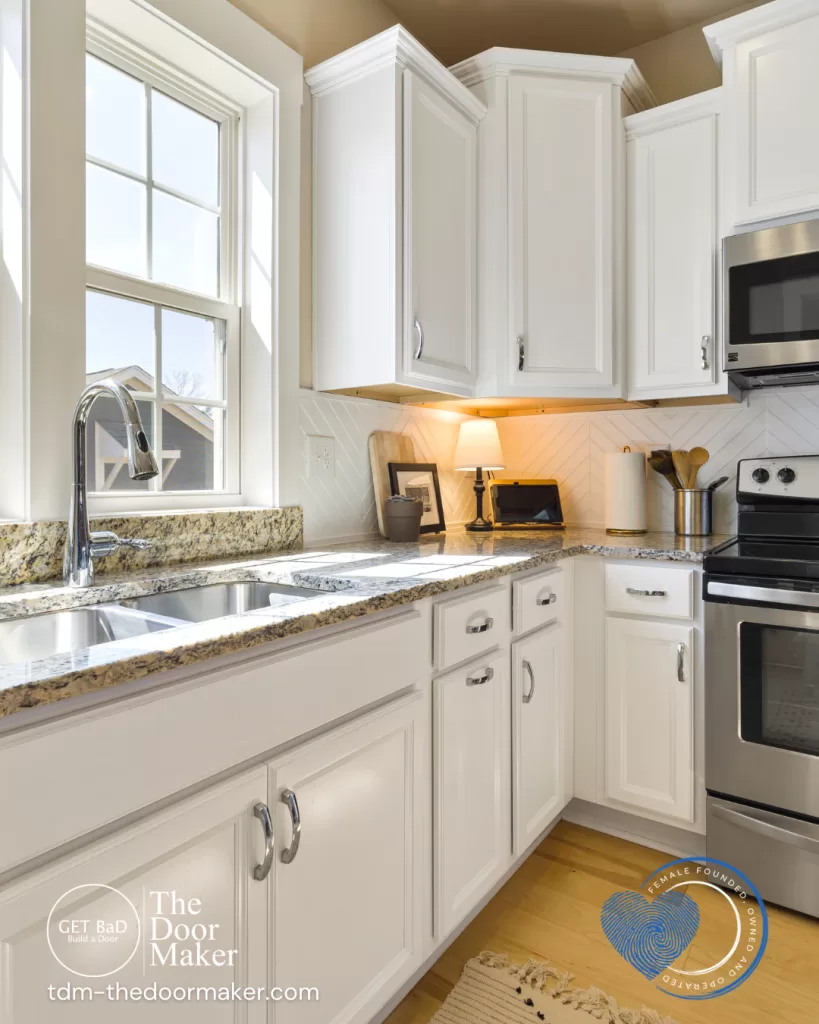
Oct 4 2024 BY David Adrian, Blog
Durable, Affordable, and Low-Maintenance (to name a few)
When upgrading your kitchen, Thermofoil cabinet doors are a popular choice for homeowners seeking a combination of durability, affordability, and easy maintenance. Whether refacing an old kitchen or building a new one, Thermofoil-sealed doors offer several advantages making them a smart investment. Here’s why:
1. Durable and Long-Lasting
Thermofoil cabinet doors are known for their exceptional durability. The PVC covering is resistant to scratches, dents, and cuts, providing a practical choice for busy kitchens. Whether you have kids, pets, or everyday wear and tear, Thermofoil cabinets hold up well over time and maintain their pristine appearance.
2. Moisture and Warp Resistant
Another standout feature is their moisture resistance. The vacuum-sealed PVC finish helps prevent moisture from seeping into the cabinet doors and drawer fronts. This provides an ideal solution for kitchen environments where humidity and spills are common. Unlike wood, Thermofoil doors will not warp or crack over time due to water exposure. They will maintain their shape and structure for years.
3. UV Resistant – No Fading
Unlike painted wood or laminate surfaces, the PVC material used in Thermofoil cabinet products does not fade or change color when exposed to sunlight. This UV resistance ensures that your custom cabinet doors will stay vibrant and beautiful, even in kitchens with lots of natural light.
4. Easy to Maintain
Cleaning and maintaining Thermofoil cabinet doors could not be simpler. All you need is a soft cloth, soap and water, or a common household cleaner. Easily wipe away dirt and grime without worrying about damaging the finish. Their low-maintenance nature makes them perfect for anyone who wants to spend less time cleaning and more time enjoying their kitchen.
5. Affordable
Because of the efficient manufacturing process, Thermofoil doors are a lower cost than traditional wood doors, while still offering a high-end look. The streamlined production and ease of customization mean you get a top-quality product at a fraction of the price. Allowing you to upgrade your kitchen without breaking the bank.
6. Easy to Replace
Custom cabinet doors with a Thermofoil finish are easy to replace. If you ever need a replacement cabinet door, the streamlined production process allows for exact replicas to be made. This means you can order a cabinet replacement that matches your existing doors perfectly and without any hassle.
7. Solid, One-Piece Construction
Thermofoil doors are constructed as a single solid piece, eliminating the risk of joint failure common with traditional wood doors. The absence of seams or joints increases their strength, giving the doors a sleek, modern look that many homeowners love.
8. Extended Warranty for Peace of Mind
Enjoy the security of cabinet doors with a longer warranty. The Door Maker offers a 10-year warranty on all Thermofoil doors, far surpassing the typical 1- to 2-year coverage applied to most wood doors. This extended warranty provides peace of mind, knowing your investment is protected for a decade. The durability and resilience of Thermofoil doors, combined with this extensive warranty, make them an unbeatable option for anyone planning to upgrade with custom Thermofoil cabinetry.
When you are ready to upgrade your kitchen, bathroom, laundry, or any room in your home or office with durable, stylish Thermofoil cabinet doors, The Door Maker has everything you need. With over 30 styles and 130 colors, you can customize the perfect look for your space. Use the Build a Door tool to get started today!
Aug 26 2024 BY David Adrian, Blog
Why DIY Kitchen Refacing Is the Smarter Choice Over a Full Renovation
A full kitchen renovation may sound like an appealing solution to giving your space a fresh look. But while wielding a sledgehammer and gutting your entire room may sound like fun, converting your kitchen into a dust-filled construction zone is not always necessary. The more convenient, cost-effective, and less intrusive option is a DIY kitchen refacing. Let us tell you why, and more importantly how, you should get started with a modern kitchen mini-makeover.
1. Cost-Effective Solution
A full kitchen renovation is expensive. Between labor costs for removal, building and installation, materials, and the unexpected expenses that inevitably arise, you can easily spend tens of thousands of dollars.
On the other hand, kitchen refacing allows you to achieve a stunning transformation at a fraction of the cost. By reusing your existing cabinet frames and simply replacing the cabinet doors and drawer fronts, you save money while still achieving a dramatic update.
Pro Tips:
- - Our custom cabinet doors can be fully wrapped in the color of your choice. This means you can have the color of the back or inside of the door, matched to the color of the door front. This option is available on all door panels in any of our 130+ PVC colors.
- - All our cabinet doors and drawer fronts are easy to care and maintain.
- - Finish the interior of your drawers with bold, dramatic liners for added appeal.
2. Minimal Downtime
A full renovation could leave you without a functional kitchen for weeks. Limited to no access to appliances or counter space, can hinder your ability to prepare meals. Having to dine out, or rely on takeout, can quickly become costly and may be unhealthy.
With DIY kitchen refacing, you can keep your kitchen operational throughout the process. You will still have access to your stove, sink, and other essentials, allowing you to maintain your routine without interruption.
3. Work at Your Own Pace
One of the biggest advantages of DIY refacing is the ability to work at your own pace. Whether you want to tackle the project in a single weekend or spread it out over a few weeks, the choice is entirely yours. This flexibility makes it easier to fit the project into your schedule without the pressure or financial penalty of a contractor’s timeline.
4. Less Mess and Hassle
Renovations are a messy, disruptive process. With contractors coming in and out of your home, tracking dust and dirt, your entire space can feel like a construction zone. Reduced air quality due to lingering sawdust may impact respiratory comfort and agitate allergies.
Refacing, on the other hand, involves minimal mess. Since you are only replacing the cabinet doors and drawer fronts, there is no need to worry about demolition debris or extensive clean-up.
5. Privacy and Comfort
Giving strangers access to your home for days or weeks at a time can be uncomfortable, especially if you have pets who are disturbed by new faces. By opting for DIY refacing, you avoid the inconvenience of having contractors in your home, keeping your space private and peaceful.
6. Complete Control Over Design Choices
When you reface your kitchen yourself, you have complete control over every aspect of the design. Want to try a bold color for your cabinet doors? Prefer a specific style of hardware? The choices are entirely yours, allowing you to customize your kitchen to perfectly match your vision.
Pro Tips:
- From Mullions and Frames, and Multiple Panels, to Wine Racks, explore our product categories for additional customized cabinetry solutions and upgrade your space.
- All TDM products are available with several options including multiple panel profiles, styles, edges, and over 130 colors in matte, textured, and high gloss finishes.
When you are ready to start your DIY kitchen refacing project, The Door Maker has everything you need. Explore our range of door profiles for custom cabinet door replacement, including flat, raised, and shaker doors, to build the perfect match for your DIY project. Ideal for kitchen cupboard doors, our collection of more than 30,000 combinable options will give your kitchen, or bathroom, or even your media room, a whole new look you can install yourself.
Select from more than 30 panel styles, 10 edge profiles, and 130 thermofoil colors and finishes to create the perfect match for your perfect kitchen refacing project.
Jun 13 2024 BY superuser, Blog
There are many reasons preventing homeowners from fully renovating their kitchens. Some of these are justified; for example, you may need a place to move to during the renovation, which can be expensive, intrusive, and inconvenient. But others are simply myths perpetuated by others who had their own kitchen renovations go sideways. This blog will debunk some of the most common kitchen renovation myths to help you move forward with your kitchen renovation project.
Common Myths Surrounding Kitchen Renovations
Myth 1: Kitchen Renovations Are Too Expensive
Any home renovation project requires a certain amount of money to be invested. Experienced homeowners know that the kitchen is the single most expensive and labor-intensive room to renovate. Installing new kitchen cabinet replacement doors, buying modern appliances, and replacing the flooring can all cost a pretty penny. The truth is, your kitchen update is a worthwhile investment as the kitchen is usually the primary place where the family gathers and memories are made. A fresh look can be achieved by simply refacing your cabinet doors and drawer fronts if a full renovation is not an option at this time.
Myth 2: You Can’t DIY a Kitchen Renovation Project
Can I really do a kitchen renovation by myself? The answer to this question depends on the scale of the renovation. If your project involves redesigning the entire kitchen layout, installing new cabinetry boxes, replacing the countertops and the backsplash, or repurposing your dining room into an extended kitchen, consider hiring professionals.
If you simply want to update your kitchen cabinet facades and hardware, installing kitchen cabinet replacement doors will help you achieve the fresh look you want. Watching a few videos on how to install kitchen cabinet doors will also help you nail your kitchen cabinet refacing project.
Myth 3: Buying Supplies From Big Box Stores Is More Affordable
People revert to big retailers like Home Depot, Walmart, and Lowe’s for their kitchen renovation needs. They believe these options are affordable and offer flexible return and exchange options. The truth is, however, online businesses like The Door Maker can offer the same or higher levels of service, competitive pricing, and as an added bonus, with TDM you can customize your cabinet doors and drawer fronts to perfectly fit your existing cabinetry, decor style, and color palate. Our team will go above and beyond to ensure your complete satisfaction.
And did you know we offer custom doors specifically designed for IKEA kitchen cabinets? Whether you need new or replacement cabinet doors, we provide a helpful size guide to assist you in matching the door sizes with your existing IKEA cabinets.
Myth 4: Only Trendy Kitchen Designs Add Value to Your Home
Some people have a misconception that the trendier their kitchen the more value it adds to their home. While it is true that selling a house with a recently renovated kitchen is an opportunity to make a profit, it is important to note that it is not only about the kitchen’s visual appeal. A kitchen must also be functional to add to the value of a home.
Consider adding features for improved functionality such as extra-large drawers for pots or small appliances, Lazy Susans to utilize corner spaces, and soft-closing Blum hinges for your cabinet doors.
Check our helpful video tutorials and learn how to install hinges on regular cabinet doors and piano hinges on Lazy Susan cabinet doors. Request pre-drilled hinge holes in your TDM custom cabinet doors for easy installation.
Myth 5: You Need a Complete Kitchen Overhaul
No. Your kitchen upgrade can be anything from a simple cabinet door replacement to a full plumbing and electrical overhaul. Many homeowners opt for simple do-it-yourself cabinet refacing when updating their kitchens. This is because your old cabinet boxes or frames are still in decent condition and all you need to do is update the facade and the hardware. In these situations, it is important to find reliable cabinet door suppliers for your quality replacement MDF cabinet doors. You’ve come to the right place.
Choose The Door Maker For Your Kitchen Renovation Project
If you are looking for MDF cabinet doors for your do-it-yourself cabinet refacing project, look no further. The Door Maker offers high-quality thermofoil cabinet doors at competitive prices. With our wide range of customization options, rest assured you can Build a Door that’s perfect for your kitchen upgrade project. Contact us today to learn more about our products or browse our collection of MDF cabinet doors.
May 18 2023 BY superuser, Blog
Cleaning Thermofoil Cabinets and Cabinet Doors
Thermofoil is known as a thin layer of PVC glued to the surface of an MDF panel. It is popular for the uniformity and simplicity of its finish. Uniformity is also what makes thermofoil cabinet doors and cabinets easy to clean. Here are a few tips on how to clean thermofoil cabinets and cabinet doors:- Use a standard all-purpose scrub-free cleaner or a simple water and soap mixture to clean your thermofoil cabinets and cabinet doors.
- Avoid using cleaning solutions which contain harsh chemicals such as lacquer, thinners, bleaches, solvents or abrasives. Stay away from cleaners with toluene or acetone.
- Avoid spraying the cleaning solution onto the surface of thermofoil cabinets and cabinet doors directly. Instead, spray it onto a paper towel or a clean cloth and wipe down the cabinets and doors. Ensure the paper towel/cloth is damp but not dripping wet. This way, you won’t have to deal with excessive residue from the cleaning solution.
- If there’s residue left from the cleaning solution, give the cabinets a final wipe-down with a damp cloth or paper towel.
- Using a soft scrub-free cloth to clean your thermofoil cabinets and cabinet doors is important as you don’t want to damage the surface. If you have to clean grease stains, use a degreasing agent or an acetone-free nail polish remover.
How Often Should I Clean Thermofoil Cabinets and Cabinet Doors?
There’s no definitive answer to this question, as it depends on how often you use your kitchen to cook meals. Ideally, you should dust your kitchen cabinets and cabinet doors once a week to avoid dust and dirt accumulating and further building up in the corners of the cabinet doors, especially if you have shaker-style cabinets. Remember that the more often you clean your cabinets and cabinet doors, the longer they will last.General care
Aside from cleaning, there are some general care tips you should follow to ensure your thermofoil kitchen cabinets and cabinet doors last longer. They are as follows:- Never try to wax thermofoil cabinets and cabinet doors.
- Pay close attention to areas near the sink and dishwasher and wipe down any excess moisture as quickly as possible.
- Use blinds or curtains to protect thermofoil cabinets from direct and prolonged sunlight exposure, as UV rays can cause thermofoil film to fade.
- If you have mullion cabinet doors with glass inserts, be sure to wipe down the glass with an ammonia-free cleaning solution to keep the glass clear and shiny.
Conclusion
As you can see, maintaining thermofoil cabinets and cabinet doors is not difficult. By following these simple tips, you will be able to keep your kitchen cabinets as good as new and won’t have to think about replacing them for years. For more information on thermofoil cabinet door maintenance, please reach out to us at The Door Maker. A leader in the manufacturing of custom cabinet doors in Canada, we will be happy to answer all your questions and help you find the right cabinet doors style and color for your kitchen.May 10 2023 BY superuser, Blog
What are the most common materials used in kitchen cabinet making?
Trusting a designer with a new kitchen project is a good idea. However, taking the time to research and educate yourself on the various kitchen cabinet and door materials will help you understand what options are more suitable for your specific circumstances. So, let’s get started.Solid wood
Solid wood is a traditional choice for kitchen cabinets. It is known for its durability and long lifespan. A kitchen made of solid wood can serve you for years. Solid wood is also an environment-friendly material if sourced properly. However, wooden kitchens can be pretty costly. Another drawback of solid wood panels is their porosity. The porous nature of solid wood makes it highly susceptible to moisture and stains, meaning you’ll have to clean up spills as soon as possible to avoid the material rotting or warping.MDF
Durability and affordability make MDF the second most popular material used in kitchen cabinet manufacturing. MDF (or medium-density fiberboard) is essentially an engineered panel produced from wood fibres combined with a wax and/or resin binder and pressure-formed into the desired shape. MDF panels are denser than hardwood and provide a smooth finish which is difficult to achieve with solid wood materials. IKEA cabinet doors in Canada are mostly made of medium-density fiberboard. MDF is a great alternative over solid wood for a high-moisture area like the kitchen for its mould- and water-resistance properties. So if you are looking for an affordable solution that can withstand frequent exposure to water, MDF cabinet doors and cabinets are the way to go.High-density fiberboard
High-density fiberboard (or HDF) is another popular material used in kitchen cabinet making. It is known to be denser and more affordable than hardwood. HDF material is great for use in both humid and dry areas. However, just like wood, it is prone to water damage, so you will have to wipe all cups, dishes and cutlery dry before putting them in an HDF cabinet.Stainless steel
Stainless steel cabinets are not something you will find in an average residential kitchen, but rather in a commercial one. Bakeries, patisseries and restaurants will install stainless steel cabinets and countertops for reasons such as durability, ease of cleaning and long service life. Stainless steel kitchens are built to withstand excessive wear and tear which makes them an ideal choice for commercial kitchens. If you are hesitant about going entirely stainless steel in your kitchen, but you still want the benefit of durability, opt for stainless steel in a kitchen island or get by with a stainless steel backsplash.
Particleboard
Particleboard is probably the least expensive material you can find on the market. Made from wood chips, they are mistakenly confused with MDF and HDF panels. The manufacturing process indeed has some similarities. However, particleboard panels are not as strong and dense as MDF and HDF panels and can easily bend under the weight. Particleboard cabinets can easily crumble, so screwing anything in can be attempted only once, or else the material will fall apart. All in all, try to stay away from particleboard kitchen cabinets, even if your budget is really tight. Consider a more durable option like MDF or HDF panels instead, even if it’s more expensive.The takeaways
Choosing the best materials for kitchen cabinets shouldn’t be limited to visual considerations only. Ultimately, the purpose of your kitchen renovation project is not just to get newer-looking cabinets and countertops, but to get a kitchen that is more functional and long-lasting. Take some time to learn about different materials used in making kitchen cabinets, consider the cost, see which option can serve your purposes better and then make a decision.Apr 21 2023 BY superuser, Blog
What Is Cabinet Replacement?
Kitchen cabinet replacement involves removing the existing cabinets completely and replacing them with new ones. Along with replacing kitchen cabinets completely, you get to choose new kitchen countertops as well as change your kitchen layout. For this reason, kitchen cabinet replacement is a more expensive option than refacing.What Is Cabinet Refacing?
Cabinet refacing is replacing the doors and drawer fronts of the cabinets without replacing the entire cabinet. Some homeowners complement it by veneering the cabinets and installing new hardware to give their kitchen a totally new look, or simply installing new hardware. Installing kitchen cabinet replacement doors is considered more cost-effective and less disruptive than replacing the entire kitchen.4 Key Differences Between Cabinet Replacement & Cabinet Refacing
While the outcome is similar in both cases, e.g. newer-looking cabinets, there are a few key differences which set cabinet replacement and cabinet refacing apart. These include:- Cabinet replacement allows you to redesign your kitchen completely. If you always wanted to have a kitchen island, complete cabinet replacement is your chance to do so. Cabinet refacing does not give you the liberty to change your kitchen layout.
- Cabinet refacing is a more affordable option that can give your kitchen a fresh look and boost your home's resale value. In addition, cabinet refacing is not as disruptive and messy as replacing the entire cabinetry.
- Cabinet replacement is best for kitchens which are falling apart or have undergone extensive wear and tear. Refacing such cabinets is not recommended for the same reason.
- Cabinet refacing is considered more environmentally friendly than complete kitchen replacement as less material goes to waste.
Can You Do It Yourself?
When it comes to planning a successful DIY kitchen renovation, both cabinet replacement and cabinet refacing require a certain degree of skill and dedication. However, do-it-yourself cabinet refacing is considered more DIY-friendly as it involves less work and does not require a great level of expertise. You can easily learn to unmount old cabinet doors and mount new ones by watching a few YouTube videos. There are companies that offer cabinet refacing services. However, expect to pay a fee for the convenience of having a professional install new kitchen cabinet replacement doors. DIYing full kitchen replacement is certainly more difficult as it is more laborious and resource-consuming than cabinet refacing. However, if a totally new kitchen is what you’re after, then complete kitchen renovation is what you should consider.The Takeaways
In closing, cabinet replacement and cabinet refacing are both viable kitchen remodelling options, although each has its own set of pros and cons. We hope this blog can serve you as a guide to the two kitchen remodelling options and help you make an informed decision.Apr 14 2023 BY superuser, Blog
 Kitchens are the heart of every home. They are where families spend time together, eat and celebrate special occasions. But not all kitchens offer that welcoming spirit. Outdated kitchens with poor lighting and lack of counter space can make you feel uninspired and not want to spend a minute more. If your kitchen is like that, you should consider a kitchen renovation. And if an unmotivating look is not convincing enough for you, here are X more reasons why kitchen renovation is the best thing you can do for your home this year.
Kitchens are the heart of every home. They are where families spend time together, eat and celebrate special occasions. But not all kitchens offer that welcoming spirit. Outdated kitchens with poor lighting and lack of counter space can make you feel uninspired and not want to spend a minute more. If your kitchen is like that, you should consider a kitchen renovation. And if an unmotivating look is not convincing enough for you, here are X more reasons why kitchen renovation is the best thing you can do for your home this year.
Why Consider Kitchen Renovation?
You get a brand new kitchen you deserve
First of all, who wouldn’t love a new kitchen? Sleek marble countertops, matte-finished cabinets and modern lighting will make your morning coffee routine or breakfast with the family even more enjoyable. If you can’t afford to fully renovate, go for a more cost-effective option like installing kitchen cabinet replacement doors. Kitchen refacing will make your cabinets look as new as if you installed them from scratch.Boosted home resale value
Although some may argue here, kitchen renovation has proven to be more of an investment than an expense. With a newly renovated kitchen, you can expect a 75-100% ROI on your investment, depending on the renovation. Obviously, renovating is expensive, but not only do you get to enjoy a brand new space in your home, but you are also increasing the value of your property.Parties will become a common thing in your house
If you like to host family gatherings and parties, remodelling your kitchen will be another chance for you to show off your new mullion cabinet doors and impress your guests. After all, the kitchen is not only the place where you cook. It is also the place where your creativity and design skills can unfold. Even if you are utterly introverted and parties are not your thing, you will find yourself willing to host more parties in your newly renovated kitchen.
You get to take advantage of new technologies
Cooking recipes change rapidly, and so does technology. These days appliances not only serve as tools to help you prepare food. They also make your life a lot easier. For instance, you can get a slow cooker with a delay start feature to help you prepare meals ahead of time. Coffee makers come with built-in grinders to make the perfect coffee.The Last And Most Valid - Why not?
It is hard to find reasons why kitchen renovation is not a good idea. You get to enjoy a brand-new space in your home and show it off to your guests. And if budget is an issue, you can always opt for a partial renovation, like changing the countertops or installing kitchen cabinet replacement doors only. Regardless of how you decide to renovate your kitchen, you will not regret the results.Apr 4 2023 BY superuser, Blog
Four Steps Of A Successful DIY Kitchen Renovation
1. Gather ideas & draft a sketch
Any home improvement project needs to start with drawing some inspiration, and these days, inspiration can be drawn from a wide variety of sources. Follow interior designers’ social media accounts and get inspired by their projects and designs, check some home improvement magazines, and view some kitchen renovation videos on YouTube. These will help you get a sense of what you want your new kitchen to look like, and inspire you to start sketching.2. Determine a budget and set a timeline
The next step after deciding on the design of your ideal kitchen is to estimate the cost. To establish a strong basis for your kitchen makeover budget, do some research. Setting a budget ceiling at the early stages of renovation will help you get a better idea of what to expect and how to plan your finances. Setting a timeline is also crucial when planning a kitchen renovation. The timelines vary based on a number of aspects, including the size of your kitchen, the extent of the work, and the contractor's involvement, if any. Experts predict it will take between one and three months to complete a full kitchen renovation. But if you go for a simple kitchen cabinet refacing DIY, you are looking at a 2 to 7 days timeline, depending on your previous DIY experience.3. Order samples
Kitchen cabinets are the core of any DIY kitchen renovation project. Ordering samples is the best way to picture your new kitchen cabinets. Many companies, like The Door Maker, offer swatches or even door samples that can be ordered online. Ordering samples, whether a swatch or a whole door, will allow you to experience the quality of the materials and the finish and help you with decision-making.4. Order supplies and appliances
Kitchen renovation can involve everything from installing replacement kitchen doors to replacing all kitchen cabinets and appliances. If you are going to replace your old appliances, do your research in advance. Look for the most energy-efficient appliances available and compare prices. If new appliances are not on your budget and all you want is to reface your kitchen cabinets, look for cabinet door suppliers in your area and order all the supplies you need to complete your kitchen cabinet refacing DIY. Some cabinet door suppliers sell online and offer flexible delivery rates when you order a certain amount of doors. After everything has been arranged, you can go ahead and embark upon your DIY kitchen renovation venture. Remember to leave room for the unexpected, and don’t get discouraged if things don’t go exactly as planned. With the right attitude and some creativity, you will achieve the kitchen of your dreams.Mar 22 2023 BY superuser, Blog
How to Save Money On a Kitchen Renovation and Still Get the Kitchen of Your Dreams?
Go for butcher block countertops
Quartz and marble countertops no doubt look gorgeous with any kitchen design, but they are also the most expensive materials for countertops. To save money and still have a beautiful and practical countertop, go for the butcher-block type of countertops. They have a lower fabrication cost, so they won't be as expensive as marble or quartz and still offer a no less stylish look.Upcycle your cabinets
Cabinets upcycling has become a huge trend in the last few years. One of the most popular ways to upcycle your kitchen is to install new thermofoil cabinet doors on your cabinets. Installing kitchen cabinet replacement doors is a simple and cost-effective way to transform the look of your kitchen without breaking the bank. If you are keen on all things DIY and upcycling, you will definitely like the DIY kitchen cabinet doors idea.Backsplash
Updating just the backsplash will give your kitchen a breath of fresh air. Choose between tile patterns, vinyl film or no backsplash at all to experiment with different looks. If you go for tile backsplash, experiment with the patterns to find the one that fits your kitchen style best.Update the appliances
Sometimes, it’s not all about the kitchen cabinets or countertops. Outdated appliances that have been there since the 2000s can make your kitchen look old and tiring. If you are not ready to spend on new countertops or cabinets, consider updating the appliances. Not only will you refresh your kitchen look, but you will also make your cooking experience more enjoyable with a new and more efficient stove and oven.Conclusion
Kitchens are no longer only about storage and cooking. They are also about being a place where families and friends gather to share good food and good times. With a bit of creativity and DIY spirit, you can make your old kitchen look brand new and feel welcoming without spending a lot of money.Mar 17 2023 BY superuser, Blog
What is cabinet refacing?
Cabinet refacing involves replacing existing doors and drawer fronts of your kitchen cabinets with new ones. If the base cabinets are in good shape and haven’t lost their colour, you can leave them as is and make do without veneer panels or painting them. If you are considering updating the colour of the base cabinets too, you can paint them with a new colour or glue a new veneer on them. The hardware (handles, drawer pulls and hinges) is normally replaced during DIY kitchen cabinet refacing too.How does DIY cabinet refacing work?
While many people think kitchen cabinet refacing is the same as cabinet renovation, in reality, it is not. Cabinet refacing primarily involves replacing the doors and drawer fronts of the kitchen cabinets with newer replacement options. The average process would look something like this:- You get precise measurements of your cabinets doors and drawer fronts. Check out this video guide on measuring kitchen cabinet doors for your DIY kitchen cabinet refacing project.
- Do your research on cabinet door suppliers and choose the one you can trust. Select the desired colour for your new cabinet replacement doors and drawer fronts and place the order.
- Remove your old cabinet doors.
- Install new hardware on the new cabinet replacement doors. This step is unnecessary if the old hinges and handles are still in good condition and you decided to keep them.
- Mount new doors and drawer fronts on the cabinets.
Where to get materials for DIY cabinet refacing?
There are multiple cabinet-refacing suppliers in Toronto, the GTA and throughout Ontario. As someone dreaming of a perfect kitchen, you want to be sure the cabinet door replacements you buy are high-quality, long-lasting and of the best possible price. You can start by researching cabinet thermofoil door suppliers online and sorting them by reviews. Next, compare the pricing and the quality of the materials, and find out if the supplier has a physical location where you can visit and ask for samples. All this will help you choose the best supplier at a reasonable price.Why Choose The Door Maker For Your DIY Kitchen Cabinet Refacing Project?
The Door Maker is the number one provider of cabinet thermofoil doors in Ontario and all across Canada. Having been in the business for over 48 years, we have gained a reputation as a reliable and trustworthy kitchen/bath cabinet doors supplier with the best quality products. Not only do our clients get to choose from a wide range of colours, door profiles and edge designs, but they also take advantage of the most affordable prices and flexible payment options. Our clients are never left to wonder about the door's design as our staff is always available to help with colour and design considerations. Our product is easy to install and gives the appearance of painted wood or finely stained natural grain cabinet doors. We are also the manufacturer of our product, so we can offer our customers the best pricing on the market. To top up our exceptional service and excellent product, we use only the latest in technology and machinery to ensure a high level of efficiency in the manufacturing process and zero carbon footprint. TDM is your go-to source for exceptional quality thermofoil cabinet doors in North America.
How much does DIY kitchen cabinet refacing cost?
According to the Home Guide, the average kitchen cabinet refacing cost is $6,518 (~ CAD 8,950). A 10′ x 12′ kitchen will cost between $4,214 and $8,110 (~ CAD 5,783 to CAD 11,130) to reface. Of course, these numbers greatly depend on aspects such as the quality of the materials, hardware, kitchen size and more. Labour costs are also important to keep in mind. If you hire kitchen refacing contractors, expect to pay between $30 to $100 per hour on top of the materials and hardware costs. But if you want to save even more money and are up for a challenge, consider a DIY option.Pros and Cons of DIY kitchen cabinet refacing
When considering DIY kitchen cabinet refacing, it is crucial to weigh all pros and cons of this venture.Why go for DIY kitchen cabinet refacing?
- Brand new kitchen cabinets for a fraction of the cost - DIYing your kitchen cabinet refacing is definitely cheaper than renovating your entire kitchen from scratch.
- No city permits are required - Since cabinet refacing doesn’t involve any major plumbing or electrical work, you don’t need to apply for any permits to reface your kitchen cabinets.
- Boosted home-resale value - With cabinet refacing, your kitchen will look as stunning as a brand new kitchen, so expect to get a higher resale value when selling your home.
- An outlet for creativity - If you are keen on all things DIY, especially those concerning home design, kitchen refacing is a great opportunity to allow your creativity to run wild.
When to stay away from DIY kitchen cabinet refacing?
- Not worth the money if cabinets are old or damaged - cheap, old plywood cabinets showing signs of wear may not be worth the effort of refacing them.
- Doesn’t help change kitchen layout and cabinet space - if kitchen layout is what bothers you more than the cabinet fronts themselves, refacing may not be the best option as it will not change the kitchen’s layout.
FAQs
Can you DIY kitchen cabinet refacing?
Yes, you can! In fact, this process is so easy that you shouldn’t even bother hiring a professional installer to complete your kitchen cabinet refacing project. All you need is ordering the right supplies and a little DIY spirit.How long do kitchen cabinet refacing projects take to complete?
Depending on the kitchen size, it could take you from a weekend to a week or two to finish a DIY kitchen cabinet refacing project. The installation time will also vary depending on your skill level. An experienced DIYer will complete the installation in less time than a novice.Is DIY cabinet refacing worth the money?
Indubitably, yes. Aside from saving you a big chunk of money, your kitchen will obtain a brand-new look without the hassle of a full remodel.Mar 9 2023 BY superuser, Blog
Are you tired of staring at your outdated kitchen cabinets but don't want to break the bank with a full renovation? Look no further! Cabinet refacing is an affordable and stylish solution that can completely transform the look of your kitchen. From minimalist modern designs to rustic farmhouse vibes, we've rounded up five do-it-yourself cabinet refacing trends that are sure to inspire your next home improvement project. Get ready to elevate your space and impress all those dinner party guests with these must-try cabinet transformations!
5 must-follow modern DIY cabinet refacing trends
Shaker-style cabinets:
If you are looking for a way to update your kitchen cabinets without spending a fortune, cabinet refacing is a great option. Cabinet refacing involves replacing the door and drawer fronts, as well as the hardware, of your existing cabinets. This can be done by either painting or staining the cabinets, or by using new veneer or laminate to give them a fresh look. It is one of the easiest do-it-yourself cabinet refacing trends that prevail today.
One of the most popular do-it-yourself cabinet refacing trends is shaker-style cabinets. Shaker-style cabinets are characterized by their simple, clean lines and lack of ornate details. This style of cabinet is perfect for those who want a sleek and modern look for their kitchen. If you are interested in giving your kitchen a shaker-style makeover, there are a few things you will need to do. First, you will need to remove all of the doors and drawer fronts from your cabinets. Next, you will need to measure the openings for replacement doors and drawer fronts. Once you have the measurements, you can order new doors and drawer fronts from a local kitchen cabinet door manufacturer.
Once you have received your new doors and drawer fronts, it is time to install them. This is relatively easy to do, but if you are not confident in your ability to do it yourself, there are plenty of companies that offer installation services. Once your new doors and drawer fronts are installed, you can then add any hardware that you desire.
Open Shelving:
Open shelving is one of the hottest trends in do-it-yourself cabinet refacing kitchen designs right now. If you are considering a kitchen remodel, you should definitely consider this trend. Open shelving can give your kitchen a more open and airy feel, as well as make it easier to keep your kitchen organized and tidy.
There are a few things to keep in mind if you decide to go with open shelving in your kitchen. First, you will want to make sure that the items on your shelves are neatly arranged and not cluttered. You also want to be sure that the items on your shelves are ones that you use often and that are easily accessible. Finally, you will want to make sure that the shelves themselves are made of sturdy materials so they can support the weight of whatever you put on them.
Modern & Retro Knobs and Handles:
When it comes to do-it-yourself cabinet refacing there are many different trends that come and go. However, there are always certain elements that remain popular among homeowners. One of these trends is the use of modern and retro cabinet knobs and handles. There are many different styles of cabinet knobs and handles available in the market today. When it comes to choosing the right ones for your home, it is important to take into account the overall style of your kitchen or bathroom. For a more modern look, consider cabinet hardware with a sleek and simple design. If you prefer a more retro or vintage style, there are many options available with intricate details and unique finishes.
Glass Doors:
Another popular do-it-yourself cabinet refacing trend is to replace solid doors with glass doors. This gives your kitchen a more open and airy feel, and it also makes it easier to find what you’re looking for in your cabinets. If you’re not sure about committing to all glass doors, you can always start with just a few and see how you like the look. Fixing glass doors might seem difficult but it is easy if you follow the required steps.
Scandinavian Style Cabinets:
There is something about Scandinavian-style cabinets that make them perfect for a do-it-yourself cabinet refacing project. They are simple, yet elegant and can be easily transformed with a few simple changes. One of the most popular trends is to replace old cabinet doors with a white thermofoil MDF alternative . This gives your cabinets a clean and fresh look that is perfect for any kitchen. If you want to add a bit of colour, you can always add some new hardware or even change the door handles. Another popular trend is to stain the cabinets. This gives them a rich and warm look that will complement any kitchen décor.
No matter what trends you decide to follow, remember that cabinet refacing is a great way to save money and still get the kitchen of your dreams! Even though the aforementioned do-it-yourself cabinet refacing trends might seem difficult to do, they are actually not. These trends are easy to follow if you plan them accordingly and mainly, source your materials from a trusted supplier.
Hope these 5 unmissable do-it-yourself cabinet refacing trends help you transform your kitchen into an open and lively space.
Mar 3 2023 BY superuser, Blog
How to Make Your Kitchen Cabinet Refacing Project a Success?
Plan the budget
Planning how much you can spend on cabinet refacing materials is important as it helps you to stay within the budget. If you set a budget limit for your project and stick to it, you won’t be as tempted to spend money on something you don’t need or can’t afford.Define the project goals
Setting project goals will help you finish your kitchen cabinet refacing project faster. For instance, researching and shortlisting kitchen cabinet refacing suppliers could be one of the goals you can set for yourself. Make sure the goals are clear and attainable. And, if things don’t go the way you planned, don't stress. Take a break and get back to work when your inspiration is back.Get organized
Getting yourself organized will help you get the kitchen of your dreams ready faster. For instance, set a project schedule and stick to it as much as possible. If you are DIYing your kitchen renovation project, set a deadline to order kitchen cabinet refacing supplies, or allocate a day in a week when you can fully dive into the project.Find project inspiration
This part is usually the easiest and the most fun as the sources you can get inspiration from are almost limitless these days. Check some best kitchen renovation projects on Pinterest or Instagram, follow interior designers on social media, and read home improvement magazines.Be patient
We know how tempting it may be to get things done quickly, but rushing your project is never a good idea. The last thing you want is for your new kitchen cabinet replacement doors to end up being half an inch short, right? Work on your project one step at a time and praise yourself for the small accomplishments you achieve.Conclusion
Refacing your kitchen is a challenging journey that requires patience. But when you get to the end, the result is well worth it. Follow these 5 tips to make your kitchen cabinet refacing project an easy and successful one. If you are looking for kitchen cabinet refacing supplies, The Door Maker got you covered. We carry a wide range of flat, raised and shaker-style cabinet doors in over 150 colours available in matte, wood grain, and high-gloss thermofoil finishes. We offer our clients a high-quality product paired with unmatched customer service. Turn your kitchen into a dream with our cabinet doors.Feb 10 2023 BY superuser, Blog

How to Affordably Upgrade The Look Of Your Old Kitchen?
Upgrade the flooring Traditional vinyl or linoleum floors used to be popular in the 2000s, but these days they are a thing of the past. Consider upgrading the flooring with something more durable, modern and resilient, such as laminate, tile or stone. You can also try wood flooring if you want to go for a timeless option. Sometimes a simple swapping out the old flooring can add a major boost to the look of your old kitchen. Change the countertops Countertops are the most utilized area in the kitchen. Cooking dinner, making your morning coffee, all this is done on the countertop, so you want to make sure it is made of high-quality and durable materials. Replace your old MDF countertops with a sturdier option such as granite, marble, soapstone or wood. Go for DIY kitchen cabinet refacing When you walk into a kitchen, the first thing that catches your eye is…yes, cabinets! Regardless of how great your new dinnerware or curtains look, if your cabinets are outdated, they will ruin the overall look and feel of your kitchen. And if you are not ready yet for a full kitchen makeover, consider a do it yourself kitchen cabinets refacing. This cost-effective kitchen modernization option has been gaining traction in the last decade. Not only does it refreshes the look of your kitchen cabinets, but it also helps you save significant costs on a complete kitchen renovation. Upgrade the lighting Lighting plays an important role in any room, and the kitchen is no exception. Correctly positioned lighting can add that warm and welcoming ambience to your kitchen. There are several ways to improve the lighting in your kitchen: install a dimmer switch to add versatility when cooking or hosting guests, consider LED lighting for under countertops, add a special ambience by hanging a chandelier over the kitchen island. Install new backsplash Installing a new backsplash has several benefits. Not only does it enhance your kitchen decor and makes cleaning easy, but it also increases your home value if you are planning to sell your home eventually. For a timeless backsplash, go for glass, metal or natural stone tile. From changing the lighting to opting for do it yourself cabinet refacing, all this will help you achieve a new kitchen look. Choose the scenario that suits you best and give your kitchen that newer look it deserves.Feb 3 2023 BY superuser, Blog
Why do-it-yourself cabinet refacing is the best way ever to refresh the look of your kitchen?
Kitchen cabinet refacing has been gaining traction for very simple yet compelling reasons. If you are looking to remodel your kitchen, you need to seriously consider do-it-yourself cabinet refacing and here's why:- It saves costs
- It looks as great as a full-fledged kitchen makeover
- It can be fully DIYed
- It takes less time to complete
Jun 6 2022 BY superuser, Blog
Renovations can be pricey, but investing in your home doesn’t have to break the bank. Take on a DIY project to save money while also yielding a return.
Your kitchen is a great place to start. Cabinet boxes are very durable and are meant to last. Your doors, however, take a toll due to everyday use. Refacing your kitchen cabinet doors is an excellent DIY project that absolutely anyone can do. By not hiring contractor you can save thousands of dollars that can yield a big return on investment.
According to the 2021 RE/MAX Renovation Investment Report, when it comes to the renovations that yield the best return on investment, Canadians see these as the best renovations to undertake:
- 70 percent of Canadians state redesigning larger spaces, such as kitchens or washrooms
- 33 percent of Canadians consider themselves to be very capable when it comes to home renovations and don't need professional help
Sixty-five percent of RE/MAX brokers surveyed also claim that kitchen upgrades, including cabinets, countertops, and appliances, yield the highest ROI for sellers, with 87 percent of brokers naming the kitchen renovation as the top home improvement resonating with buyers in the Canadian real estate market.
Cabinet refacing is a custom upgrade at an extremely affordable price. Whether this is your forever home or you’re looking to sell, stick with the classics. Shaker-style cabinet doors with a neutral colour will always be on-trend and will also add to the resale value.
Walking into your kitchen should give you a sense of joy. After all, it’s the perfect place to enjoy cooking and sharing meals with family and friends.
Refacing your bathroom vanity is also another great DIY project. Rather than buying a new vanity, breathe new life into your existing one by swapping out the cabinet doors and drawer fronts. Add a fresh coat of paint to the walls and you’ve got a brand new bathroom.
These minor changes can have a huge impact on your home!
May 12 2022 BY superuser, Blog
Mudroom Cabinets
The mudroom; it’s the first thing people see as they enter your home and also the most high-traffic area. A mudroom should not only compliment the design of your home, but it should also be very functional for everyday essentials. Make a statement with custom cabinetry that you yourself can design and install.
A great place to start is with IKEA cabinets. They have so many different cabinet box sizes to choose from that’ll fit your home. You can elevate the design of the IKEA cabinet with cabinet door fronts from The Door Maker. Choose from 28 cabinet door panels and over 150 colours. You can order side panels/gables to cover the exposed sides of the IKEA cabinets to make everything look seamless.
For a sense of organization, keep these key elements in mind when designing your mudroom:
- Hooks to hang coats, purses, hats, and backpacks.
- Bench for seating. It’ll make putting on and taking off your shoes really easy and quick.
- Built-in cabinets for storing seasonal wear.
This mudroom design is simply stunning. It was a DIY project taken on by one of our customers. What we love most about this is how she paired these two colours. It’s light and bright with a touch of drama. The upper cabinets feature one of our newest colours, Walnut Ombre. It’s black with a hint of grey; it has knots and a heavy grain. The lower cabinets are in White Portuna. It’s light chiffon white with a dark grain. Both colours have a textured finish that looks and feels like wood.
She chose a very modern cabinet door panel, the Slanted profile. It’s a flat panel with a sharp edge that has a 30-degree angle.
Having a well-designed mudroom can help keep you organized throughout our changing seasons.
Apr 21 2022 BY superuser, Blog
White Kitchen Cabinets
White kitchen cabinets are still the most popular choice of colour for homeowners. It will have your kitchen feeling bigger and brighter. White cabinet doors are a fresh colour that will keep your kitchen sparkling like new for years to come.
White cabinets are very versatile. First off, the handle and knob options are endless. There a many different colours and styles to choose from to complement your white cabinets. Secondly, you can add a pop of colour to an all-white kitchen with a contrasting kitchen island or colourful appliances. This White High Gloss kitchen has a very modern and fresh design. We love how it is accented with gold handles.
Adding mullions and frames can give your white kitchen an extra wow factor. There are a variety of inserts to choose from, like glass, frosted glass, or a mirror. Glass frames are great for displaying fancy tableware. This Nordic White kitchen features the Darby frame with a mirror insert.
Nordic White is one of our best-sellers. Homeowners love this finish because it’s crisp and clean. It’s not a stark white. The colour does have a touch of warmth to it, making it a very inviting colour.
If white cabinets are too stark for your taste, switch things up with a white wood grain. This classy black and white kitchen features Ash White. This colour adds a bit of detail to your cabinet door and also feels like wood.
At The Door Maker, we have many shades of white to choose from, like bright whites, white with a hint of grey undertone, or off-whites. We also have different finish options, like textured, matte, wood grain, and high gloss to suit your taste.
Mar 17 2022 BY superuser, Blog
Modern Kitchen Cabinets
Modern kitchens feature a flat panel cabinet door giving it a very simple and sleek look. It can even make your kitchen look bigger. Flat-panel doors are very versatile and pair beautifully with matte, wood grain, and high gloss finishes.
Flat-panel cabinet doors will always be on-trend because of their timeless design. It has smooth, clean, and simple lines that will be a treat for the eyes!
The biggest advantage of slab doors is that they have an easy-to-clean surface. Simply wipe them down without fussing over dust or grease buildup in any grooves.
Flat-panel cabinets are the most budget-friendly doors that we make. You’ll achieve a high-end, modern kitchen design without the hefty price tag. At The Door Maker, we have 4 different flat-panel doors to choose from:
Profile A
This is your classic slab door. Profile A was also one of our best sellers in 2021.
Puritian
This panel gives your door a bit of a design. It has grooves running along the length of the door. The Puritian panel slightly resembles a shaker cabinet door which can also help you achieve that modern kitchen look.
Pillow
This flat panel door has a soft edge that has a 30-degree slope.
Slanted
This is a flat panel door that has a sharp edge that has a 30-degree angle.
Reface your cabinets with these modern flat-panel cabinet doors today!
Feb 16 2022 BY superuser, Blog
Laundry Room Cabinets
Elevate your laundry room with custom cabinet doors. Having storage space in your laundry room is essential. When designing your laundry room, consider:
- Cabinet doors or open shelving to store detergent, fabric softener, and an iron board
- Countertop for folding clothes
- Deep sink for stain removal or to wash delicates
- Rod to hang clothes
Doing laundry won’t feel like a chore when you’ve got a space as stunning as these designs!
This laundry room was a DIY makeover. It features two different door styles. The upper cabinets are in style 2003 which features an arch with shoulders at the top of the panel profile while the bottom remains flat. The bottom cabinets are in style 2002 which is squared. The cabinet door features Profile G which has a raised panel, deep 3 step u-shaped groove, and square corners. The edge profile features the 03 design which has a two-step gradual slope. The cabinet colour is Nordic White.
Green cabinets are in this year! It is such a stunning pop of colour to add to your laundry room. The cabinets feature the Vermont Shaker Triple Panel in Celadon Super Matte. Celadon is light green with a matte finish.
Go bold with these Mysterious Super Matte cabinets. The beautiful blue shaker cabinet doors really stand out against the white countertop. This laundry room design really has it all. The cabinets provide excellent storage space. The countertop gives you plenty of room to fold your clothes and there's even a bar to hang clothes to dry.
This light blue finish is the absolute perfect colour for your laundry room. These gorgeous cabinets feature the Vermont Shaker Double Panel in Denim Super Matte. Once again this laundry room incorporates all of the design elements that make for a functional and gorgeous space.
We hope that this blog has inspired you to get creative with your laundry space by incorporating different cabinet door panels and a pop of colour in your home.
Jan 7 2022 BY superuser, Blog
Green Kitchen Cabinet Doors
Many paint companies have announced a shade of green as their colour of the year, which means we can expect to see a lot of green kitchens in 2022. Green is a colour that symbolizes renewal, nature, and freshness.
To help you keep your kitchen looking absolutely trendy in the new year, explore our shades of green:
Fjord is our newest colour. It’s a calming and soothing green with a matte finish.
Celadon Super Matte is light green with a matte finish. This shade of green was our best seller for 2021.
Duke Super Matte is dark green with a matte finish.
Green is very versatile when it comes to choosing your cabinet door panel. It's a colour that works well on flat, raised panel, and shaker cabinet doors.
You have a few design options when it comes to incorporating green in your kitchen:
- Go bold with green cabinets throughout your kitchen
- Add a little pop of colour with a green kitchen island
- Design a two-tone kitchen
For a two-tone kitchen design, green lower cabinets look stunning with white uppers. Nordic White is a refreshing bright white while Snow White has a grey undertone. Both colours have a matte finish.
Another design idea is wood grain lower cabinets with green uppers. Woodgrain colours that pair well with green are Nutmeg, Walnut, Sesame, and Walnut Ombre.
Are you ready to embrace green this year?
Dec 1 2021 BY superuser, Blog
1K Holiday Giveaway
Is your kitchen in need of a serious makeover? We're giving away a $1,000 TDM gift card to use towards your online purchase of kitchen cabinet doors.
Here’s how to enter:
- Follow @tdm_thedoormaker
- Like this post
- Tag a friend who would love a kitchen makeover (one friend per comment, unlimited entries, no repeat tags)
Bonus Entry
Get 10 bonus entries if you DM us a picture of your kitchen
Rules
The giveaway period will run from Wednesday, December 1, 2021 to Wednesday, December 15, 2021 at 11:59:59pm EST.
The winner will be announced on Friday December 17, 2021 in an Instagram post and via DM. The winner will only be contacted by @tdm_thedoormaker.
This contest is open to Canada (excluding Quebec) & US residents who are 18 years of age and older.
As per Instagram rules, this promotion is in no way sponsored, endorsed or administered by, or associated with, Instagram. By entering, entrants release Instagram of responsibility, and agree to Instagram’s terms of use.
Good luck!
And the winner is...
Nov 19 2021 BY superuser, Blog
Kitchen Design Board
This past year, we were featured in three design boards put together by the Canadian Home Trends Magazine. Take a look at some of these gorgeous kitchen designs that feature our newest cabinet door panels and colours.
Modern Farmhouse Kitchen
“Inspired by a gorgeous KitchenAid Commercial-style Range in Ink Blue, this modern farmhouse kitchen definitely offers plenty of WOW factor! Crisp white cabinetry is contrasted by a dark, dramatic backsplash. Traditional textiles, a gorgeous apron sink and wood finishes create a warm, moody look with rustic charm, perfect for a family to hangout in! Two-tone detailing on the hardware brings a touch of gold into the space in a subtle way for a hint of luxury that doesn’t distract from the feel of the space.” - Jo Alcorn, Alcorn Home
Featured on this design board is our Two Stepped Shaker in Crystal White. This cabinet door has a recessed panel. The inside profile has a ¼" step and round corners.
Retro-Inspired Urban Kitchen
“Inspired by a diner from the 1960s, this kitchen is the perfect place to showcase the KitchenAid Commercial-style Range in Passion Red! A graphic patterned floor creates a fun vibe without competing with the stunning red range. Cabinetry in contrasting colors continues that theme, with white cabinetry with dark countertops, contrasted by a dark island with a terrazzo countertop! Sleek black hardware and stainless steel appliances finish the look with an air of urban sophistication.” - Gabriele Pizzale, Pizzale Design Inc.
This design board features our Vermont Skinny Shaker cabinet door panel and Marine Serica colour swatch. This cabinet door has a flat panel with a raised bead that is wide. Marine Serica has a dark blue finish.
Kitchen by the Sea
“The cottage is the perfect spot to embrace the colors and textures of nature in your décor! For this beach-inspired kitchen, we envision XL Rustic hardwood floors in place of the sandy beach and a stunning countertop reminiscent of rocky shores! Shaker-style white cabinetry sets the stage with a lovely blue for the island to bring in the color of the sea and sky!” - Crystal Williams
Our Two Stepped Shaker cabinet doors in Crystal White and Denim Super Matte were featured in their Kitchen by the Sea design board.
The Two Stepped Shaker is one of our newest profiles. It has a recessed panel and the inside profile has a ¼" step and round corners. Our Crystal White PVC is white with a textured finish and our Denim Super Matte PVC is light blue with a matte finish.
We hope that these kitchen design boards have helped you find inspiration for your upcoming kitchen renovation!
Oct 26 2021 BY superuser, Blog
Doors for Garage Cabinets
Revamp your garage with custom cabinetry by creating a space where you can work, organize your seasonal essentials, and have enough room to park your car.
For a rewarding DIY project, you can either build your own cabinet boxes or purchase them from IKEA and you can get high-quality doors from The Door Maker. Our thermofoil MDF doors are highly durable and can withstand the changing temperatures of your garage environment.
When designing your garage cabinetry, consider adding:
- A work table Cabinet doors to store rakes, shovels, tools, and equipment
- Drawers to store nails and screws
- Shelves to easily access everyday essentials
- A rack or hook to hold a bike or winter gear such as a ski, snowboard, or toboggan
The garage pictured above features our Profile A cabinet door panel. It’s a slab profile with a 1/16 rounded edge. A flat panel cabinet door is ideal for your garage because it is so easy to clean. It’s a simple wipe-down without having to worry about debris in the grooves that you would see on a raised or shaker cabinet door panel.
This cabinet door was custom-designed with an 04 edge profile which has a ⅛ round over design. The cabinet colour is Weathered Pine which has a light and dark grey grain with a textured finish.
Believe it or not, these cabinet doors have been in the garage for about 12 years and they still look brand new! Even with extreme temperature fluctuations, the thermofoil finish on the cabinet door has not peeled. You can also see in the photos that the doors have been cleaned with a 1,800 PSI pressure washer with absolutely no damage to the finish.
Are you ready to spruce up your garage? Get a free online quote for custom cabinet doors today!
Sep 9 2021 BY superuser, Blog
Jul 8 2021 BY superuser, Blog
Custom Closet Design
Audrey Hepburn once said, “Life is a party. Dress like it.” The best way to find the perfect outfit for life’s party is to start your day off by picking something out of your custom closet.
A custom closet design simplifies your morning routine. Whether it’s a walk-in or built-in, a custom closet is sure to keep you organized. It helps you make use of every square inch of your space, giving you ample room for all of your clothes from winter right through spring, summer and fall. There are many elements to take into consideration when designing your custom closet. You can incorporate:
- Rods to hang your clothes,
- Open shelving to display purses or hats, and,
- Drawers and cabinet doors to tuck away any clutter
Check out some of these stunning and functional closet spaces that the experts have designed for their clients.
We absolutely love the mix of all the elements in this closet by Gum Tree Cabinets. It’s a small space made functional with its design. This walk-in closet features our flat-panel Profile A drawer front for the uppers and Vermont Shaker drawer fronts for the lowers. They kept this closet light and bright with our Snow White colour.
Jatoba Kitchens is giving us major closet envy here! Their clients had enough space to dedicate an entire room for their closet. The cabinet doors and drawer fronts feature the Profile H design. It has a raised panel, deep 2 step u-shaped groove that is very wide, and square corners. Stargazers is the cabinet colour. It’s light grey with a dark grain and has a textured finish. The outside edge of the cabinet doors features the 04 profile which has a ⅛ round over design.
All this open space makes it easy to find exactly what you are looking for. A + Custom Closets designed this space to have plenty of room to hang shirts, dresses, and pants alongside open shelving and drawers. The drawer fronts feature the Profile I, which is a shaker-style cabinet door that has a recessed panel with rounded corners. The colour is in Crystal White which has a textured finish.
Another popular closet design idea is a built-in unit. Hang Ups Custom Closet designed this wardrobe beautifully. You can divide the space up evenly, making it the perfect his & hers closet. The flat panel cabinet doors with the White High Gloss finish makes this closet look so sleek. We also love the open shelf in the middle which would make it the perfect spot for a makeup vanity or even a TV.
A classy black closet. Gum Tree Cabinets clients made a bold choice by going with our Black Serica finish and it does not disappoint! The cabinet doors and drawer fronts feature our best-seller, the Vermont Shaker panel.
We hope that this blog has given you a lot to think about when it comes to designing your dream closet. With 30 panel profiles and over 150 colours, you’ll find the perfect fit for your closet style.
Jun 15 2021 BY superuser, Blog
Door Manufacturer of the Year 2021
We are excited to announce that The Door Maker has been awarded Door Manufacturer of the Year by Canada Prestige Awards.
Canada Prestige Awards by Corporate Live Wire looks to “recognise small and medium-sized businesses that have proven to be the best in their market over the past 12 months.”
The panel of judges selected The Door Maker as this year’s winner based on:
Service Excellence
The Door Maker is a very customer-centric company. Each cabinet door is manufactured based on the customer's preferences. Going 100% custom may seem intimidating, but rest assured The Door Maker is there to guide you every step of the way.
Their recently renovated showroom showcases all of their available panel profiles. Customers will also be able to see sample edge profiles, mullions and frames, decorative columns, wine racks, and their extensive colour selection. Customers are encouraged to take home colour swatches to find the perfect match for their kitchen. The showroom also has a Door Advisor who is happy to answer any questions you may have.
To further assist customers who are across Canada and the US, The Door Maker’s customer service team is available online through their social media channels.
Product Quality
At The Door Maker, product quality is of utmost importance. As the cabinet doors pass through each stage of the manufacturing process, they are checked by skilled staff to ensure quality control.
All materials used by the company including machinery, MDF, glue, and PVC are sourced from top quality companies. The Door Maker imports PVC from the finest design and manufacturing companies in Europe.
Innovative Practices
The Door Maker is the first company in the cabinet industry to develop an interactive tool that lets customers design their doors online. The company named this tool, Build a Door.
The Build a Door configurator lets customers first choose the panel profile of their cabinet door. Their options include flat-panel, raised-panel, and shaker-style cabinet doors. Next, they choose the style of their cabinet doors. Their options include flat, squared, or arched. After that, customers can custom design the edge profile of their cabinet doors. They can choose from rounded, beveled, or square designs. Lastly, customers choose a colour. The Door Maker has over 150 colours to choose from with matte, wood grain, and high gloss thermofoil finishes.
Once the cabinet door has been designed, customers can enter their measurements and complete the checkout process.
At The Door Maker, each and every cabinet door is custom-made to the customer's desired preferences. With over 30,000 possible variations, it’s difficult to keep sample doors in stock. With the growing need of customers wanting to see the final product before placing their order, The Door Maker expanded their online Build a Door configurator to include custom sample door orders. This initiative has been a huge success with customers being able to see and feel the final product before making a purchase decision.
Ethical or Sustainable Methods of Working
The Door Maker uses environmentally responsible materials and components. They also utilize the latest in energy-efficient, emissions-free machinery. The company works in conjunction with local environmental groups to ensure that the thermofoil doors leave no carbon footprint.
The MDF used to make the cabinet doors is certified by The Composite Panel Association’s (CPA) Eco-Certified Composite Standard (ECCS).
The entire team at The Door Maker is so incredibly honoured to be receiving this award. We would like to thank the judges for recognizing our innovative business practices in the cabinetry industry.
May 18 2021 BY superuser, Blog
Custom Doors for IKEA Cabinets
IKEA® has a great selection of cabinets at affordable prices for every room in your home. Custom design cabinet door fronts for your IKEA® cabinetry with The Door Maker. We have over 30 door styles and 150 colours to choose from!
All of our doors are made-to-order and perfectly fit IKEA® SEKTION, BESTA, PAX, and GODMORGON cabinets. The custom doors will add a personal touch to your cabinets and your home.
How to Order Matching IKEA® Doors:
Step 1: Visit IKEA® in-store or online to choose your cabinet boxes.
Step 2: Download our size guide. IKEA® measurements will show you the size of the cabinet box and our guide will tell you the corresponding cabinet door size. If you have existing IKEA® cabinets in your home, watch our video tutorial on How to Measure a Cabinet Door.
Step 3: Choose a panel profile. At The Door Maker, we have a large selection of flat-panel, raised-panel, and shaker-style cabinet doors.
Step 4: Select a cabinet colour. Browse our collection of matte, wood grain, and high gloss finishes. All of our cabinet doors have a thermofoil finish. If you would like to match an existing cabinet, check out our IKEA® colour matches.
Step 5: GET BaD, Build a Door, online!
We’ve got you covered with cabinet doors, drawer fronts, mullions & frames, panels, toe kicks, window valances, and crown moulding. At The Door Maker, you’ll find high-quality products at affordable prices.
IKEA® is a registered trademark of Inter-IKEA Systems B.V. IKEA and The Door Maker are not affiliated.
Apr 9 2021 BY superuser, Blog
Upgrading your Kitchen Cabinets
With another province-wide lockdown in effect, we will be spending more time in our homes and in our kitchens.
If you’re tired of looking at your same old kitchen cabinets, now is the perfect time for an upgrade. You may not feel comfortable letting contractors into your house right now and that’s okay. Upgrading your kitchen cabinets is actually something you can do yourself! It makes for the perfect DIY project.
Take some time to browse through our website to find a cabinet door style and colour that’s perfect for your home. We have a large selection of flat, raised, and shaker-style cabinet doors as well as matte, wood grain, and high gloss thermofoil finishes.
How to Measure your Cabinet Doors
Once you’ve finalized your selection it’s time to measure your existing doors. Don’t worry, it’s a lot easier than it sounds! Always measure your doors from the back. If you have a raised profile on the front, this could skew your measurements. All of our cabinet doors are made-to-order so you want to make sure your measurements are spot on. Refer to our guide How to Measure Cabinet Doors for a step-by-step outline.
How to Order & Install Panels
The sides of your cabinets can be covered with panels or gables. For a simple flat panel, select the following options on our Build a Door page:
- Panel Profile: A
- Door Style: 2001
- Edge Profile: 7
Our standard thickness is ¾”. Our other options include ½”, ⅜”, ¼”, or ⅛” which can be mentioned in the Notes/Comments section. Toe kicks can be ordered the same way.
If you’ve selected a raised panel or shaker-style for your cabinet doors and you’d like that profile to be present on your panels, enter the order as you would for a regular door and then indicate your desired thickness in the Notes/Comments.
To install a panel, you first want to remove your existing one. Locate the screws that are holding the panel on the inside of your cabinet and remove them. Then, line up your new panel on the outside of the cabinet and screw it into place from the inside. Make sure your screw is long enough to go through your cabinet and into the panel but short enough so that it doesn’t go all the way through.
DIY Cabinet Inspiration
Below are some photos that our customers have generously shared with us. They all took on DIY projects over the past year and their kitchen transformation looks amazing!
This light and bright kitchen features our Puritian Profile. This cabinet door has a flat panel with grooves running along the length of the door. The cabinet colour is in Nordic White which is a bright and fresh white with a slight touch of warmth. This colour has a matte finish.
Raised panel cabinets offer a more traditional kitchen look. This kitchen features our Profile C cabinet door in Nordic White which has a raised panel, deep 3 step u-shaped groove, and round corners.
Shaker cabinets are our most popular door style and will modernize your kitchen. This kitchen features our Vermont Shaker cabinet door which has a recessed panel with square corners and a 45-degree bevel. The cabinet colour is in Crystal White which has a textured finish.
Mar 25 2021 BY superuser, Blog
Best Thermofoil Cabinet Door Manufacturer 2021
We are delighted to announce that The Door Maker has been awarded Best Thermofoil Door Manufacturer 2021 by the Canadian Business Awards.
The 2021 Canadian Business Awards on Corporate Vision Magazine looks “to recognise the tireless efforts of the industries, businesses and individuals that continue to strive above and beyond in what they do. The Great White North economy continues to thrive under challenging times through the determination of the workers, owners and everyone involved in business.”
The research team at the Canadian Business Awards casts their judgment based on various criteria, including:
Client Dedication
The Door Maker is family-owned and operated. This makes the company small enough to provide personalized service to each client but also large enough to produce cabinet doors in volume.
As the company gained momentum, they saw a rise in traffic in the showroom as well as an increase in online orders. Customers visiting the showroom are helped by an experienced Door Advisor who assists them with choosing their desired door profile and colour as well as completing their online order.
Innovation
The Door Maker is the first company in the cabinetry industry to create an interactive online shopping experience for its customers.
The online Build a Door configurator makes it easy for customers to custom-design their cabinet doors. The first step is to choose a cabinet door panel. From here, they can customize the shape of their inner panel, choosing from flat, square, and arched designs. Next, they select an edge profile choosing from rounded, beveled, or square designs. Lastly, the customer chooses a colour. The Door Maker has over 150 colours to choose from including matte, wood grain, or high gloss finishes.
When the pandemic forced a lockdown and customers moved to online shopping, The Door Maker worked hard to expand their online ordering platform. With the closure of the showroom, customers were unable to see or feel the products, thus making their shopping experience more difficult. The Door Maker’s online platform now lets customers order colour swatches and custom sample doors. With free delivery or curbside pick-up, customers can once again see the product.
Business Growth
With the expansion of the Build a Door configurator, The Door Maker saw growth like never before. Their primary focus was contractors, but in the last year, they tapped into the world of retail by selling directly to DIY-savvy homeowners.
Increasing interest from homeowners led the company to renovate its showroom and open it up to the general public. The showroom displays all of the company’s door styles and colours. Customers are invited to see and feel the product as well as pick up colour swatches.
Longevity
Brother and sister duo, Ksenija and John Lebec started The Door Maker in 1999. The company grew from a start-up to a medium-size player in the industry.
During the lockdown, The Door Maker saw more and more customers tackling DIY projects. Refacing just the cabinet doors proved to be a simple trick to a brand new kitchen.
As The Door Maker’s clientele grows, the company will be able to invest in their long-term business goals of purchasing more machinery and increasing staff in the office, showroom, and manufacturing facility.
Online Reputation
With the new website up and running alongside the Build a Door configurator, the company knew it was time to embrace online marketing initiatives to grow their business. The Door Maker’s team welcomed a Marketing and Communications Manager.
The Door Maker’s website is consistently updated with announcements and product details. The company also maintains a strong social media presence with frequent updates across various social media channels.
Customer Feedback
The Door Maker welcomes feedback from their customers. It helps them better understand the strengths and weaknesses of their business. The customer experience guides the company in continuously bettering its practices.
The Door Maker currently has 4.7/5 stars on Google, 5/5 stars on Facebook, and 4.4/5 stars on Houzz.
What’s next for The Door Maker?
This award is just the beginning of an exciting year ahead for The Door Maker.
The company will be adding more features to their online Build a Door configurator which will allow customers to order crown molding, panels, and light valances.
You can also expect to see them in an upcoming TV segment and several magazine features.
Be sure to keep an eye on this evolving cabinet company!
Feb 23 2021 BY superuser, Blog
BaD-est Kitchen of the Month Contest
We absolutely love when customers send photos of their finished cabinetry. We only manufacture the cabinet door fronts and rarely see the final look. The majority of the photos that you see on our website and on social media were generously shared with us by customers like you! Share photos with us of your new kitchen cabinetry for a chance to win a t-shirt with the title “BaD-est Kitchen of the Month.” One lucky winner will be chosen at the end of each month.
To kick-off our contest, this month’s winner is Terry from Nova Scotia!
March
April
May
June
July
August
September
October
November
Jan 19 2021 BY superuser, Blog
Pantone's 2021 Color of the Year
For 2021, Pantone has chosen two colors for their color of the year, Ultimate Gray and Illuminating.
Leatrice Eiseman, Executive Director of the Pantone Color Institute, describes this “union of an enduring Ultimate Gray with the vibrant yellow Illuminating [expressing] a message of positivity supported by fortitude. Practical and rock-solid but at the same time warming and optimistic, this is a color combination that gives us resilience and hope.”
If you’re looking to incorporate Pantone’s 2021 Color of the Year into your next home renovation, we’ve got you covered with our many shades of grey and yes, we do have yellow PVC!
Make a cheery first impression with this attention-grabbing Saffron cabinet! This color is light yellow with a matte finish. Saffron is warm and welcoming and it is the perfect color to add to your laundry room or even your bathroom vanity. Yellow is sure to brighten up any room in your home.
While white is still the number one trend for kitchen cabinet colors, we are starting to see more people dip their toes in the world of color. Grey is a great place to start. It’s neutral with a little pop of color that can go in any room in your home. We have many shades of grey to choose from including, Dove Grey, Rain Cloud, Canadian Grey, Perla Serica, Willow Grey, Moonlight, and Starry Night.
Having a kitchen island that is a different color is a great way to create contrast in your kitchen. This stunning two-toned kitchen features Dove Grey for the cabinets and Moonlight for the island. Dove Grey is light grey while Moonlight is a darker grey. Both colors have a matte finish.
Canadian Grey is the perfect hint of color with the surrounding white details. This color is light grey with a matte finish. This color has been quite a popular choice for walk-in closet cabinetry.
Perla Serica is simple, elegant, and beautiful! This color is light grey with a matte finish. With our Serica line of PVC colors, any scratches to your door can be buffed right out.
The shelves and cabinets on this beautiful custom home office are in Starry Night. This color is dark grey with a matte finish. We absolutely love how Starry Night is paired with a wood grain countertop.
We hope that Pantone’s 2021 color of the year will inspire your next home renovation. Be sure to send us photos if you use any of the colors we mentioned above. Happy designing!
Dec 1 2020 BY superuser, Blog
TDM 1K Giveaway
Is your kitchen in need of a serious makeover? We're giving away a $1,000 TDM gift card to use towards your online purchase of kitchen cabinet doors. There are 2 ways to enter this contest:
- Post a photo on Instagram of your current kitchen with #TheDoorMaker1KGiveaway
- Email us a photo of your kitchen
Our panel of judges will choose the top 10 kitchens in need of a makeover. Then, our Instagram family (which is YOU!) will cast your vote on our Instagram story to choose one winner.
Official Rules:
Entries must be received by December 31, 2020, at 11:59 pm EST. Limit of one entry per household. The kitchen that receives the most votes will win a $1,000 TDM gift card. The winner will be announced on January 22, 2021.
Please ensure that your Instagram account is set to “public” so that we are able to see your kitchen! This contest is open to Canada (excluding Quebec) & US residents who are 18 years of age and older. As per Instagram rules, this promotion is in no way sponsored, endorsed, or administered by, or associated with, Instagram. By entering, entrants release Instagram of responsibility and agree to Instagram’s terms of use.
Timeline:
December 1 to 31, 2020: Contest duration.
January 4 to 8, 2021: Our panel of judges will choose 10 photos from all the submissions that we receive. On January 8, 2021, the finalists will be contacted via their method of submission.
January 11 to 15, 2021: Voting will be open to the public via our Instagram story. The photos will be posted every day and votes will be accumulated throughout the week.
January 22, 2021: The winner will be announced.
Good luck!
Update:
We are so excited to reveal the 1K Giveaway winner's kitchen makeover!
The transformation of his kitchen is incredible. Tanner swapped out his very traditional-looking cathedral doors for a modern shaker style. The cabinet doors feature the Vermont Shaker. It has a recessed panel with square corners and a 45-degree bevel. Keeping with the modern look, Tanner custom-designed this cabinet door panel with our 07 edge profile which is squared. The cabinet colour features one of our best-sellers, Snow White. This colour is white with a grey undertone and has a matte finish. We are thrilled to have been a part of your kitchen makeover. Thank you so much for sharing your journey with us.
Nov 5 2020 BY superuser, Blog
Living Room Cabinets
With the holidays just around the corner and family gatherings in the living room to watch their favourite Christmas movies, we thought we’d share some of our family room cabinet designs.
When you design your living room or basement entertainment center, try to strike a balance between open shelving and hidden storage with cabinet doors. The open shelving is a great way for you to display family photos and decor pieces while the cabinet doors allow you to tuck away any miscellaneous items. The centerpiece of your entertainment unit is the perfect spot for your TV.
Shaker-style cabinets are a popular choice for TV units with white being the colour of choice. White cabinets in the living room keep the room looking neutral and bright. Check out some of our favourite TV units below.
This beautiful entertainment unit by Gum Tree Cabinets consists of open shelving along the sides with cabinet doors and drawer fronts lining the bottom. The cabinet doors feature our Profile I in Snow White. This shaker cabinet door has a recessed panel with rounded corners. Next to the drawer fronts, you can see our 1 Lite mullion and frame.
This stunning TV unit, by Hang-Ups Custom Closets Inc., features glass doors and decorative columns along the sides with cabinets doors and drawer fronts on the bottom. It features our shaker-style Profile I cabinet door panel. The colour of the cabinetry is Ontario White and it has a textured finish. The glass doors along the side showcase our Hampton frame. This TV unit was custom built in a condo and it fits a 75 inch TV!
This charming media center by Modern Fit Kitchens features a stone wall centerpiece for the TV and fireplace with opening shelving and cabinetry. The cabinet doors are our shaker-style panel in Profile I. The colour of the cabinets is Snow White which goes perfectly with the grey stonework because Snow White has a grey undertone.
This expansive custom entertainment unit by Gum Tree Cabinets stretches over 12 feet in length! We have crown moulding at the top with fluted columns along the sides. There is open shelving along both the top and the sides of this unit with drawer fronts and base cabinets along the bottom. The cabinet doors feature our raised panel Profile D door in Snow White. This panel has a shallow two-step v-shaped groove and square corners on the inner panel.
At The Door Maker, we specialize in making cabinet door fronts, but we are going to let you in on a little trick for the opening shelving. The shelves you see in the beautiful TV units above are actually our flat panel cabinet door Profile A. You can customize this panel to have squared corners with our 07 edge design. And voila, you have a shelf!
Be sure to follow us on Instagram for more family room design inspiration!
Oct 8 2020 BY superuser, Blog
Refacing Kitchen Cabinet Doors
Did you catch our feature on the Marc and Mandy show? If you missed it, check it out below!
The best way to refresh the look of your kitchen is to reface your cabinet doors. Refacing your kitchen cabinet doors essentially means that you are only changing the cabinet door fronts. Your cabinet box is typically in good condition and doesn’t experience as much wear and tear as your cabinet door fronts would.
It’s a great way to give your kitchen a brand new look without going through an entire kitchen renovation. A simple change can make a huge difference and it is extremely cost-effective.
The great thing about refacing your cabinet doors is that you can measure your existing doors which guarantees that you’ll get the perfect fit. Check out our tutorial, How to Measure a Cabinet Door.
The latest cabinetry trends we are seeing right now is that homeowners are absolutely loving our classic shaker cabinet door as well as our flat panel doors.
The colour of choice is why but we are seeing people move towards grey. This year is all about solid colours with a matte finish.
The first kitchen featured in this segment is by Tarko Interiors. It features our cabinet door, Profile A which is a slab profile with a 1/16 rounded edge. The colour is Grey Sienna which is light grey/brown with a matte finish.
The next kitchen featured in our segment is also by Tarko Interiors. It features our customer favourite, Vermont Shaker cabinet door panel. The Vermont Shaker has a recessed panel with square corners and a 45-degree bevel. The cabinetry colour is Snow White. This colour is white with a grey undertone and a matte finish.
The black cabinetry seen in the segment can be found in our office! It showcases our shaker-style cabinet door panel Profile I. This cabinet door panel is similar to the Vermont Shaker, however, the recessed panel has rounded corners whereas the Vermont has squared corners. The colour is Black Chalkboard which has a matte finish.
Last but not least, the beautiful grey kitchen in our segment is by Revival Renovations. This kitchen features our Profile I cabinet door in Rain Cloud which is light grey with a matte finish
At The Door Maker, we have 30 cabinet door styles and over 150 colours to choose from! Design your new kitchen from your current kitchen! Cabinet doors can be customized and ordered online from the comfort of your home using our Build a Door tool.
GET BaD & Build a Door online today!
Sep 24 2020 BY superuser, Blog
Custom Bathroom Vanity Inspiration
Cabinet and vanity design in the bathroom should not only look great but should also be functional. The combination of cabinet doors, drawers, and open shelving will keep your space neat and tidy. Refacing your bathroom cabinets is a simple change that can make a huge difference. This one little upgrade can revitalize the entire look of your bathroom.
Refacing your bathroom vanity is:
- Cost-effective, since you’re not going through with a full renovation.
- Environmentally friendly, since you’re not ripping out the entire cabinet box.
- Custom to you! You can design your cabinetry just the way you want it.
Have a look at some of our favourite custom bathroom vanities:
This oh so gorgeous custom bathroom vanity by Gum Tree Cabinets highlights a few of our newest products! The cabinet door panel is the Cambridge Shaker. The colour is Mysterious, which is blue with a grey undertone and a matte finish.
The vanity has such a lovely design with two cabinet doors in the middle and drawer fronts along both sides. This design is perfect for a shared bathroom because you and your partner can have your own personal space!
The open shelving along the wall also adds a nice design element to this space. The shelves are actually flat panel cabinet doors in the colour Noce Secchia, which is chocolate brown with a dark grain and a textured finish.
A style of vanity you might want to consider is a floating vanity. This vanity, by TeKitchen, is mounted to the wall. It features our flat cabinet door panel Profile A in the colour Canadian Grey. This colour is light grey with a matte finish.
This vanity has plenty of countertop space as well as storage space with the design of the drawers.
This floating vanity by Envy Me Cabinetry features our flat-panel Profile A cabinet door but with a twist! It has lines running across, to give it the appearance of more than one door. The vanity is in White Portuna which is light chiffon white, with dark grain and a textured finish.
This bathroom has ample amount of space for a double floating vanity and extra storage along the side that is also floating! The vanity, by Chase Cabinetry, features our raised panel cabinet door, Profile E. The colour is Chocolate Pear which is chocolate brown with a dark grain.
Cabinet door Profile E, has a raised panel, deep two-step medium u-shaped groove and square corners. The cabinet door has an 05 edge design, which has a 45-degree cut-off.
This small vanity makes a big statement with its colour! For a light coloured bathroom, add a pop of colour to your vanity’s cabinetry. This custom bathroom vanity by Small Jobs Specialist features our shaker-style cabinet door Profile I in Starry Night. The colour is dark grey with a matte finish.
His & her vanity! This double vanity showcases our flat panel cabinet door Profile A in the colour Agave High Gloss. This colour is a medium grey with a glossy finish. This classic vanity design, by Envy Me Cabinetry, features two sinks, cabinet doors, and pull out drawers at the bottom.
When you’re designing the look of your bathroom vanity, don’t forget to update the doors on your medicine cabinet! This sleek medicine cabinet received a lovely makeover and features our Profile D door panel in one of our newest colours, Nordic White.
Panel Profile D has a raised panel, shallow two-step v-shaped groove, and square corners. Nordic White is a bright and fresh white with a slight touch of warmth so it’s not too stark.
We hope that this blog has given you plenty of inspiration for your bathroom project! Get creative and have fun with your bathroom vanity cabinet design and colour choice.
Aug 27 2020 BY superuser, Blog
Kitchen Renovation Ideas
Find inspiration for your upcoming kitchen renovation at The Door Maker. We have over 25 cabinet door panels and over 150 thermofoil colours to choose from! You’re guaranteed to find the perfect match for your home.
A common trend we’re seeing in kitchen cabinetry are shaker-style and flat-panel doors. Our most popular shaker cabinet door panels are Profile I, and Vermont Shaker. Though they may look fairly similar, the difference can be seen on their interior panel. Profile I has slightly round corners compared to the Vermont Shaker which is squared. Our flat panel cabinetry selection includes Profile A, Pillow, and Slanted, with Profile A being custom favourite.
White Cabinetry
For a modern kitchen, a classic white paired with shaker-style cabinetry is a timeless design choice. White cabinetry can really brighten up your kitchen space. Its versatility lets you play around with other design elements such as the flooring, countertops, backsplash, and cabinet hardware.
This classic white kitchen, by TeKitchen, features our shaker-style cabinet door Profile I in Snow White. This colour is solid white with a matte finish and an absolute customer favourite! Door Profile I has a recessed panel with rounded corners. You have the option to insert panels with beadboard, v-groove or keep it flat.
Grey Cabinetry
Grey cabinetry has really been starting to gain popularity. It's the perfect neutral colour for homeowners who still want a light and airy kitchen but don’t want to go too bold and dramatic with their colour choice. For an elegant and sophisticated kitchen look, grey cabinetry is the way to go!
This beautiful kitchen by Revival Home Renovations is an excellent example. The Profile I shaker cabinet doors are in Rain Cloud. This colour is light grey with a matte finish.
Blue Cabinetry
These homeowners made a bold choice with their kitchen cabinetry by choosing one of our newest colours, Mysterious Super Matte which is blue with a matte finish. This stunning kitchen by Tarko Interiors features our Profile I shaker-style cabinet door panel.
Black Cabinetry
A kitchen with a flair for the dramatics! This beautiful black kitchen by Tarko Interiors features our classic shaker cabinet door panel, Profile I, in Black Serica. This colour has a matte finish.
Wood Grain
Did you know that thermofoil can mimic the appearance and texture of a wood grain cabinet door panel? We have over 75-grain colours that resemble real wood. Click here to browse our selection.
A wood grain thermofoil looks absolutely stunning on a flat panel door. This kitchen by Envy Me Cabinetry features our slab door Profile A in Medium Driftwood. This colour is a medium brown with grain and it has a textured finish.
Two-Toned Kitchen
Who knew a high gloss paired with a textured cabinet door colour would make such a lovely pair? Both White High Gloss and Grey Portuna are showcased in our cabinet door panel Profile A, which is a slab door. The kitchen was built and installed by John Grdosic and the countertop and backsplash are from Toronto Granite.
For more colour inspiration for your kitchen cabinetry, click here to browse our thermofoil collection.
Jul 29 2020 BY superuser, Blog
DIY Kitchen Cabinet Refacing
If you’re trying to keep busy during the COVID-19 lockdown, you’re not alone. Many people have taken on do-it-yourself (DIY) projects during this time. Refacing your kitchen cabinet doors is a great DIY project to tackle right now.
We recently completed an order for a customer in British Columbia who was renovating her kitchen. For the cabinetry, she took on a DIY project by ordering the cabinet doors from our website using our Build a Door tool and ultimately installing them herself. What we love most about her project is that she kept us updated along the way by sending us progress shots every few weeks. Being able to see the transformation of her kitchen was such a treat.
For the cabinetry, she selected our shaker-style door, Profile J with a beadboard panel insert. All of our shaker cabinet doors have the option to insert panels that are flat, beadboard, wavy, or v-groove.
The door style is 2008 which is the default style for this shaker door. It features an additional .¼” thick panel to be inserted into the middle of the door which enhances the look.
The edge profile is 07 which is a square edge. This edge profile is a popular choice amongst customers who want a nice and clean edge design.
For the cabinet colour, she selected Snow White which has a matte finish.
The style and colour of the cabinetry work so well with her wood countertop, blue farmhouse sink, and the vintage tile backsplash.
Check out this before shot of her kitchen!
If you too are trying to keep busy during the pandemic, take on a DIY project to reface the cabinet doors in your kitchen, bathroom vanity, or laundry room. You can give these rooms a makeover with a new set of cabinet doors.
For help on cabinet DIY, check out our guides How to Measure a Cabinet Door and How to Install Cabinet Doors.
Use our GET BaD | Build a Door tool to design and purchase cabinet doors online. Doorstep delivery is available and your purchase comes with a 10-year warranty.
Jun 5 2020 BY superuser, Blog
Shaker-Style Cabinet Doors
Cabinet doors are the main attraction of your kitchen. The shaker-style cabinet door is our most popular panel.
A shaker cabinet door has a recessed center panel that is inserted into the frame of the door. It’s a classic style with clean lines and a simple and sleek design which is an excellent choice not only for your kitchen, but also for your bathroom vanity, laundry cabinets, and built-in TV unit.
Have a look at some of our different styles of shaker cabinet doors:
Our most popular shaker-style cabinet door panel is the Profile I. This cabinet door has a recessed panel that has slightly rounded corners. There are a few options for the insert panels including flat, beadboard, or v-groove. Profile I is available in Door Style 2002 with Edge Profiles # 1 to 7, 10, and 11.
Profile J is also a shaker cabinet door. It has a recessed panel with a v-groove on the inside edges of styles that runs the length of the door. Profile J is available in Door Style 2008 with Edge Profiles # 4, 5, and 7.
Our Nouveau Shaker has a recessed panel with a 45-degree slope. This cabinet door is available in Door Style 2002 with Edge Profiles # 1 to 7, 10, and 11.
The Verona Shaker is absolutely beautiful with its bead detail on both the inside and outside frame of the door. It is available in Door Style 2002 with Edge Profiles # 2 to 7, 10, and 11.
The Vermont Shaker is similar to the Profile I. The inside panel of the Profile I is slightly rounded whereas, on the Vermont, it is squared. This shaker cabinet door has a recessed panel and a 45-degree bevel. The Vermont Shaker is available in Door Style 2002 with Edge Profiles # 1 to 7, 10, and 11.
The Manhattan Shaker is similar to the Nouveau Shaker cabinet door. It has a recessed panel with a shallow 2 step v-shaped groove, square corners, and a 45-degree slant. This cabinet door panel is available in Door Style 2002 with Edge Profiles # 1 to 7, 10, and 11.
Our Executive Shaker cabinet door has a recessed panel with a wide rail and a very heavy edge detail profile. It is available in Door Style 2002 with Edge Profiles # 1 to 7, 10, and 11.
The Victorian Shaker cabinet door has a recessed panel with a distinctive exterior profile. This shaker cabinet door is available in Door Style 2002 with Edge Profiles # 1 to 7, 10, and 11.
The shaker-style cabinet door is the perfect choice for your kitchen cabinetry. The straight lines in its design will be a visual treat.
May 7 2020 BY superuser, Blog
Canadian Home Trends Magazine Featuring The Door Maker
We are excited to announce our feature in the Canadian Home Trends Kitchens 2020 magazine. You can find us on page 90 right next to Bryan Baeumler! As an expert, we answered your questions to help better your home.
What are the benefits of replacing your kitchen cabinet doors?
Replacing the cabinet doors means that you are replacing the door fronts and leaving the existing cabinet box in place. This will give your kitchen a brand new look and feel without going through an entire renovation. Refacing your cabinet doors with thermofoil MDF:
- Keeps you on top of the latest color and kitchen design trends,
- It is also cost-effective because you can actually install them yourself, and
- It’s highly durable.
The amazing kitchen that you see in our feature was done by Revival Home Renovations. Keeping up with the latest kitchen trends, their client designed a two-toned kitchen. This is a really popular trend we are seeing right now where the upper cabinets are a lighter color than the lower ones. This kitchen features our shaker Profile I cabinet doors in Snow White for the upper cabinets and Rain Cloud for the lower cabinets. Both of these colors are part of our matte collection. Snow White has a white finish whereas Rain Cloud is a light grey.
For more two-toned kitchen inspiration, check out our Two-Toned Kitchen Cabinet Trend blog.
You can also catch us on the Marc and Mandy show which airs on CityTV every Saturday at 12pm.
Apr 9 2020 BY superuser, Blog
Home Office Design Ideas
Having a dedicated workspace will help you stay focused and productive. This could be an entire room in your home that is transformed into an office or a small space in your bedroom or living room.
Designing your home office space lets you embrace your creative side. Not only should it be functional, but the design should incorporate your personality. A great way to keep yourself organized is with custom cabinetry.
Below is an Ikea cabinet that we have in our office. There is a nice balance between the cabinets and open shelving. We refaced the doors with our own, carefully choosing a door style and colour to reflect our employees’ personality. The door is a Profile A in the colour Memento which has a beach vibe associated with it.
Gum Tree Cabinets designed and installed this gorgeous office that you see here. Again, you have that balance between the cabinetry and open shelving. Keep in mind that the open-shelves don’t necessarily need to be filled with items for work. Add some decor pieces to the mix to brighten up your day. This office was designed with Executive Shaker cabinets in the colour Snow White.
This cabinet was also designed by the ever so talented Gum Tree Cabinets. This is the Victorian Shaker cabinet door in Snow White. The two doors in the middle look absolutely stunning. You typically find this design on Mullions with a glass backing. However, it is just as beautiful carved into a solid door as well.
Now this picture here isn’t a home office. You can come in and see this beauty in The Door Maker office! But it does go to show how you can let your creativity run wild. Again, we used Ikea cabinets here and refaced the cabinet doors with two different styles. We have our shaker-style Profile I and a slab door in Profile A for the drawer fronts in Black Chalkboard. The side gables of the cabinets are in the colour Tete-a-Tete. We mixed and matched different designs and colours to really bring this piece together.
Who said that two-toned cabinets were only for the kitchen? This stunning home office design by Gum Tree Cabinets features a striking balance between light and dark cabinetry. The cabinets feature one of our newest door profiles, the Cambridge Shaker. The upper cabinets are in Snow White while the lower cabinets are in Starry Night.
Below are some more home office designs by Gum Tree Cabinets:
Keep in mind that your home office is a space that should be functional, to keep you productive and organized throughout your day. As you’ve seen above, this could include a combination of cabinetry, open shelving, or glass doors. Be sure to make it unique to you.
Happy designing!
Mar 12 2020 BY superuser, Blog
Renovate NOW pay LATER with TDM and Paybright
Buy now, pay later. PayBright provides instant financing for your online purchase.
When completing your online order, select “PayBright” under “Payment Information” and click on “Place Your Order.” You will then be directed to PayBright’s website where you can select your payment plan (12, 18, or 24 months). Please complete all the necessary information on this page to get approved and complete your purchase.
You can now enjoy your purchase of custom cabinet doors, and pay over time. Your payments will be automatically charged, so you can sit back and relax.
Instant Fresh Credit
Get a real-time credit decision.
Easy Monthly Payments
Your monthly payments are conveniently billed to your bank account or credit card.
Frequently Asked Questions
Who can use PayBright?
You must be the age of majority of the province or territory, and must have a valid history of credit in Canada.
How do I apply?
For online purchases, the application is integrated into the checkout process. Simply select PayBright as your payment method when you checkout and fill out PayBright’s quick application for an instant decision.
Regular Interest Plan
From 9.95% to 19.95% interest (based on credit score, loan amount, and term.)
$6.95/monthly processing fee from 3 up to 60 months
Click here to learn more. All the information outlined on this page was taken from PayBright. If you have any further questions, please do not hesitate to contact us at (289) 562 - 0023.
Mar 2 2020 BY superuser, Blog
We're at the Home Show
Exhibitor Updates
Home Show, The Big One has issued a statement regarding COVID-19. As of March 12, 2020, the show has been closed. For more information, please click here.
In light of this closure, we will be carrying on with our sale. Order online from March 13 to March 22 and receive 25% off your purchase of custom cabinet doors. Use promo code HOME25 at checkout. If you were planning on visiting our booth at the Home Show, visit our showroom with measurements in hand and ask for our show special discount of 30% off!
• • •
We’re at the Home Show, The Big One from March 13 - 22 at the Enercare Centre! Come check us out at Booth # 2524.
The Big One is presented by RE/MAX and co-located with Canada Blooms for the largest North American display of innovative products, new ideas & great deals for all things home & garden.
Save 30%
Visit us at the Home Show and get 30% off when you place an order at our booth! Be sure to come to the Home Show prepared with your cabinet door measurements. If you need some help measuring your cabinet doors, check out our instructional booklet How to Measure a Cabinet Door.
No measurements? No problem! Stop by our booth and receive a take-home promo code for 20% off your entire purchase when you order your cabinet doors online. This offer will be valid from March 13 to March 29.
The Booth
Our booth will be an interactive experience where you’ll learn how to measure your cabinet doors and see first hand how easy it is to swap out your old cabinet door for a new one.
You will also have a chance to see our newest door styles and colours!
Placing your order at our booth will be really simple. When you bring your cabinet door measurements, walk on over to one of our tablets and complete your order. If you need any help along the way, rest assured that a Door Advisor will be there to assist you.
Visit our booth # 2524 to find design inspiration for your upcoming home renovation. At The Door Maker, you’ll find the perfect match for your kitchen cabinets, bathroom vanity, TV unit, laundry and mudroom storage, built-in closet drawers, and garage cabinets.
Show Info
Buy tickets
https://torontohomeshows.com/tbo/show-info/
Location
Enercare Centre
100 Princes' Blvd.
Toronto, ON
M6K 3C3
Show Hours
Friday, Mar 13 | 10 am – 9 pm
Saturday, Mar 14 | 10 am – 9 pm
Sunday, Mar 15 | 10 am – 6 pm
Monday, Mar 16 | 10 am – 8 pm
Tuesday, Mar 17 | 10 am – 8 pm
Wednesday, Mar 18 | 10 am – 8 pm
Thursday, Mar 19 | 10 am – 9 pm
Friday, Mar 20 | 10 am – 9 pm
Saturday, Mar 21 | 10 am – 9 pm
Sunday, Mar 22 | 10 am – 5 pm
See you there!
Feb 10 2020 BY superuser, Blog
Blue Cabinet Colours
Pantone’s 2020 colour of the year is Classic Blue. Pantone describes the colour as “instilling calm, confidence, and connection, this enduring blue hue highlights our desire for a dependable and stable foundation on which to build as we cross the threshold into a new era.”
The colour blue has a calming effect. It resembles the sky and the water, offering peace and tranquillity. At The Door Maker, we offer many shades of blue. Blue cabinets are very versatile and can be used in your kitchen, bathroom, and mudroom.
Mysterious Super Matte is one of our newest colours. We’ve seen our customers use this colour in the kitchen and bathroom and it is absolutely stunning. Who doesn’t love the sleek touch of a matte finish? Matte cabinetry is a very popular kitchen trend that we are seeing that isn’t set to go out of style any time soon.
Another colour we’ve recently added is Beach Super Matte. It is a very soft and light shade of blue. If you want to add some colour to your room, but don’t want to go too bold, then this is an excellent colour choice.
Alternatively, if you’re looking for a bold shade of blue then you might like Royal Blue Gloss or Petrol. Royal Blue has a high gloss finish. It is so glossy that you can actually see your reflection in it! On the other hand, Petrol has a matte finish.
Other shades of blue that you can explore are Magic Sapphire and Ceramic Blue. Magic Sapphire has a bit of sheen whereas Ceramic Blue has a wood grain texture to it.
You can browse our shades of blue here:
Or you can stop by our showroom to see them for yourself and to grab some swatches!
Jan 15 2020 BY superuser, Blog
The Two-Toned Kitchen Cabinet Trend
Add a fresh and modern look to your kitchen with two-toned cabinetry. We typically see light upper cabinets with dark lowers. This balance helps keep your kitchen looking light and bright. The light upper cabinets can make your kitchen appear spacious, while the dark lower cabinets keep your kitchen grounded.
Another kitchen design trend would be to have all your cabinets’ one color and the kitchen island a different color. Two-tone cabinetry provides great contrast and adds visual appeal to your kitchen.
If you like white cabinetry but don’t want an all-white kitchen, consider mixing white with a grey. Featured below is a kitchen by Revival Home Renovations. For the cabinet doors, they used Profile I which is a shaker door style. The color choice is just lovely. The upper cabinets are in Snow White and the lower cabinets are in Rain Cloud. This color combination is a great choice for a neutral palette.
Another stunning two-toned kitchen was done by Petit Suite. Not only did they use two different cabinet door colors, but they also used two different cabinet door styles! The upper cabinets feature the Pillow cabinet door in White Portuna. The lower cabinets feature the Nouveau Shaker cabinet door in Brushed Driftwood.
For a subtle touch a color, Tarko Interiors added a hint of grey to this gorgeous white kitchen. The cabinet doors are the Executive Shaker in Crystal White and the countertop side panel features a Special X shaker in Canadian Grey.
We absolutely love it when our customers get creative with their kitchen design. At TDM, we have over 150 cabinet colors to choose from and sometimes it’s hard to pick just one. Don’t be afraid to mix colors, be it neutral or bold. If you need help choosing a color, feel free to visit our showroom to browse our selection and to speak with a Door Advisor.
Dec 24 2019 BY superuser, Blog
Refacing Ikea Cabinets
Ikea has a great selection of cabinets for every room in your home and even your office! However, their designs are very simple and the color options are limited.
Featured in the picture, is our Profile A cabinet doors in Memento. This cabinet door color resonates with a beach setting. It’s a great color choice if you’re looking for coastal decor. Our Profile A cabinet door is one of our best sellers. It’s a slab door with a sleek and modern design. Another popular door style is our Profile I which is a shaker door. The shaker door style is very popular amongst homeowners and it looks great in any room.
You can spruce up your Ikea cabinets with custom doors from TDM - The Door Maker. We have a few Ikea cabinets around the office, all of which have been refaced with our own doors. The cabinets provide great storage and the custom doors add a personal touch. Designing your own cabinet door shows off your style, creativity, and personality. Dare to be bold and design your doors in Bubbalicious or keep it sleek with Snow White.
Replacing your Ikea cabinet doors makes for a great DIY project. It’s really simple to do and you can get the exact measurements that you need by measuring your existing door front. If you need some help measuring your doors, check out our instructional booklet, How to Measure a Cabinet Door. You are guaranteed to get the perfect fit for your cabinets.
We have over 30,000 variations of cabinet door panels, styles, and colors to choose from! The possibilities are endless which lets you custom design your very own doors.
Whether your Ikea cabinets are old or brand new, transform their look with custom made cabinet doors designed by you, from TDM!
Nov 18 2019 BY superuser, Blog
The Cabinet Door Style that will Sell your Home Faster
As potential buyers walk through your home, you want to make your kitchen as enticing as possible. Cabinets draw a lot of attention because they occupy such a large space in the kitchen.
When selling your home, the best way to upgrade the entire look of your kitchen is to reface your kitchen cabinet doors. Refacing the cabinet doors simply means that you are replacing the door fronts and leaving the existing cabinet box in place.
Out with the old and in with the new! Replacing just the doors can save you a lot of money, increase the value of your home, and give your kitchen a brand new look without going through an entire kitchen renovation.
The most ideal door style that will help you sell your home faster is our Profile D. The reason that this door style is so popular is because of its round corners and raised panels. These features give your kitchen a traditional look and feel.
When you’re putting your home on the market, it’s best to stick with neutral tones such as Ontario White or Crystal White cabinet colors. These shades of white will make your kitchen sparkle by giving it a clean and fresh look.
White will bring a lot of light into your kitchen space. Choosing a neutral shade for your kitchen cabinet doors gives potential home buyers a blank canvas to work with, where they can envision making the space unique to themselves.
Changing your cabinet doors makes for a great DIY project. You can actually measure and change the doors yourself. Check out our guide on How to Measure a Cabinet Door to ensure that you get your measurements just right!
Sell your home faster with the Profile D cabinet door style in Ontario White or Crystal White. Click here to start designing your custom cabinet door.
Oct 4 2019 BY superuser, Blog
Houzz Kitchen Cabinet Trends
If you need some design inspiration for your kitchen renovation, then you have come to the right place. We break down the top color and cabinet door style choices based on the 2019 U.S. Houzz Kitchen Trends Study as well as some of our bestsellers.
Cabinet Color Trends
According to the 2019 U.S. Houzz Kitchen Trends Study, the number 1 kitchen cabinetry colour of choice is white (43%), followed by wood (25%). However, gray is now used in one in 10 new cabinets (11%).
When hardware and fixtures are matched in the kitchen, gray cabinets are significantly more likely to be matched with brushed or satin nickel door hardware (52%) compared with white or wood cabinetry.
Houzz also reports that homeowners are moving away from the bright, stark whites and embracing off-whites that feel warmer. Creamy cabinets paired with other warm finishes like wood and brass and blue-gray tile create a calm and serene feel that works well with transitional and farmhouse-inspired styles, the two most popular kitchen styles.
Check out some of our most popular white, wood, and gray cabinets:
White
Wood
Gray
Cabinet Door Style
Most homeowners opt for custom cabinets (41%). The leading door style according to the Houzz study is the shaker cabinet. Shaker cabinets have recessed-panel doors, and is still by far the leading cabinet door style (57%). Other door styles include:
- Flat-panel (19%)
- Raised-panel (16%)
- Glass front (5%)
- Other (3%)
You can browse our door styles here. For design inspiration follow us on Pinterest or stop by our showroom to speak with our team of experts.
Happy designing!
Sep 19 2019 BY superuser, Blog
The Benefits of Replacing your Kitchen Cabinet Doors
They say that the kitchen is the heart of the home. It’s where we spend the most time and make everlasting memories.
If it’s time to renovate, you might want to consider simply changing your cabinet doors. Replacing your kitchen cabinet doors is a fantastic way to update the look and feel of your kitchen without going through a complete kitchen renovation.
Let’s go into the benefits of replacing your cabinet doors.
Cost-Effective
Swapping out your old cabinet doors gives your kitchen a fresh new look while saving you a lot of money. Our PVC doors are a great option for refacing your kitchen cabinet doors because it is more cost effective than painting your doors and PVC has a higher durability.
If you are planning on selling your home, a cabinet door swap is not only cost effective for you, but it will also increase the value of your home.
Do It Yourself (DIY)
Replacing your cabinet doors makes for a great DIY project. You can actually go ahead and install our doors yourself!
Most hinges have a pin at the back that makes it easy to take the doors off. Once you have your new doors you’ll easily be able to pop them back into your cabinet. There’s no need to buy new hardware!
Endless Options
At TDM, we have over 24 door panels to choose from and 8 door styles. You can even custom design the edge of your door where we have 11 different options! The color options are endless as well! We have over 150 colors in stock and 350 more just two days away.
You are guaranteed to find the perfect match for your home.
A cabinet door swap isn’t just limited to your kitchen. You can refresh the look of any room in your home just by swapping out your old cabinet doors. Upgrade the look of your bathroom, living room, laundry, and even your bedroom closet.
For cabinet door inspiration, check out our Pinterest boards!
Aug 30 2019 BY superuser, Blog
Author: Ksenija Lebec
PVC vs. Painted Cabinet Doors
An argument/discussion exists today regarding the various attributes of painted kitchen cabinet doors versus PVC doors.
Let’s go ahead and assume both doors are made of the same grade MDF (medium density fiberboard) and both are CNC’d by the identical machines using identical tools. With these manufacturing processes aside, the only remaining arguments are quality, design, and longevity.
Let us start with the benefits of PVC.
Benefits of PVC Cabinet Doors
Colour Range
Today, unlike 20 years ago, major companies like Alpha Therm from Milan, Italy have invested heavily into PVC, producing a vast array of colours including:
- Wood grains that have embossing which resembles real wood,
- High gloss colours with an almost mirror-like shine and
- Matte colours that resemble the look and feel of paint
Currently, TDM carries over 150 colours with the ability to get 350 more colours within days.
Durability
Again unlike yesterday, PVC is very durable with a scratch resistance of 20 lbs, a UV barrier embedded into the first colour layer protecting the door against the sun’s rays, and a heat test of 95 degrees for 5 days to prevent delamination.
Affordability
Compared to painted doors PVC is the less expensive option but with the same colour range and higher durability then painted.
Design Ability
Small run painted project can and do become very expensive. With PVC, it is a matter of changing the colour sheet during production. PVC comes with a 10-year warranty and a life expectancy of 20 years.
Cons of Painted Cabinet Doors
- Painted doors chip very easily and are not as durable as PVC. You can cover the damage of a painted door, however, you will need to do this several times over the life of the door.
- Matching is a major issue. With paint, it is very hard to perfectly match the painted door even the next day and over time it becomes even more difficult due to fade, yellowing and overall discolouration.
- Lead time is an issue as painted doors can take up to 30 days to get the order.
Overall it is your design preference that will determine your choice of door. Paint has the silky smooth finish but will crack over time while PVC is durable but does have issues still with steam. Please review the care and maintenance section here to better understand PVC doors.
Choose the one that suits you best by matching the doors to your countertops, flooring and backsplash. And always keep in mind it is your kitchen. Purchase the doors that make you feel best.
Happy designing! Click here to get your design ideas and to purchase your next set of kitchen cabinet doors.
Jul 31 2019 BY superuser, Blog
TDM Ships to the United States
The Door Maker is happy to announce that we now ship to the United States of America! US customers can expect to see up to a 34% lower rate on custom cabinet doors.
In the top right corner of our website, you'll see a Currency toggle. Click on "CAD" to switch over to "USD."
Browse our large selection of flat-panel, raised-panel, and shaker-style cabinet doors. Customize the door style and edge profile of your cabinetry and choose from over 150 colors!
Custom sample doors and colour swatches can be ordered online with free shipping! For all other orders, we offer $150 flat rate shipping to any location in the US.
All cabinet doors are made-to-order. Please allow approximately 6 weeks to complete your order. Depending on where you are located, shipping can take anywhere between 2 to 5 days. Please review our shipping and delivery policy here.
- East Coast - 2 days
- MidWest - 3 to 4 days
- West Coast - 5 days
Once your order has shipped, you will receive an email notification that will include a tracking number.
All of our doors are proudly made in North America and have a 10-year warranty.
Your order will not be subject to import duties and taxes. Only order’s over $2,500 will be required to fill out a form issued by Homeland Security.
GET BaD and Build a Door online today!
Jun 27 2019 BY superuser, Blog
Celebrate this summer season with a pop of color!
Pantone’s color of the year for 2019 is Living Coral 16-1546. Pantone describes the color of the year as being an animating and life-affirming coral hue with a golden undertone that energizes and enlivens with a softer edge.
Coral is a great pop of color to add to any room in your home. You can pair a coral wall color with our High Gloss White kitchen cabinets for a stylish kitchen design. Our selection of whites also includes colors from PVC Group 1:
- 1001 - Crystal White
- 1002 - Snow White
- 1003 - Ontario White
For a more dramatic kitchen, you could pair the coral wall color with any shade of our brown cabinets. You can choose from our selection of PVC Group 2 & 3 cabinet colors:
- 2009 - Dark Italian Walnut
- 2028 - Finesse
- 2039 - Noce Secchia
If a coral wall if too bold for you, opt for kitchen decor pieces that are coral colored such as cabinet knobs and handles or even chairs!
Pantone’s color of the year shines a spotlight on coral reefs which is an important part of our environment and the marine ecosystem. TIME mentions that with critical issues with climate change and other environmental threats taking center stage in recent months, this color and its connection to nature feels especially relevant, especially when you consider that some species of coral are listed as “threatened” under the Endangered Species Act.
TDM - The Door Maker only uses environmentally-responsible materials and components, and utilizes the latest in energy-efficient, emissions-free machinery. TDM works in conjunction with local environmental groups to ensure your thermofoil doors leave no carbon footprint.
Spruce up your summer kitchen remodel with a bold color statement, Pantone’s color of the year, Living Coral.
May 8 2019 BY superuser, Blog
Thermofoil cabinet doors are a popular trend among homeowners due to its affordability and pleasing aesthetic. Thermofoil is created from medium density fiberboards (MDF) which are then covered in a thin layer of vinyl or laminate. Here’s an overview illustrating the important details of thermofoil doors.
Affordable and Accessible
Thermofoil cabinet doors are an affordable alternative to other materials making them an attractive choice for homeowners on a budget. Compared to the average painted cabinet door, thermofoil costs approximately two thirds less.
Easy Maintenance
Thermofoil is much easier to clean compared to other materials. The layer of vinyl creates a surface that doesn’t hold dirt or stains, allowing for an easy cleaning session. Furthermore, thermofoil will not warp in the presence of water or water-based cleaners due to the layer of vinyl.
Attractive
Thermofoil has a wide range of patterns and colour options. As a result, there are a variety of designs that can be implemented onto the vinyl surface. Flat cabinets, embellished designs, glossy or matte finishes are just some of the possibilities. Combining these types of finishes with a diverse array of colours ranging from basic white to colourful shades of red allow for some very creative designs.
Not Heat Resistant
High temperatures can compromise thermofoil cabinet doors by causing surface blistering and discolouration. With this in mind, thermofoil should not be installed near cooking areas such as stoves, microwaves or ovens. As a rule of thumb, thermofoil cabinets shouldn’t be installed closer than five inches to a heat source. To prevent heat damage, heat shields can be placed between the heat source and the cabinet.
The Door Maker (TDM) is the leading supplier of kitchen cabinet doors in Ontario. We offer countless options for cabinet doors in order to meet any and all specifications. To learn more about our fantastic line of kitchen décor, visit our website and contact us today.
Apr 22 2019 BY superuser, Blog
Since they consume a great deal of space and are the focal point of the kitchen, cabinets can have a great influence on the overall atmosphere of the room. In order to bring out the full potential of any kitchen, the appropriate cabinets must be chosen. If you’re looking for some inspiration, here are some great ideas to embrace when deciding on your kitchen cabinet doors.
Shaker door style
The shaker door is perfect if you’re looking for something simple and minimalistic. Despite its inception over a century ago, shaker doors are the preferred choice among many interior designers and have become a staple in many 21st century homes. Shaker doors are designed to be symmetrical, with a flat centre panel and square edges. Since the doors are minimalistic, there aren’t many profiles or intricate designs, thus making it a timeless and versatile choice among homeowners.
Glass Door Cabinets
Glass cabinets are the perfect way to make your kitchen look more open and inviting. If you’re uncomfortable about open shelving but want to display your fancy dishes and silverware, then glass cabinets are a perfect choice. In addition to being an attractive option, glass doors are very easy to clean since they don’t stain.
Trending Colours
In terms of deciding on what colour to choose, it’s important to understand what you’re working with. Study your kitchen thoroughly in order to get a good perspective on its size, spacing, counters, walls, and floor. If your kitchen is already boasting many colours, then using white kitchen cabinet doors will help brighten the mood. If you’re feeling unsure or risk-averse, neutral colours such as gray and beige work wonderfully. If you’re feeling adventurous then brighter colours like yellow and sky blue are excellent choices.
The Door Maker (TDM) is the number one manufacturer for kitchen cabinet doors in Ontario. We offer personalized service and timeless kitchen décor. If you’re interested in sprucing up your kitchen, visit our website and contact us today.
Apr 10 2019 BY superuser, Blog
They say the kitchen is the heart of the home – the place where without fail, every member of your family comes together to share a meal. It’s the place where memories are made during the holiday season, the same place where you prepare generations-old family recipes, or teach your children how to bake their first batch of chocolate chip cookies. Regardless of what your kitchen may look like, you can probably bet that you and your family spend the most time in that room than anywhere else.
Maximizing time together is important – ensuring your kitchen is well equipped to meet the expectations of daily needs can allow you to spend more time with your family than having to search through your cabinet doors looking for a specific ingredient for your famous family chili. It is for this reason that renovations first occur in the kitchen to streamline your everyday cooking processes. With renovation comes the need for effective design - it is in the kitchen that we see the newest in design trends that are just as purposeful as they are stylish.
Today we’ll briefly discuss a few kitchen design trends that simultaneously maximize utility and elevate overall style.
The Invasion of Smart Tech
From cell phones to televisions, and now your kitchen – everything appears to be branded. The prevalence of motion sensors, to fridges that are capable of telling you what you have in stock (eliminating the need to have to even open your refrigerator door), to built-in televisions, and energy-reducing technology it appears as though kitchens are not immune to the technological innovations of the modern-day. Purposeful by design smart kitchens allow you to make more calculated grocery runs and lower your utility bill, all while watching your smart television (also conveniently located in your hi-tech kitchen).
Minimalist Cabinet Doors
In a world where the accumulation of material things is a sign of wealth and the success of capitalism, counter-culture speaks to the concept of minimalism – the idea of sticking to the basics. Minimalist design is prevalent in kitchen design, where neutral cabinet doors and other kitchen fixtures are more preferable.
Maximizing Storage
Another aspect to minimalist design (but maybe not the concept of minimalism) is that if you do in fact have a lot of things you can’t seem to let go, placing them in well-hidden yet easily-accessible storage solutions could be the answer to getting the best of both worlds. If you’re a kitchen wizard and love trying out different utensils, machines, and recipes you’ll want to ensure that your kitchen artillery is categorized and accessible in a way that makes sense. Opting for well-thought out storage solutions (i.e. cabinet doors that open up to storage solutions that offer more depth) is a great way to ensuring that you do not lose track of anything when going about your daily food prep processes.
Apr 2 2019 BY superuser, Blog
MDF cabinet doors are an affordable and chic alternative to outfitting your kitchen redesign. Medium-density fiberboard (MDF) is the amalgamation of multiple thin panels composed of resin, wood, wax, and paper. There are no visible wood grains or holes in MDF materials. MDF doors are engineered to be denser and more durable than plywood – making MDF the optimal choice for replacing kitchen cabinet doors.
Today we’ll discuss the many benefits of selecting MDF cabinet doors for your kitchen.
Water Resistant
MDF cabinets are more water resistant than traditional cabinet door options, making MDF cabinets the perfect solution for kitchen environments that are prone to moisture and water build-up. Our cabinet doors are coated with a special sealant which helps deter increased moisture and water from warping your cabinet doors.
Customizable Options
MDF is composed of thousands of fine particles which are sanded down for a smooth finish. The style, size and colour options are essentially endless – allowing you to find the perfect MDF cabinet solution for the kitchen of your dreams.
Durability
You can rest assured knowing your MDF cabinets will be able to stand the test of time. Engineered to be resilient enough to handle daily use – MDF cabinets are also able to stand a better chance up to moisture and water accumulation. Whether it’s moisture, water, of changes in temperature – you can probably trust that your MDF cabinets are fully capable of maintaining their longevity for years to come.
Finding a Reputable MDF Cabinet Door Manufacturer
The Door Maker specializes in manufacturing and supplying MDF cabinet doors in a large range of colours and styles perfectly suited to outfit your dream kitchen. With years of industry experience under our belt, you can rest assured knowing we are fully capable of providing a solution that is in accordance with your unique style and tastes. For all your cabinetry needs call The Door Maker today! One of our team members would be happy to assist you.
Mar 28 2019 BY superuser, Blog
Swapping your plain cabinet doors for decorative glass doors can transform any space in your home. Great for displaying vintage dishware or your set of china – opting for mullion cabinet doors with glass panes can add a classic yet timeless feel to any contemporary kitchen or dining room space. Showcase your family’s history through displaying generational heirlooms, or just give the appearance of depth in your home’s kitchen – refreshing your interiors with new cabinet doors can be the dramatic interior design change your kitchen needs.
Today we’ll discuss the various types of mullion cabinet doors to choose from when opting to refresh your kitchen’s appearance.
Mullion Cabinet Doors
- Wood-framed cabinet doors are known as mullions – the perfect answer to displaying family heirlooms or your beautiful set of china
- Mullions protect your kitchen wares from dust, while also adding a depth to the upper areas of your kitchen
Art Glass Inserts
- If you’re looking to make the appearance of your mullion doors completely unique, consider opting for art glass inserts
- Art glass can perfectly suit your tastes as you can decide if there are any specific patterns, symbols, drawings, etc. that can be etched in the glass panels of your mullion doors
- Regardless of your own unique tastes – you have full control as to what your glass panels should display
Textured Glass Inserts
- Frosted or textured patterned glass is a great option for creating an illusion of privacy for your kitchen cabinet doors
- Textured glass inserts are the perfect answer for those who want glass panels but aren’t as keen on displaying their contents for those to see
- Textured glass inserts diffuse light – allowing some light into your cabinets, allowing some semblance of what is inside but leaving any definitive ideas to the imagination
Opt for Cabinet Doors with The Door Maker
The Door Maker offers years of experience crafting elegant cabinet doors available in a large range of sizes, colours, and materials. With fully customizable options – your choices are endless. Regardless of your distinct tastes, you can rest assured that TDM has a cabinet door option for you. We are fully capable of bringing your cabinet door dreams to life! Give us a call today to learn more about our amazing products.
Mar 14 2019 BY superuser, Blog
Renovating your kitchen can be a highly rewarding experience. Otherwise known as “the heart of the home”, the process of picking, choosing, and curating a contemporary kitchen space can also seem like a daunting task. From choosing fixtures, countertops, textiles, and cabinet doors – you’ll want to ensure your kitchen is highly reflective of your personal style while also being as functional as possible for daily use. Luckily, you can rest assured knowing the highly capable team at The Door Maker has got you covered when it comes to versatile kitchen cabinets.
Our MDF kitchen cabinet doors come in an array of colours and styles, and are fully customizable so that the final product fits seamlessly into the kitchen of your dreams.
Today we’ll discuss how our MDF cabinet doors can make all the difference.
Contemporary and Fully Customizable
Medium-density fiberboard (MDF) is a type of engineered wood, generally used in the manufacturing of kitchen cabinets. TDM’s array of MDF cabinet doors come in an array of colours and styles, allowing you to recreate the contemporary kitchen trends seen on interior design catalogues to the lavish kitchens showcased on HGTV.
The Door Maker also offers fully customizable “build a door” options for those who are looking to achieve completely unique look. Our versatility is perfect for those looking to outfit their kitchen with unconventional design ideas when it comes to kitchen cabinets. TDM is fully capable of bringing your design idea to life.
Durable and Functional
There are many benefits to opting for MDF wood cabinets. Generally, MDF doors are more economical than solid wood options. MDF cabinet doors are also not prone to warping or cracking due to fluctuations in temperature and humidity. Some finishes can also be finished to ensure water resistance – making MDF doors just as functional as they are beautiful. TDM’s high-gloss and regular PVC films are multi-layered – which are also fully thermo-formable, allowing for gleaming, highly-polished surfaces to be realized in one simple step.
Seamless Transition from Warehouse to Your Kitchen
The Door Maker’s manufacturing process includes ensuring your MDF cabinets arrive at your doorstep in perfect condition. Once your cabinet doors are machined and glued, we apply PVC films – which are then dried in a clean environment at optimal room temperature away from direct sunlight and other sources of heat. Our process ensures that our customers are highly satisfied with the final result – perfectly crafted MDF cabinet doors that fit seamlessly into the kitchen of their dreams.
Feb 27 2019 BY superuser, Blog
When it comes to constructing a new kitchen or remodeling an existing one, there are many options. One option is to build or update your kitchen cabinets. There are a variety of materials to choose from, from stylish MDF cabinet doors to naturally beautiful solid wood cabinets. In this blog, we'll share 3 of our most popular options for cabinet doors.
MDF Cabinet Doors
Medium density fiberboard (MDF) is an engineered wood fiber that is mixed with a resin and formed into panels and boards. Compared to particleboard, MDF cabinet doors have a denser texture and smoother finish, making them ideal for cabinet fronts. The material is usually used in kitchen cabinetry due to its stability and density. Moreover, MDF is not prone to most environmental changes like solid wood is. So, it’s not surprising to see mostly painted MDF cabinet doors installed in kitchens.
Particleboard Cabinet Doors
Otherwise known as melamine, particleboard is another kind of engineered wood product. Instead of wood fibers, particleboard is formed from wood chips, sawdust and shavings combined with a resin. This material has been developed to even replicate the look of real wood but is more stable and durable. More often, it is used for cabinet interiors but with new finishes and colours to consider nowadays, particleboard can also be used for exteriors of cabinetry.
Solid Wood Cabinetry
This natural wood product is very popular to use as mouldings, countertops as well as cabinet fronts due to its warmth and beauty. Unlike the MDF cabinet doors, however, solid wood cabinetry is prone to extreme temperature changes, causing it to expand and contract. It is therefore very crucial to keep and manage the humidity where you install solid wood cabinets to keep its durability and stability. Otherwise, the cabinetry will be subject to cracking and warping.
If you are interested in any of these options, give us a call. We are happy to install the perfect cabinet doors for you.
Feb 15 2019 BY superuser, Blog
Swapping out your plain cabinet doors for decorative glass ones is a great way to transform your home. Whether you want to bring out the beauty of your vintage tea cup collection or showcase a piece of art, glass doors can let your personal style shine through. Our decorative glass cabinet doors come in a range of designs, including mullion cabinet doors, art glass cabinet inserts, and textured glass cabinet inserts. Depending on your taste and budget, you can choose from any of these glass cabinet doors for your home.
Mullion Cabinet Doors
Glass cabinet doors are stunning on their own, but look gorgeous when combined with wood frames called mullions. Mullion cabinet doors serve two purposes—they protect your dishes and silverware from dust, while also giving your kitchen an open and airy feel.
Art Glass Inserts
Since glass cabinet doors come in a range of fashionable designs, you can choose one to perfectly suit your taste. These can include antique, classic, contemporary, trendy, and a range of other styles. With our broad range of options, you can select the style you want. You can even take your cabinet fronts into the next level by incorporating art glass inserts. Art glass inserts can include, as an example, beautiful floral details.
Textured Glass Inserts
If you want to take your glass cabinet doors into the next level, textured glass cabinet inserts are another great option. Texture can create an interesting visual impact to the entire cabinetry.
With these decorative glass options to consider, you can revamp your home while showing off your beautiful kitchenware inside the cabinet. Whether you choose mullion cabinet doors, art glass inserts, or textured glass, a new set of cabinet doors will make your home more beautiful and functional. Your fancy dishes will look stunning in your glass-front cabinet doors.
When you are ready to make a purchase, simply give us a call. We are happy to help.
Jan 23 2019 BY superuser, Blog
Homeowners take pride in the common areas in their homes such as their living rooms and kitchens – as this is where everyone from family to guests come to gather and be entertained. Ensuring your common areas leave a positive lasting impression can be a difficult task – especially if you’re unsure where to start. One way to ensure design success is by opting for quality products and materials that simultaneously offer durability and style. Mullion is one example of a high quality material typically used in the manufacturing of cabinet doors due to its classic visual appeal and ability to stand the test of time. Today we’ll go through why you should consider opting for mullion cabinet doors to heighten the visual appeal of your kitchen domain.
Timeless Display of Your China and Glassware
Most of us have boxes in storage of sentimental and precious family heirlooms passed down through generations simply because we lack the aesthetically appealing place to display them. Luckily, installing mullion cabinets may be the perfect answer to this dilemma. Mullion cabinet doors are typically composed of solid wood with glass panes that enable viewers to see what is inside. Mullion cabinets truly offer that effortless classic design perfect for displaying sentimental family heirlooms, china, and glassware.
Flexible Design Options Available
Mullion doors come in an array of different designs – perfect for complimenting the aesthetic and style of your kitchen space. At TDM, we offer anywhere from 1-8 lites in addition to offering special lites that are custom made for your needs and distinct style. You’ll never have to sacrifice quality for design or vice versa. At TDM – we have you covered. We are also capable of installing fluted columns, wine racks, among other accessories to add additional visual intrigue to your kitchen domain.
The Mullion Aesthetic
Mullion is the way to go! Installing mullion doors offer visual appeal and durability in addition to serving functionality as storage for your china, glassware, heirlooms, and antiques. Invest in your home and signify a timeless aesthetic by installing mullion cabinet doors.
Oct 25 2018 BY superuser, Blog
Kitchen cabinets must fulfill two requirements, be stylish and functional. Cabinets can be manufactured using a variety of different materials and can also be designed using unique styles. For instance, MDF kitchen cabinet doors can work well in not only your kitchen but your bathroom as well. While function is crucial, form is equally as important. Wood is an excellent material to use to achieve the perfect style of warmth and natural beauty in your kitchen space. Regardless of your choice, cabinets are a huge part of the entire aesthetic of your kitchen.
At The Door Maker, we are the leaders in creating and manufacturing MDF kitchen cabinet doors and other products in the industry!
If you’re interested in transforming your kitchen cabinetry, use these three tips to get you started:
- Neutral Coloured Cabinetry: While white MDF kitchen cabinet doors are a classic in the kitchen, grays and other neutrals are becoming increasingly popular. If your budget allows it, you should consider replacing your existing cabinetry with a few of the great options we offer at The Door Maker. However, if it is not in your budget to replace your cabinetry, consider refacing instead. Trying a new coat of paint on your cabinet can help liven things up in your kitchen for the time being, but a complete remodel gives you the opportunity to try a completely new theme.
- Specialized and Functional Cabinets: Maximizing your existing space in your home is important. You should choose the most optimal storage solution that offers the best functionality for your home. Cabinets today include drawers with multiple compartments, pull-out shelves, spice racks, and customized cabinetry for pots and pans. These cabinets are made to use every inch of the available space for efficient and convenient space to work with.
- Sleek and Simple Style Cabinetry: The simple and elegant modern cabinet doors are trending amongst homeowners. Ornately designed cabinet doors are less in style when compared to clean lines of MDF cabinet doors. Sleek and long cabinet handles help accessorize cabinetry while adding functionality.
At The Door Maker, we pride ourselves on delivering high-quality products to our valued clients. Our cabinet doors are cost-effective and custom to fit your unique requirements. Call or email us today to learn more about the products and services we have to offer.
Oct 12 2018 BY superuser, Blog
With every home renovation that you undergo, you always consider renovating all the rooms in your home – and that includes the kitchen. If it’s time to renovate your kitchen, you should consider all aspects of the kitchen, including kitchen cabinet doors.
When it’s time to renovate your kitchen, choose us at the Door Maker to provide you with beautiful kitchen cabinet doors that match your unique style!
When it comes to installing kitchen cabinet doors, determine the type of cabinet you have. You may have one or a combination of wall-mounted cabinets, under the counter cabinets, stand-alone cabinets, or the specialty cabinets such as bottle racks and corner ones.
When purchasing kitchen cabinet doors from us at the Door Maker, we provide you with the ability to choose from a wide array of design aspects for your doors, including:
- Door Profiles – When you work with us at the Door Maker, we offer a large assortment of door profiles for your kitchen cabinet doors. Each varying in different designs, depths, and thicknesses, you’re sure to find the right door profile with over twenty different profiles to choose from.
- Mullions and Frames – We also offer a selection of mullions and frames. Regardless of whether or not you want one pane, four-pane, six-pane, or eight-pane mullions, we have you covered. We also offer special lites that utilize complex designs instead of simplistic rectangular glass panes.
- Finishes – Finishes are arguably the most important aspect of choosing the right cabinet door for your kitchen. We offer an wide range of finishes for your kitchen cabinet doors. Be it the Dark Cherry finish, for those looking for a dark brown and textured finish, or the Vanilla Stix finish, for a more lighter and grainy aesthetic, we definitely have the finishes to match the style of your kitchen!
At the Door Maker, our kitchen cabinet doors are manufactured according to your specifications and requirements. Every cabinet door that we produce uses medium-density fibreboard which provides a number of benefits for homeowners. If you’re looking to get started on your kitchen renovation, come to us for all of your kitchen cabinet door needs.
Sep 27 2018 BY superuser, Blog
MDF cabinet doors are a great alternative over traditional cabinet doors. Medium-density fiberboard makes use of several thin panels manufactured out of resin, wood, wax, and fiber. It is an engineered wood, which makes it stronger, denser, and more durable than plywood.
Due to the many advantages that it provides, MDF cabinet doors are widely preferred over traditional plywood doors!
You would not find any wood grain in medium-density fiberboard as it is comprised of tiny wood fibers. There are also no holes in medium density fiberboard! Here are some reasons why it is better to choose MDF cabinet doors for your kitchen:
- Water Resistance – MDF cabinet doors can be designed and built to be water resistant. A kitchen is one place at home that is prone to moisture, which is why a waterproof MDF cabinet door can be highly beneficial.
- Easy to Customize – MDF comes from fine particles, which provides a smoother finish. This allows for an easy-to-paint surface because there is no visible grain. MDF cabinet doors also cover a wide range of styles, including inset, shaker, flat panel, etc. This makes customization incredibly easy since you can drill it without damaging the material.
- It Does Not Warp and Crack – The kitchen is rich in humidity, moisture, and other conditions that can make wood warp or crack. With MDF cabinet doors, you don’t have to worry about these problems since any changes in room temperature do not affect the structure of medium-density fiberboard.
MDF is an ideal option for cabinet doors in your kitchen. Depending on your needs, we can accommodate them regarding thickness, sizes, and styles. We at the Door Maker pride ourselves in providing top-quality MDF kitchen cabinet doors for various homes across Toronto and the GTA. So when your kitchen is in need of a renovation, consider us and our cabinet doors!
Sep 13 2018 BY superuser, Blog
While many trend guides offer good options for many homeowners, you should keep in mind that a kitchen remodeling project should, above all, reflect your personality and style. There may be no single trend that will stand out because minimalism and modern simplicity will not overshadow other personality-rich and eclectic styles. Designers know that it’s all in the small details, like your kitchen’s cabinet doors.
When you plan to remodel or design your dream kitchen, there are almost countless options for cabinet doors – all available from the experts at The Door Maker!
Material Selection
Hardwoods have been a top choice of homeowners for a long time, but innovations with laminates or MDF have grown more and more popular. They require low maintenance and can perfectly imitate the look of real wood at a lower price point. Cabinet doors made from such materials also come with an exceptional lifespan that should make hardwood enthusiasts think twice.
Finishing Touch
Cabinetry style and finish are the keys to your kitchen design as they immediately draw the eye and set the tone. At TDM, we offer many finish options for you to choose from:
Warm wood tones - An ongoing trend, it gives a natural, rustic, and textured style with the warm tones of natural woods. Oak is arguably the best material, offering warmth and appeal to any kitchen’s cabinetry.
Classic white - White cabinetry works well with any style and never goes out of style. You can also opt for warmer white shades and surfaces to get your style just right.
Multiple finishes - You can use contrasting or complementing colors to create a specific elegant feel to your kitchen. You can combine black and white, black and gray, or white and warm wood tones to get this effect.
Most often, cabinetry hardware like hinges or handles seems to be an afterthought of its construction design. However, these small pieces of metal can provide a powerful effect on your entire cabinetry. The most popular options include chrome, oil-rubbed bronze, matte black, and brushed brass.
The Door Maker provides cabinet doors with high-quality materials and finishes from over 28 interior profiles, 10 exterior profiles, and more than 150 colors. Visit or contact us today to learn more!
Aug 30 2018 BY superuser, Blog
When it comes to renovating your home, choosing the best materials is key. It can help illustrate your creativity while aiming for durability and functionality. When you’re looking to make changes in your kitchen, changing your cabinets may seem small but in fact, mullion cabinet doors are ideal for making a drastic impact. Mullion is one of the most sought materials for cabinet doors because its elegant aesthetics are incredible for creating a classic kitchen space.
Here are the three ways mullion cabinet doors are ideal for kitchen renovations:
- The Beauty of Mullion Cabinets: Mullion cabinet doors are made up of solid wood with clear glass panes that overlook the contents inside. These kitchen cabinet doors are perfect for homeowners who have a collection of sentimental Chinaware, antique kitchenware, or arrangement of exquisite glassware. Mullion cabinets offer a trendy look for kitchens that want to showcase their kitchenette collection.
- Artistry and Design: Mullion cabinet doors are made in various designs depending on what you prefer and want in your kitchen. Designs can be seen through the form of wood carving, which offers the promise of durability and quality of cabinet doors that can last a lifetime. These doors are also easy to maintain and do not need particular chemicals to have your cabinets remain glossy.
- The Mullion Aesthetic: These cabinet doors offer an aesthetic like none other. Compared to regular cabinet doors, mullion cabinets enhance the space they are in. With their unique and elegant look, any kitchen is revamped when these doors are used. The mullion aesthetic is also easily paired with other kitchen themes. Mullion is an excellent material investment that is proven to stand the test of time and handle your kitchenware collection with the best care possible.
When it comes to manufacturing the finest mullion cabinet doors for a kitchen renovation, The Door Maker is your best choice. Our family-owned and operated business is the top choice for cabinet doors in all of Ontario.
Aug 14 2018 BY superuser, Blog
Medium Density Fiberboard (MDF) is one of the most reliable and versatile types of materials for home and kitchen cabinetry. It is among the most popular engineered materials, frequently used in home construction and interior design. MDF cabinet doors offer flexibility, pleasing aesthetics, easy customization and they are just as easy to install.
MDF cabinet doors are made from a combination of hardwood and softwood residuals broken down into fine mixture with wax and resin binders and then assembled under high pressure and at high temperatures.
Here are the main advantages of using MDF Cabinet Doors:
Many homeowners chose to use MDF for their cabinet doors because of its installation convenience, its excellent price, and its overall suppleness and versatility. It can combine and match with different materials, and can be treated or painted as needed.
- It is more affordable compared to other common materials like plywood.
- MDF’s surface is smoother than plywood, so it is better for paint and other treatments or designs.
- It is perfect for DIY projects. It does not require more refining and can be very easily cut to specific dimensions or styles.
MDF can make for beautiful and durable cabinet doors that are resistant to high-temperatures and sunlight. MDF is a useful material that can be used for doors and closets, drawers, and more. It is best for indoor use because it does not absorb moisture, unlike other materials, so it could soften or get distorted. MDF is easier to cut and customize than other hardwood or plywood available in the market, at a far lower price and with many advantages.
With The Door Maker’s MDF cabinet doors, you can make sure you have enough room to store all of the essentials in the kitchen and home, counting on durability and beauty. Visit us today to see for yourself!
Jul 26 2018 BY superuser, Blog
When designing your kitchen and living spaces, either on your own or with the help of professionals, every detail counts. The type of door you choose for your cabinetry, for example, will reflect your own personal taste - whether it’s modern, comfortable or elegant. Offering a range of beautiful options like slab, flat panel, raised panel and mullion cabinet doors, we are confident we can help you find the right design elements to make your vision a reality.
The style you choose plays a pivotal role in the entire look and feel of your kitchen. If you want to showcase beautiful dinnerware sets and furniture, timeless mullion cabinet doors are simply perfect.
They are made with vertical and horizontal mullions or bars that divide the open door frame into panes. They make the inside of the cabinet and its content visible, producing a great decorative effect. Typically, clear glass inserts are installed behind the mullion cabinet doors to keep dust out.
You can also choose to use decorative, etched, frosted or colored glass inserts instead of clear glass to add a personalized touch to the cabinet doors. Mullion cabinet doors are also an ideal decorative accent not just in kitchens but in any living space with shelves, cabinets or bookshelves.
Before choosing your cabinet door style, there are three types of cabinet door that may fit your kitchen design:
- Full-overlay: in this type, cabinet doors and drawer fronts almost covers the whole of cabinet face, leaving only about 0.25 inches to 0.5 inches of gap between units. This cabinetry type provides a continuous, smooth profile with few visible gaps.
- Partial overlay: otherwise known as standard overlay, it has been the industry standard for cabinetry for many years, with doors partially covering the cabinet face frame. It exposes about 1 inch to 2 inches gap between cabinet units.
- Inset: it differs from the overlays because the cabinet units sit inside the face frame openings. It requires that cabinet doors or drawer fronts are precisely crafted to fit inside the face frame.
At The Door Make, we have the expertise to offer high-quality and beautiful cabinet doors with personal service. We are proud to be a family owned Canadian business. Contact us today to learn more about mullion cabinet doors!
Jul 12 2018 BY superuser, Blog
We at the Door Maker offer quality MDF kitchen cabinet doors for your home. With over 30, 000 variations and degrees of thickness, our cabinet doors are designed and manufactured to suit your specific style and vision for your kitchen.
There are many advantages that come with buying MDF kitchen cabinet doors over traditional wood cabinet doors!
MDF stands for medium-density fibreboard. Our MDF kitchen cabinet doors perform better than wood for a variety of reasons. Every one of our doors are carefully prepared from extremely durable PVC materials, which are easy to assemble and can be sold with a variety of accessories.
What Are the Advantages of MDF Kitchen Cabinet Doors?
Cabinet doors are usually made from wood or thermofoil MDF. However, based on popular demand, thermofoil MDF offers advantages over traditional wood, which include:
- Easy Maintenance – Our thermofoil MDF kitchen cabinet doors are easy to maintain due to the plastic property of thermofoil. Wood can sometimes be absorbent of dirt.
- Does Not Age Fast – Unlike wood which warps as it ages and becomes old with the absorption of moisture, our doors can last up to more than 10 years.
- Not Affected By External Environment – Wooden doors have problems when it comes to external factors like pests and moisture, as well as temperature and direct sunlight. However, our MDF kitchen cabinet doors are not affected by any of these environmental factors, as they are designed for resistance, durability, longevity, and most importantly, quality.
We pride ourselves with our expertise in providing you with MDF kitchen cabinet doors. We have expert craftsmen and staff that will assist you anytime with the installation and maintenance of our cabinet doors.
We have outstanding customer service and the best innovative solutions for all of your kitchen cabinet door needs. With such a large clientele that are completely satisfied with our products, you can be sure that we’ll give you the best kitchen cabinet doors for your home.
Jun 22 2018 BY superuser, Blog
While most people love to have wood anywhere in their home – on the floor, on the cabinets and so on – it can be very expensive and needs more maintenance and care to maintain its beauty. The best alternative to wood especially for a cabinetry are our MDF cabinet doors.
MDF, or medium-density fibreboard, is an engineered wood made from wood fiber, resin and wax, making it stronger and more durable than wood. Our MDF cabinet doors are perfect to use in the bathroom and kitchen. They are a better option than wood through the following properties.
Our MDF cabinet doors provide these excellent advantages over wood:
Not Prone to Cracking or Warping
During extreme conditions such as high humidity and moisture, the wood may crack or warp making it not quite suitable for either bathroom or kitchen cabinetry. Our MDF cabinet doors, on the other hand, assure you of no damage during extreme temperature or humidity because of its structure and the way it has been assembled on-site and manufactured, making it more resistant.
Great Substrate for Painting
Being dimensionally stable and smooth, MDF cabinet doors are excellent surfaces to paint over. The material is also very hard and so it will not easily dent, but may cause the paints to just flake off in worst case scenario. Painting on wood is no better option either since it can result to more problems later on due to its organic and natural properties!
Much Easier to Customize
Others consider the lack of grain (due to very fine particles the material are made of) in MDF cabinet doors a drawback. On the contrary, this is in fact a great advantage if you want a customized cabinetry that reflects your personality. They also come in various styles and many can imitate the look of wooden varieties. They also come in Shaker-style, flat panel and inset styles as well!
Going Green
To top it off, MDF cabinet doors are considered as a green product because they are manufactured using waste materials without the need to cut trees for fresh timber as is the case with wood.
We at The Door Maker pride ourselves in our MDF cabinet doors. Our cabinet doors are not only prone to warping in certain conditions, or provide a great surface to paint on, but they’re also eco-friendly! If you care about the environment and want high-quality cabinet doors for your home, contact us today!
Jun 20 2018 BY superuser, Blog
Using thermofoil in our cabinet doors means that your kitchen gets a great look that can be made to last for a very long time. Of course, this isn’t simply a matter of finishing an installation and leaving — thermofoil cabinet doors do require some measure of care and maintenance in the long-term to retain their look and functionality.
Properly cared-for thermofoil cabinet doors will continue to look incredible for years!
One of the first things to note concerning thermofoil care is that there are no special cleaning supplies you’ll need for common stains or issues — any regular soap, de-greaser or detergent will work fine on these doors, and should cause no issues or damages in the long run.
The primary issue to watch out for when it comes to thermofoil is going to be heat. Any source of steam in particular can slowly erode at the lamination and the door, causing it to melt, disfigure, or weaken over time. Unfortunately, of course, a kitchen is typically a hotspot for hot spots.
This is a good issue to consider before getting your doors installed — make sure that your doors are installed well away from vents, fans, and any appliances that might direct an abundance of heat their way. A kettle, for instance, can cause a surprising amount of damage over time, if it’s allowed to expel steam in the close vicinity of your doors. Your stovetops and oven are also potential sources of trouble, so you’ll want to carefully consider the airflow in your kitchen before installing.
Thermofoil cabinet doors from the Door Maker are designed to be an affordable and good-looking alternative to many other options for your kitchen, and in the long run, they will certainly serve this purpose, as long as they are afforded these general standards of care. To learn more about our products, or to begin work on your own, feel free to contact us at any time!
Jun 19 2018 BY superuser, Blog
When remodeling your kitchen, deciding what colour your kitchen cabinet doors is a vital part of the process. In fact, choosing what colour anything should be during any remodel of your home is almost always an important part of the process.
When choosing the right colour for your kitchen cabinet doors, it’s very helpful to consider these things.
Mood & Personality
When entering your kitchen – or any room of your house – what mood do you want that room to make you feel? Many homeowners go with creamy white colours with shiny silver accents to give their kitchens a clean, pure, new look.
Another thing to consider: does your kitchen remodel align with your home’s personality? Homes are a reflection of ourselves, so what do you, as an individual, feel your kitchen should reflect about you and how you feel when you walk into your kitchen?
Lighting
A small kitchen with low light and dark colours can make your kitchen look very drab and gloomy. Light brightens up a room, including all the colours that the room showcases. So when you’re choosing a colour for your kitchen cabinet doors, consider the lighting of your room and how you can use it in a way that suits you!
The Remodel
What exactly are you remodeling in your kitchen? Everything? Just the kitchen cabinet doors? Thinking about the remodel as a whole is very helpful in any decision. It lets you think of the room as small art pieces that – when assembled – make one big gorgeous painting. The question is: how do you make the smaller pieces tie together nicely and make the room better?
Wall Colour
When choosing a colour for your kitchen cabinet doors, it’s important that you choose a colour that complements the walls. As said in the previous section, you need a colour that fits together nicely with different parts of the room. So when you’re choosing a colour, think about the walls!
At the Door Maker, we have loads of kitchen cabinet doors to choose from. You can choose everything from door profiles, to mullions and frames! We pride ourselves on being the most cost-effective and easiest-to use cabinet door manufacturers in Ontario, so call us today and request a quote!


